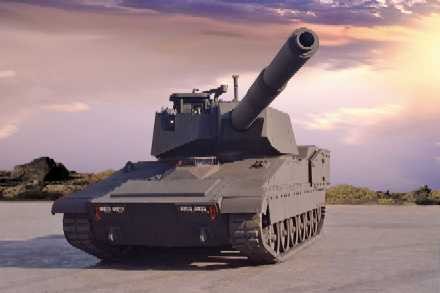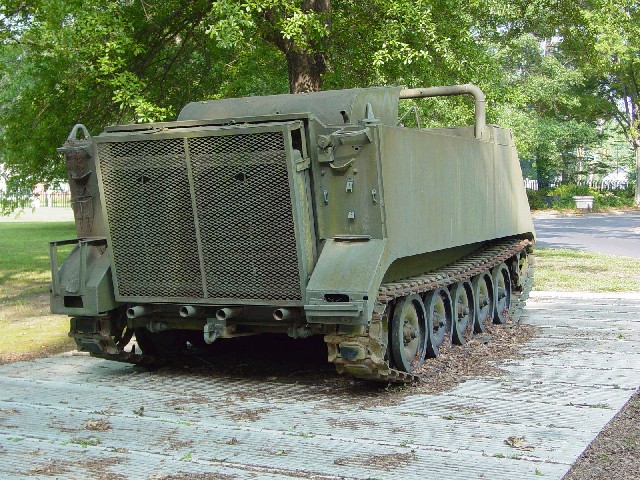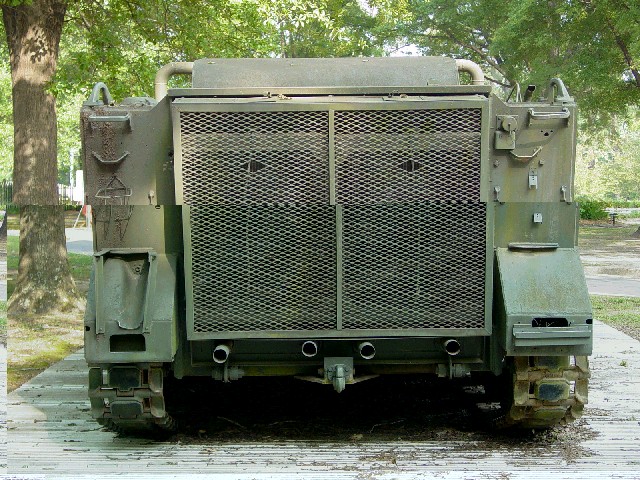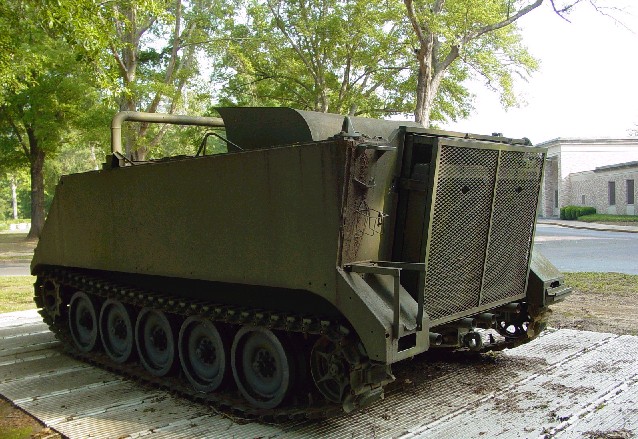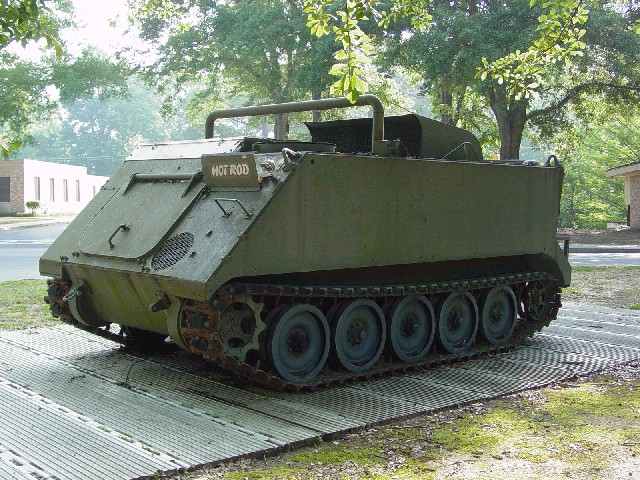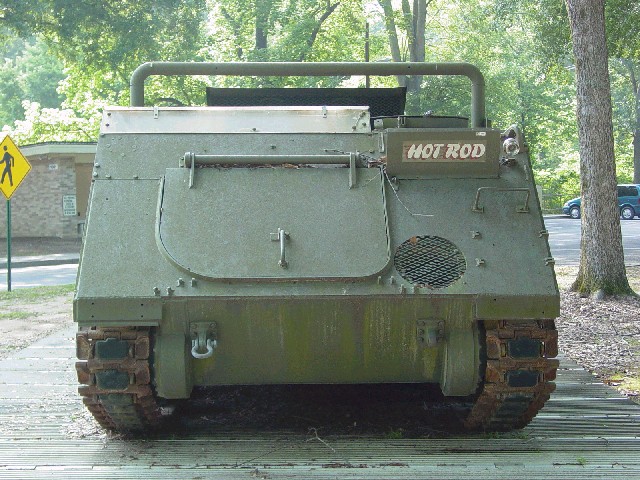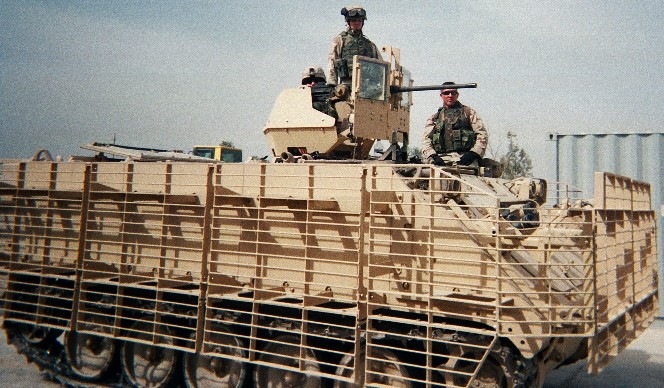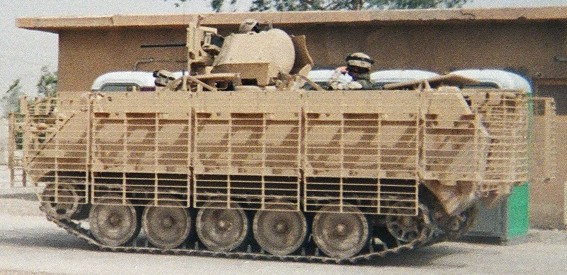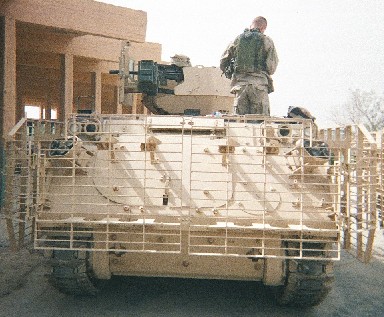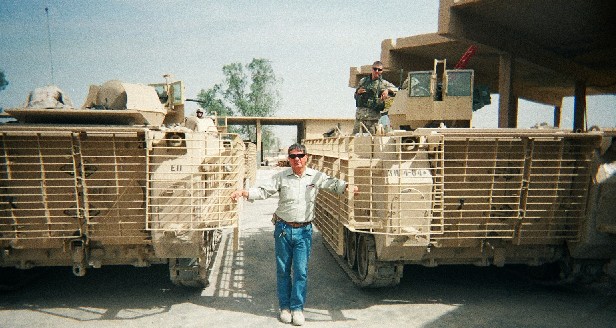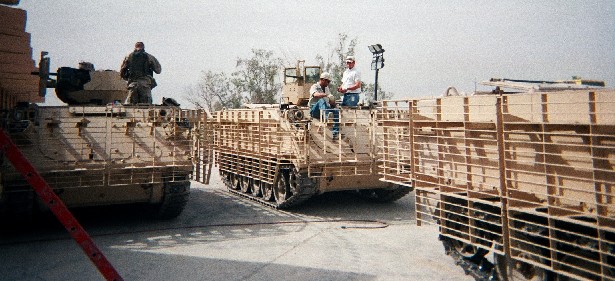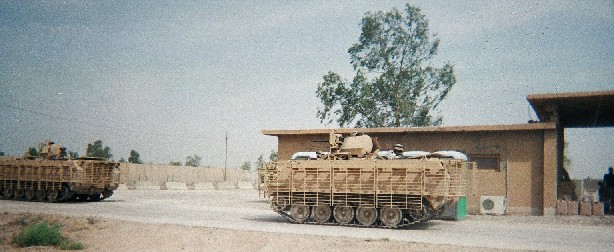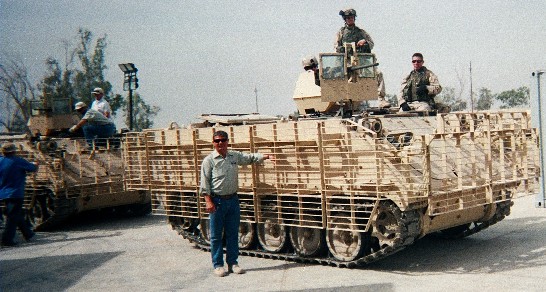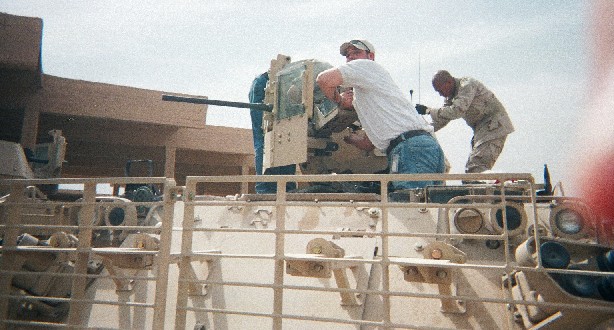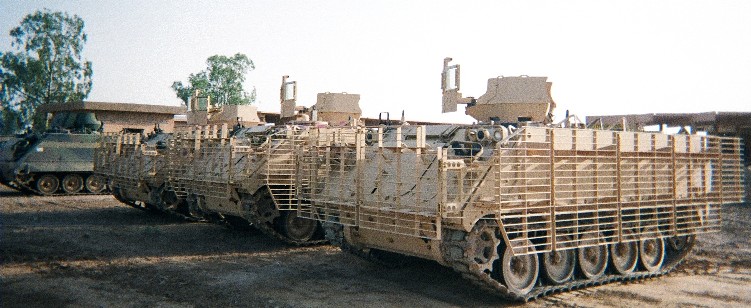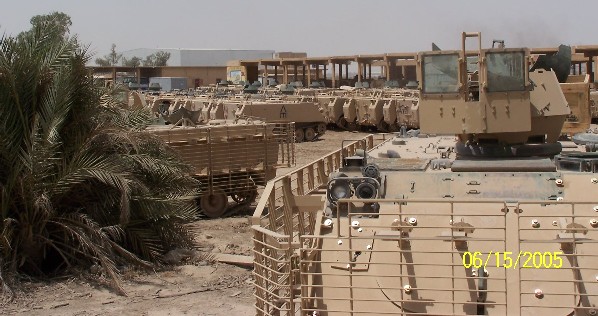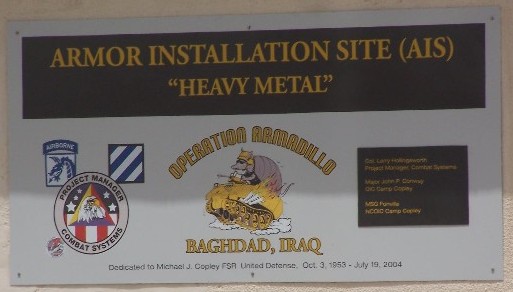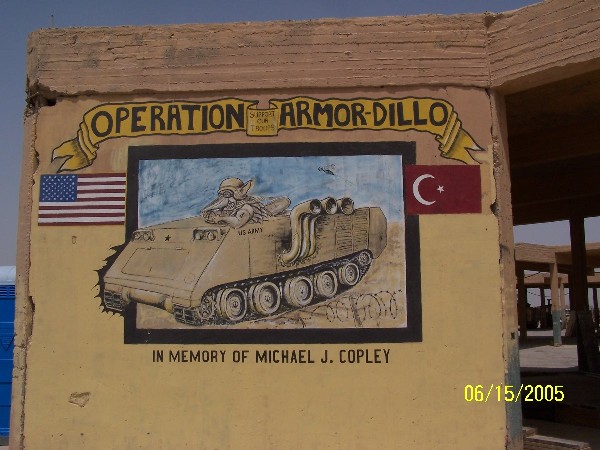Accurate U.S. Army Armor History
"Tanks and armored personnel carriers have been out of favor with the advocates of 'military transformation' for so long that their value and versatility in Iraq has come as something of a revelation," the report says. "Not only have they provided critical capabilities in waging urban battles, but they have proven surprisingly relevant in the conduct of counterinsurgency operations."
--Lawrence Korb, He is vice president of the Council on Foreign Relations and former assistant Secretary of Defense in the Reagan administration
"It was the TRACK not the tank that won for us"
--German Panzer General Guderian said after the fall of France in 1940
The REAL Stryker --- Chapter 1: Mobility
www.youtube.com/watch?v=Fn6cyaOBmUg
The REAL Stryker --- Chapter 2: Protection
www.youtube.com/watch?v=_R-jUZmZQm8
http://usacac.leavenworth.army.mil/CAC/milreview/English/MarApr08/indexengmarapr08.asp
 Air-Mech-Strike Study Group Confronts U.S. Army on Past, Current and Future Force Structure & Operations!
Air-Mech-Strike Study Group Confronts U.S. Army on Past, Current and Future Force Structure & Operations!
http://usacac.leavenworth.army.mil/CAC/milreview/English/MarApr08/BookReviewsMarApr08.pdf
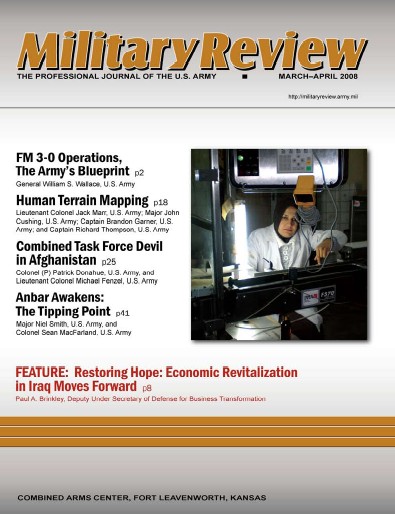
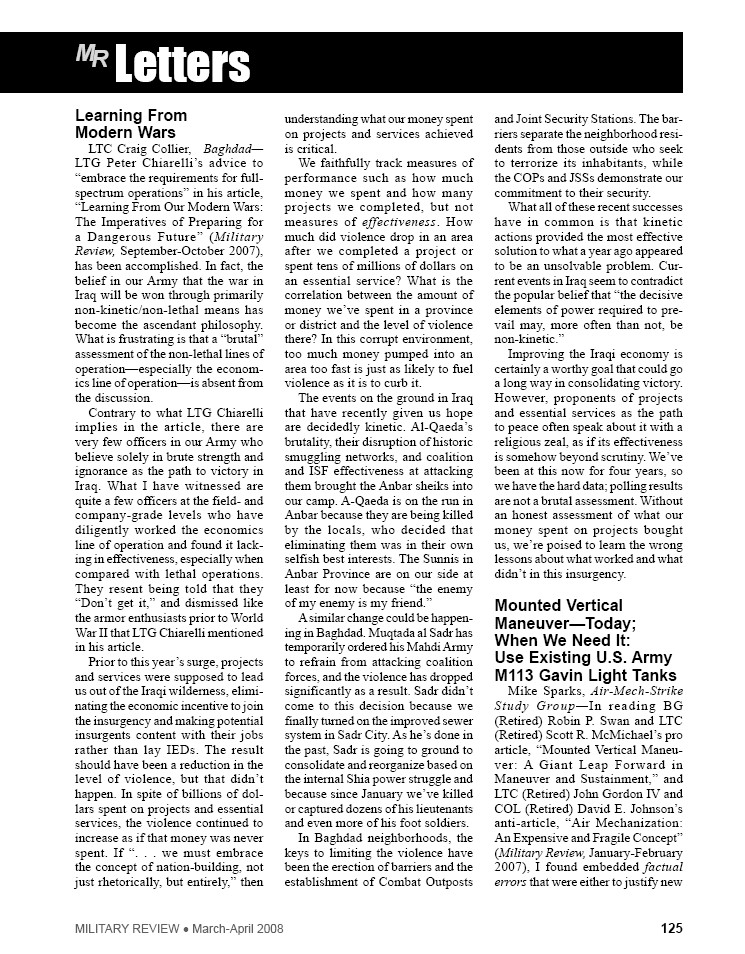
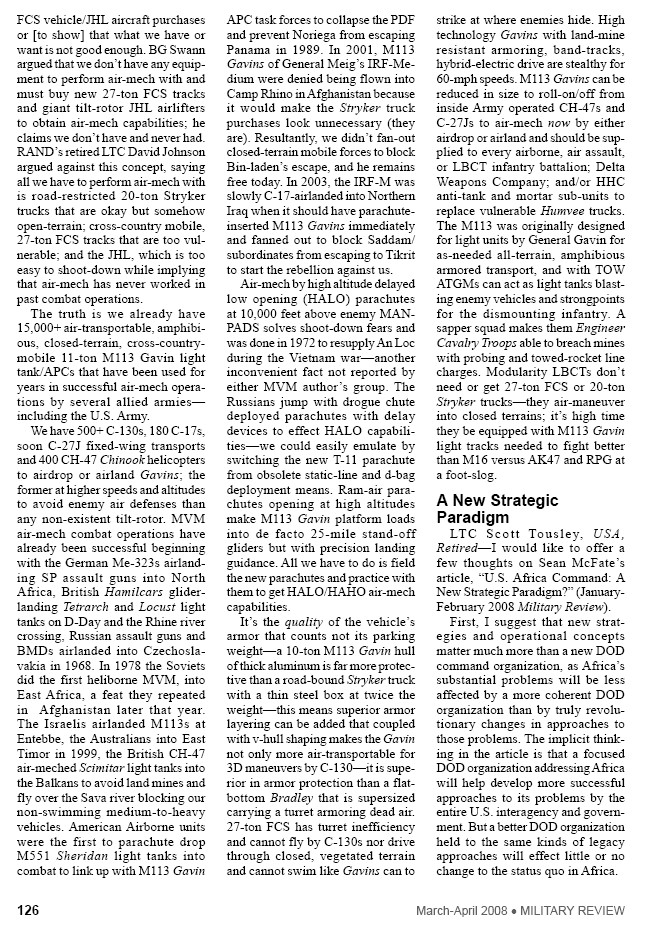
Plain Text
Mounted Vertical Maneuver Today; When We Need It: Use Existing U.S. Army M113 Gavin Light Tanks
Mike Sparks, Air-Mech-Strike Study Group
In reading BG (Retired) Robin P. Swan and LTC (Retired) Scott R. McMichael's pro article, "Mounted Vertical Maneuver: A Giant Leap Forward in Maneuver and Sustainment,"¨ and LTC (Retired) John Gordon IV and COL (Retired) David E. Johnson's anti-article, "Air Mechanization: An Expensive and Fragile Concept"; (Military Review, January-February 2007), I found embedded factual errors that were either to justify new
Page 126 March-April 2008 Military Review
FCS vehicle/JHL aircraft purchases or [to show] that what we have or want is not good enough. BG Swann argued that we don't have any equipment to perform air-mech with and must buy new 27-ton FCS tracks and giant tilt-rotor JHL airlifters to obtain air-mech capabilities; he claims we don't have and never had. RAND's retired LTC David Johnson argued against this concept, saying all we have to perform air-mech with is road-restricted 20-ton Stryker trucks that are okay but somehow open-terrain; cross-country mobile, 27-ton FCS tracks that are too vulnerable; and the JHL, which is too easy to shoot-down while implying that air-mech has never worked in past combat operations.
The truth is we already have 15,000+ air-transportable, amphibious, closed-terrain, cross-country-mobile 11-ton M113 Gavin light tank/APCs that have been used for years in successful air-mech operations by several allied armies; including the U.S. Army.
We have 500+ C-130s, 180 C-17s, soon C-27J fixed-wing transports and 400 CH-47 Chinook helicopters to airdrop or airland Gavins; the former at higher speeds and altitudes to avoid enemy air defenses than any non-existent tilt-rotor. MVM air-mech combat operations have already been successful beginning with the German Me-323s airlanding SP assault guns into North Africa, British Hamilcars glider-landing Tetrarch and Locust light tanks on D-Day and the Rhine river crossing, Russian assault guns and BMDs airlanded into Czechoslavakia in 1968. In 1978 the Soviets did the first heliborne MVM, into East Africa, a feat they repeated [with fixed-wing aircraft] in Afghanistan later that year. The Israelis airlanded M113s at Entebbe, the Australians into East Timor in 1999, the British CH-47 air-meched Scimitar light tanks into the Balkans to avoid land mines and fly over the Sava river blocking our non-swimming medium-to-heavy vehicles. American Airborne units were the first to parachute drop M551 Sheridan light tanks into combat to link up with M113 Gavin APC task forces to collapse the PDF and prevent Noriega from escaping Panama in 1989. In 2001, M113 Gavins of General Meig's IRF-Medium were denied being flown into Camp Rhino in Afghanistan because it would make the Stryker truck purchases look unnecessary (they are). Resultantly, we didn't fan-out closed-terrain mobile forces to block Bin-laden's escape, and he remains free today. In 2003, the IRF-M was slowly C-17-airlanded into Northern Iraq when it should have parachute-inserted M113 Gavins immediately and fanned out to block Saddam/subordinates from escaping to Tikrit to start the rebellion against us.
Air-mech by high altitude delayed low opening (HALO) parachutes at 10,000 feet above enemy MANPADS solves shoot-down fears and was done in 1972 to resupply An Loc during the Vietnam war¡ another inconvenient fact not reported by either MVM author's group. The Russians jump with drogue chute deployed parachutes with delay devices to effect HALO capabilities; we could easily emulate by switching the new T-11 parachute from obsolete static-line and d-bag deployment means. Ram-air parachutes opening at high altitudes make M113 Gavin platform loads into de facto 25-mile stand-off gliders but with precision landing guidance. All we have to do is field the new parachutes and practice with them to get HALO/HAHO air-mech capabilities.
It's the quality of the vehicle's armor that counts not its parking weight; a 10-ton M113 Gavin hull of thick aluminum is far more protective than a road-bound Stryker truck with a thin steel box at twice the weight; this means superior armor layering can be added that coupled with v-hull shaping makes the Gavin not only more air-transportable for 3D maneuvers by C-130; it is superior in armor protection than a flat-bottom Bradley that is supersized carrying a turret armoring dead air. 27-ton FCS has turret inefficiency and cannot fly by C-130s nor drive through closed, vegetated terrain and cannot swim like Gavins can to strike at where enemies hide. High technology Gavins with land-mine resistant armoring, band-tracks, hybrid-electric drive are stealthy for 60-mph speeds. M113 Gavins can be reduced in size to roll-on/off from inside Army operated CH-47s and C-27Js to air-mech now by either airdrop or airland and should be supplied to every airborne, air assault, or LBCT infantry battalion; Delta Weapons Company; and/or HHC anti-tank and mortar sub-units to replace vulnerable Humvee trucks. The M113 was originally designed for light units by General Gavin for as-needed all-terrain, amphibious armored transport, and with TOW ATGMs can act as light tanks blasting enemy vehicles and strongpoints for the dismounting infantry. A sapper squad makes them Engineer Cavalry Troops able to breach mines with probing and towed-rocket line charges. Modularity LBCTs don't need or get 27-ton FCS or 20-ton Stryker trucks; they air-maneuver into closed terrains; it's high time they be equipped with M113 Gavin light tracks needed to fight better than M16 versus AK47 and RPG at a foot-slog.
EXCLUSIVES! M113 Gavin Rapid Entry Vehicle (REV) in Iraq!
The Star Ledger February 13, 2006
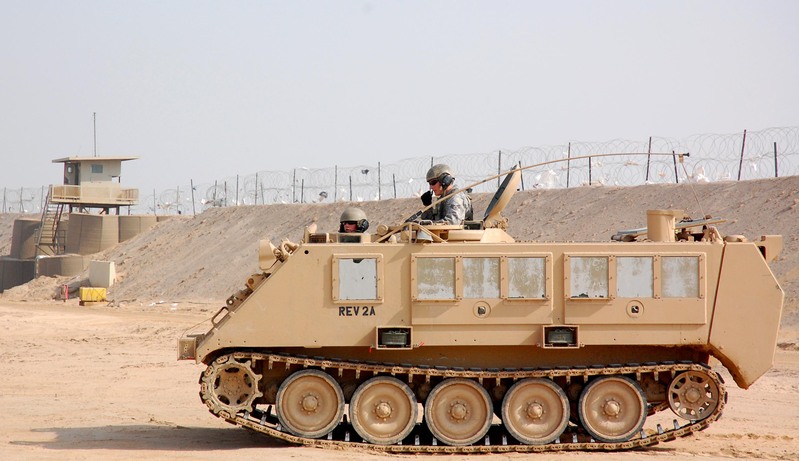
www.globalsecurity.org/org/news/2006/060213-picatinny-nonlethal.htm
Picatinny's nonlethal responseIsrael Unveils their M113 Gavin "Urban Fighter"In-Depth Coverage By Kristen Alloway
The M113 [Gavin] Armored Personnel Carrier is one mean machine. Equipped with a machine gun or towing missiles and mortars, it has hauled Soldiers through combat zones for four decades.
Now the tank-like vehicle is showing its softer side.
Engineers at Picatinny Arsenal in Morris County have created a less deadly version -- designed to discourage and repel, but not kill -- that recently was sent to Iraq's Camp Bucca, one of the largest prisons in the world. They are readying three more they expect to deploy to Iraq later this year.
The M113 is the latest nonlethal system to be designed by the 6,500-acre weapons research and development facility in Rockaway Township, which calls itself "The Home of American Firepower."
The request for it came from Camp Bucca last spring, a few months after four Iraqi prisoners were killed during a riot. Soldiers had used warnings and nonlethal weapons, and when that failed to calm the uprising, they turned to lethal force, according to news reports.
"They asked for better protection," said Army Maj. Dwight Hunt, who directed the project at Picatinny. "They have to walk into the camp and put the riot down."
About 8,000 detainees are held at Camp Bucca, near the Kuwaiti border in southern Iraq. The camp is divided into 12 compounds, and prisoners live in trailer-like quarters on the sprawling campus, military spokesman Lt. Col. Guy Rudisill said from Iraq.
With detainees hurling rocks or launching them from makeshift slingshots, Soldiers at the camp wanted something more than the standard riot gear -- helmet, plastic shield, baton -- when they confronted them, Hunt said.
"They make weapons out of just about anything you can think of. ... Like David and Goliath," Rudisill said. "It's no different from guarding prisoners back in the states."
The goal for Picatinny engineers was to get the guards closer to the prisoners safely, Hunt said.
In just a few months, a team of about 15 Picatinny engineers and technicians overhauled and tested the armored vehicle, swapping out its lethal weapons for less deadly ones.
They cut holes in the sides and back to add super-strong windows, called transparent armor, that can withstand small-arms fire. In place of the M113's machine gun, they mounted shotguns that fire rubber bullets. Along the sides they added claymore mines that spray rubber pellets.
In November, the $150,000 revamped M113, dubbed the Rapid Entry Vehicle, was headed for Iraq.
But nonlethal weapons do not always live up to their name.
If fired at a vulnerable part of the body, such as the head, or at close range, they can kill. At too great a distance -- effective range for nonlethal shotguns is between 50 to 75 yards -- or if the subjects are armored, they often do not work.
"You're facing a narrow band between ineffective and lethal," said John Pike, director of GlobalSecurity.org, a defense and security Web site based in Virginia.
One criticism of nonlethal weapons is Soldiers could opt to use force, even nonlethal force, too quickly.
"The issue becomes how do you use it and make sure you're not jumping to it because you have it handy," said Alan Pearson of the Center for Arms Control and Non-Proliferation. "You need steps to make sure that doesn't happen."
Human rights advocates agree.
"It's a matter of having proper training and proper rules for use and making sure those aren't abused," said Steve Goose, director of the arms division of Human Rights Watch.
The military is working out those details, and the REV has not yet been used at Camp Bucca, Hunt and Rudisill said. While the camp guards and military brass were enthusiastic about the vehicle, they are still determining how it should be deployed, Hunt said.
"Until Soldiers and Airmen are trained up on it ... they cannot use it," Rudisill said.
For now, Hunt said, his team is focused on addressing the Soldiers' initial suggestions.
Future upgrades include adding a bulldozer-like blade to push away makeshift prisoner barricades and a spinning auger to unearth escape tunnels.
Last year, Camp Bucca guards discovered a 600-foot tunnel that stretched beyond the compound fence; no one had yet escaped.
Picatinny engineers also have to figure out how to vent the ammonia-like fumes that build up inside the vehicle when rubber bullets are fired, Hunt said.
And with temperatures in the region often above 120 degrees, air conditioning was a popular request. But that may be too costly, Hunt said.
Although the REV has not rolled into the camp, Hunt said detainees have seen it through a fence.
"Maybe we've shaped their behavior just by having it parked at the gate," Hunt said. "If that saves a Soldier from getting injured -- it's not sexy, nobody's going to get a Purple Heart -- you've done what you intended to do."
IMI Introduces the "Urban Fighter" Upgraded M-113
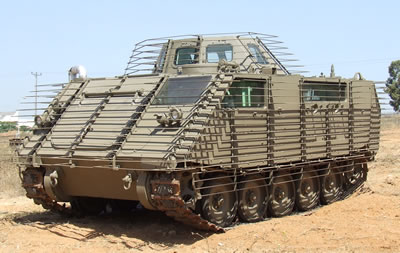
Rafael Vehicle Armor Solutions: Up-Armored M113 Gavins Featured
www.youtube.com/watch?v=tz_LbSjPrOw
IMI is introducing the new "Urban Fighter" - better protected than a MRAP, it costs one tenth of the price and can be produced from ready-made kits within few days...
IMI - Land Systems Division (Slavin) has completed the development of the "Urban-Fighter", an up-armored and improved M-113 Armored Personnel Carrier. The vehicle is optimized for Missions Others Than War and Low Intensity Conflict (LIC), particularly in urban environment. The Urban-Fighter is considered to augment and replace IDF unprotected or less protected vehicles currently operating in counter-insurgency operations in the West Bank.
By the end of June 2007 IMI delivered the Urban-Fighter's prototype to the IDF for testing. IMI expects the IDF to decide on potential procurements after the tests completion. Unlike other M-113's up-armoring projects, the '"Urban-Fighter"' required only minor automotive upgrade, which further contributes to its cost effectiveness. In fact, converting a plain M-113 into a fully equipped Urban Fighter is expected to cost about 10 percent of the cost of a Mine Resistant Ambush Protected (MRAP) currently produced for the U.S. Army and marines. The vehicle's protection was enhanced to stop heavy machine guns, shrapnel and most types of Improvised Explosive Devices (IED)s utilizing the Iron Wall technology armor suite developed by IMI, providing bulletproof protection, as well as counter IED / Explosively Formed Projectiles (EFP) protection. In addition, the Urban-Fighter uses improved slat armor, protecting it from attacks by RPGs.
The new vehicle offers features hitherto unavailable to APCs, including armored transparent side windows, offering unobstructed visibility upwards and sideways. 360 degrees observation and firing capability is provided for the commander and another crewmember by a raised cupola fitted with transparent armor. Firing ports are imparted for warfighters in the front, sides and rear. The fighting compartment was has also been redesigned with the addition of blast-protected seats, improving the survivability of the crew to attacks by mines and IEDs. The vehicle can carry eight fully loaded troops and a driver.
The driver's position was greatly improved, compared to conventional M-113s and is now fitted with two windows and side and rear looking video cameras eliminating the 'blind areas' that necessitated direction by the commander. The new driver's compartment ensures good visibility under most driving conditions, for safe driving on roads, dust roads and cross country. The current configuration retains the 'steering sticks' however the vehicle can be installed with an optional steering wheel to further simplify driving.
IMI's Land Systems Division is Israel's leading armor systems house, developing and producing advanced protection systems for heavy, medium and light vehicle applications. Among the company's current programs is the designing and production of the special armor elements used on the Merkava tank, the development and production of the modernized Turkish M-60 tank and the design and production of protection suites for the IDF's new armored infantry fighting vehicle (Namer).
www.defense-update.com/products/u/urbanfighter.htm
IMI Introduces the "Urban Fighter" Upgraded, Up-armored M-113
IMI is introducing the new "Urban Fighter" - better protected than a MRAP, it costs one tenth of the price and can be produced from ready-made kits within few days...
Encountering significant threats in its theatre of operations, the IDF formulated an armored vehicles roadmap that will secure its forces the levels of mobility and protection they require for counter terror operations. Some of the M113 operated by the IDF were installed with raised armored fighting positions (Kasman - shown on left photo). Improved protection suites were also designed for the vehicle and by IMI, utilizing the hybrid (passive-reactive) armor. This armor kit was selected by the IDF few years ago but the program was later shelved due to lack of funding.
More recently, IMI's Land Systems Division (Slavin) completed a more radically configured version of the M-113, dubbed "Urban-Fighter", optimized for Missions Others Than War and Low Intensity Conflict (LIC), particularly in urban environment. The Urban-Fighter is considered to augment and replace IDF unprotected or less protected vehicles currently operating in counter-insurgency operations in the West Bank. By the end of June 2007 IMI delivered the Urban-Fighter's prototype to the IDF for testing. IMI expects the IDF to decide on potential procurements after the tests completion.
Unlike other M-113's up-armoring projects, the '"Urban-Fighter"' required only minor automotive upgrade, which further contributes to its cost effectiveness. Although this vehicle received a massive improvement in its armor protection, the conversion of a plain Gavin (M-113) into a fully equipped Urban Fighter using the Urban-Fighter kit is performed within days at a cost about 10 percent of the cost of a Mine Resistant Ambush Protected (MRAP) currently produced for the U.S. Army and marines. The vehicle's protection was enhanced to stop heavy machine guns, shrapnel and most types of Improvised Explosive Devices (IED) utilizing the Iron Wall technology armor suite developed by IMI, providing bulletproof armor as well as IED , including Explosively Formed Projectiles (EFP) and Explosively Formed Fragments (EFF) protection. In addition, the Urban-Fighter uses improved slat armor, protecting it from attacks by RPGs.
The new vehicle offers features hitherto unavailable to APCs, including armored transparent side windows, offering unobstructed visibility upwards and sideways. 360 degrees observation and firing capability is provided for the commander and another crewmember by a raised cupola fitted with transparent armor. Firing ports are imparted for warfighters in the front, sides and rear. The fighting compartment was has also been redesigned with the addition of blast-protected seats, improving the survivability of the crew to attacks by mines and IEDs. The vehicle can carry eight fully loaded troops and a driver. Before beginning the field trials the vehicle is expected to receive a remotely operated weapon station which will further add to its visibility and firepower.
The driver's position was greatly improved, compared to conventional M-113s and is now fitted with two windows and side and rear looking video cameras eliminating the 'blind areas' that necessitated direction by the commander. The new driver's compartment ensures good visibility under most driving conditions, for safe driving on roads, dust roads and cross country. The current configuration retains the 'steering sticks' however the vehicle can be installed with an optional steering wheel to further simplify driving.
IMI's Land Systems Division is Israel's leading armor systems house, developing and producing advanced protection systems for heavy, medium and light vehicle applications. Among the company's current programs is the designing and production of the special armor elements used on the Merkava tank, the development and production of the modernized Turkish M-60 tank and the design and production of protection suites for the IDF's new armored infantry fighting vehicle (Namer).
www.defense-update.com/newscast/0207/news/210207_ied.htm
IMI Develops Hybrid Armor to Defeat Sophisticated RSIEDs
IMI is developing a new hybrid armor (passive) designed to withstand commonly used types of RoadSide IEDs (RSIED), including the sophisticated Explosively Formed Projectiles (EFP) and Self Formed Fragmentation (SFF) charges. The unique combination of the new hybrid armor is the result of extensive study conducted at IMI, in an attempt to protect warfighters at levels beyond those offered by conventional armor, with cost effective armor suite that can defeat both prevailing and future threats.
The new hybrid armor will be applied as add-on modules for wheeled or tracked light armored vehicles. The new hybrid armor (passive) combines various materials designed to absorb the kinetic energy, mechanical deformation and ballistic damage created by the threat by mitigating and dissipating blast energy, and absorbing the kinetic energy of projectiles, fragments and EFP slugs, stopping multiple hits (according to STANAG) from small and medium caliber projectiles which is equal to 45-up to 60 mm of Rolled Homogenous Armor (RHA) while weighing half the weight of comparable steel. The armor kit is designed for field installation and removal. Damaged modules are designed for rapid replacement by field maintenance teams, without using special tools.
In the future, IMI plans to integrate reactive components to this hybrid armor, offering comprehensive protection from more threats, including RPG's.
www.defense-update.com/features/du-3-04/IED.htm
www.defense-update.com/newscast/0207/news/010207_efp.htm
www.defense-update.com/features/du-2-05/IED-shapedcharge.htm
www.defense-update.com/features/du-1-04/rpg-threat.htm
www.imi-israel.com/news.aspx?FolderID=73&docID=717
IMI Introduces the "Urban Fighter" Upgraded, Up-armored M-113
IMI - MARKETING
Israel finishes Urban Fighter development
Israel Military Industries (IMI) has completed the development of the Urban Fighter - an upgraded, up-armoured M113 armoured personnel carrier (APC) designed for urban warfare and low-intensity conflict scenarios.
The Israel Defence Force (IDF) received a first prototype for evaluation in June and will examine its suitability to replace less-protected vehicles for operations in the West Bank and Gaza.
Unlike the previous version of the upgraded M113, the Urban Fighter requires only a minor automotive upgrade, which significantly reduces its cost and is designed as a kit that could be installed on an M113 within a few days.
The Urban Fighter features a hybrid-armour (passive-reactive) suite, based on IMI's Iron Wall armour technology. It is designed to protect from heavy machine guns and most forms of improvised explosive device (IED), such as explosively formed projectiles and explosively formed fragments. In addition, the Urban Fighter uses improved slat armour to protect from rocket-propelled grenades.
British, Dutch and Canadian Armies Adapting and Going to Tracks in Afghanistan
M113A3 Gavins & BV10S Viking Light Armored Tracks in Afghanistan
POB 1044, Ramat Hasharon
47100, Israel
+972-3548-5617 Office
+972-3548-6125 Fax
imimrktg@imi-israel.com
www.janes.com/news/defence/land/jdw/jdw070802_1_n.shtml
By Alon Ben-David
02 August 2007
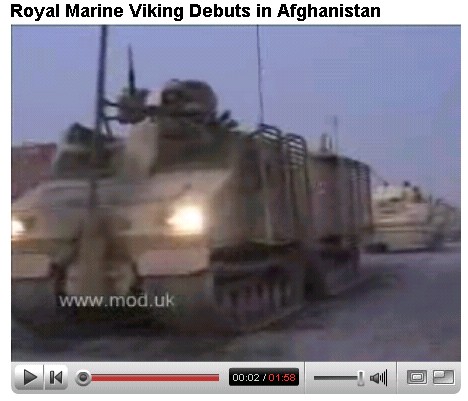
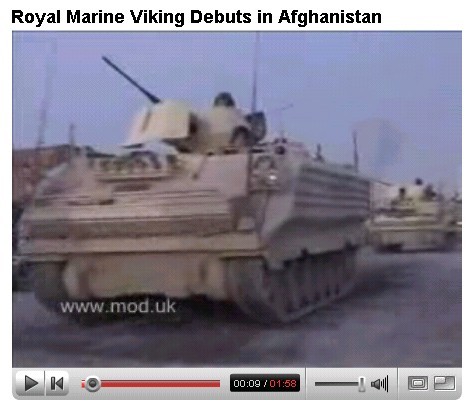
50 x 11-ton Canadian M113A3 Gavin "TLAVs" light tanks in Afghanistan with 42-ton Leopard C2 medium tanks in Combat
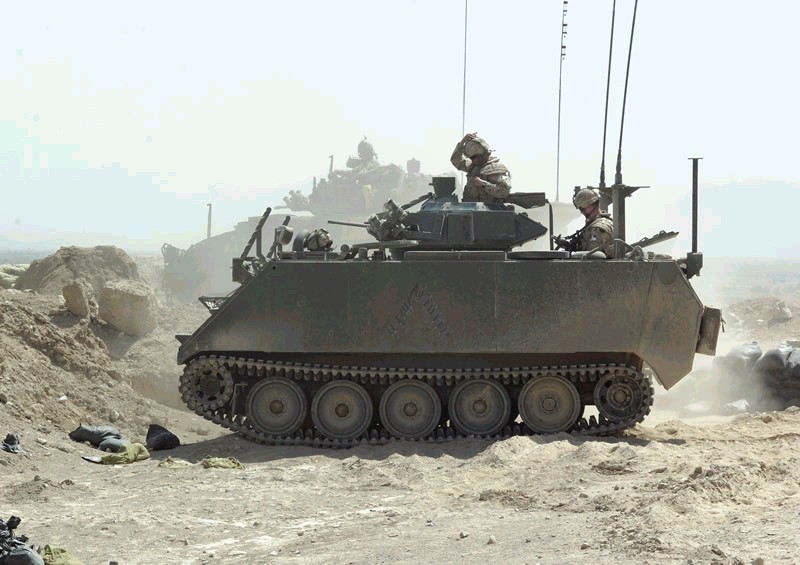
AR2007-A051-0261
15 May 2007
Kandahar, Afghanistan
A Tracked LAV (TLAV) manoeuvres into position at Forward Operating Base Ghundi Gar. Having arrived as an escort for a resupply convoy the TLAV now takes up position as part of the Hotel Company Combat Team of the 2nd Battalion Royal Canadian Regiment Battle Group, currently in this location as part of OP HADRIAN. 2 RCR BG is an integral element of the Joint Task Force Afghanistan.
Joint Task Force Afghanistan (JTF-Afg) is Canada's contribution to NATO's International Security Assistance Force (ISAF) in Afghanistan. The focus of this mission is to help Afghans rebuild their lives, families, communities and nation. Canadian Forces personnel in Afghanistan are working to improve the quality of life of Afghans by providing a more secure environment in which Afghan society can recover from more than 25 years of conflict.
Photo by: Sgt Craig Fiander, JTF ? Afg, Image Technician
Canadian Prime Minister visits his tracked troops in Afghanistan: note the Leopard 1 and M113A3 Gavin "TLAV" in the background
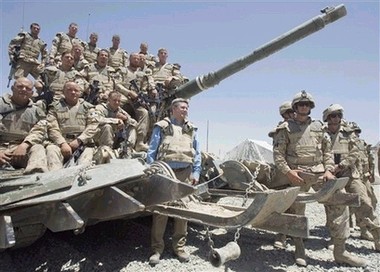
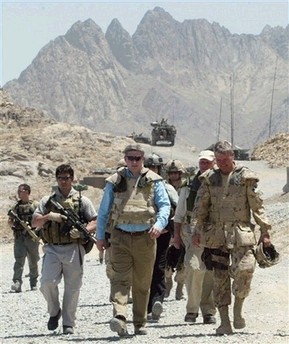
www.sfu.ca/casr/np-afghan-06.htm
Armoured Vehicles - NATO/ISAF - Southern Afghanistan - December 2006Punching at Panjwaii - Canadian Leopard Tanks in Combat CF Tracked Vehicles Tackle the Taliban and Afghan Winters
Stephen Priestley , CASR Researcher / Illustrator
--------------------------------------------------------------------------------
In to Action - Canadian Leopard C2 tanks and the TLAV M113A3s in Combat
After a month of settling in and training, the Leopard C2 tanks of B Squadron of Lord Strathcona's Horse (RC) are on the move. On 03 Dec 2006 (Afghan time) the tanks rolled out of the Kandahar Airfield compound heading for Panjwaii District. The Leopards form a new direct fire unit capable of punching through the thick, mud-brick walls (left) that typify much of Panjwaii District and caused Canadian troops problems during Operation Medusa.
Images from Kandahar reveal details about the deployed Leopard C2s. As many as ten tanks are visible (right) all fitted with MEXAS armour kits - more than previously said to exist - and at least one Leopard each is fitted with a dozer blade (right, front vehicle) or with a mine rack (topmost image, front vehicle).
The Leopard C2s aren't the only tracked armour in southern Afghanistan. The first Leo airlift included a Taurus Armoured Recovery Vehicle (ARV). There are also at least two AEV (Armoured Engineering Vehicle) Badgers joining the fight in Panjwaii (left). Both these specialist vehicles are based on a Leopard chassis. Light tracked vehicles also accompany the heavy armour. It had been announced that 40 rebuilt TLAVs would go to Kandahar in 2007. It seems some arrived early.
Images of M113A3s in Afghanistan have been of poor quality so far. [1] The TLAV's rooftop remote-control armament has been covered - until revealed, we must assume that PWS (Protected Weapons Stations) have been mounted. M113A3s will act as infantry section carriers. The arrival of tracked LAVs is well-timed - winter rains are turning the Afghan dust into mud.
The tracked vehicles address some of the mobility limitations that were encountered with LAV IIIs during Operation Medusa [2] which will be worsened by the winter conditions. More important is the Leo's greater firepower - within a day of arriving at Foward Operating Base Ma'sum Ghar, the Leopard's 105s were returning fire on Taliban rocket launcher positions.
Journalists contrast upgraded Leopard fire control, sights, and protection with the cruder systems of the Soviet tanks defeated by Afghan Mujahideen in the '80s. Quite true but parallels can be drawn with Northern Alliance tanks (left) in 2001 - T-55s used as mobile, direct-fire artillery. A Leopard firing from its FOB revetment is simply more sophisticated kit doing the same job.
The CF sees other roles for the Leopards in Afghanistan (among them protecting convoys from attack) but, in Part 2, we will focus on mouseholing mud-brick walls.
----------------------------------------------------------------------------
[1] 'Life-extended' TLAV (M113A3 and long-wheelbased MTVL) emphasized new armament arrangements - either RWS (Remote Weapon Systems) or 'One Metre' turrets (recycled from AVGP Grizzly section carriers). The former is probably the Rafael PWS as planned but may also be the Kongsberg M151 RWS (as on APVs).
Another M113 type in theatre is the remote mine-clearing ILDS Protection Vehicle.
[2] LAV IIIs had difficulties with Panjwaii mud-brick compounds and its irrigation ditches. Tracked M113A3s [without heavy caliber guns] will cope better with the latter but not with the former.
We Told You So: Why Are Medium Bradleys and Heavyweight Abrams Tanks Sitting in Motor Pools in the USA while American Light Infantry is Getting Creamed in Wheeled Trucks and On Foot in Afghanistan when LIGHT M113 Gavins are Available?
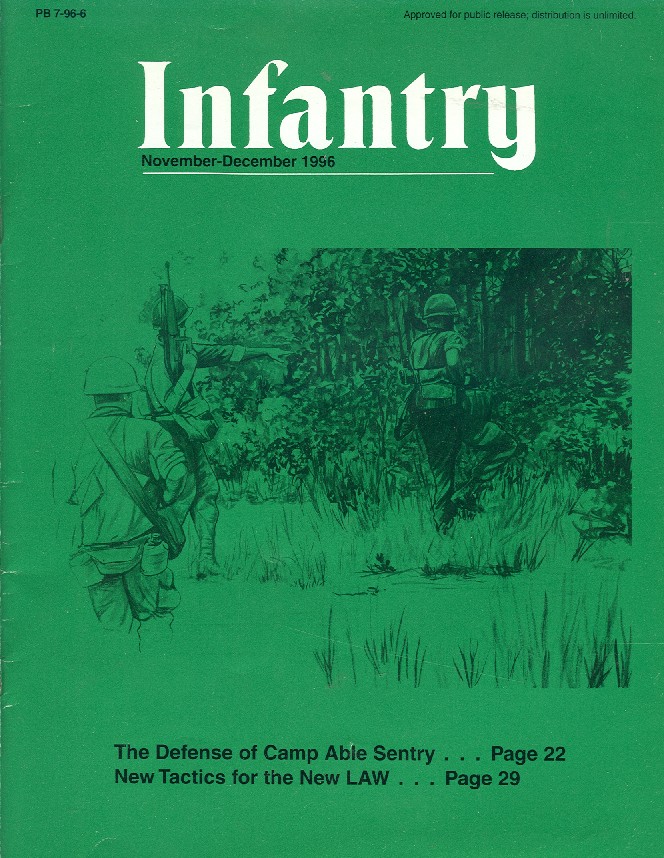
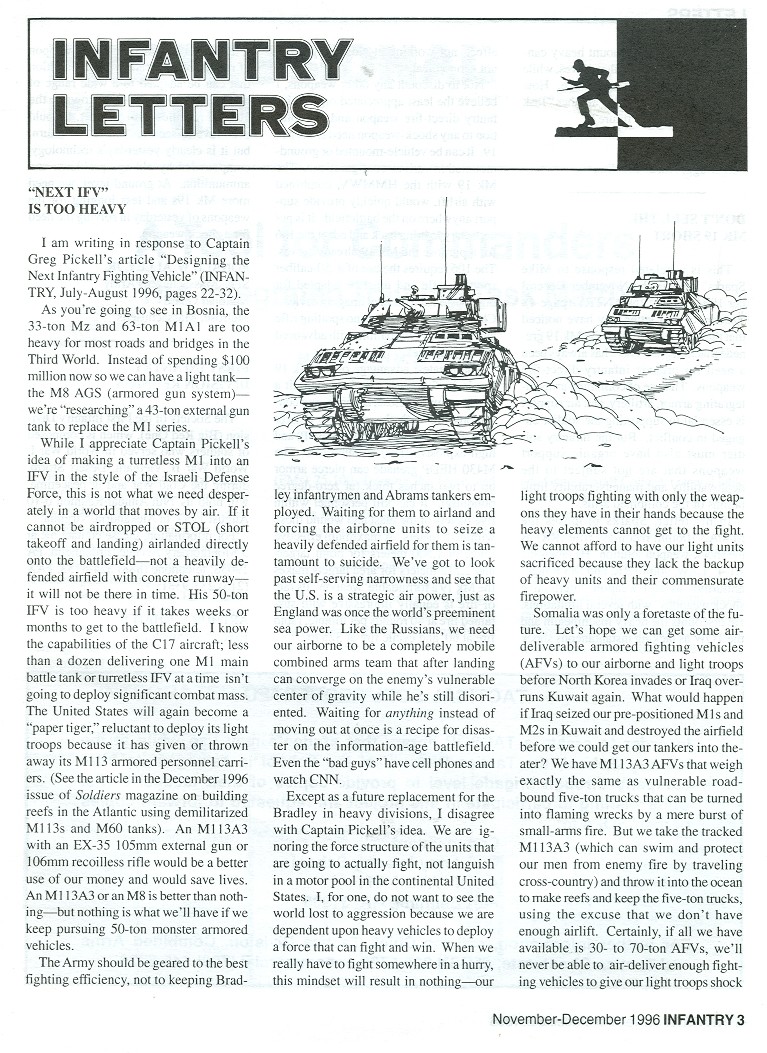
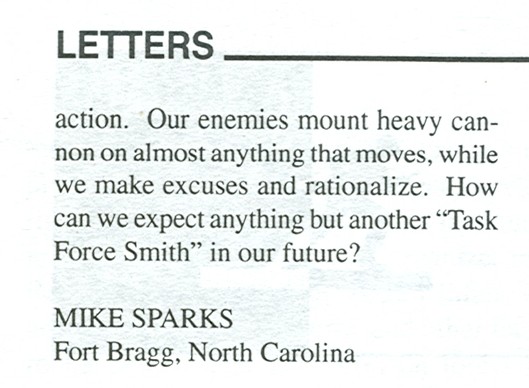
INFANTRY LETTERS
"NEXT IFV" IS TOO HEAVY
I am writing in response to Captain Greg Pickell's article "Designing the Next Infantry Fighting Vehicle" (INFANTRY, July-August 1996, pages 22-32).
As you're going to see in Bosnia, the 33-ton M2 and 63-ton M1A1 are too heavy for most roads and bridges in the Third World. Instead of spending $100 million now so we can have a light tank the M8 AGS (armored gun system) we're "researching" a 43-ton external gun tank to replace the M1 series.
While I appreciate Captain Pickell's idea of making a turretless M1 into an IFV in the style of the Israeli Defense Force, this is not what we need desperately in a world that moves by air. If it cannot be airdropped or STOL (short takeoff and landing) airlanded directly onto the battlefield-not a heavily defended airfield with concrete runway it will not be there in time. His 50-ton IFV is too heavy if it takes weeks or months to get to the battlefield. I know the capabilities of the C-17 aircraft; less than a dozen delivering one M1 main battle tank or turretless IFV at-a-time isn't going to deploy significant combat mass.
The United States will again become a "paper tiger," reluctant to deploy its light troops because it has given or thrown away its M113 armored personnel carriers. (See the article in the December 1996 issue of Soldiers magazine on building reefs in the Atlantic using demilitarized M113s and M60 tanks). An M113A3 with an EX-35 105mm external gun or 106mm recoilless rifle would be a better use of our money and would save lives.
An M113A3 or an M8 is better than nothing-but nothing is what we'll have if we keep pursuing 50-ton monster armored vehicles. The Army should be geared to the best fighting efficiency, not to keeping Bradley infantrymen and Abrams tankers employed. Waiting for them to airland and forcing the airborne units to seize a heavily defended airfield for them is tantamount to suicide. We've got to look past self-serving narrowness and see that the U.S. is a strategic air power, just as England was once the world's preeminent sea power. Like the Russians, we need our airborne to be a completely mobile combined arms team that after landing can converge on the enemy's vulnerable center of gravity while he's still disoriented. Waiting for anything instead of moving out at once is a recipe for disaster on the information-age battlefield. Even the "bad guys" have cell phones and watch CNN.
Except as a future replacement for the Bradley in heavy divisions, I disagree with Captain Pickell's idea. We are ignoring the force structure of the units that are going to actually fight, not languish in a motor pool in the continental United States. I, for one, do not want to see the world lost to aggression because we are dependent upon heavy vehicles to deploy a force that can fight and win. When we really have to fight somewhere in a hurry, this mindset will result in nothing-our light troops fighting with only the weapons they have in their hands because the heavy elements cannot get to the fight. We cannot afford to have our light units sacrificed because they lack the backup of heavy units and their commensurate firepower.
Somalia was only a foretaste of the future. Let's hope we can get some air-deliverable armored fighting vehicles (AFVs) to our airborne and light troops before North Korea invades or Iraq overruns Kuwait again. What would happen if Iraq seized our pre-positioned M1s and M2s in Kuwait and destroyed the airfield before we could get our tankers into theater? We have M113A3 AFVs that weigh exactly the same as vulnerable road bound five-ton trucks that can be turned into flaming wrecks by a mere burst of small-arms fire. But we take the tracked M113A3 (which can swim and protect our men from enemy fire by traveling cross-country) and throw it into the ocean to make reefs and keep the five-ton trucks, using the excuse that "we don't have enough airlift". Certainly, if all we have available is 30 to 70-ton AFVs, we'll never be able to air-deliver enough fighting vehicles to give our light troops shock
November-December 1996 INFANTRY 3
action. Our enemies mount heavy cannon on almost anything that moves, while we make excuses and rationalize. How can we expect anything but another "Task Force Smith" in our future?
MIKE SPARKS
Fort Bragg, North Carolina
November-December 1996 INFANTRY 4
M113 Gavins to the Rescue: Afghan Army Unit Better Equipped and More Capable than Americans getting Blown up in Humvee Trucks
www.defendamerica.mil/articles/apr2005/a042805la2.html
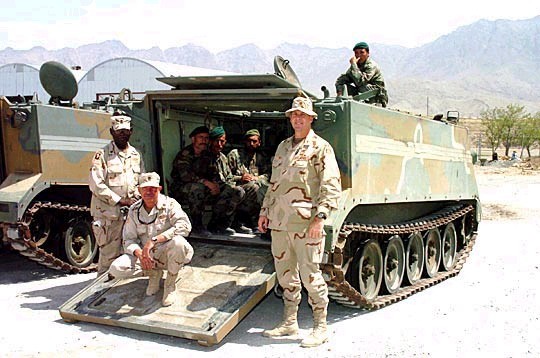
Members of the South Carolina Army National Guard's 218th Infantry Regiment pose next to an M113A2 Gavin with some of the Afghan National Army Soldiers they trained. From left are 1st Sgt. Bobby Duggins of Charleston, Sgt. 1st Class Michael Rector of Union, and Maj. Greg Cornell of Columbia. They are part of a group of embedded training team advisors from Task Force Phoenix assigned to train the Afghan National Army's mechanized kandak. Office of Military Cooperation-Afghanistan photo by U.S. Army Sgt. 1st Class Mack DavisAfghan Army Gets Armored Personnel Carriers
South Carolina National Guard troops are tasked to train Afghan Soldiers to operate and maintain the new vehicles.
By U.S. Army Sgt. 1st Class Mack Davis
Office of Military Cooperation-Afghanistan Public AffairsKABUL, Afghanistan, April 28, 2005 - The Afghan National Army is getting a new look over the next few months. As a result of a recent equipment donation, they will appear a little less Soviet and a little more like their Coalition partners.
The Afghan National Army recently took delivery of 10 M113A2 Gavin armored personnel carriers from the United States at Camp Pol-e-Charkhi, on the outskirts of Kabul. This was the first shipment of vehicles with more to follow. Lt. Col. David Braxton, logistics operations chief at the Office of Military Cooperation-Afghanistan, said, "Based on the force structure designed for Afghanistan's internal threat, armored personnel carriers were identified as a requirement for the Afghanistan National Army.
The U.S. M113A2s are an excess defense article, which allows them to be donated. Given the performance and popularity of the M113s around the world, it is an excellent match for the (Afghan National Army's) (armored personnel carrier) requirement."
"The (Afghan National Army) Soldiers in the mechanized 2nd Kandak that we have been working with are just ingenious; they have the ability to take any mission and figure out a way to accomplish it. They have done phenomenal things with minimum resources," U.S. Army Maj. Greg Cornell
The M113s already have a home. They will become part of the 2nd Kandak (Battalion) Mechanized Infantry, in the 201st Corps' 3rd Brigade, located in Kabul.
The 218th Infantry Regiment of the South Carolina Army National Guard, part of Task Force Phoenix, has been tasked with training the Afghan National Army to operate and maintain the new vehicles.
According to 1st Sgt. Bobby Duggins, one of the kandak's embedded training team advisors, "The (Afghan National Army) Soldiers are totally excited about receiving this vehicle. The M113 is a new vehicle for them and there is always a level of excitement when you introduce something new."
"Because this (armored personnel carrier) is so versatile, it can be used in many ways," added Duggins. While the Afghan National Army will use the armored personnel carriers primarily to transport troops, Duggins added that the M113 "can also be used as a squad heavy weapon (to fire mortars), and it can be used by medical units and maintenance teams going into the battlefield." In addition to the 10 M113s that arrived recently, Braxton said, "We expect 45 M113s and 16 M577s (command vehicles) to begin arriving the second week in May. The remaining vehicles will be in country throughout the next month for a total of 63 M113s and 16 M577s."
Because the 2nd Kandak Mechanized team was previously fielded with another armored personnel carrier, the Soviet BMP-1, training on the M113 was a smooth transition.
Prior to the arrival of the U.S. M113s, the kandak Soldiers were trained by the International Security Assistance Force's Norwegian Battle Group using five modified M113s they deployed to Afghanistan earlier this year. According to Lt. Col. Jon Mangersnes, Norwegian Battle Group commander, "We conducted two weeks of practical training. This type of training cannot be conducted in a class room; you have to get hands on the vehicle."
The training covered the basic operation and maintenance of the M113, including how to start, steer and maneuver, and how to manipulate the operator switches. "It was a lot of fun for my guys," added Mangersnes. "The Afghan Soldiers were very receptive to the training and the younger soldiers are extremely proud to be in the Afghan Army."
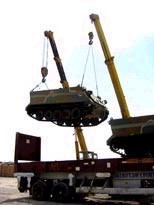
Cranes are used to download an M113A2 armored personnel carrier from its transport vehicle at Camp Pol-e-Charkhi, Afghanistan, April 20, 2005. Office of Military Cooperation-Afghanistan photo by U.S. Army Lt. Col. Frederick Rice
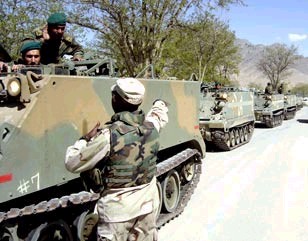
South Carolina Army National Guardsman 1st Sgt. Bobby Duggins, the 2nd Kandak's embedded training team advisor, provides last-minute instruction to Afghan National Army Soldiers before they depart Camp Pol-e-Charkhi to drive their M113A2 armored personnel carriers to Kabul for a fresh painting. Office of Military Cooperation-Afghanistan photo by U.S. Army Capt. Mark Stachelski
This is not the first time the Norwegians have worked with the Afghan National Army. The battle group provides security in the Kabul area and often trains and works with the Afghan National Army.
Future training on the M113s will be provided to new Soldiers during basic training at the Kabul Military Training Center by U.S. and Coalition mobile training teams. The total donation, including repair parts, is estimated to be worth $10 million.
The U.S. is the only country providing the M113s, ensuring that all the M113 variants are the same so they will be less expensive to maintain. "To sustain the M113s here in country, the Afghan National Army's 3rd Brigade is receiving a one-year stock level of repair parts," said New Hampshire Army National Guardsman Chief Warrant Officer Gill Colon, the Task Force Phoenix logistics officer and embedded training team advisor to the 3rd Brigade. In order to support the M113s in Pol-e-Charkhi, several changes had to be made. "We have converted our warehouse to accommodate the (armored personnel carrier) spare parts and have converted some of the Quonset huts into maintenance bays," said Colon.
The maintenance for the M113 fleet will be conducted by Afghan National Army mechanics who will be trained by U.S. mobile training teams.
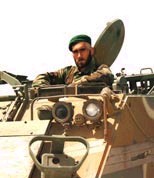
An Afghan National Army Soldier looks out from the driver's hatch of a recently donated M113A2 Gavin armored personnel carrier. Office of Military Cooperation-Afghanistan photo by U.S. Army Sgt. 1st Class Mack Davis The South Carolina Army National Guardsmen who normally train the 2nd Kandak will be leaving Afghanistan in a few months.
According to the unit's executive officer, Maj. Greg Cornell, "We want to get the (Afghan National Army) mechanized team at least to team-level proficiency on the M113 before we leave. A special range is being prepared so that we can work on maneuvers and team-level live-fire exercises."
Cornell added, "The range training will teach the (Afghan National Army) Soldiers to take two vehicles, placing one in an overwatch (security) position, and the other in a position so that the dismounts can flank the enemy and engage. We also want the (Afghan National Army) to be able to move and provide weapons fire."
Cornell said, "The (Afghan National Army) Soldiers in the mechanized 2nd Kandak that we have been working with are just ingenious; they have the ability to take any mission and figure out a way to accomplish it. They have done phenomenal things with minimum resources. As we (coalition partners) are able to provide more resources and support, there won't be much they will not be able to accomplish."
The Afghan people will get their first look at their army's newly painted M113s at the Afghan National Day Parade, scheduled for April 28 in Kabul.
Plain old "Gavin" M113 is ranked #1 by Top 10 IFV show
 See the M8 Buford/Thunderbolt AGS light tank in action!
See the M8 Buford/Thunderbolt AGS light tank in action!
www.combatreform.org/lighttanksrulefor3dmaneuver.wmv
Iraq Combat video clip: what happens when you bring a rifle to a tank fight!
 ATBs, ATVs & Dirt Bikes + Armored M113 Gavin Light Tank "Mother Ships"
ATBs, ATVs & Dirt Bikes + Armored M113 Gavin Light Tank "Mother Ships"
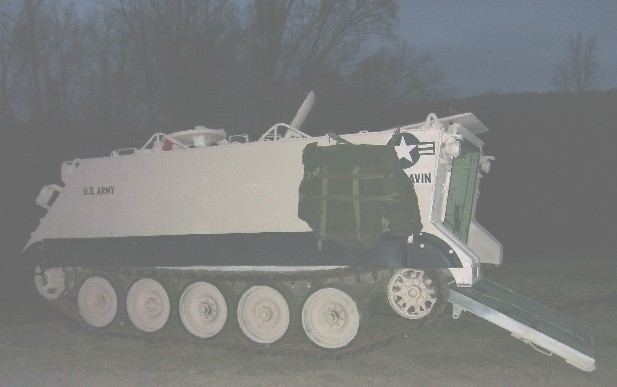
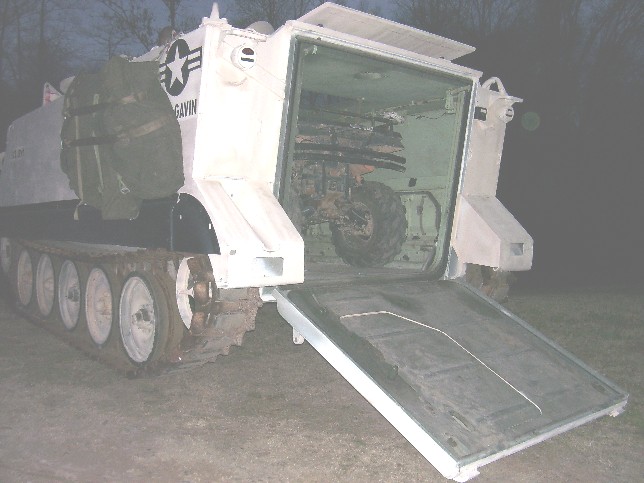
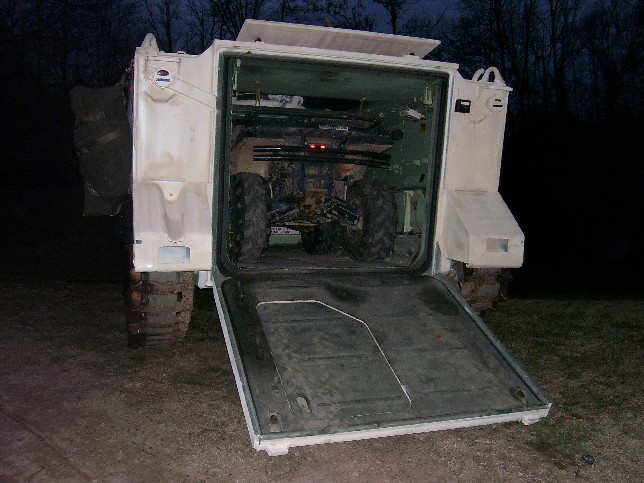
A remarkable 1st TSG (A) discovery is that not only can folded and unfolded all terrain bikes (ATBs) fit INSIDE M113 Gavin light tanks, so can motor dirt bikes and a 4x4 ATV. The idea came from pictures of the Australian Army during the Vietnam war placing 105mm light howitzers inside their M113 Gavins to effect greater cross-country mobility than trying to tow them on their wheels through the soft, muddy terrain there as well as concealing to the enemy what capabilities they were delivering.
www.diggerhistory.info/pages-conflicts-periods/ww1/lt-horse/4-19-pow-lt-horse.htm
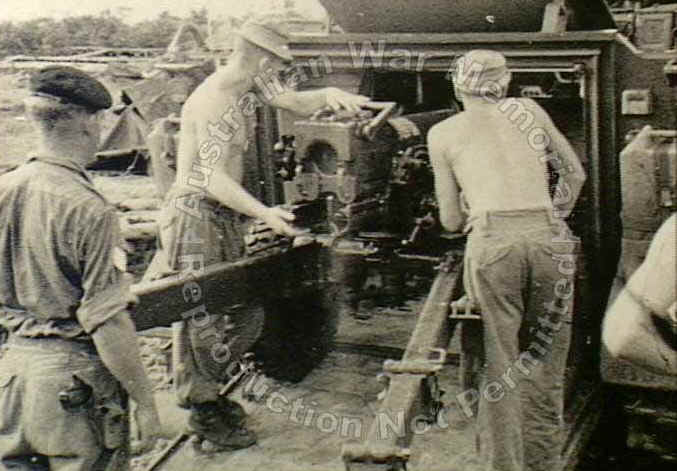
CAPTION: Bien Hoa, South Vietnam, 1965-08-18. Gunners of 161 Field Battery Royal New Zealand Artillery, manhandle a 105mm L5 pack howitzer into a M113 of 1 APC troop, Prince of Wales Light Horse, as the battery prepares to move to a temporary firing position six kilometres north of Bien Hoa airbase. The guns of 161 Fd Bty were carried to the firing site inside APC's to conceal the nature of the operation. This was the first occasion that the L5's of 161 Fd Bty were carried inside APC's. (donor H M. Lander)
Hunnicutt's book on American infantry fighting vehicles shows a jeep rolling off from inside a humongous M59 armored personnel carrier as well as photos of British General Percy Hobart's 79th Armoured Division in WW2 transporting jeeps and Bren gun APCs inside LVT-4 Buffalo amtracks across rivers under enemy fire in WW2. This gave us the idea to experiment with an ATV and dirt bike with a M113 Gavin. This capability is not possible in Stryker (an ATV can't fit and they don't swim) or Pandur (an ATV can't fit) wheeled trucks. Removing the track commander's (TC) stand from inside the M113 frees up enough space for a 4x4 ATV like the new safe diesel-powered military model made by Polaris or 3 military dirt bikes--on top of the up to 10 x folding ATBs that can be carried on the outside in Cashwell airdrop bags.
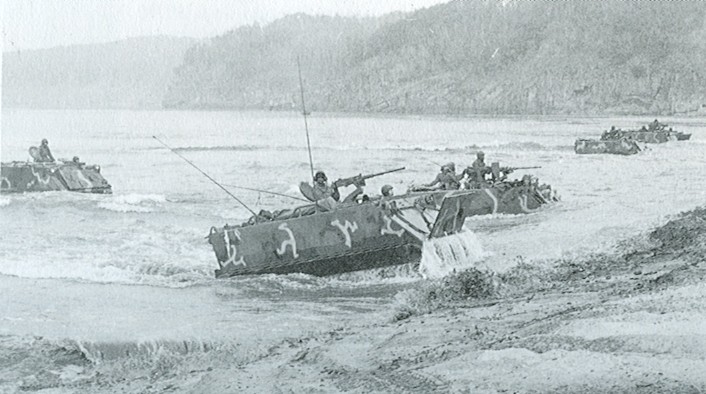
www.youtube.com/watch?v=MfzjqY0Pq3c
The Gavin's armored hull and amphibious, tracked mobility then protects these scout vehicles from enemy fires and land mines (The Battle Against Man-TBAM) while conveying them over terrain and water they cannot traverse (The Battle Against The Earth-TBATE) to the desired area of operations.
Loading an 4x4 ATV into a M113 Gavin Light Tank
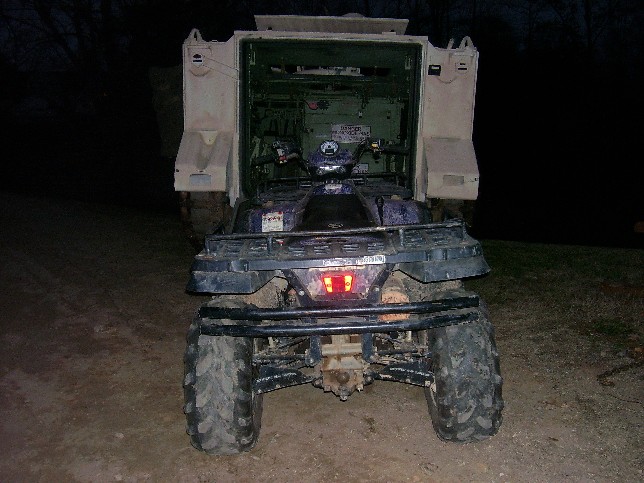
2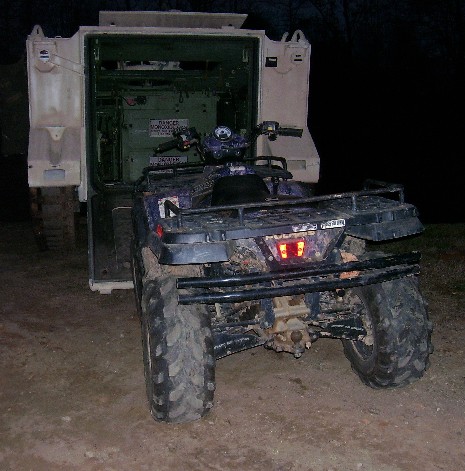
3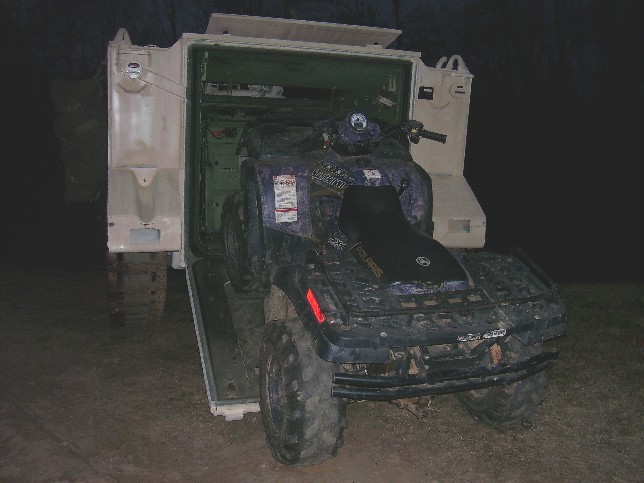
4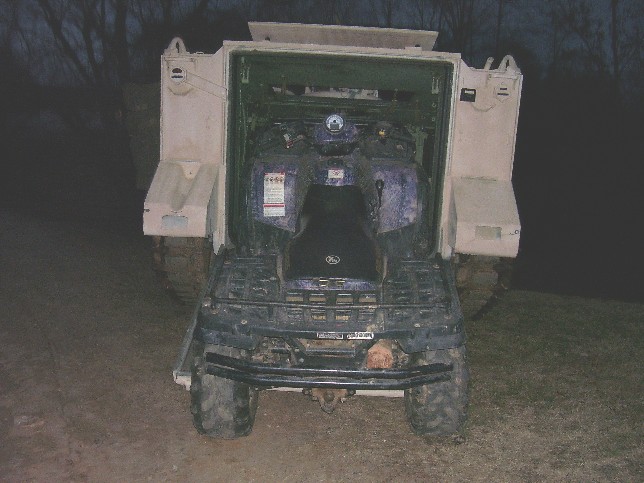
5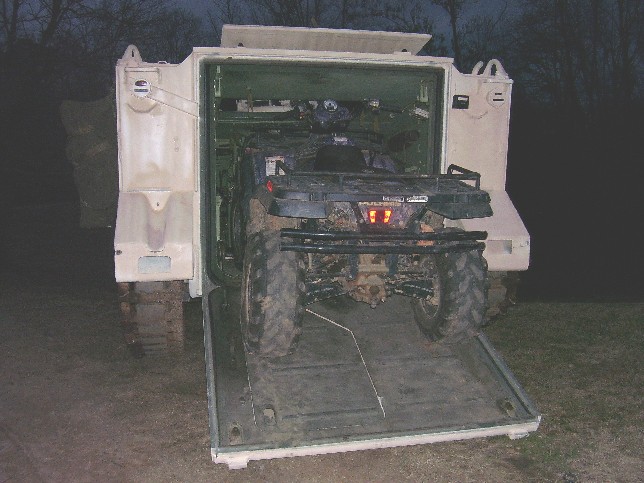
6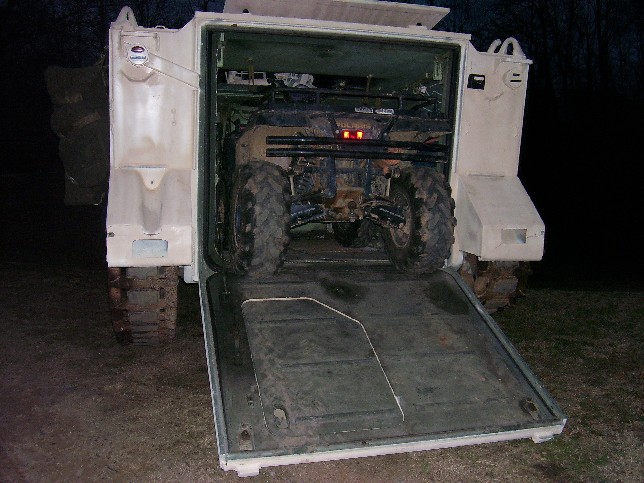
7 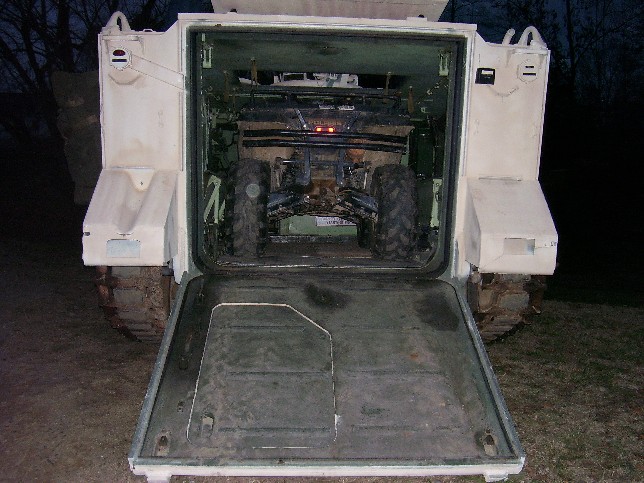
8 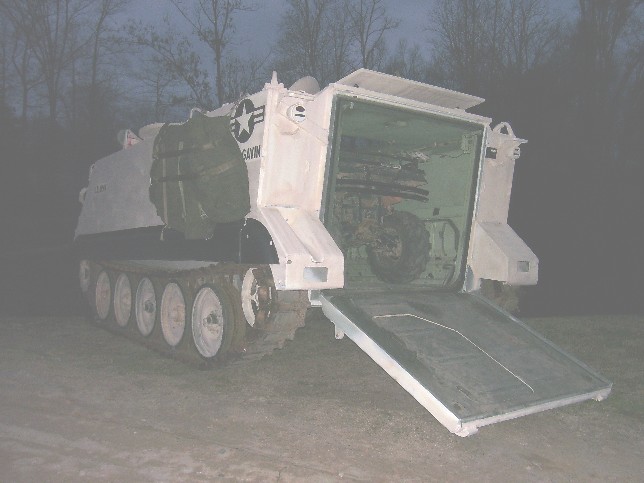
After the ATV is inside, the TC can sit or stand on its front or rear (depending on how you load it) to operate the 360 degree spinning cupola with mount for a light, medium, heavy machine gun or autocannon like the ASP-30mm.
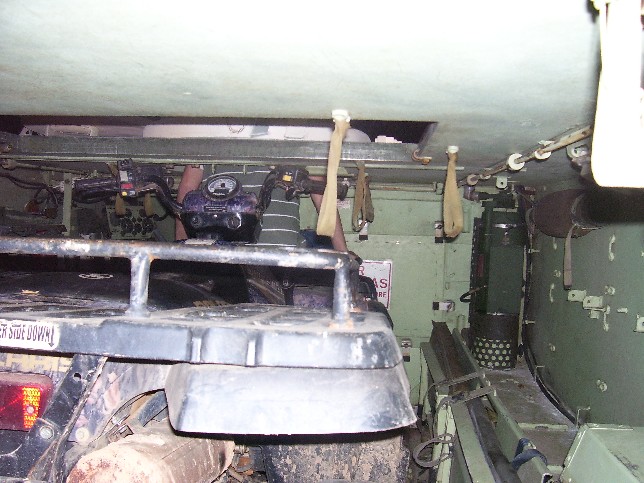
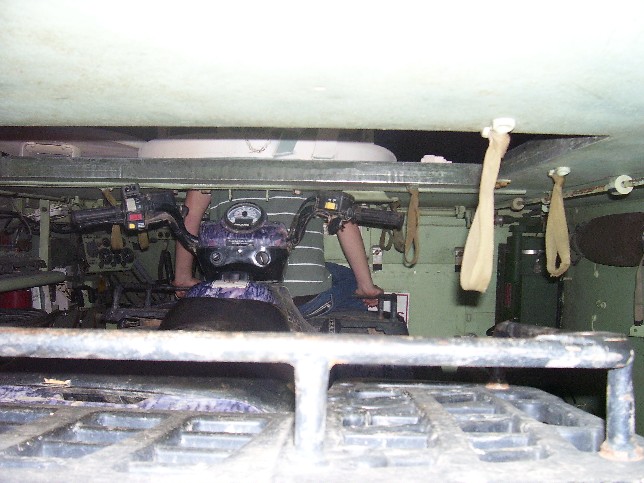
M113 Gavin + ASP-30mm Autocannon-in-action VIDEO
www.youtube.com/watch?v=9SPHgpLWPws
Dirt Bike Loading into a M113 Gavin Light Tank
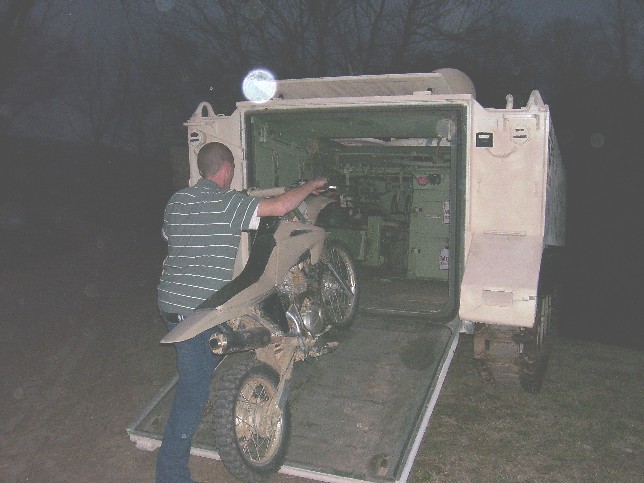
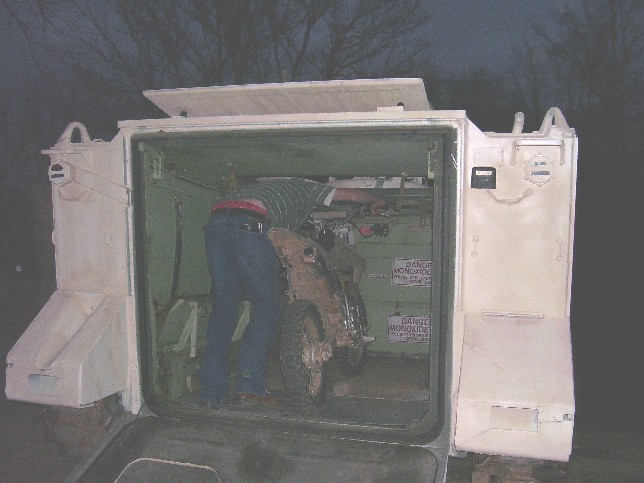
LBI Electric AeroBike Scouts
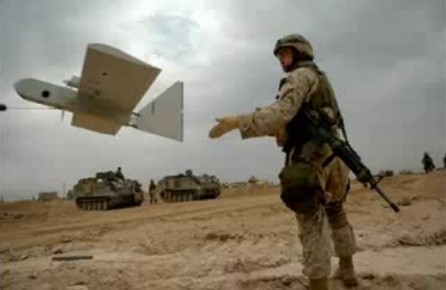
A Canadian Csaba Lemak has created an electric-powered ram-air parachute to fly one man in winds up to 15 mph. Such devices could be easily carried inside or strapped outside in bags of M113 Gavins and LBI "AeroBike" Scouts could fly them to perform air recon just as unmanned UAVs could be operated. Powered parachutes and ultralights powered by gasoline fossil fuels are easily possible in conjunction with mother M113 Gavin tanks, but these fuel are dangerous and would have to be stored in 5 gallon cans. An excellent ATV that FLIES and could fit inside a M113 Gavin is the new Chimera air/ground vehicle!
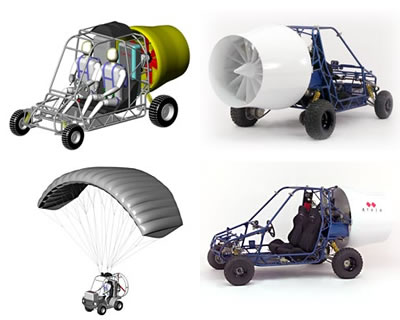

www.atairaerospace.com
Key Features of the Chimera:
Air-droppable from a C-17, C-130, or other platform using an integrated parachute system
Ground-launchable using the largest elliptical paraglider ever constructed-100 ft wing span
Ducted fan propulsion
3-Cylinder, 110 Hp, liquid-cooled engine
Hybrid-electric drive
80 Peak Hp electric wheels motors
Max takeoff weight: 2200 lbs
Dry weight: 970 lbs
Ground speed: 60 mph
Air speed: 30 kts
The new Polaris ATV and dirt bikes powered by diesel/JP-8 can use the same fuel as the Gavin uses. If the ATB and/or the fan unit were ELECTRICAL motor driven then the Gavin could charge both their lithium-ion batteries when its engine is operating. Pedal/electric ATBs and powered paragliders (PPGs) would be silent and very mobile in both 2D/3D forms of movement to be able to spot the enemy first and develop the situation from there. If while flying the electric PPG, the pedal/electric ATB is underneath ready-to-ride, it becomes an air/ground vehicle system. Perhaps by integrating the electrical motor/fan and batteries INTO THE ATB, the Li-on batteries can power the fan unit in the air and a rear hub motor on the ground with the AeroScout's pedaling helping recharge the batteries whenever possible.
www.youtube.com/watch?v=iVN_qEtBqjg
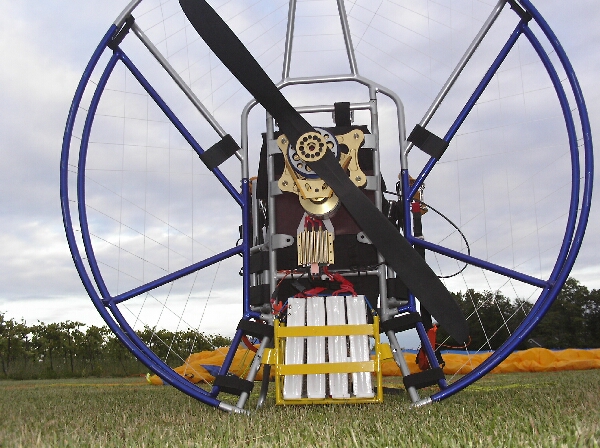
www.lightsportaircraft.ca/airventure-2006/electricpowered-poweredparaglider.html
ultralightstore@ultralightnews.ca
What's a watt?
The watt (W) is a measure of power. Power is the ability to produce force at some speed or RPM. Although the more familiar unit of power used for engines is horsepower (hp), electric motors measure their power in watts.
Don't confuse torque with power. Torque is a force, like how much pressure you must exert to get a screw out. Power is twisting against some torque through some number of revolutions per minute.
746 watts is the same as one hp. Some interesting comparisons of watts:
• A human being climbing a flight of stairs is doing work at the rate of about 200 watts.
• A trained athlete can work at up to 900 watts for short periods.
• A car engine produces work at a rate of around 100,000 watts.
An incandescent light bulb uses 40 - 100 watts.
Assuming a sky-camouflage colored parachute, power unit and jumpsuit worn by the LBI Aeroscout....
a. Is it feasible eventually to generate enough electrical power to add a 30 pound pedal mountain bike to its payload?
b. Would it be then feasible to attach the electric rear fan unit to the rear of the mountain bike and have the motor that spins the prop to also spin the rear wheel without excessive weight?
c. If not, at least give the whole unit ground mobility by pedal power....
During a 1-hour flight at 25 mph can the LBI AeroScout pedal and generate with his 1/2 a horsepower meaningful recharging of the batteries to keep him aloft?
If not, how much pedaling on the ground ostensibly doing ground movement would it take to rejuvenate his batteries for flight?
Say his parachute was 20 feet wide and 5 feet wide for a total of 100 square feet, could meaningful battery charging take place during his 1 hour flight if solar photovoltaic cells covered the top of his parachute?
How long would it take to recharge his batteries if the parachute was laid on top of the ground and staked into position there?
How long would it take to recharge the AeroBike's batteries if it was strapped to the outside of a M113 Gavin light tracked AFV that had as it ran an AC converter?
Flying APCs: Making the M113 Gavin FLY--by ITSELF = Do-It-Yourself Air-Mech (DIY-AMS)

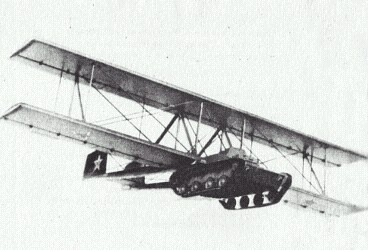
Russian KT-40 Flying Light Tank Glider
The technology already exists to make the "mother" ship M113 Gavins--a "Flying APC" aka troop-carrying, light tanks that fly--by attaching fixed-wings and a powerful prop or jet engine as legendary armored vehicle designer Walter Christie wanted to do in the 1930s with a TURRETLESS tank with hull-mounted 75mm cannon--a STUG before the Germans came up with it. The Russians flew a light tank with wings towed as a glider before WW2.
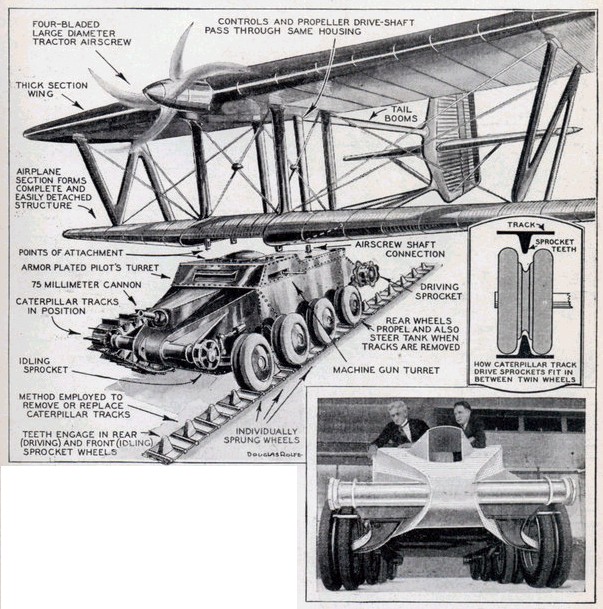
Christie's Flying Light Tank
To make the AeroGavin fly as a short take-off and landing (STOL) air/ground vehicle by parachute or fixed-wing means is just a matter of adequate funding to pay for the R&D. To make an AeroGavin take-off and land vertically would take more effort to create an autogyro system but is feasible if we have the courage and imagination to do so. AeroGavins with air/ground maneuver capabilities would fulfil British Brigadier Richard Simpkin's Race to the Swift dream as well as well as give General Gavin's KIWI concept wings--literally.
ARMOR HISTORY: IN THE MAKING, YOU ARE PART OF IT NOW
Rethink WW2 on the Ground: how did Germany hang on so long? What was their most successful tank? (Hint: it WASN'T the Panther or Tiger)
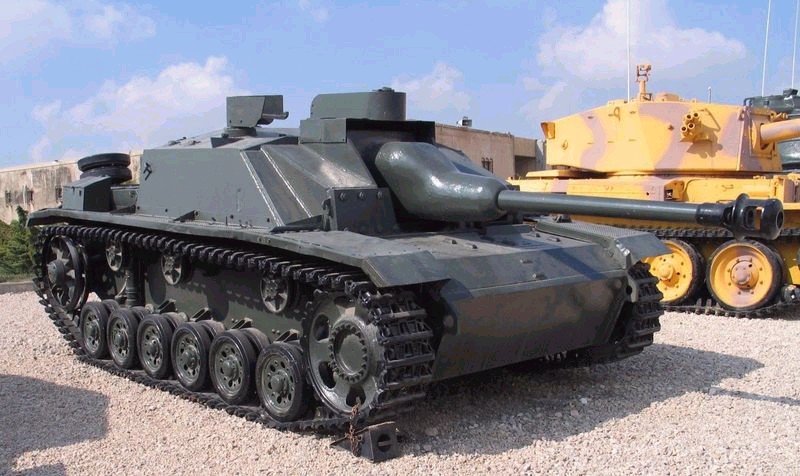
"The farther backward you can look, the farther forward you are likely to see."
--Winston Churchill
"The tank advocates (especially Guderian) have always contended that a 'tank' (possessing turret armament traversable through 360 degrees) can be employed as a Sturmgeschutz but a Sturmgeschutz cannot fight as a tank. One only has to look at the kill ratios against tanks achieved by the low-profile Sturmgeschutz with the short-barreled gun to observe that those advocating the use of tanks for both purposes paid heavily for their preference"
--Hillary Doyle, Tom Jentz, Peter Sarson; STUG III: Assault Gun 1940-1942, Osprey Publishing, Oxford, England 1999
The "usual suspects" are rounded up when the establishment group think pontificates on why the Germans lost WW2; they began with light tanks, gobbled up most of Europe, then bite off more than they could handle invading Russia, who introduced wide-tracked T34 medium tanks and then they couldn't make enough medium Panthers and heavy Tigers and were overwhelmed by allied numbers to include 55, 000 Sherman medium tanks blah, blah, blah. The question is how did Germany hang on so long?
The problem is that the common WW2 tank mythology its that its NOT fully true.
The truth is that the Germans over-ran Europe in LIGHT TANKS, and then HELD ON WITH LIGHT TANKS.
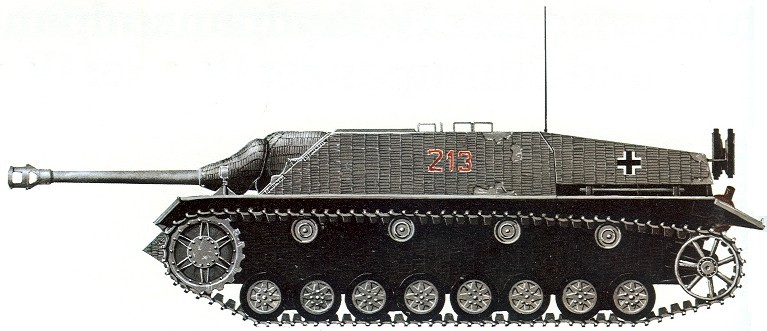
The MOST SUCCESSFUL GERMAN tank in WW2 was the TURRETLESS assault gun "Sturmgeschutze" or "STUG", a LIGHT TANK at 20 tons that was effective ALL THROUGH-OUT WW2 as both an infantry fire support tank and as a tank destroyer. The truth turret tankists don't understand that the late British combat historian Kenneth Macksey realized was if you do away with the weight/complexity inefficiency of the turret you can have a HEAVY TANK KILLING GUN and VERY HEAVY ARMOR on the front with a very low silhouette to not even be hit in the first place--and still have a very light tank for outstanding cross-country and air transport mobility. STUGs were the do-anything "M113s" of the German Army in WW2. 30, 000 Allied tanks were destroyed by 10, 000 STUGs. The question has to be asked; what would have happened had the Germans concentrated production on just STUGs to get say 50, 000 of them and stopped wasting time and resources on 5, 000 less mobile Panther/Tiger essentially heavy tanks? What if they had improved the STUG by widening its track width and providing better roof armor and a rapid-firing 20mm roof cannon to ward off our fighter-bombers? The Germans had their most success with mechanized infiltration, non-linear war tactics when they used LIGHT TANKS like the excellent Czech-built 35T and 38Ts which had excellent closed terrain mobility to surprise the Allies by going through "unpassable for tanks" terrain like the Ardennes forest.
The Amazing Czech-Built 10-ton 38T Light Tank: Could be flown by Me-321 glider or Me-323 STOL transport plane: even better as a turretless Hetzer STUG
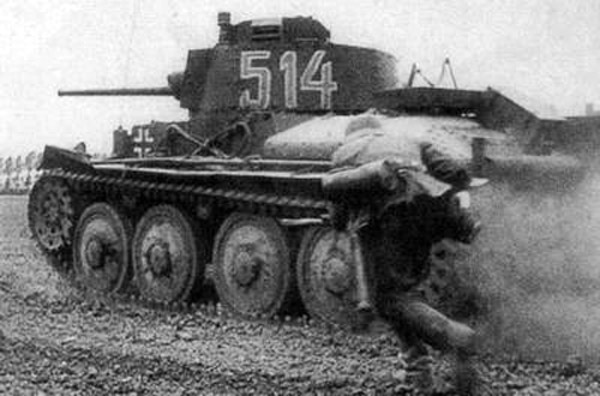
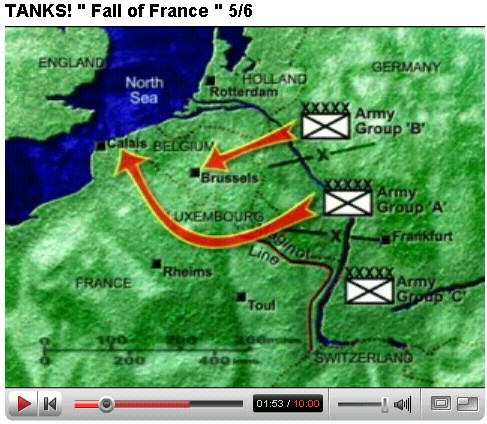
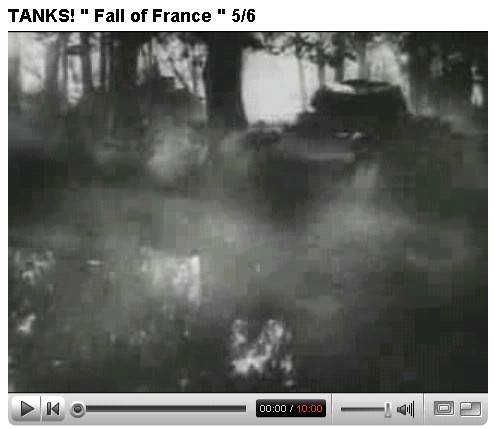
38T Variants
STUG Assault Guns : "Hetzer" and "Marder III"
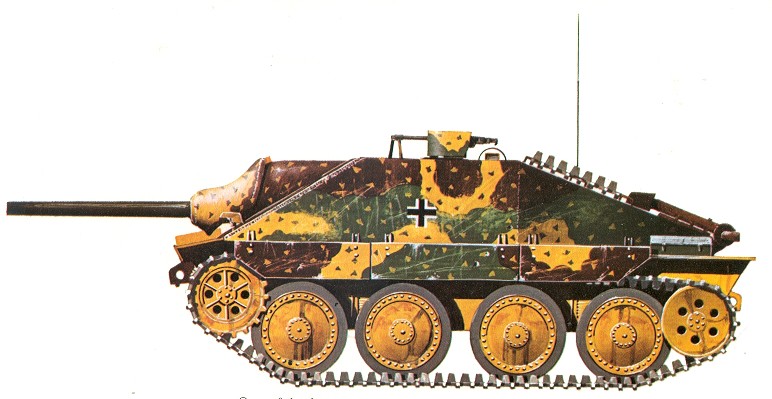
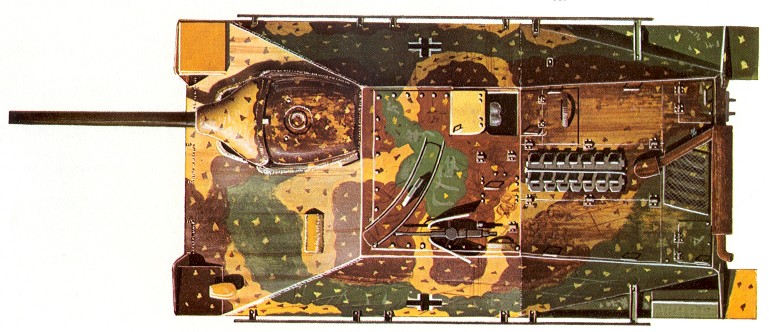
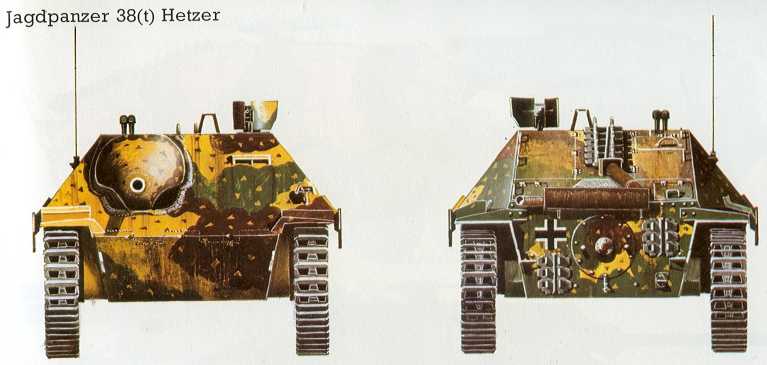
www.youtube.com/watch?v=Pk9HriWsQ2A
SP Anti-Aircraft Gun
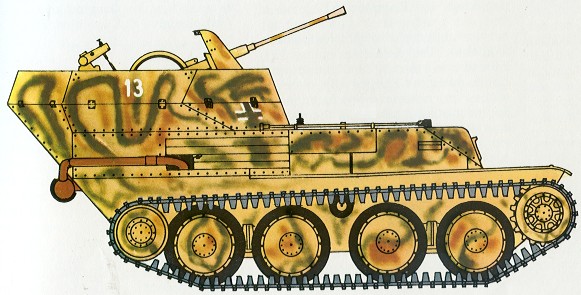
The excellent 10-ton 38T chassis was also made into the superb Hetzer STUG with hull-mounted assault/tank destroyer gun. And contrary to popular myth, Guderian liked and wanted more STUGs over more turreted Mark IV light to medium weight tanks.
Another benefit of light tanks is simplified mobility engineering;
River Crossing: German Assault Pioneer Style
Part 1: Fascinating conceptual presentation using animation; engineers act as terrain cavalry for main body, More excellent outboard motor to push assault boats fast across the water to the far bank means less exposure to enemy fire than paddling as 82nd Airborne had to to cross Waal to take Nijmegan bridge, minimalist ferry concept pushed by motor assault boat at least gets towed AT guns across, ferries become pontoon bridge
Part 2: pontoon bridge enables excellent Czech-built 38T light tanks and pioneers in motorcycle sidecars to cross, Dragon's teeth tank obstacles blown up, rubber boat to cross another small river where a girder bridge is projected across, minefield encoutered they launch some form of smokescreen shell to mask themselves as the bangalore torpedo some wire and mines to make a breach, smoke grenades used liberally, flamethrower and pole charge against a pillbox
The Germans had a "killer bee" mudfighter ON THE GROUND in WW2---it was the STUG. They also had a "stealth fighter" and M113 Gavin near-equivalent in the STUG and 38T chassis.
Turret Fixation Caused the Allies to be Creamed in WW2
The next question is why did we, the allies FAIL TO LEARN THE TRUE LESSON OF EUROPEAN GROUND WARFARE, which is to USE LIGHT TURRETLESS TANKS with maximum terrain mobility to support infantry in closed terrain and be air-transportable?
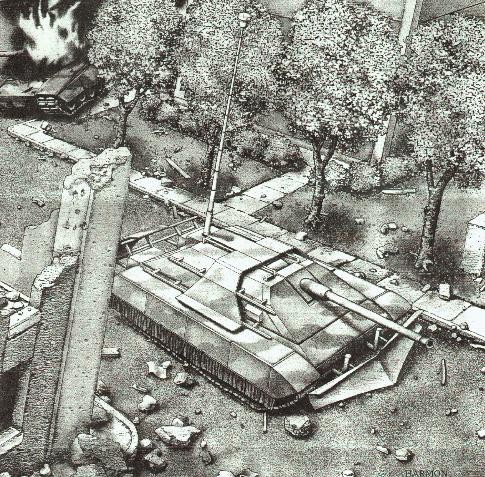
The turretless light tank U.S. Army Forces Need Today
We knew from even in France in 1940 that the German 88m anti-aircraft gun was a formidable tank killer. We had guns like the British 76.2mm "17 pounder" and 90mm guns that could meet the RANGE and lethality of the German 88mms--so why didn't we place them in a TURRETLESS hull STUG clone and attain at least parity if not overmatch? All this whining about the high-silhouette Sherman tanks being out-gunned and not armored enough could have been solved by placing a gun equal or superior to the German 88mm in a thick frontal armor hull with low silhouette on a fast, light tank chassis with Walter Christie suspension. The problem was--and still is TURRET FIXATION by the Army's tank duelers who want to lazily swivel a turret instead of maneuvering their tank into ambush positions.
The M113 is a turretless STUG but without the big gun. Gavin realized this need for go-anywhere light tanks when he created the M113. Soldiers in Vietnam who attached 106mm recoilless rifles to their M113s in essence created STUGs. Today we got the M113 STUG chassis but still don't have the building/bunker/tank busting big guns for them. Why did we fail to understand and emulate the MOST SUCCESSFUL GERMAN TANK but instead proceeded to re-invent the German heavy breakthough tank? Is it because our hubris-filled narcissistic infantry hates to admit it needs mechanization at all? (YES). No comparable "Hobart's Funnies" in arrogant U.S. forces on D-Day and heavy casualties on Omaha Beach nearly cause the entire invasion to fail. Could it be that not only is our own lack of a progressive-thinking CAVALRY BRANCH the cause of our ignorance of the need for LIGHT TANKS for cavalry mobile recon and independent operations, but its our egomaniac infantrymen who don't realize they need assault fire support that even the uber-narcissistic Germans realized they needed on the initiative of Manstein in 1935? Combine this with a bunch of heavy tankers who only want to duel other tanks (tank destroyer and breakthrough tasks) in medium to heavy tanks that can only operate in open, firm open terrain (AKA "tank country") and we have a recipe for disaster replayed again and again at Kasserine Pass in 1943, Cisterna a little later, all throughout the rest of WW2 in Europe, Task Force Smith in Korea, in Vietnam when we decided to foot slog from helicopters, and now in Iraq/Afghanistan.
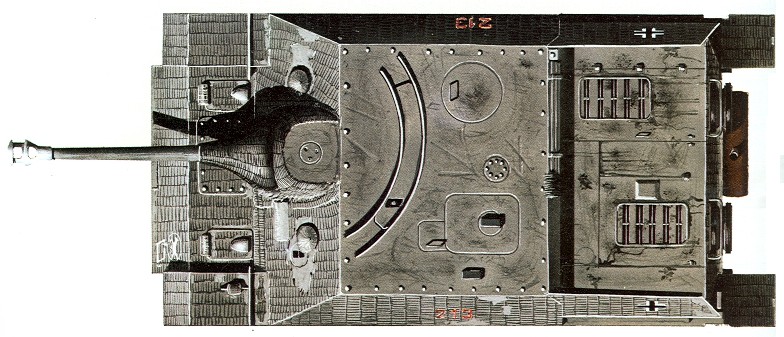
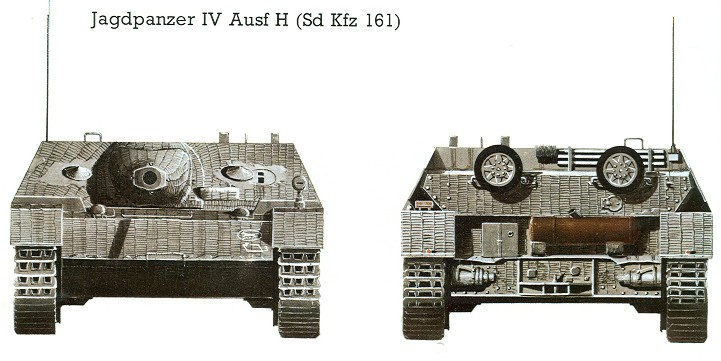
Americans had trouble fitting an adequate anti-tank killing gun in a turret during WW2? WHY DIDN'T WE EMULATE THE GERMANS AND PUT A 90mm GUN IN THE HULL IN A FIXED MOUNTING TO BE OUR TANK DESTROYERS? Why did MacNair insist on 360 degree revolving turrets with open tops, he couldn't see the STUG clearly in German newsreels and our own intel reports? How many Americans who died in high-profile tank destroyers with inadequate armor for such a visible turreted presence? Imagine how hard-to-hit a turretless 60 mph M18 Hellcat would be...
German Turretless Assault Guns "STUGs": inspiration for today's M113 Gavin Assault Guns
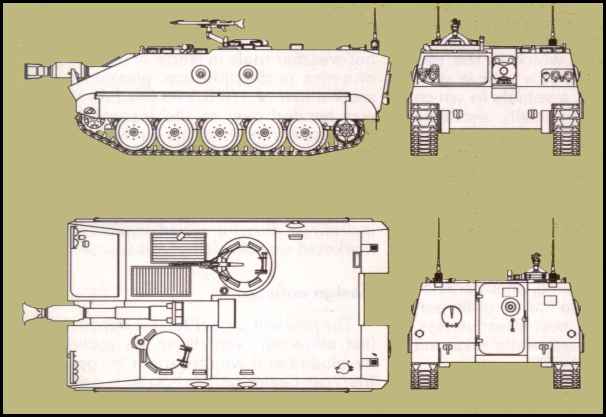
Actual Post-WW2 German Army STUG version of the M113 Gavin
Firepower: Turretless is better
During combat against sub-national groups the enemy will be mostly infantry or idiots in wheeled trucks so not having a turret and having a negative 10 degree or plus 20 degree elevation and 24 degrees of left/right traverse of your main gun is not a problem. On top machine guns or autocannon on a 360 degree swivel can provide close-range defense.
The STUG had the following firepower in WW2 that puts our current Army/marines to shame:
54 x 75mm shells
15 x smoke (more direct-fire projected smoke than we have today to thwart ATGMs and mask maneuvering infantry)
15 x armor-piercing
24 x high explosive
Smoke candles in rack on back deck could be released to lay a smoke screen for the unit
10, 000 STUGs destroyed 20-30, 000 allied tanks, a 3-to-1 raw input/output exchange ratio
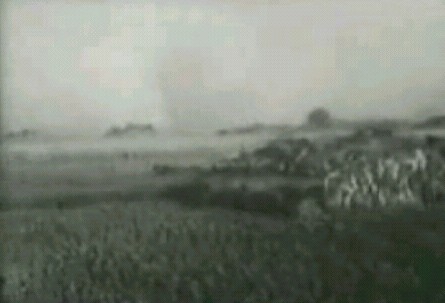
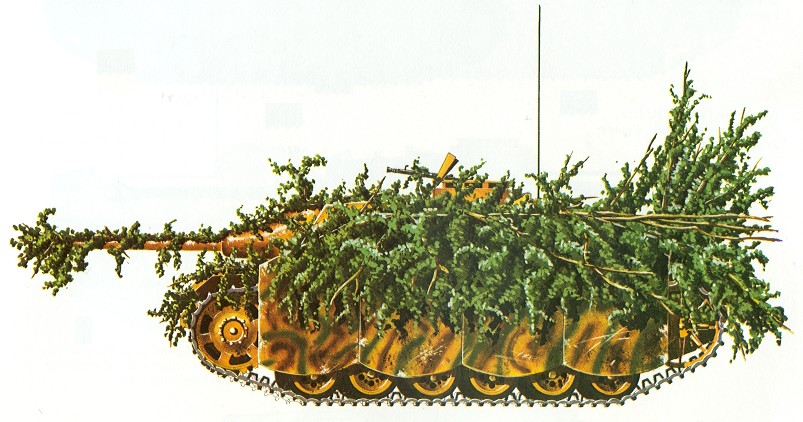
Not having a turret to have a height under a man, making you extremely hard-to-hit using folds in the terrain, vegetation, camouflage with 24 degrees of instant gun traverse and the remaining 336 degrees of aiming after turning the vehicle to face the threat with heaviest armor protection is a greater advantage than having instant 360 degree gun firing traverse capability that offer the enemy a visible target far above the height of a man that can hit you instantly from all directions
The Germans were only able to make 5, 000 hard-to-produce, complicated turreted Tiger heavy tanks to 55, 000 American Sherman medium tanks, perhaps if they had instead produced 50, 000 simple STUGs with 75mm guns they'd have stopped the allied advance?
Turrets Stink
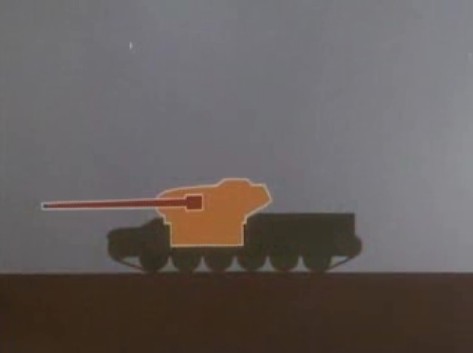
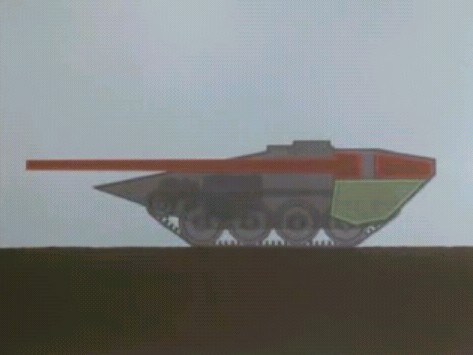
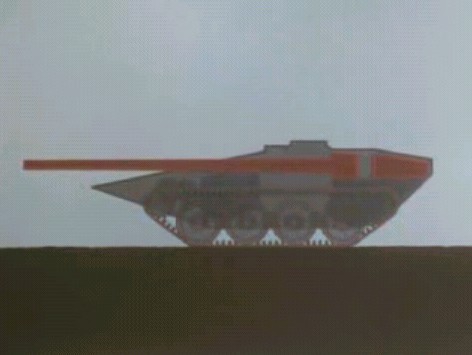
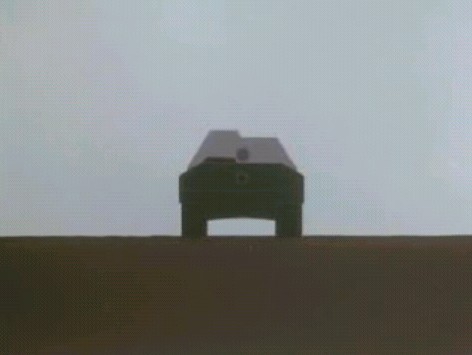
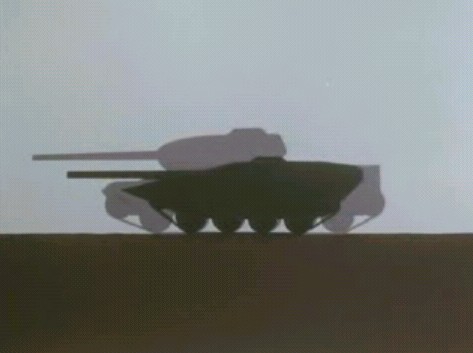
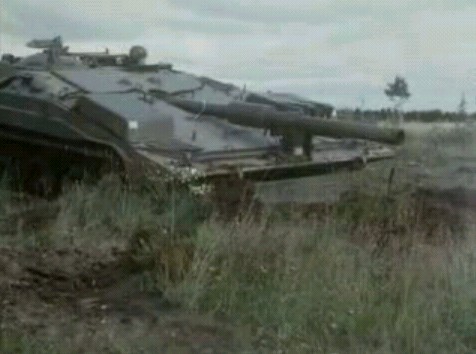
If there's no defilade, the "S" tank can make its own hull-down position with a dozer blade!
Swedish "S" Medium Tank Documentary: This will Convince if you are not already!
www.youtube.com/watch?v=RSo2GFugQ7Y
Turretless Benefit: Everyone is a Driver
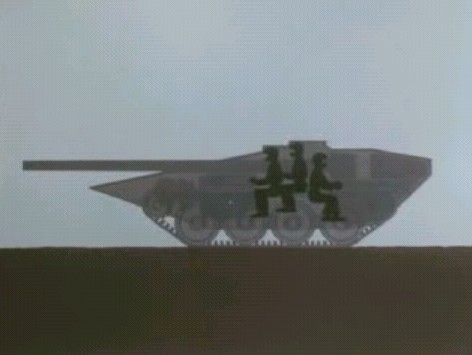
In the S tank everyone is a driver to spell the main driver/gunner...the man facing the rear can immediately drive the tank in the opposite direction WITHOUT HAVING TO TURN!
The "S" tank can be operated by just 2 and even 1 man in a pinch...
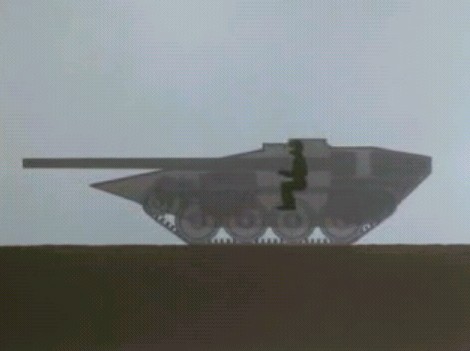
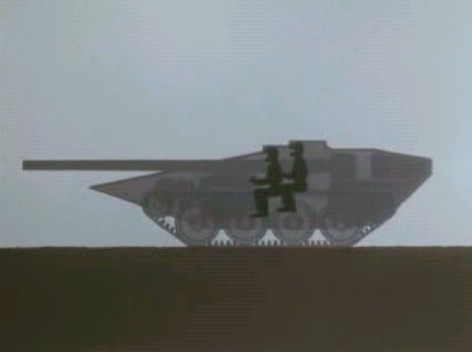
We wonder how a turretless Swedish "S" medium tank with the same one-shot-one-kill fire control but heavier armor than a turreted heavy tank do against a M1 Abrams in open terrain moving directly at eachother, Kursk-style if terrain folds shield the turretless tank so the turreted one can't even hit them, but the turreted ones are easily hit within the limited 24 degree left/right traverse? 30 tons of the M1's weight is its huge turret with lots of dead air holding 3 dead men inside just asking to be popped by enemy ATGMs; would you want instead to use this weight for ACTUAL ARMOR to protect you or have a lower overall weight to at least get medium weight 12 PSI mobility?
And by being a MEDIUM tanks, the "S" tank can SWIM itself across lakes and rivers! Try doing that in a heavy tank! (you can't).
Turretless Amphibious Mobility
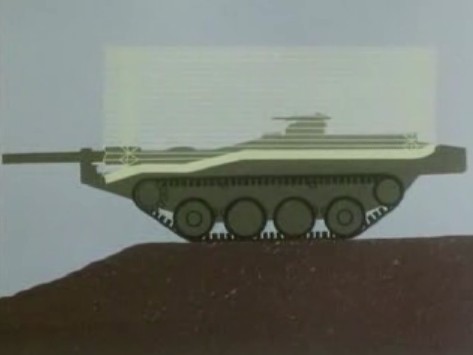
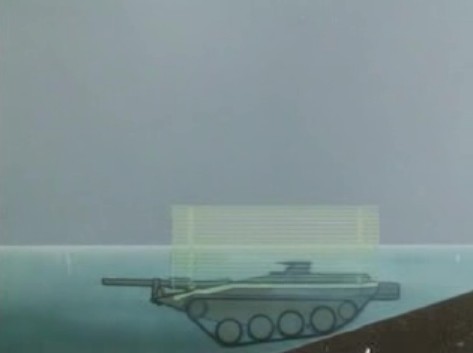
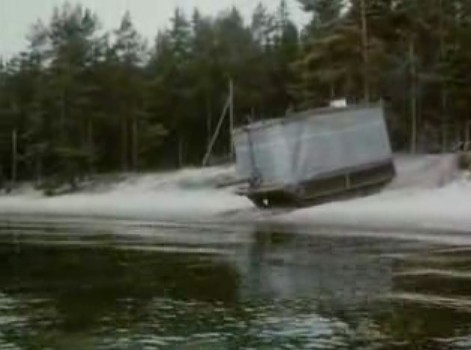
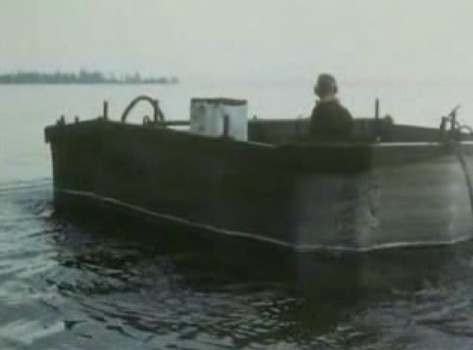
Mobility: good thing the Germans were handicapped with steel
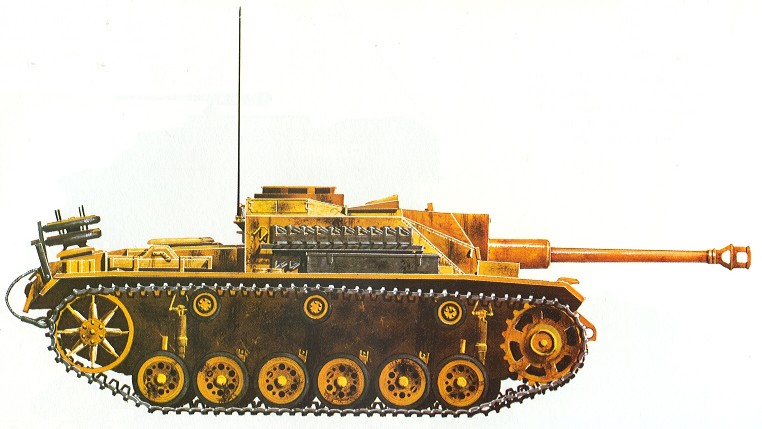
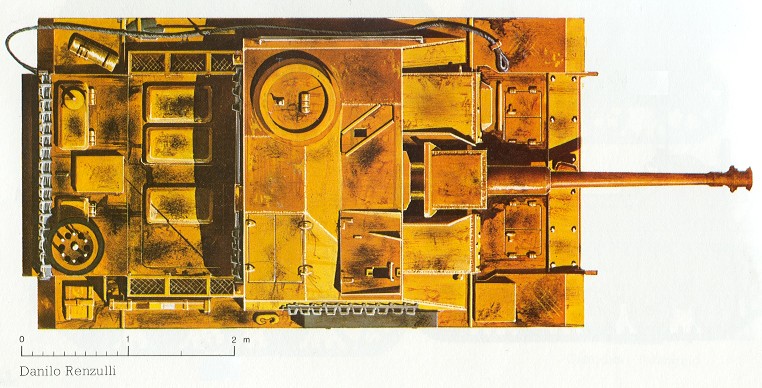
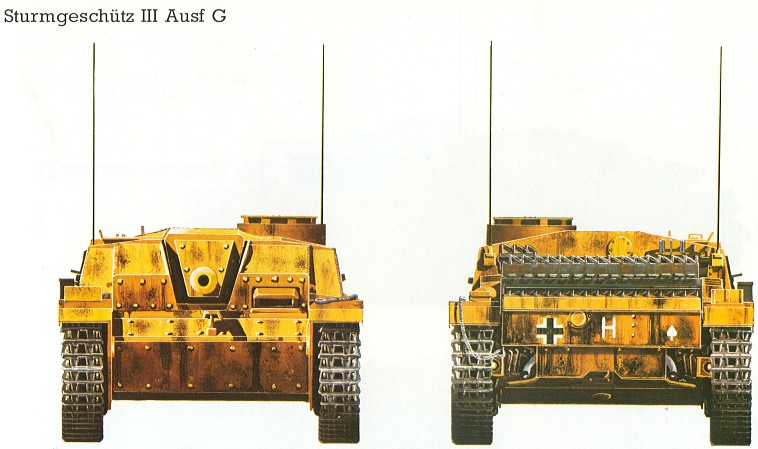
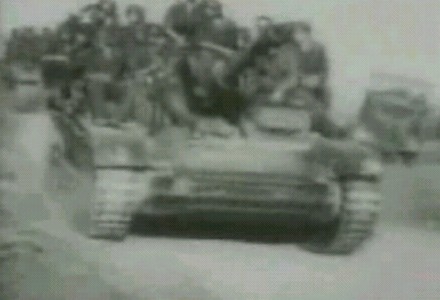
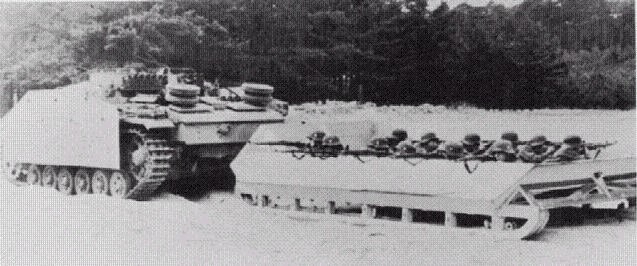
STUGs could give infantry a ride on back or towed behind in a snow sled as required...
The STUG at 20 tons with 15 inch wide tracks had a lousy high ground pressure of 16 PSI---the same as our M1 Abrams heavy tanks of today. The reason is the STUG was made of very heavy steel and even with extreme minimalism by having no turret ended up weighing 20 tons. Track extensions were fitted that widened the tracks to 20 inches lowered ground pressure to 12 PSI or medium Bradley mobility levels. Still better closed terrain mobility than their Tiger heavy tanks!
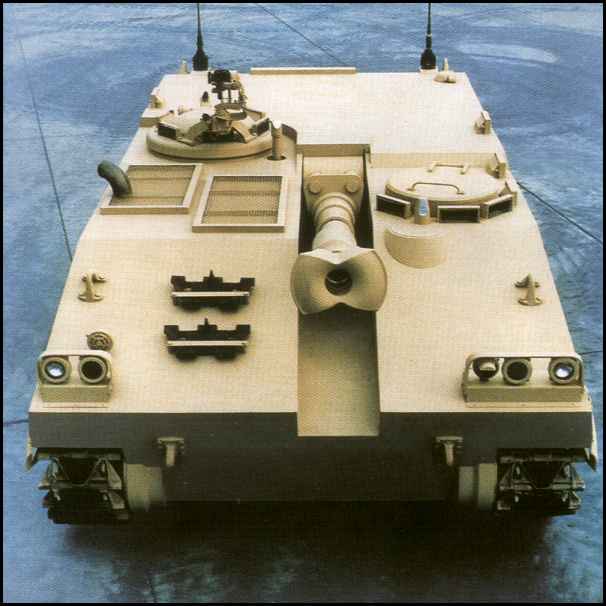
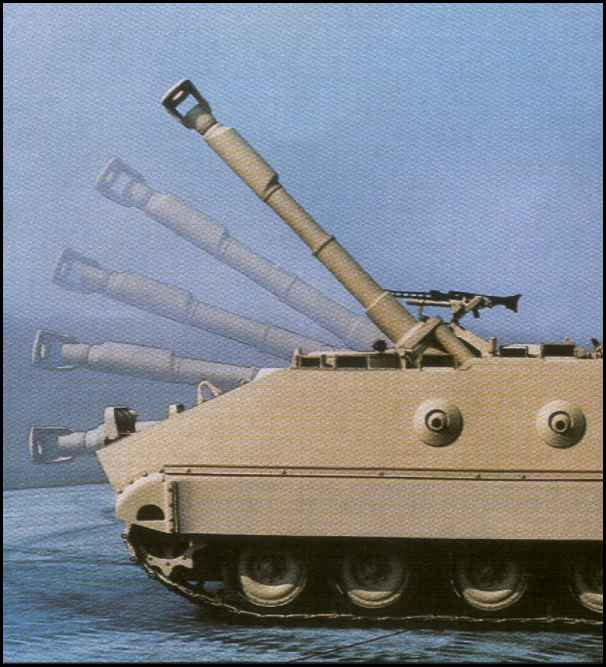
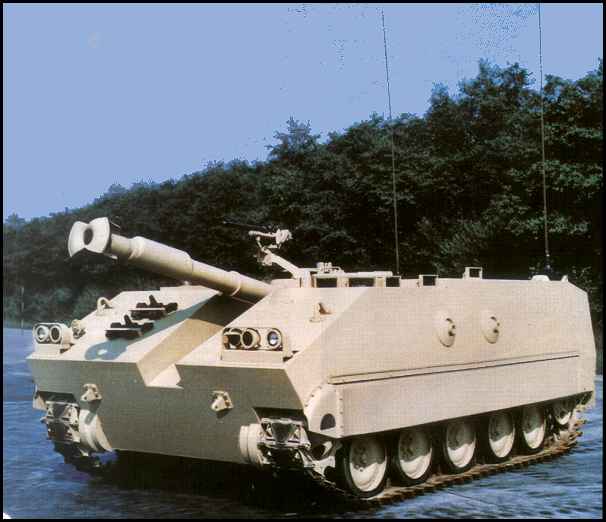
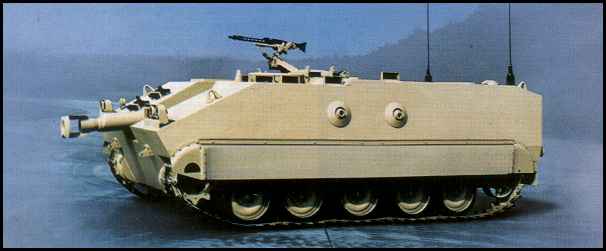
Photos of an actual Post-WW2 German Army prototype of a STUG version of the M113 Gavin
In contrast, the M113 Gavin made out of aluminum alloy armor is roughly just as thick as the 2" thick STUG but weighs HALF the weight at 10 tons with room inside to carry a 9-man infantry squad with 15 inch wide tracks, has a 8 PSI ground pressure. All things being equal, reducing the M113 Gavin hull to just what's needed for a 4-man assault gun crew, even with an assault gun/ammo should reduce weight to 8 tons and get ground pressure down to 4-6 PSI, plus the Gavin SWIMS and if a reduced width Mini-Gavin flies inside CH-47 Chinook helicopters. Good thing the Germans didn't figure out aluminum alloy armor!
Protection: not being there is the best armor
The STUG was 2 inches thick on its front, protective up to early war 40mm guns only. So if everyone's guns could penetrate it, how did they not just survive, but THRIVE?
STUGs exploited the first battle against the earth---by hugging the ground human foes couldn't get line-of-sight to even hit them. If you can't hit you don't have any penetration effects.
http://en.wikipedia.org/wiki/StuG_III
Sturmgeschütz IIIVIDEOSFrom Wikipedia, the free encyclopedia
StuG III Ausf. G in Yad la-Shiryon museum, Israel.
Type: assault gun
Place of origin: Germany
Production history
Number built 10,500Specifications
Weight 23.9 tonnes
Length 6.85 m
Width 2.95 m
Height 2.16 m
Crew 4-------------------------------------------------------------------
Armor 16 - 80 mm
Primary armament 1x 7.5 cm StuK 40 L/48
54 rounds
Secondary armament
1x 7.92mm Medium Maschinengewehr 34
600 roundsEngine Maybach HL120TRM V-12 gasoline engine
300 hp (224 kW)
Power/weight 13 hp/tonne
Suspension torsion barOperational range 155 km
Speed 40 km/hThe Sturmgeschütz III (StuG III) assault gun was Germany's most produced armoured fighting vehicle during World War II. It was built on the chassis of the Panzer III tank. Initially intended as a mobile, armoured light gun for infantry support, the StuG was continually modified and was widely employed as a tank destroyer.
The Sturmgeschütz series is probably best known for its excellent price-to-performance ratio. By the end of the war, over 10,500 had been built.
Contents
1 History
2 Operational history
3 Variants
4 External linksHistory
The Sturmgeschütz III originated from an initial proposal that Colonel Erich von Manstein submitted to General Beck in 1935 in which he suggested that Sturmartillerie (Assault Artillery) units should be used in a direct-fire support role for infantry divisions. On June 15, 1936 Daimler-Benz AG received an order to develop an armoured infantry support vehicle capable of mounting a 75 mm (3 in) artillery piece. The gun was to have a limited traverse of a minimum of 25 degrees and be mounted in an enclosed superstructure that provided overhead protection for the crew. The height of the vehicle was not to exceed that of the average man.
Daimler-Benz AG used the chassis and running gear of its recently designed Panzerkampfwagen III light tank as a basis for the new vehicle. Prototype manufacture was passed over to Alkett, which produced five examples in 1937 of the experimental 0-series StuG based upon the PzKpfw III Ausf. B. These prototypes featured a mild steel superstructure and Krupp's short-barreled 75 mm Sturmkanone 37 L/24.
As the StuG III was intended to fill an anti-infantry close support combat role, early models were fitted with a low-velocity 75 mm StuK 37 L/24 gun, firing high explosive shells. After the Germans encountered the Soviet T-34, the StuG III were armed with the high-velocity 75 mm StuK 40 L/43 (Spring 1942) or 75 mm L/48 (Autumn 1942) anti-tank gun.
Later models of the StuG III had a 7.92mm MG34 mounted on the hull for added anti-infantry protection.
In 1944 the Finnish Army received 59 StuG III from Germany and used them against the Soviet Union. These destroyed at least 87 enemy tanks for a loss of only 8 StuG's (some of these were destroyed by the crew when they abandoned the vehicle to prevent capture). After the war they were main combat vehicles of the Finnish Army until early 1960s. These Sturms gained the nickname "Sturmi" which can be found in some plastic kit models.
Sturmgeschutz III's were also exported to other nations like Bulgaria, Hungary, Italy, Romania, and Spain.
After the Second World War, the Soviet Union gave some of the captured German vehicles to Syria, which continued to use them at least until the Six Days War (1967).
Operational history
Probably the most successful engagement involving Sturmgeschütz III Ausf F took place in Stalingrad in early September of 1942. Stug III Ausf F from Stug.Abt.244, commanded by Oberwachtmeister Kurt Pfreundtner destroyed 9 Soviet tanks in 20 minutes. On September 18, 1942, Oberwachtmeister Kurt Pfreundtner received the Knight's Cross for this achievement.
From 1 to 4 January 1943, Unteroffizier Horst Naumann from Stug.Abt.184 destroyed 12 Soviet tanks during heavy fighting in the Demyansk area. On January 4, Naumann was awarded a Knight's Cross for destruction of a total of 27 enemy tanks.
The most notable Waffen SS Stug ace was Waffen SS Sturmbannführer Walter Kniep, who commanded the 2nd Sturmgeschütz Abteilung of 2nd Waffen SS Panzer Division "Das Reich". From July 5, 1943 to January 17, 1944, his unit claimed destruction of some 129 Soviet tanks, while losing two Stugs. Kniep was then awarded the Knight's Cross.
Overall, Sturmgeschütz series proved to be very successful and served on all fronts as assault guns and tank destroyers. Although Tigers and Panthers are more famous, assault guns killed many tanks. Because of their low silhouette, Sturmgeschütz III's were easy to camouflage and a difficult target. Most German assault guns carried a high-velocity 75mm gun by 1944. Sturmgeschütz crews were considered to be the elite of the artillery units. Sturmgeschütz units held a very impressive record of tank kills - some 20,000 enemy tanks by spring of 1944. As of April 10, 1945, there were 1,053 Stug IIIs and 277 StuH IIIs in service. Approximately 9,500 Sturmgeschütz IIIs of various types were produced until March of 1945 by Alkett and a small number by MIAG.
Variants
/wiki/Image:Stug3g.jpg/wiki/Image:Stug3g.jpg
Early version StuG III Ausf. G
/wiki/Image:StugIII_at_Kursk.jpg/wiki/Image:StugIII_at_Kursk.jpg
A 1944 model
StuG III Ausf. G. Note the Saukopf gun mantlet.
/wiki/Image:Sturmhaubitze-42.jpg/wiki/Image:Sturmhaubitze-42.jpg
Sturmhaubitze 42 at the Auto- und Technikmuseum Sinsheim, Germany.
StuG III Ausf. A (Sd.Kfz 142; 1940, 30 produced)
First used in the Battle of France, the StuG III Ausf. A used the chassis of the Panzer III Ausf. F and the 7.5 cm StuK 37 L/24 gun.
StuG III Ausf. B (Sd.Kfz 142; 1940-41, 320 produced)
Widened tracks and other minor changes.
StuG III Ausf. C (Sd.Kfz 142; 1941, 50 produced)
Minor improvements over the StuG B.
StuG III Ausf. D (Sd.Kfz 142; 1941, 150 produced)
Minor improvements over the StuG C.
StuG III Ausf. E (Sd.Kfz 142; 1941-42, 272 produced)
A MG 34 is added to protect the vehicle from enemy infantry. Other minor improvements.
StuG III Ausf. F (Sd.Kfz 142/1; 1942, 359 produced)
The first real upgunning of the StuG, this version uses the longer 7.5 cm StuK 40 L/43 gun. This change marked the StuG as being more of a tank destroyer than an infantry support vehicle. Side hull skirts were added to some F models for protection from Soviet anti-tank rifles; although these skirts were far more common on the later ausf G.
StuG III Ausf. F/8 (Sd.Kfz 142/1; 1942, 334 produced)
Another upgunning, the F/8 used 7.5 cm StuK 40 L/48 gun.
StuG III Ausf. G (Sd.Kfz 142/1; 1942-45, 7,893 produced)
The final, and by far the most common, of the StuG series. The G-series StuG used the hull of the Panzer III Ausf. M and after 1944 a second machine gun. Later versions were fitted with the Saukopf (Ger. pig's head) gun mantlet, which was more effective than the original box metal structure at deflecting shots. Side hull skirts were added to G models for added armour protection on their sides.
Other Stug III Based Vehicles
Some StuG III were also made from a Panzer III chassis but fitted the bogie suspension system of the Panzer IV tank. Only about 20 were manufactured. The intention was to simplify field repairs but this did not work out well and the model was cancelled.
In 1942, a variant of the StuG III F was designed with a 10.5 cm (105 mm) howitzer instead of the 7.5 cm StuK 40 L/43. These new vehicles, designated Sturmhaubitze 42 (or StuH 42, also known by its Wehrmacht designation Sd.Kfz 142/2) were designed to provide infantry support with the increased number of StuG III F/8 and Gs being used for anti-tank duties. The StuH 42 mounted a variant of the Model 1918 Light Field Howitzer, modified to be electrically fired and fitted with a muzzle brake. Later models were built from StuG III G chassis as well as StuG III F and F/8 chassis. The muzzle brake was often deleted as well because of the scarcity of resources.
In 1943, 10 StuG IIIs were converted to StuG I (FLAMM) configuration by replacing the main gun with a Schwade flamethrower. These chassis were all refurbished at the depot level and were a variety of Pre-Ausf. F models. There are no reports to indicate any of these were used in combat and all were returned to a Stug III G standard at depot level by 1944.
The Soviet SU-76i self-propelled gun was based on captured German StuG III and Panzer III vehicles. About 1,200 of these vehicles were converted for Red Army service by adding an enclosed superstructure and the ZiS-5 76.2 mm gun.
PART 1: 3:24, 5:17 German bicycle troops by STUGs, able to kill Russian turreted tanks despite inadequate original gun
PART 2: STUGs give infantry a ride on back, track extensions to widen tracks and lower ground pressure, "Ostketten", sideskirtsdefeat 14.5mm AT rifles, deflect cannon shells, open terrain assault of hill with Hungarian infantry on back deck jumping down and fanning out, able to easily knock out T34s at 2, 000 meters with 1 or 2 shots, light assault guns more mobile in Italy than medium to heavy tanks, Salerno defense, Anzio blockage, pivot turning ability enables STUG to help defend Cassino
www.youtube.com/watch?v=65AwLiKUFgo
PART 3: hiding in ruins, helps paras hold, shoot n move tactics on Russian plains, most numerous German tank, 1100 turreted panzers to repel D-Day landings, only 300 STUGs, easily killed Shermans, German AAA 20mm, 37mm, 88mm couldn't ward off prop "Jabos" fighter-bombers so German tanks had to hide, crews dug holes and parked STUG on top as overhead cover, anti-magnetic mine paste,
www.youtube.com/watch?v=kFXBfCbqii8
PART 4: heavy toll on Russian tanks, Warsaw uprising, concrete applied to front/side superstructure, HS-129 anti-tank aircraft, 88mm panzerschrek defeats all known allied tanks, G models had remote controlled roof machine gun
www.youtube.com/watch?v=xPByoerT6IY
PART 5: overwhelmed by allied numbers, MP44 assault rifles, Goliath remote control minitank to take out allied tanks,
www.youtube.com/watch?v=SJMTIV6ZPL4
PART 6: 30, 000 allied tanks destroyed by STUGs
www.youtube.com/watch?v=fQMoL453Nwg
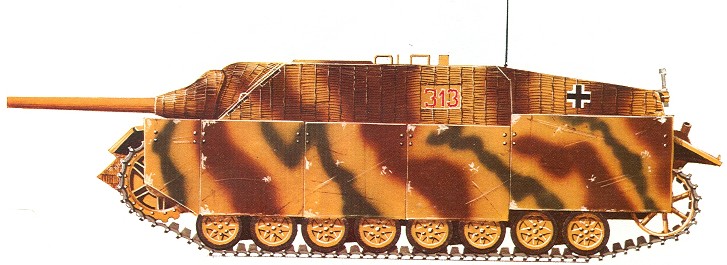
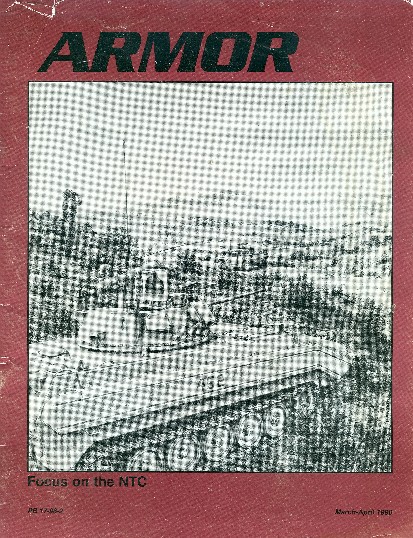
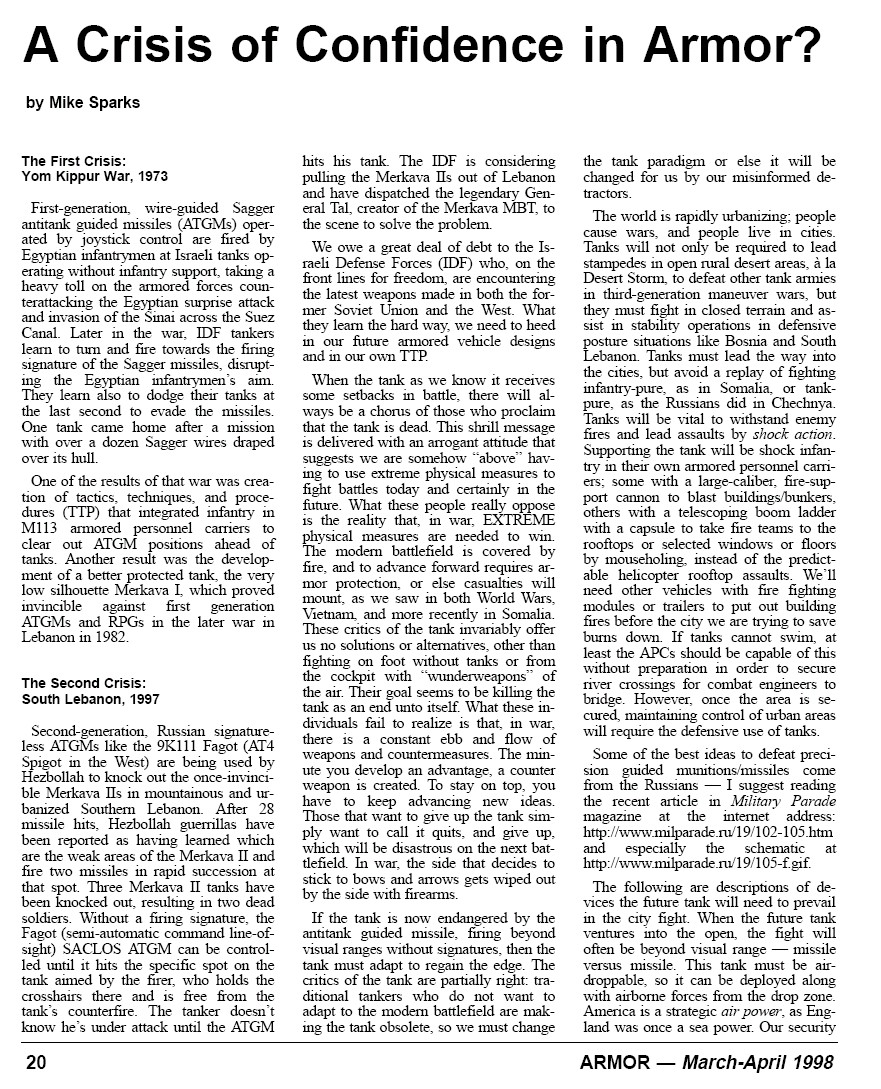
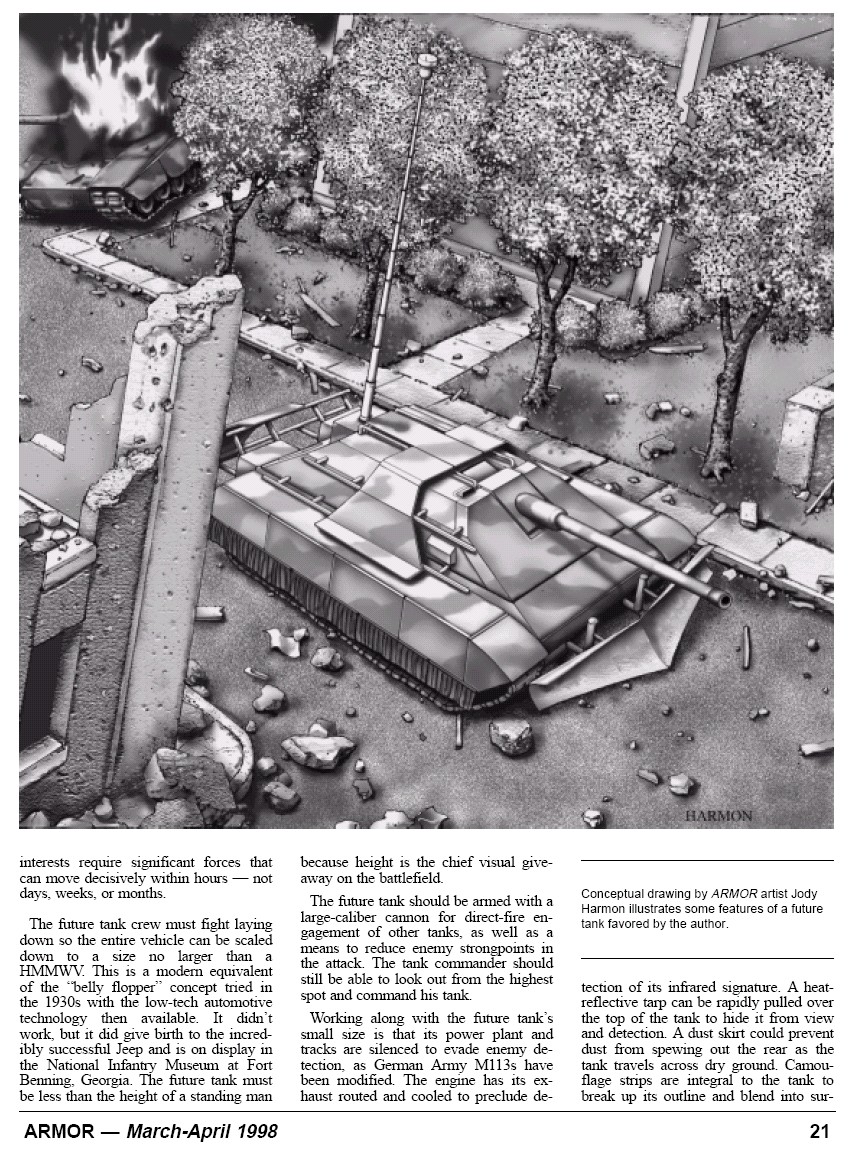
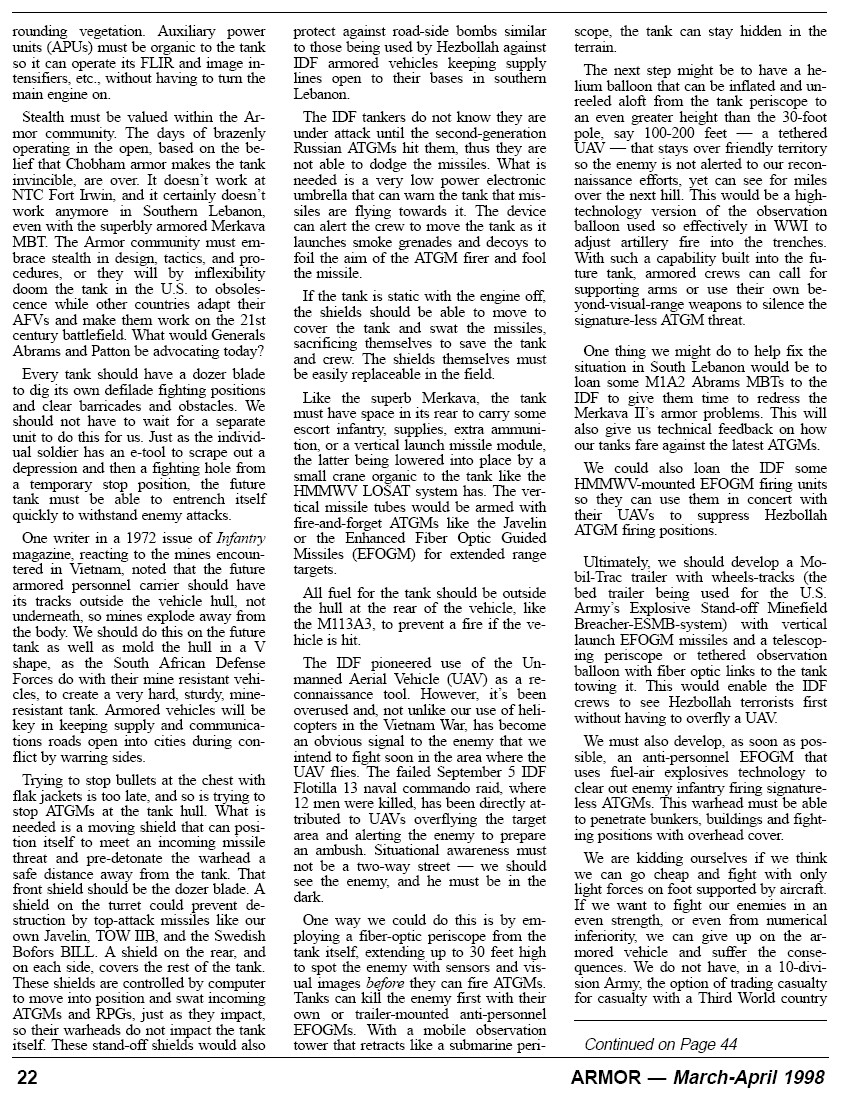
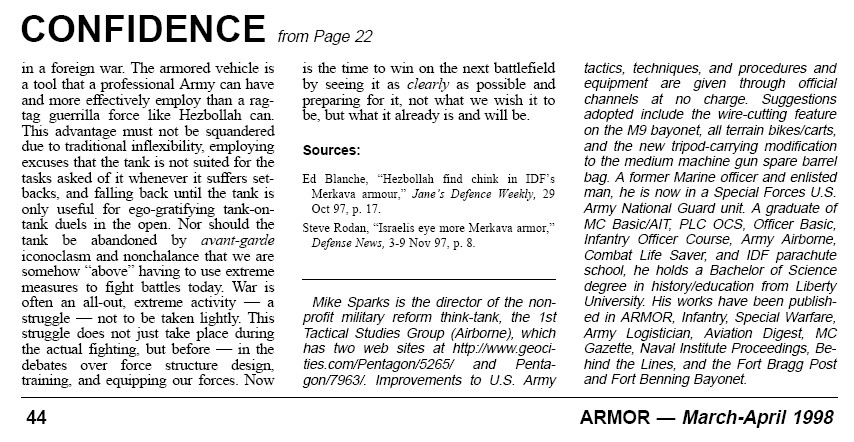
German "killer bees" Air-Mech Cavalry TODAY: High-Performance Tankettes Like General Gavin's Ontos
German Army Lieutenant Colonel Wolfgang Mettler's "Airborne Anti-Tank Battalion", U.S. Army Infantry magazine, January-February 1995, pages 24-29
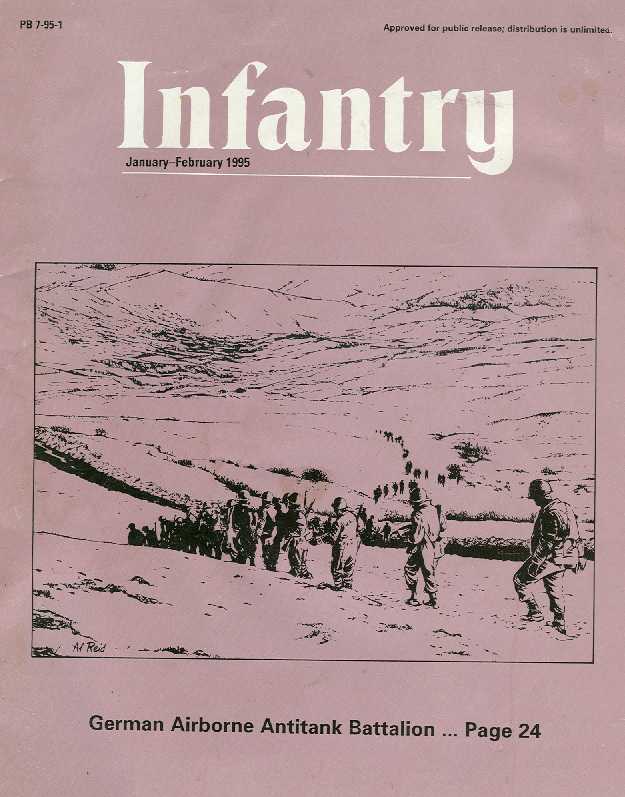
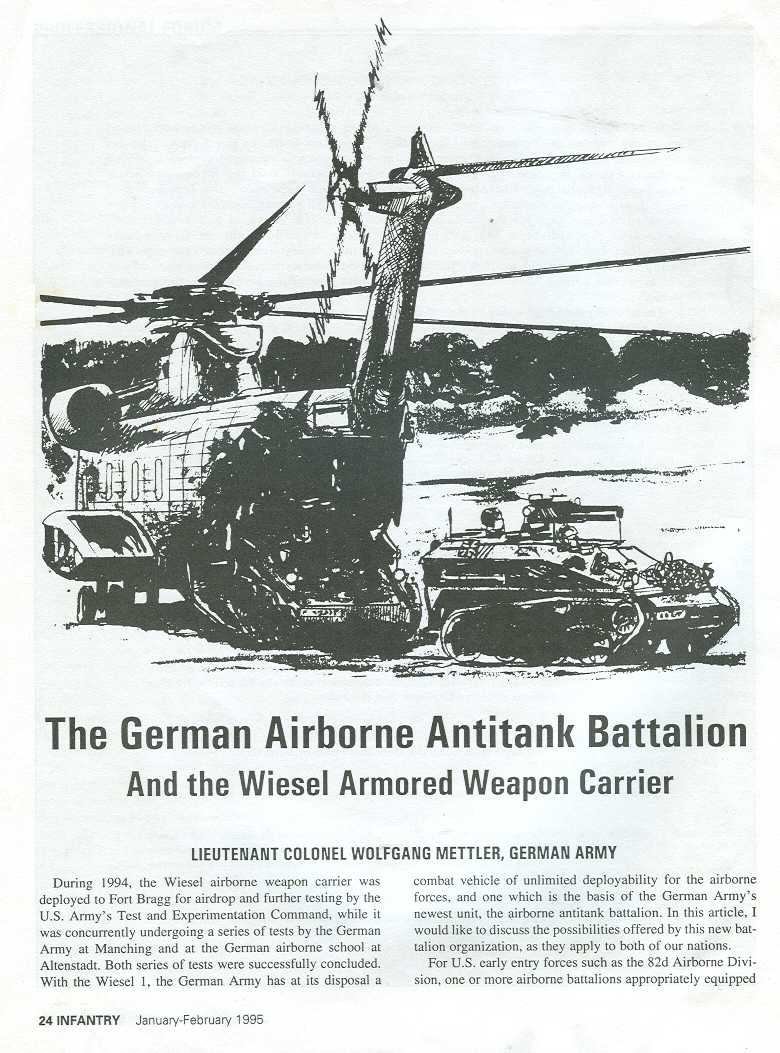
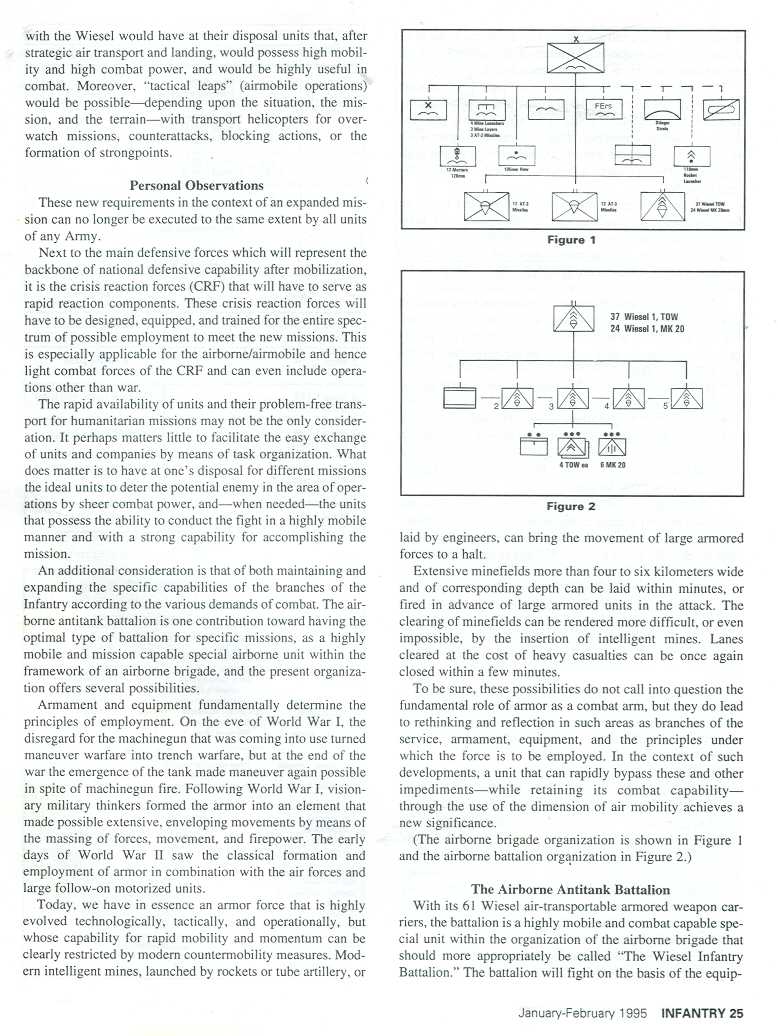
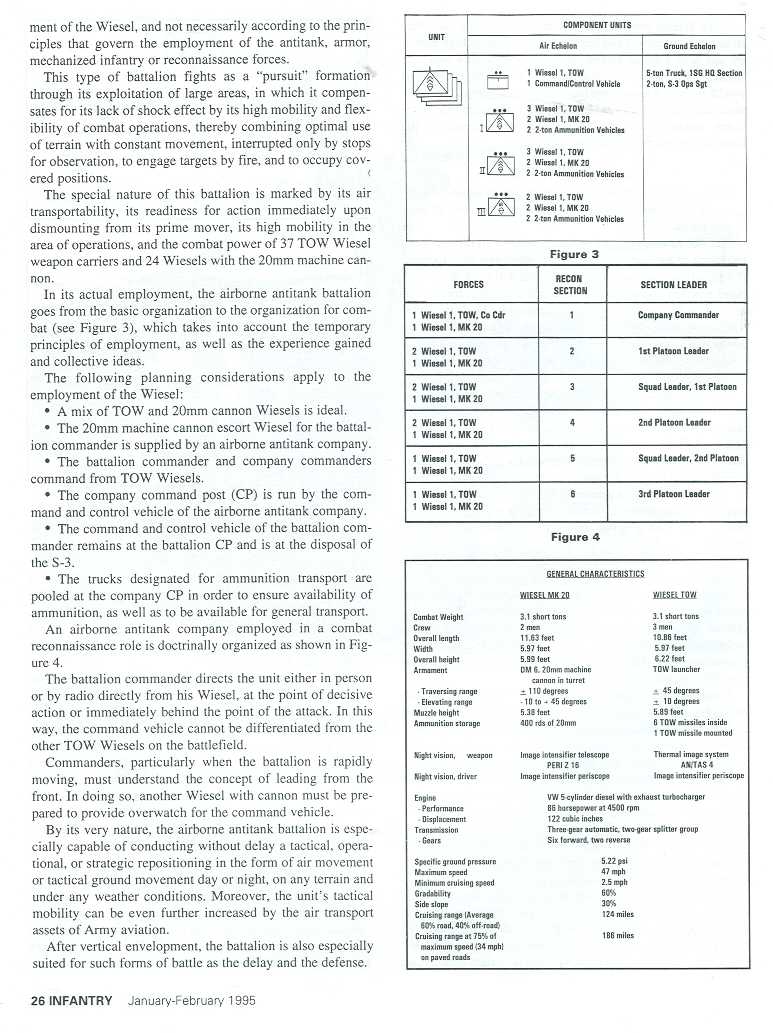
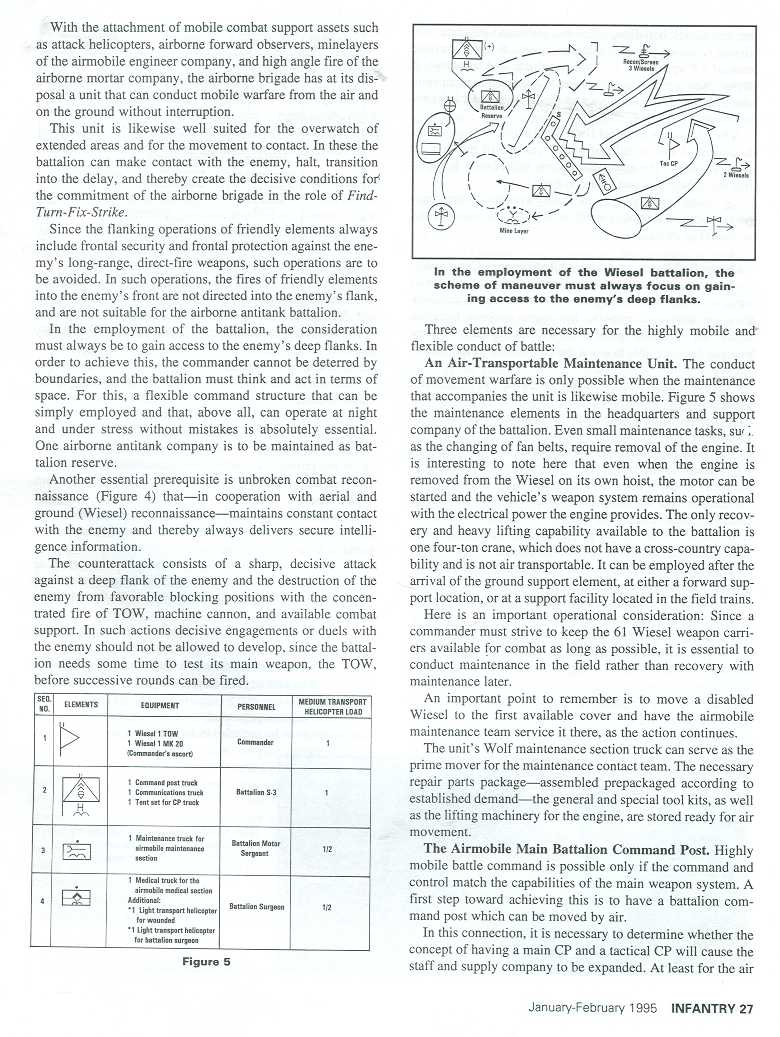
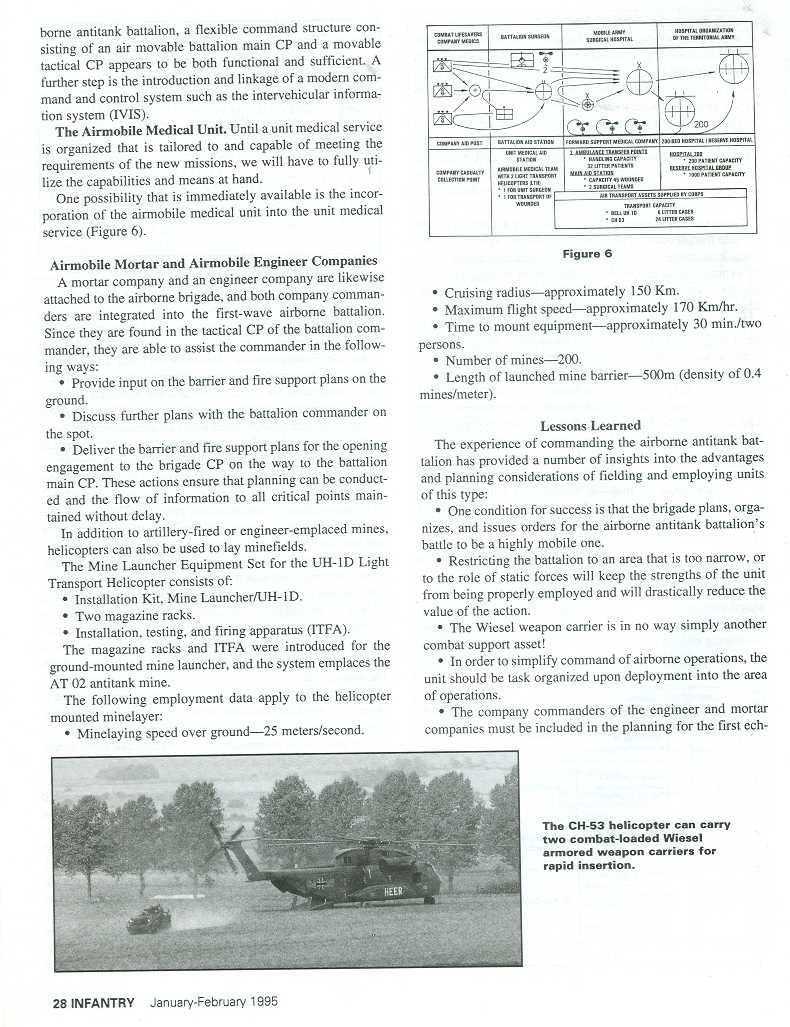
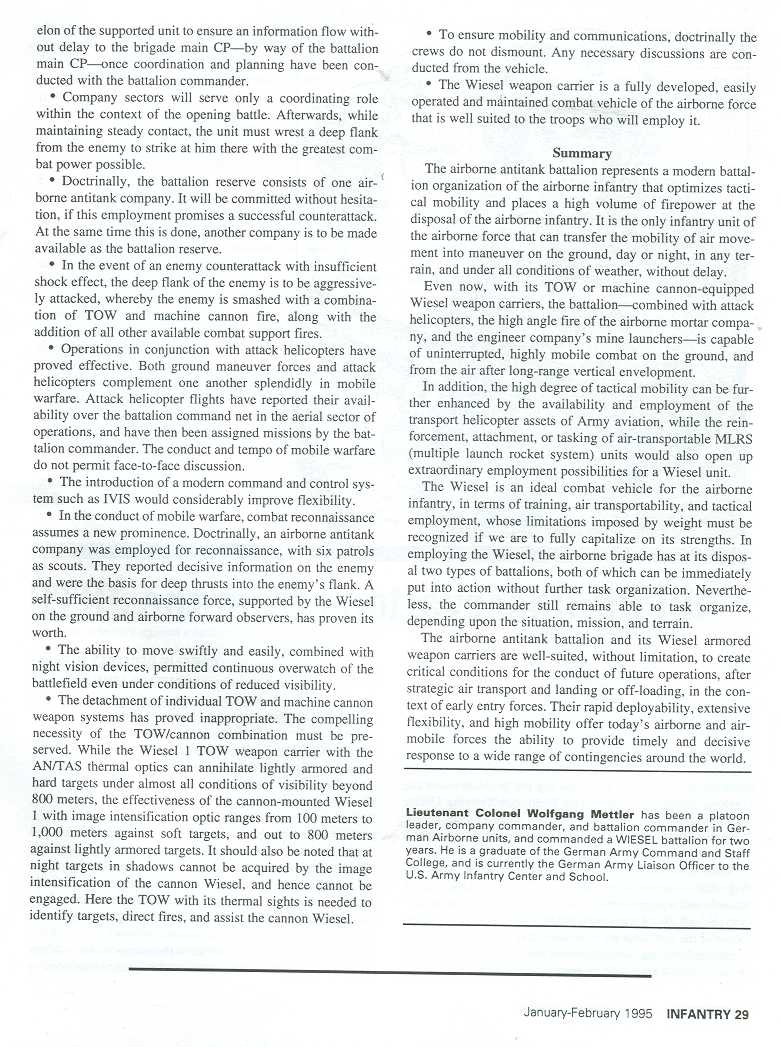
We can achieve the same "killer bees" effects by reducing the size of our own M113s into "Mini-Gavins"
Non-Linear Battlefields Require FULL armor protection: tracks are 28% more capable of armor protection--and can go cross-country to avoid ambushes in the first place!
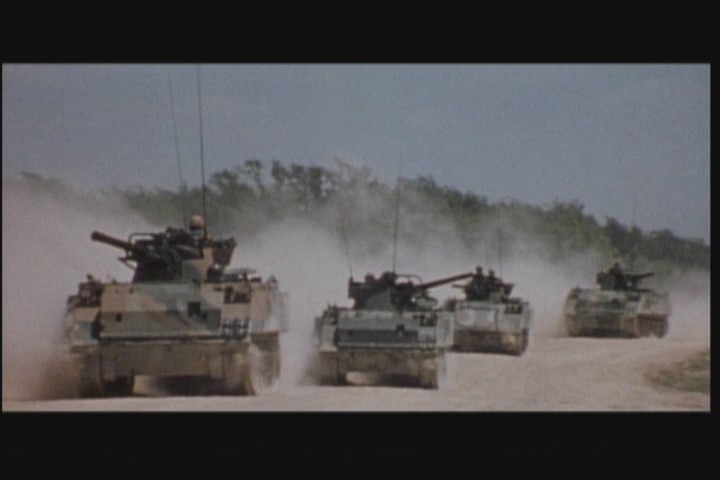
General James M. Gavin as Army Chief of Research & Development created the Airborne Armored Multi-Purpose Vehicle Family (AAM-PVF), the amazing M113 in the 1950s for maximum mobility over nuclear devastated, non-linear battlefields.
The official history of the U.S. Army for that time period says the following:
www.army.mil/cmh-pg/books/amh/AMH-26.htm
The seven divisions stationed in the United States constituted the strategic reserve. Four of these-two airborne and two infantry-were designated in 1957 the Strategic Army Corps (STRAC) and were maintained in a high state of readiness for quick deployment in event of an emergency. The other three were earmarked as STRAC reinforcements and as a training base for expansion of Army forces should the crisis become prolonged or develop into a full-scale war.With the emphasis on mobility, even the larger and heavier weapons and equipment were designed to be air-transportable.
A program to produce ground and air vehicles with the necessary battlefield mobility led to the development of armored personnel carriers, such as the M113 with aluminum armor, that could move troops rapidly to the scene of operations while providing greater protection for the individual Soldier. Since
585
highways and bridges might be damaged or destroyed, dual-capability amphibious vehicles that could travel on rough terrain and swim across rivers and swamps freed the fighting units from total dependence upon roads.
What today's planners don't realize is that what was required for a nuclear battlefield is required today with PGMs in a Surveillance Strike System (SSC) that can be as equally devastating but in a more localized way: units ON TRACKS not wheels. We need GREATER PHYSICAL mobility, firepower, protection and livability features not less regardless if tied in to a "Mother May, I?" computer network to alleviate the anxieties of senior officials.
Thus, the M113's purpose was armored, amphibious cross country mobility for LIGHT, AIRBORNE units. In 1960, America's Airborne should have been the first ones to have "air-mech" capabilities organic but the ill-conceived ROAD reorganization plan reverted back to the paratroopers foot slogging and their armored tracks went to heavy units instead. Mass-produced and inexpensive, there was and still is enough M113s to supply BOTH light and heavy units. The old saying if you don't get it right, you spend the rest of your time trying to get it right comes to mind.
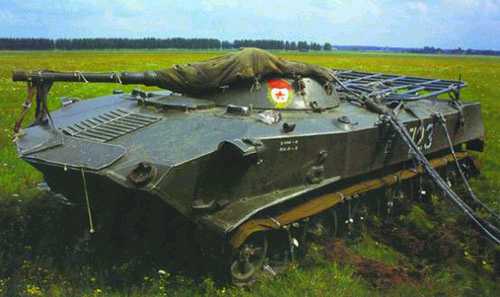
BMD-1 after parachute airdrop; note kneeling landing gear
BMD-2
BMD-3
Compare the U.S. Army in 2007 to the Russian Army of today...8 years after we revolutionized ground maneuver tactics with the M113 but sat on its potential, they created their own BMD and fielded one to every paratroop squad. They are already on their 4th Generation BMD and we are still trying to get "GEN I" M113 Gavins IN light units. What a disgrace to the memory of our great Airborne leaders, Gavin, Lee, Ridgway, Yarborough, Hackworth, Moore that we are not having American Light and especially Airborne forces---live up to their full potential.
U.S. Army TALKING about Light Units with M113 Gavin tracked armor (still after 4 decades of using them on & off)
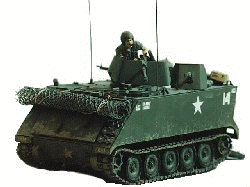
U.S. Airborne/Light units would be lucky just to have M113 Gavins with machine guns, much less autocannon...this wasn't always the case...the 82nd Airborne actually had M551 Sheridans and M113 Gavin light tanks in the 3rd Battalion, 73rd Armor until 1997.
VIDEO: How the U.S. Army Airborne should Power Project by Parachute Airdrop
www.combatreform.org/USARMYAIRBORNEpowerprojection.wmv
www.youtube.com/watch?v=BcSwXW49J_I
www.youtube.com/watch?v=50cpPAVoxJQ
www.youtube.com/watch?v=kEgBoROaD2g
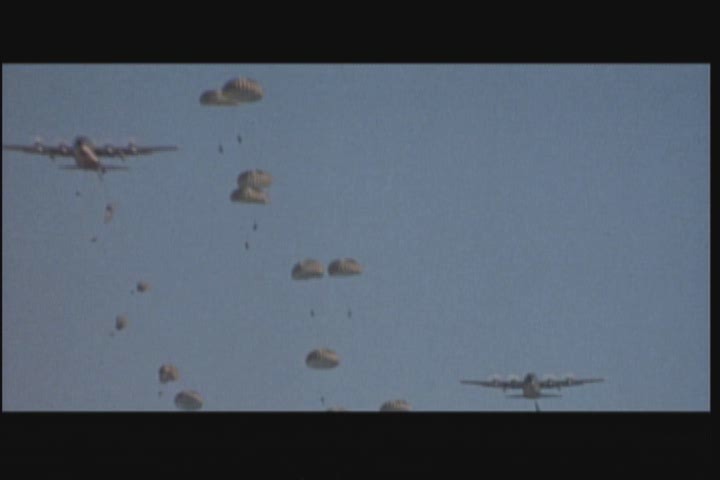
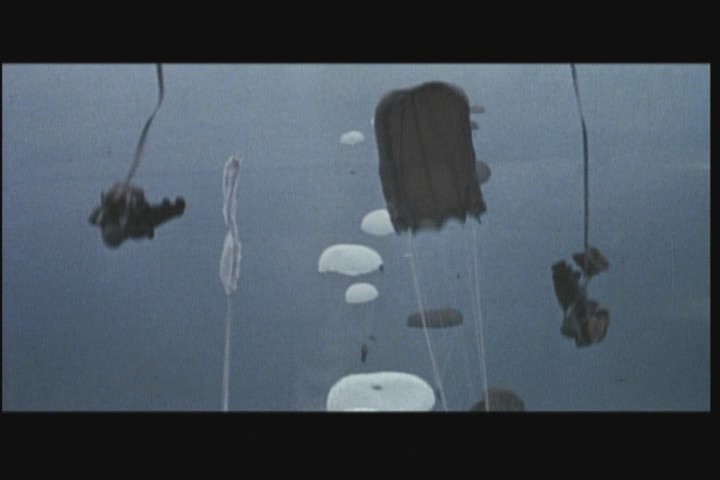
LAPES = Low Altitude Parachute Extraction from 5-10 feet
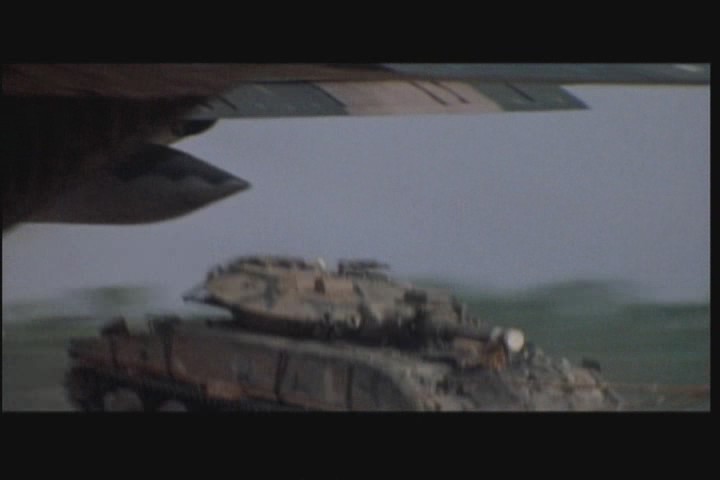
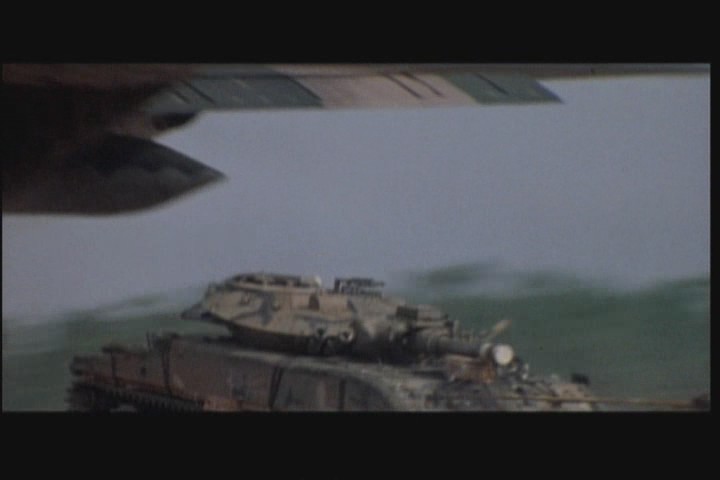
LVAD = Low Velocity Air Drop from 600-1200 feet
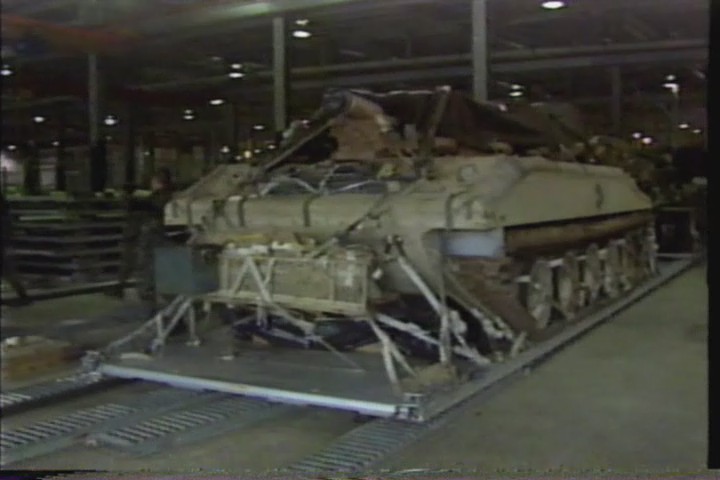
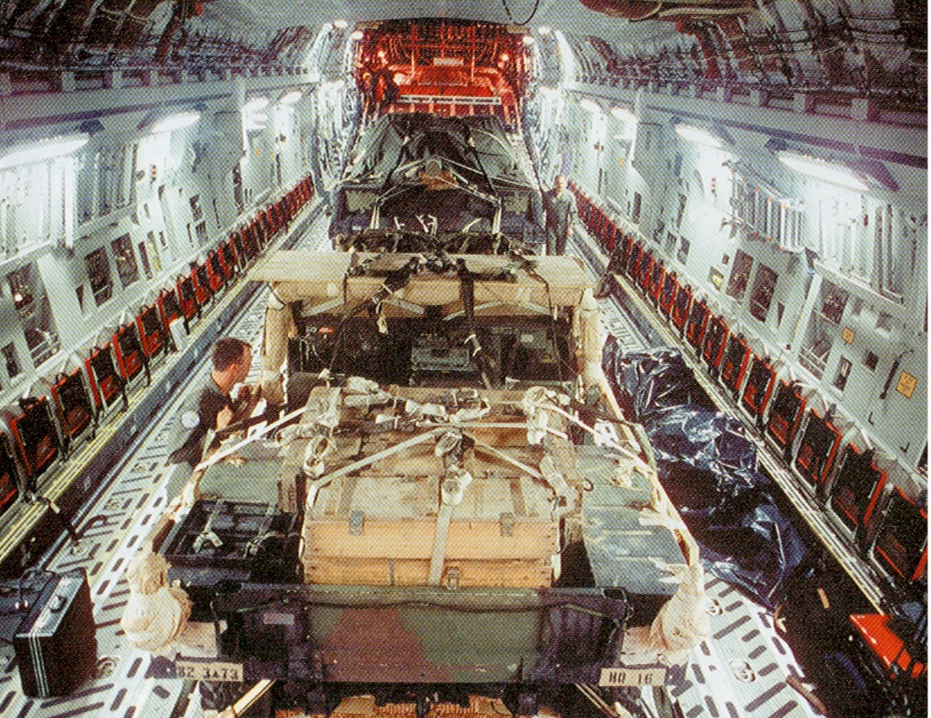
Picture above of C-17 interior with a M551 Sheridan light tank and HMMWV truck rigged for low velocity airdrop shows 54 sidewall seats and walkways to the side jump doors are still available; yet Airborne still inefficiently loads C-17s with either all people or all equipment, then offers the lame excuse that "they do not have the airlift" to bring tracked armored vehicles to the fight below. How convenient. Current "can't-do" U.S. Airborne is a disgrace to the CAN-DO spirit of all the Paratroopers who have gone before us and created the American Airborne in the first place.
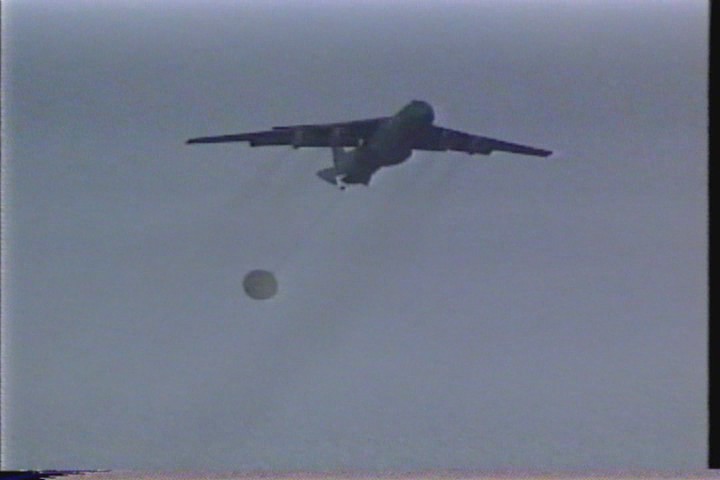
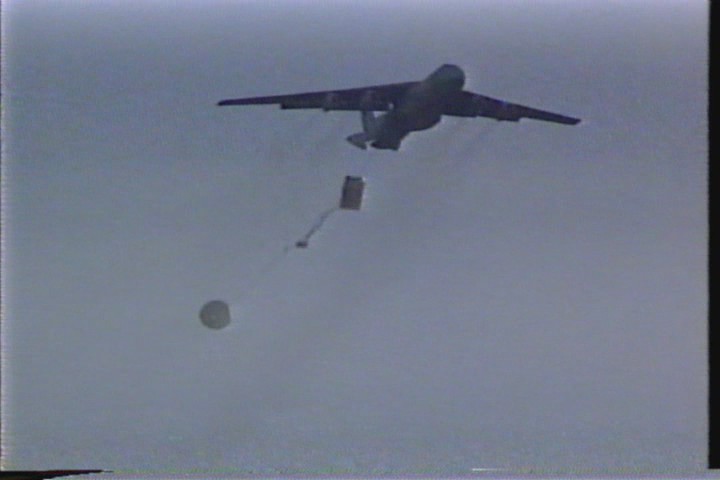
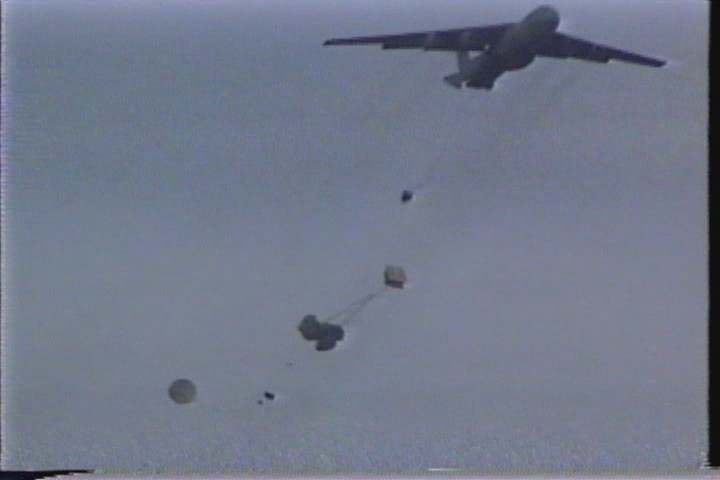
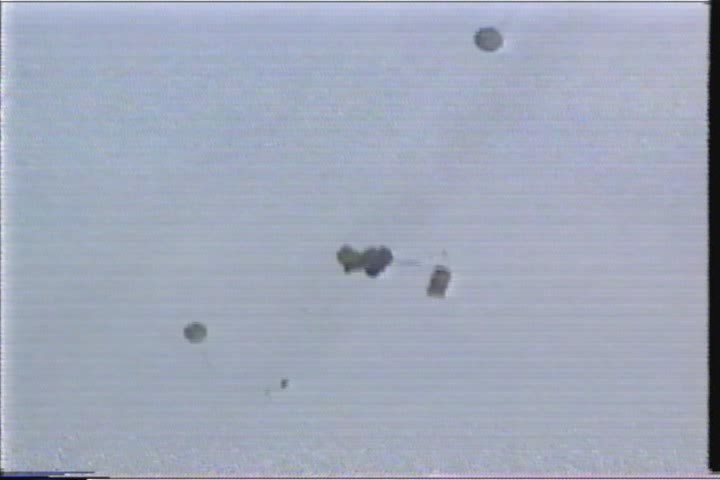
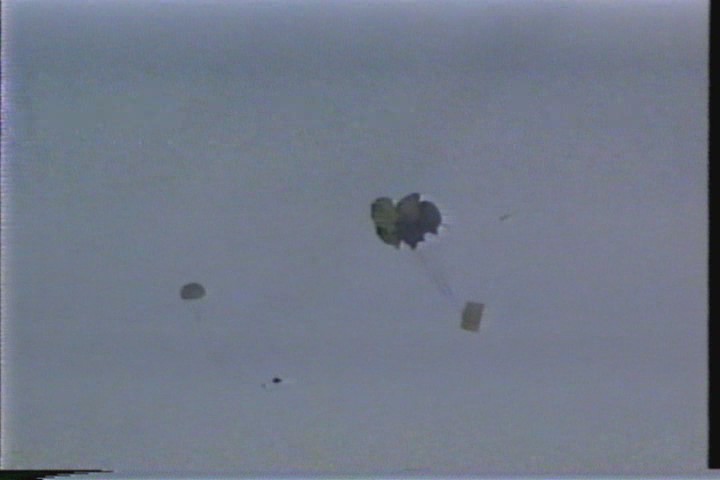
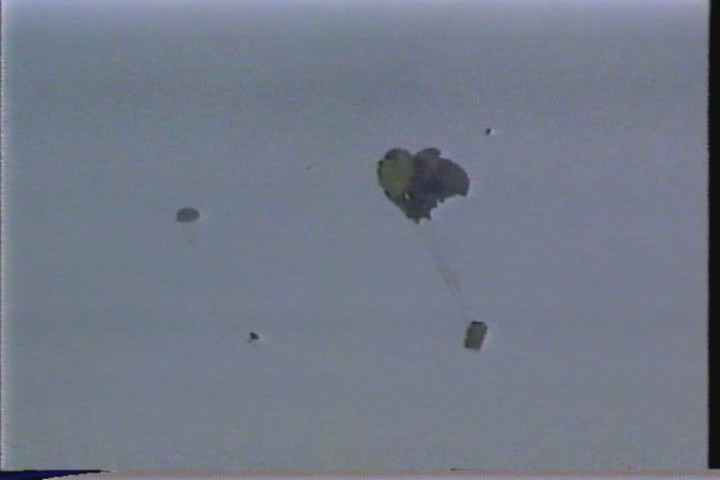
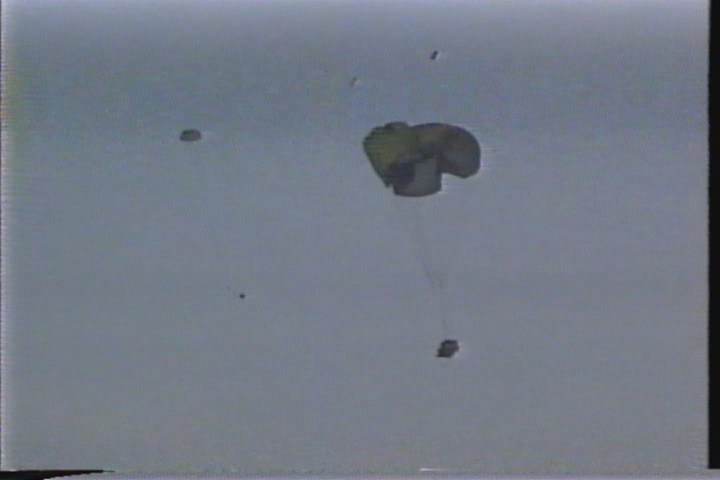
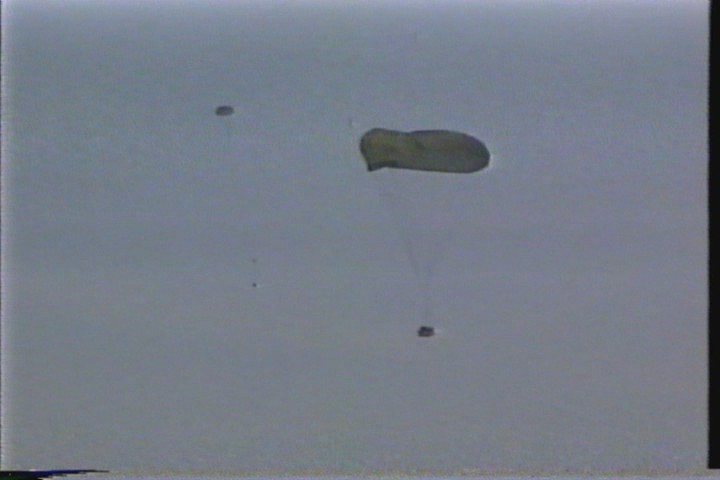
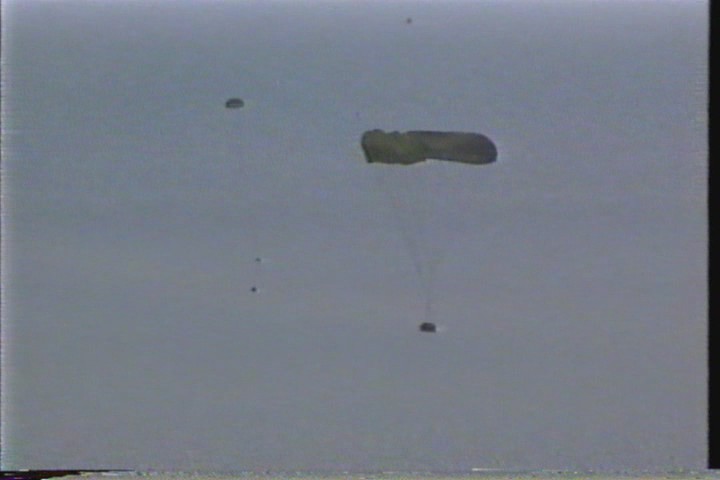
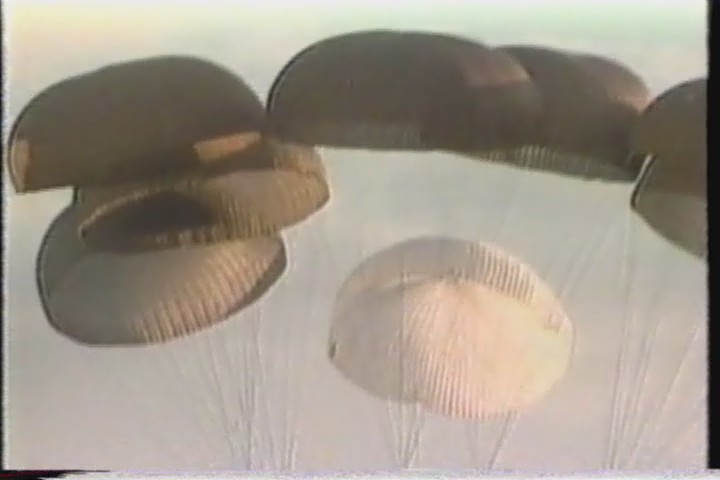
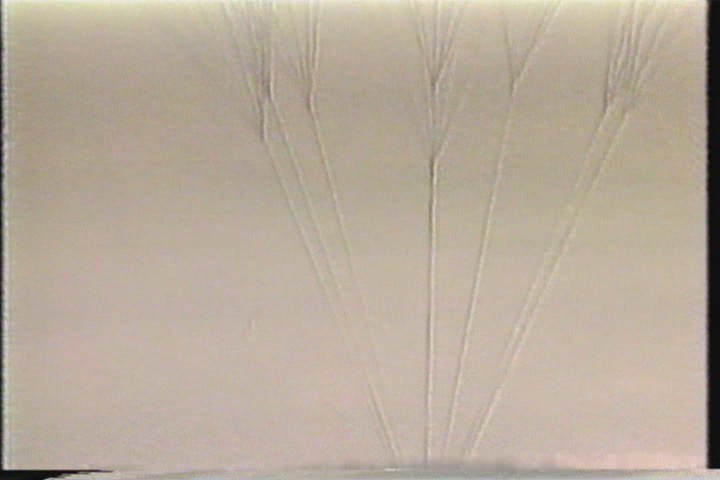
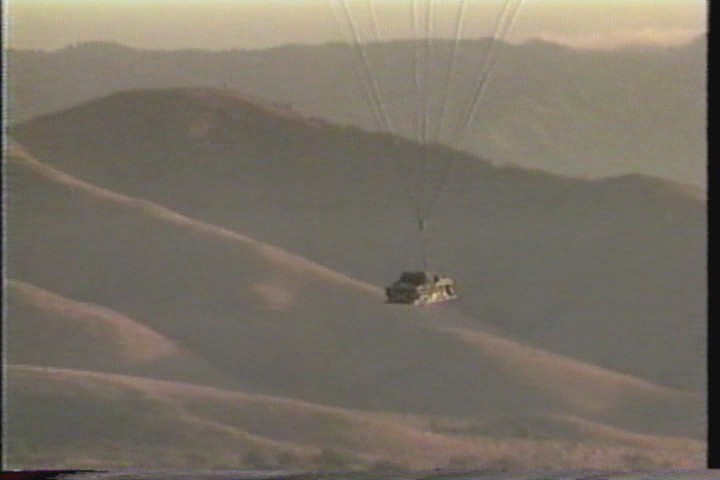
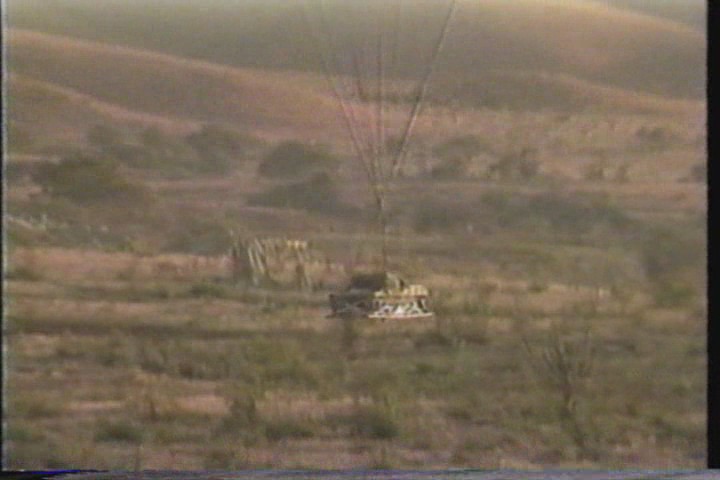
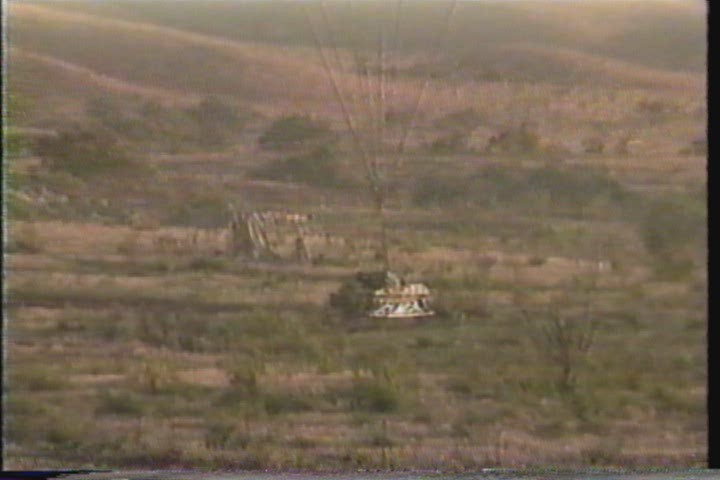
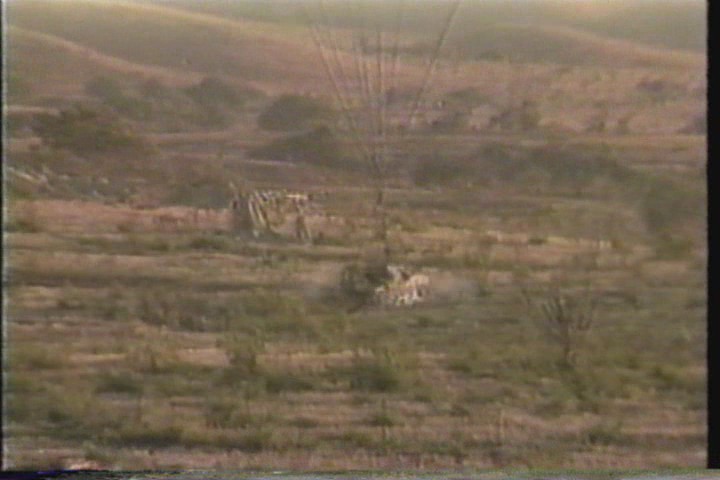
Here's the 82nd Airborne's post OIF AAR (from the CALL Website):
MANEUVER
--------------------------------------------------------------------------
LESSON LEARNED 1: Lack of lethality/firepower by Airborne Infantry in Urban Terrain.
DISCUSSION: Recent combat operations in As Samawah and Ad Diwaniyah during Operation IRAQI FREEDOM highlighted the need for increased lethality and firepower in the current airborne infantry brigade structure, while operating in urban terrain. The DA decision to eliminate the divisional armor battalion, in favor of employing the Immediate Ready Company concept (IRC) [EDITOR: which can only AIRLAND after an airfield is seized and cannot parachute drop with the 82nd Airborne Paratroops], while waiting for the Army to identify and field an air-deliverable armored gun system (AGS) left the airborne brigade woefully in need of increased lethality and firepower. Frequently during these recent operations, airborne forces would move in advance of heavy forces (TF 1-41 IN) to isolate an objective area while the heavy force postured for action at the decisive point in the fight. Heavy forces delivered the firepower that rapidly and decisively terminated the conflict. An airborne infantry brigade, with an organic AGS capability would enable it to quickly and decisively defeat an enemy in an urban environment without having to depend on heavy force augmentation. [EDITOR: if the closed terrain cannot facilitate medium to heavy tanks, these forces are off doing something else, they can't get there at all in a timely manner etc.]
RECOMMENDATION: Modify the Airborne Division MTOE to include a battalion of air deliverable armored gun systems (AGS). The armored gun system must meet the requirements of being air transportable by C130 and air droppable by G-11 cargo parachute, must be capable of providing accurate and lethal fires, and must be survivable in an urban environment against small arms and RPG type weapons.
www.youtube.com/watch?v=x-ppX5wY5pU&mode=related&search=
DISCUSSION: Recent light/heavy operations in Central Iraq during Operation IRAQI FREEDOM highlighted the lack of mobility of the airborne infantry brigade operating in unrestricted desert terrain. Frequently, airborne forces would LD well in advance of the heavy forces to isolate an objective area while the heavy force postured for action at the decisive point in the fight. The heavy forces provided the firepower to terminate the conflict rapidly and decisively, but it would constantly outpace the airborne infantry forces forward in subsequent tactical sets.
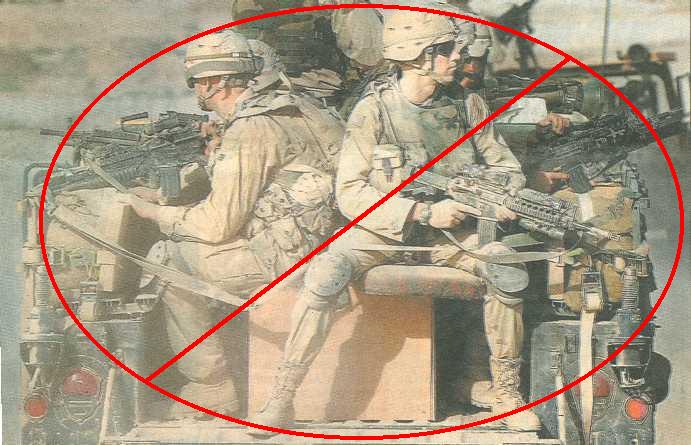
To maintain tactical pace with the heavy forces, both organic and task organized truck assets had to be reallocated from the FSB and DIV MSB, as well as, inorganic truck assets from 1st COSCOM and PREPO stocks to support mobility requirements for the current and future fight. The reallocation of organic transportation assets also complicated logistical resupply and forward positioning of BDE and higher command posts. [EDITOR: wheeled trucks cannot go forward in combat in the face of enemy fire]
The addition of four mounted platforms per platoon would greatly enhance the airborne infantry platoon's mobility. Four per rifle squad and one per weapons squad (two of which are outfitted for PL and PSG C2 nodes) with .50 caliber machine guns and/or MK-19s would substantially enhance the rifle platoon's mobility and firepower, and allow it to be much more effective while operating independently or in conjunction with heavy forces. These platforms would deploy as part of the Charlie Echelon and employed after seizure of an airfield and establishment of a lodgment. [EDITOR: violently disagree; "C" echelon is too late. Time for American Airborne to start maneuvering immediately after landing on the drop zone] Additionally, these mobile platforms would greatly relieve the strain on precious logistical assets required to move and sustain airborne infantry units.
RECOMMENDATION: Modify the MTOE of the airborne infantry platoons to equip them with organic assets (four each 2 w/ .50 caliber MGs and 2 w/ MK-19s) that provide mobility, firepower, and ability to conduct non-standard CASEVAC.
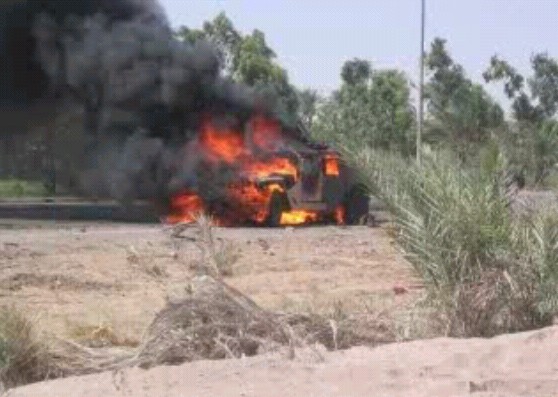
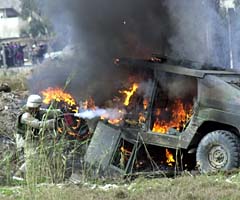
[EDITOR: M113 Gavins should be the mounted platforms since they are tracked and armored to keep the paratroops alive while moving forward with the M8 AGSes. Paratroops in wheeled Humvee trucks are just going to go up in flames and die from nearly any enemy fire as daily tragedies in Iraq prove. M113 Gavins should be in the "Delta" weapons company and be used as needed to give A, B, C mobility as needed. However, providing A, B, C M113 Gavins can also work, too but we better not hear of any whining from them that they have to spend half a day each week in the motor pool and its going to somehow make their penises shrivel up]
www.stormingmedia.us/46/4652/A465262.html
Light Infantry, Augmentation, and the M113A3 Armored Personnel Carrier: A Step in the Direction of Versatility
Authors: William K. Sutey; ARMY COMMAND AND GENERAL STAFF COLL FORT LEAVENWORTH KS SCHOOL OF ADVANCED MILITARY STUDIES
Abstract: This paper examines a proposal to create M113 Armored Personnel Carrier support units (vehicles, drivers, and service support) to provide protected tactical mobility augmentation for light infantry forces. Light infantry divisions are a crucial component of the Army's force structure to meet potential challenges across the spectrum of conflict. They lack, however, the tactical mobility assets to be of any utility beyond the lowest intensity conflicts in the most restrictive terrain. This limitation constrains the Army's versatility as a whole. This monograph first considers tactical mobility as an element of combat power, establishes an analytical framework for the analysis of the infantry mobility systems, and considers the heavily armed and mobile nature of potential world threats. Next, the light infantry concept is explored focusing on the intended purposes for which light infantry divisions were formed and an evaluation of their actual tactical mobility capabilities. Following this examination of today's light infantry, this paper looks at the Pentomic Era in the late 1950's in which M59 armored personnel carrier companies were consolidated at division level and sent vehicles as attachments to augment the tactical mobility of infantry units. Finally, this monograph conceptually outlines a proposal to use M113 APC's to augment deployed light forces and evaluates how this might enhance their utility. Although there are philosophical objections to, and practical problems with, augmenting light infantry with armored personnel carriers, this paper concludes that today's demands for maximizing the versatility of all forces merits reexamination of such a concept.
Russian Airborne FIELDING BMD-4 tracked armor with 100mm guns
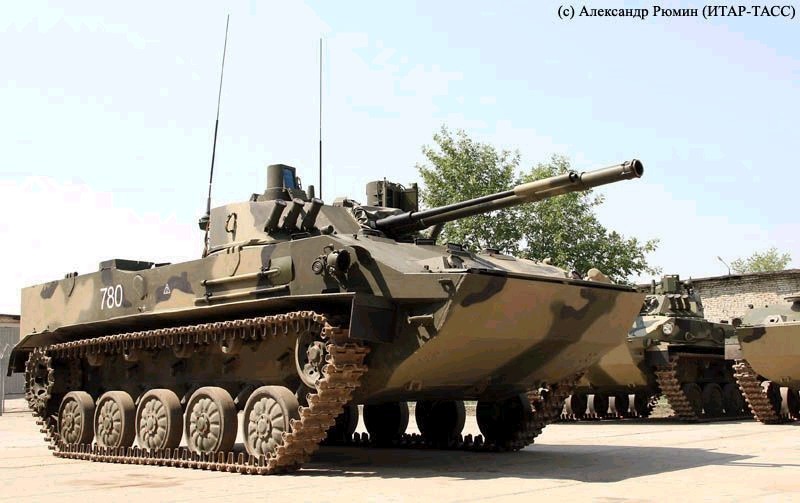
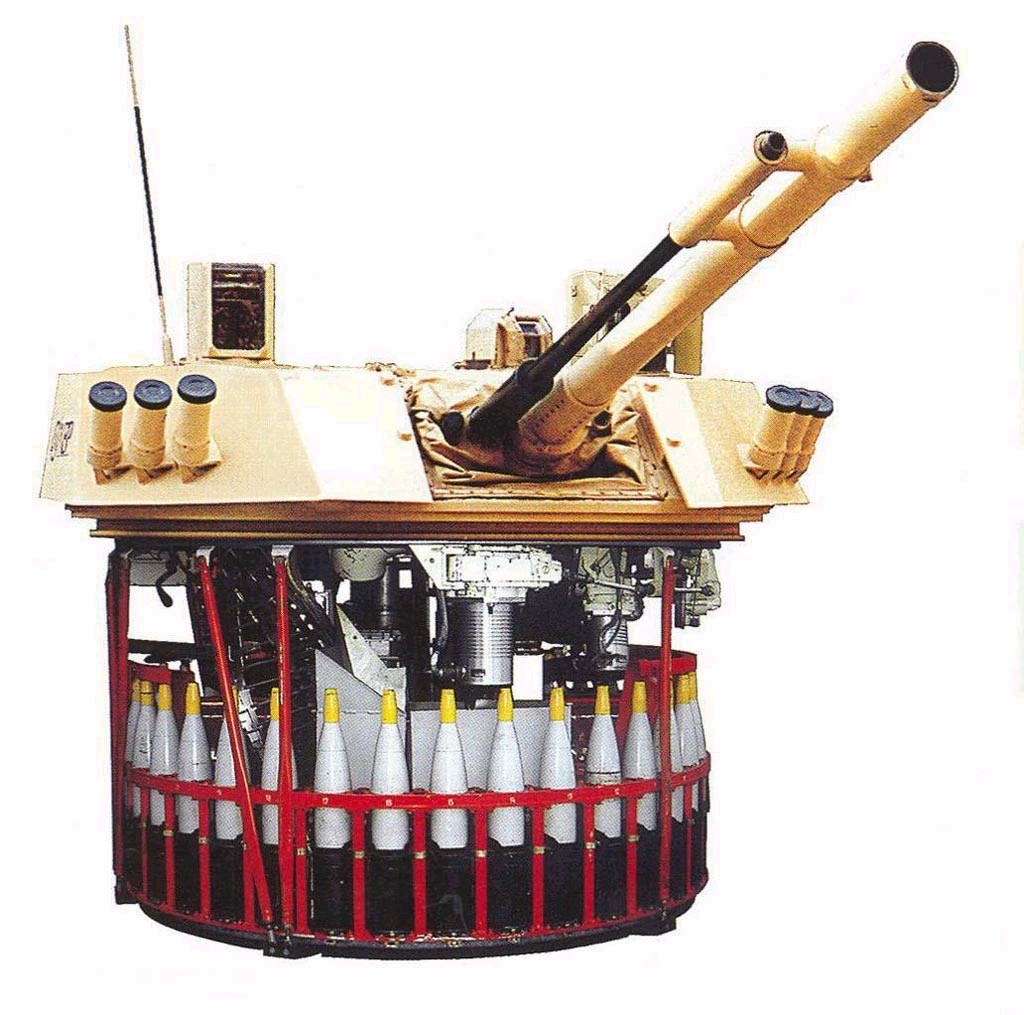
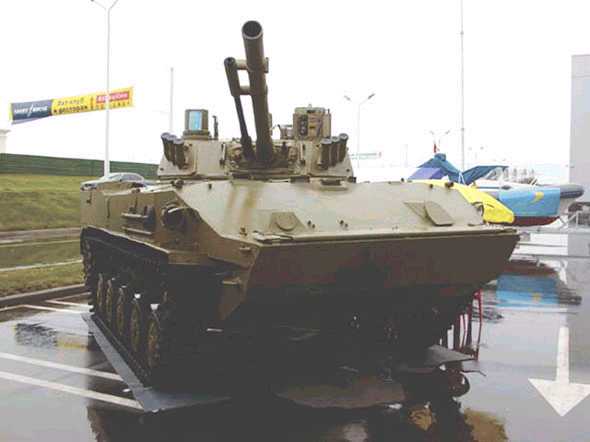
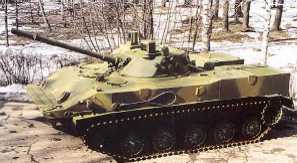
BMD-4 uses an improved versionm of the powerful 100mm main gun, 30mm autocannon, 7.62mm medium machine gun turret first fielded with the BMD-3M shown above
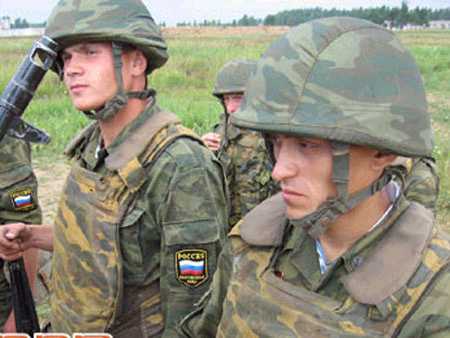
The Russian Paratroop crew of the BMD-4 ride INSIDE it during airdrop to save time de-rigging and getting it in action on the ground. Dismount paratroop infantry squad jumps out in FRONT of the IL-76 jet's engines SIMULTANEOUSLY with their mother BMD-4 exiting the rear ramp in order to land closer together. Their D-8 parachutes deploy only a stabilizer chute upon aircraft exit in order to jump in front of jet engine; U.S. old-fashioned static line and deployment bags leave a tangled mess streaming outside the plane as paratroopers exit.
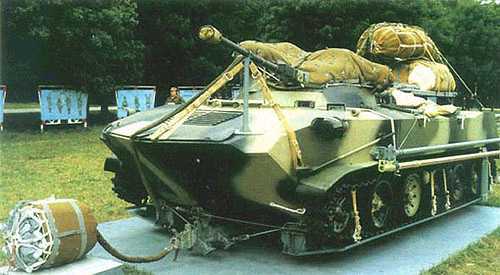
Note the minimalist approach to getting the BMD-4 to slide out the floor of cargo planes; runners under the tracks conserves weight and payload of the plane compared to the U.S. Type V airdrop platforms that each take up about 2, 000 pounds of payload and are a pain to recover on the drop zone for re-use.
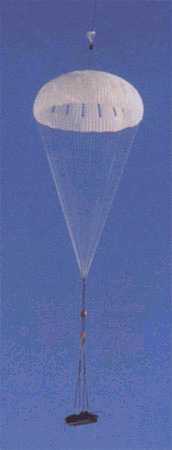
The BMD-4 under canopy
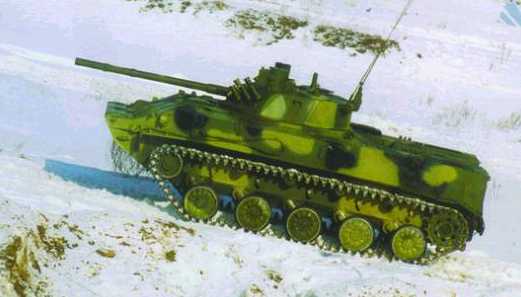
The BMD-4 has low ground pressure cross-country mobility like the M113 Gavin first pioneered
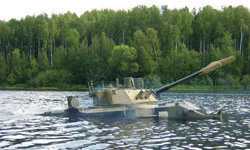
The BMD-4 has waterjets to swim in the ocean like the M113 "Amphigavin" with the ARIS GATOR kit
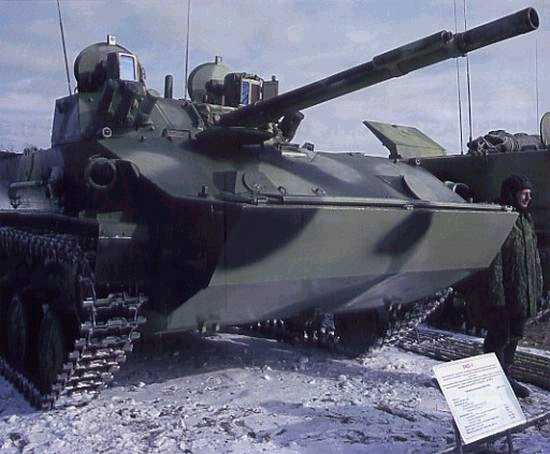
The BMD-4 has stabilized optics and gun mounts to shoot-on-the-move; a capability our M113 Gavins could have if they were OWNED BY LIGHT/AIRBORNE/AIR ASSAULT UNITS and improved on by ownership; ad hoc temporary load of M113s to units will not result in their full potential being achieved...and could result in the enemy killing a lot of Americans in battle because we chose to be inferior.
http://en.rian.ru/russia/20060616/49637256.html
New combat vehicles on way to Russian airborne units
19:24 | 16/ 06/ 2006
MOSCOW, June 16 (RIA Novosti) - Russia's Airborne Forces will receive the first batch of a new armored airborne combat vehicle on June 21, an army spokesman said Friday.
The BMD-4 airborne combat vehicle is amphibious, light and well armed. Like its predecessor, BMD-3, it has a hull made of special alloys and a turret, but features many modifications. In addition, it is equipped with a 100-mm gun.
"The start of deliveries of the BMD-4 marks a new era in the development of the Airborne Forces and will significantly raise the combat strength of Russia's most mobile units," Alexander Cherednik said.
The vehicle will be shown off during an exercise on June 26 that senior officers are expected to attend.
Legendary Tanker Ralph Zumbro asks the question:
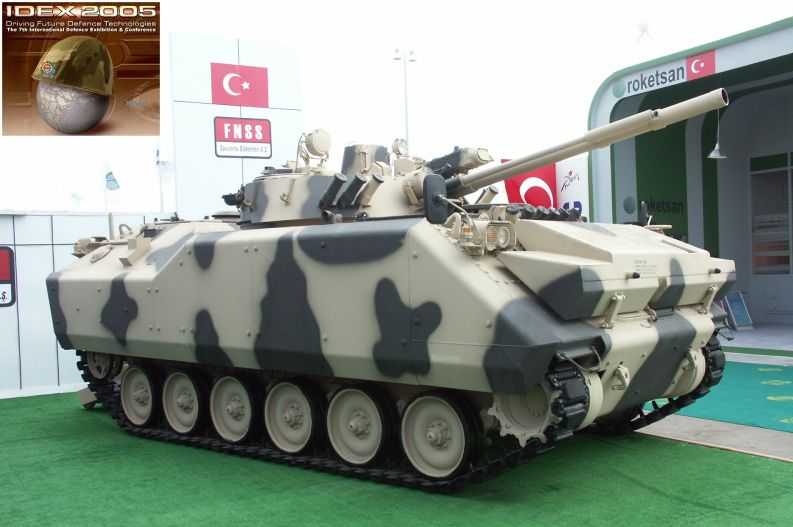
Nurol of Turkey has a M113-based AIFV with a BMD-3 type turret
"Gents;
That turret sounds like a development of the BMP-3 turret which at lease one ex Russian/Soviet country has adapted to the M-113. Maybe we ought to just BUY them and adapt them to our vehicle????"
Ralph
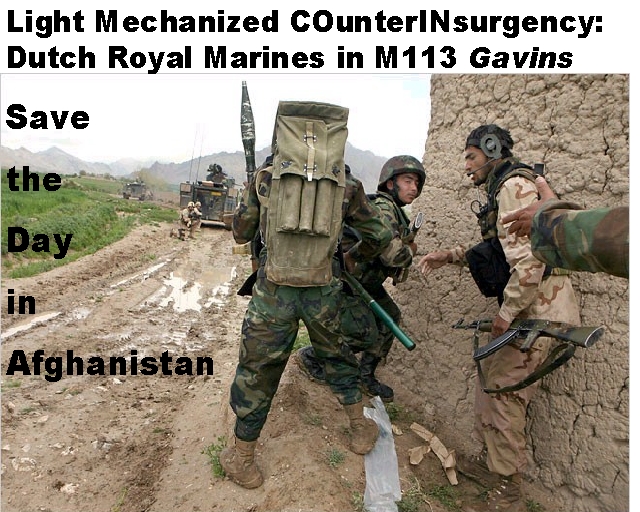
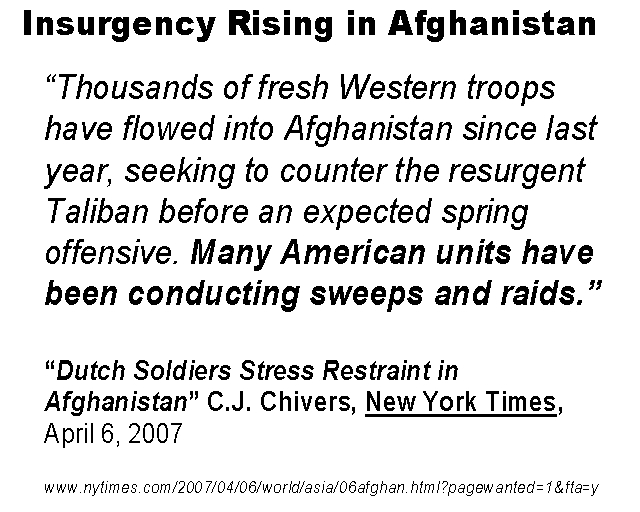
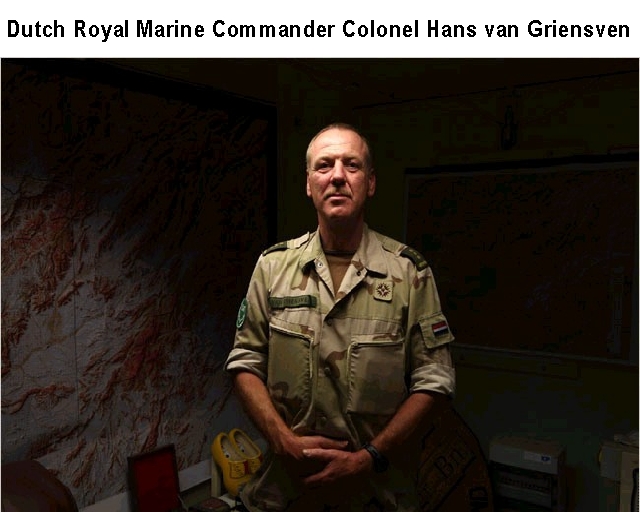
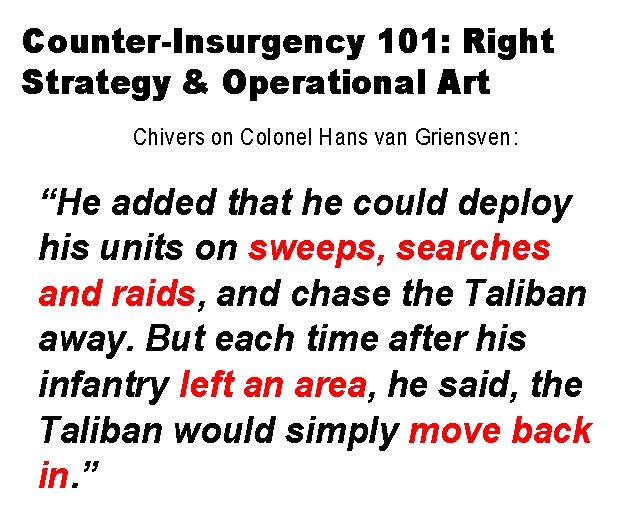
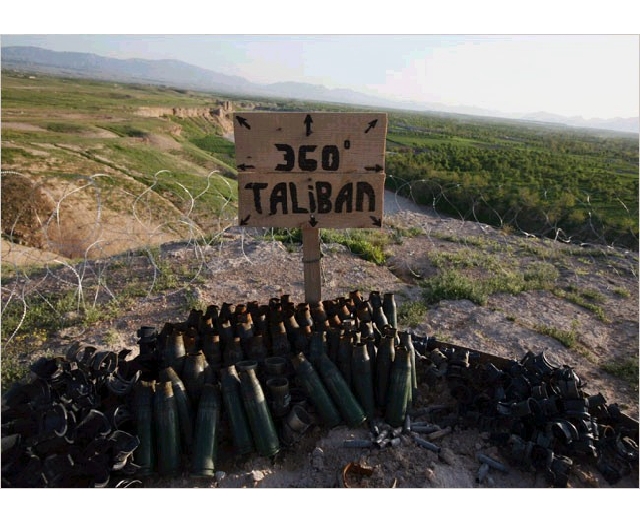
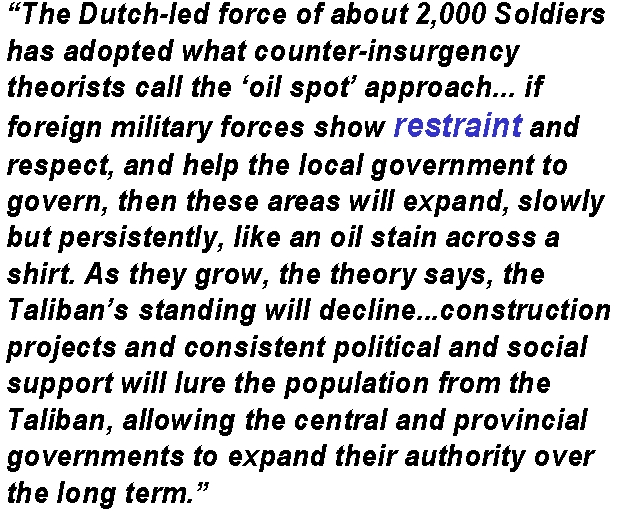
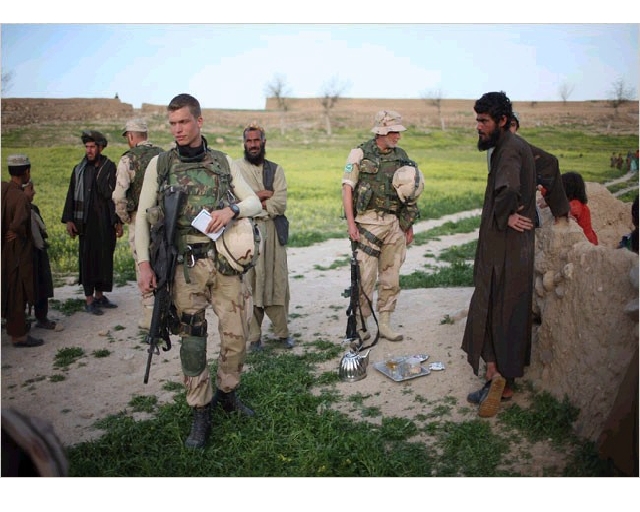
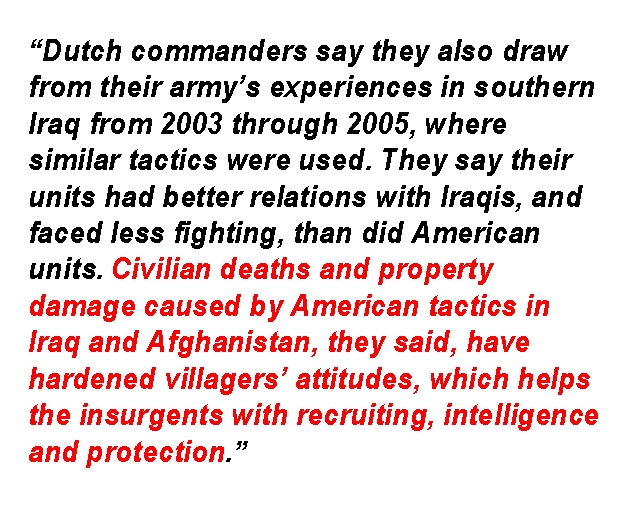
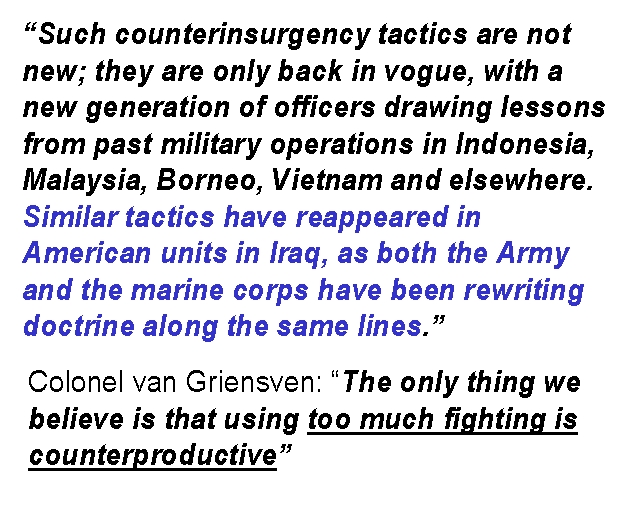
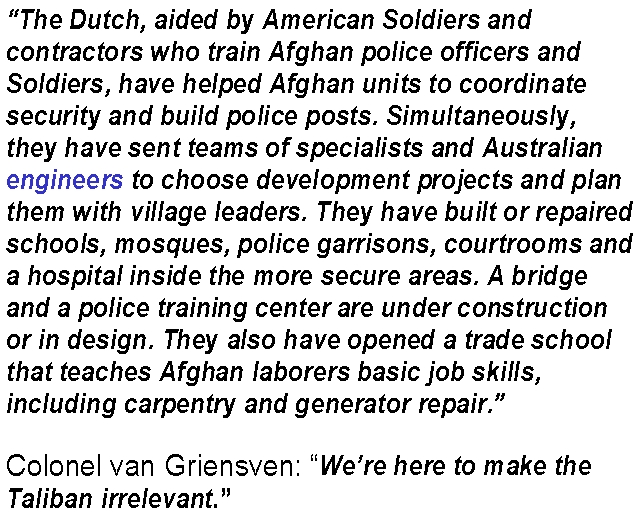
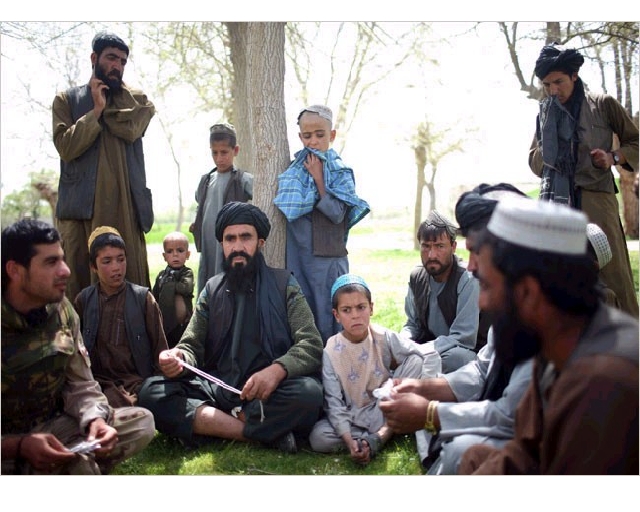
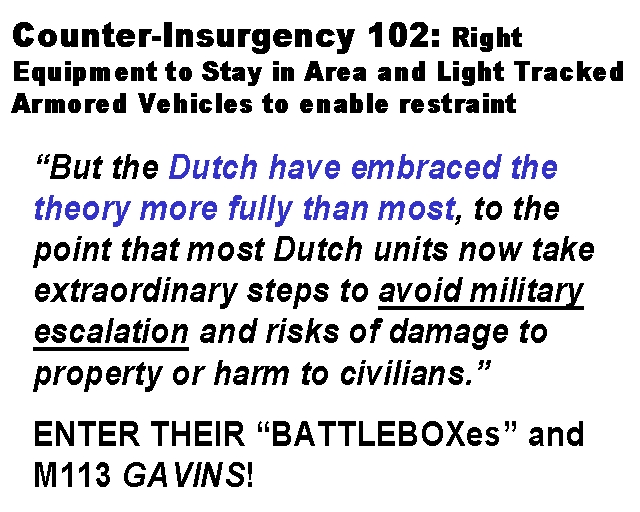
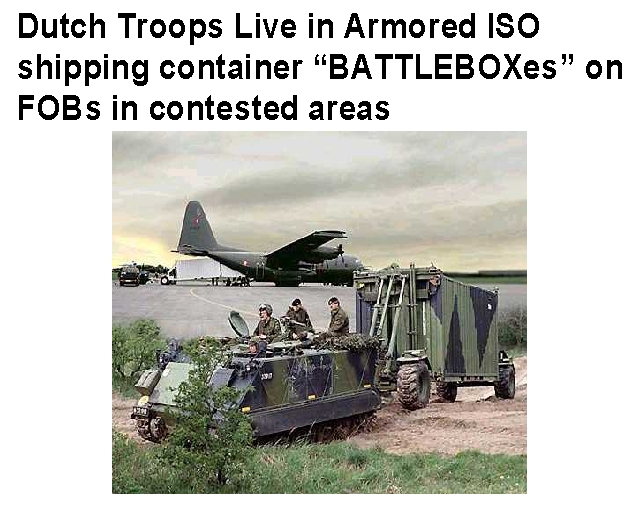
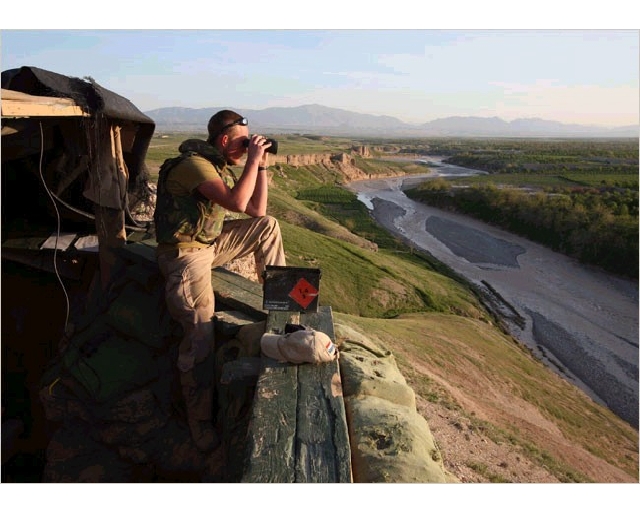
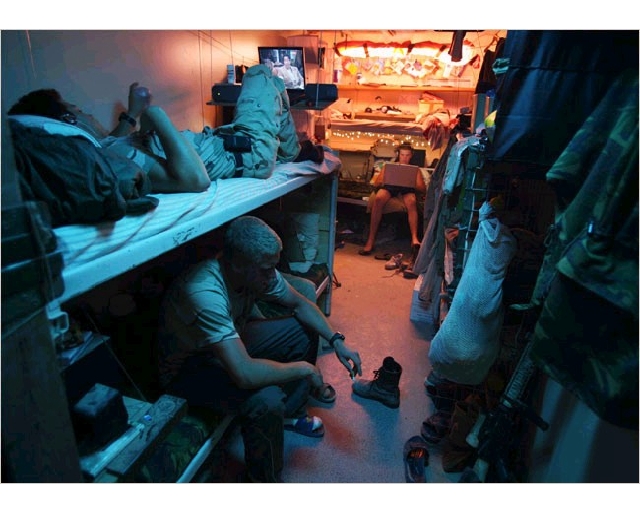
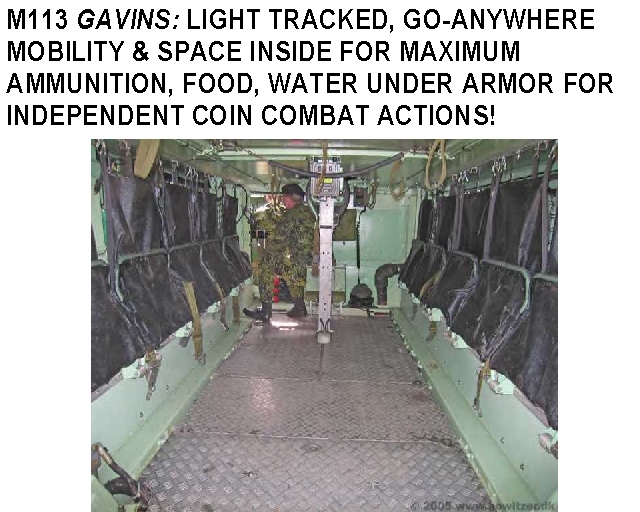
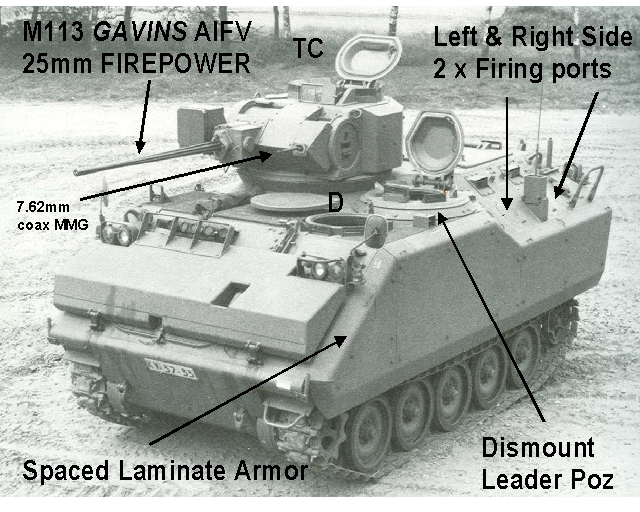
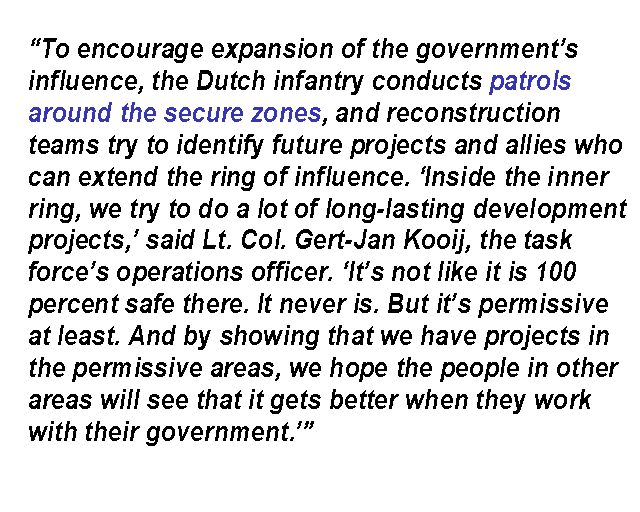
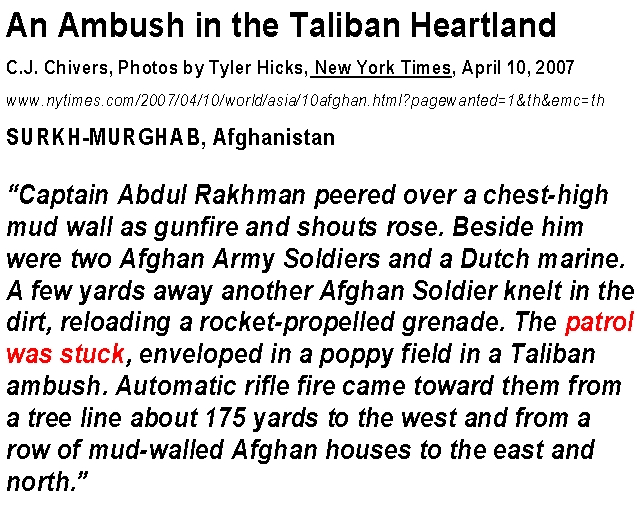
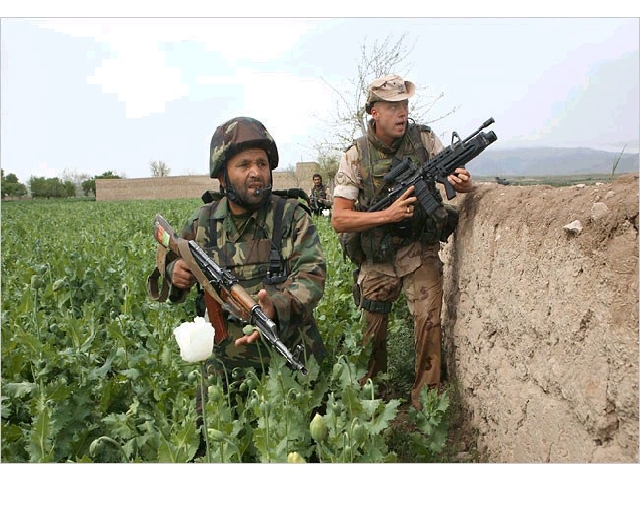
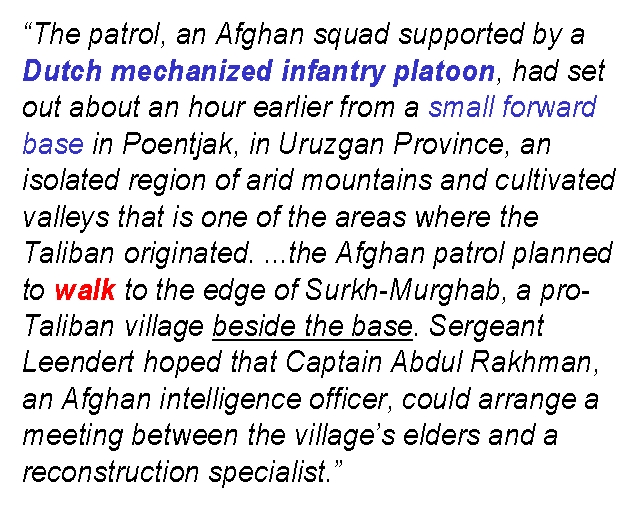
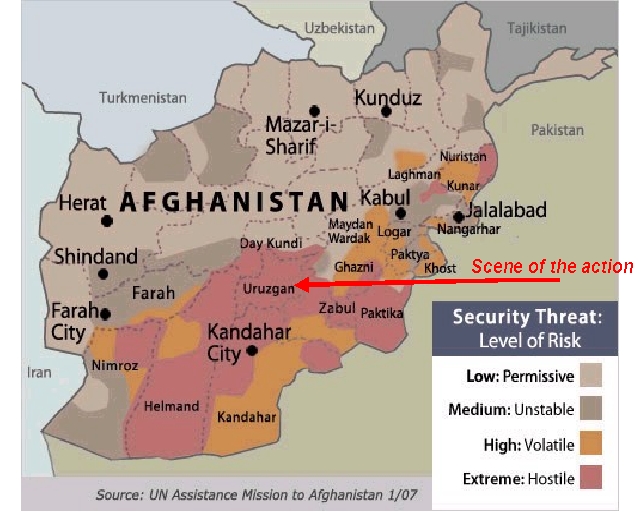
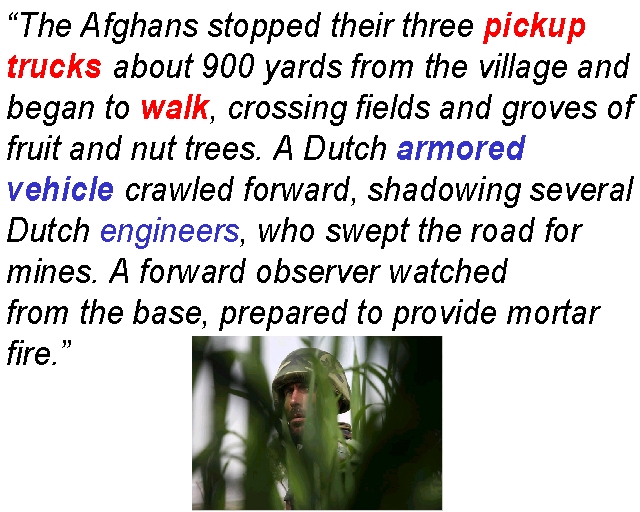
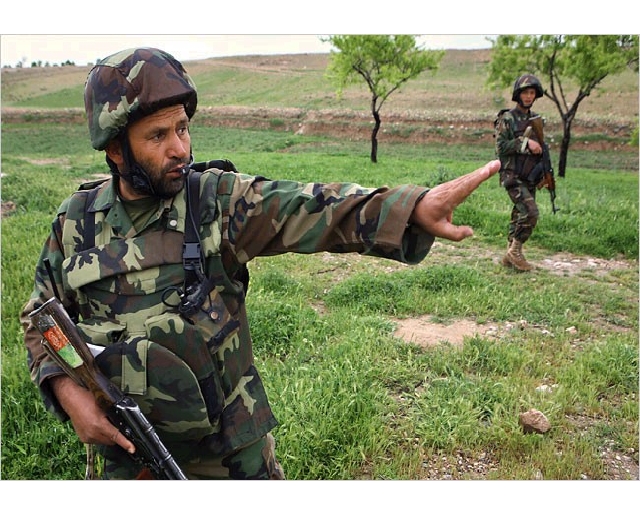
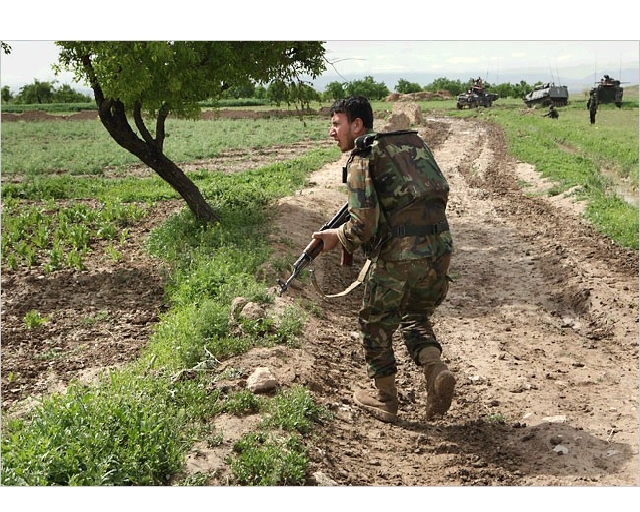
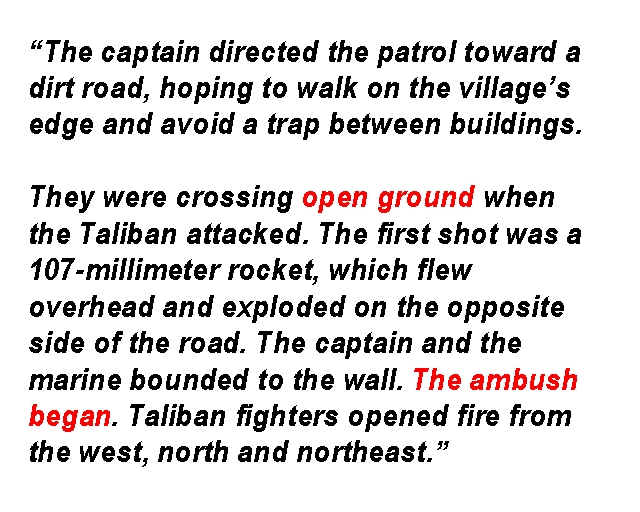
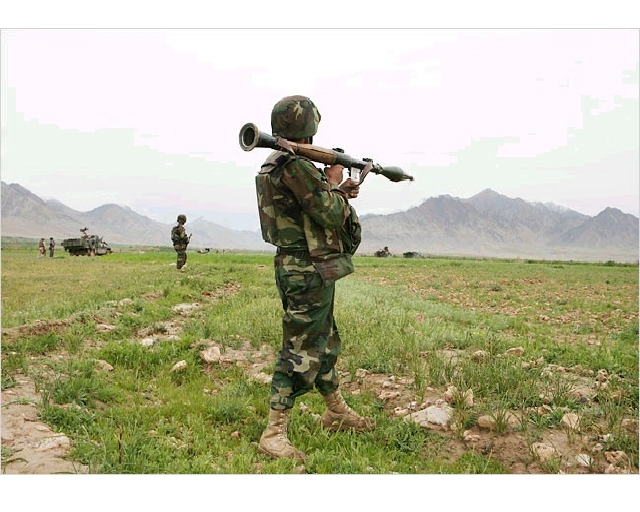
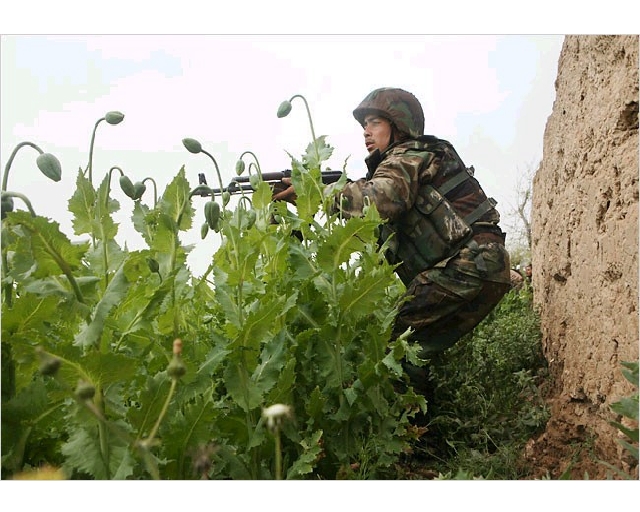
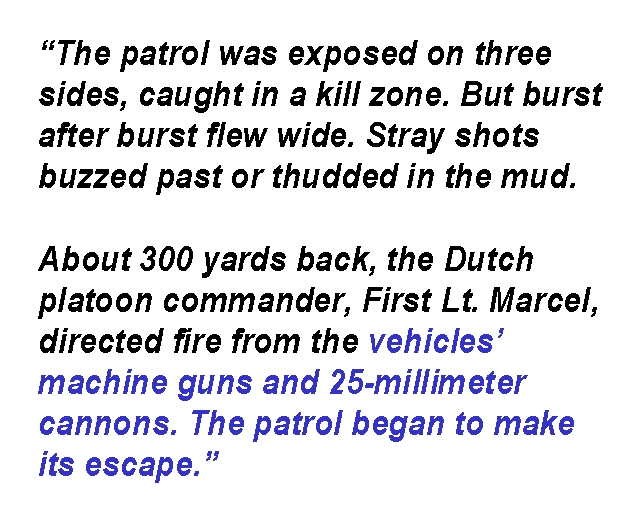
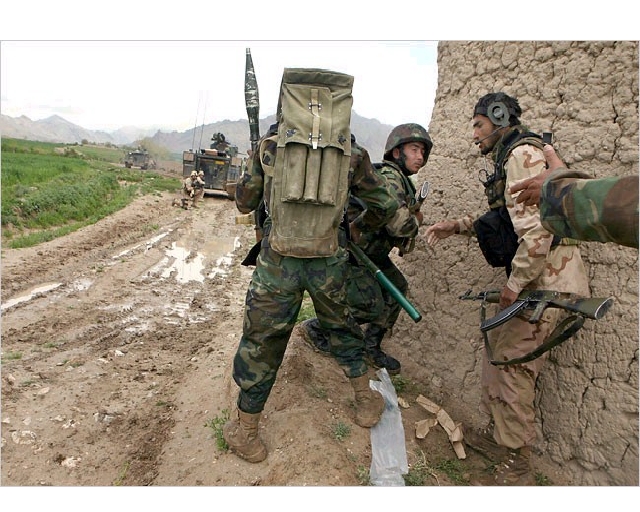
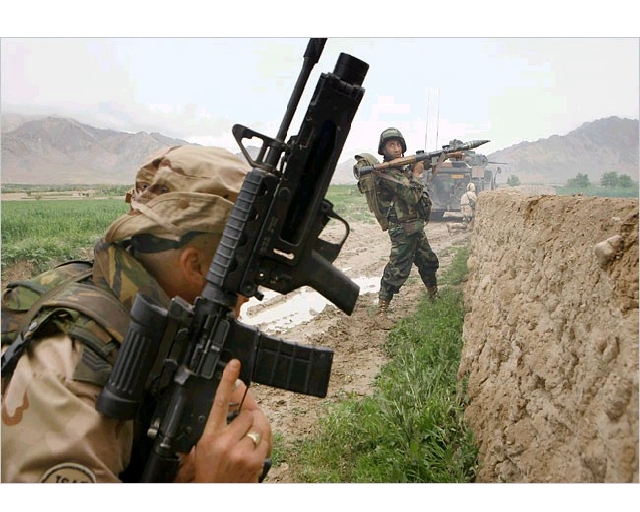
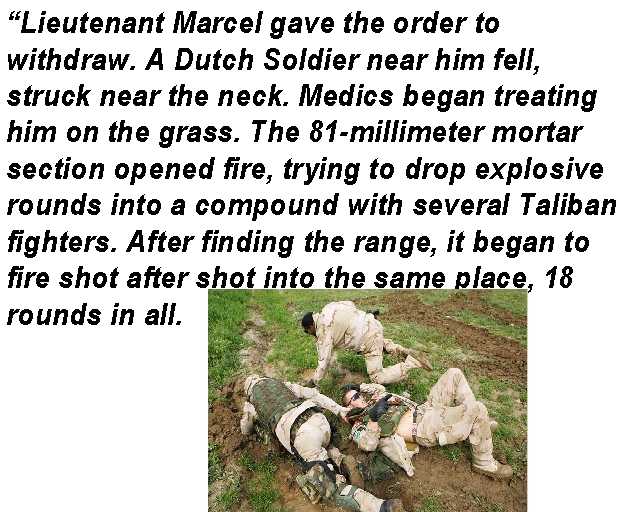
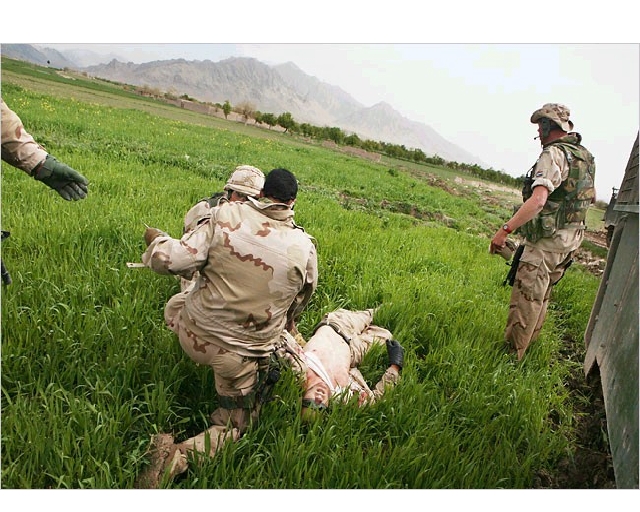
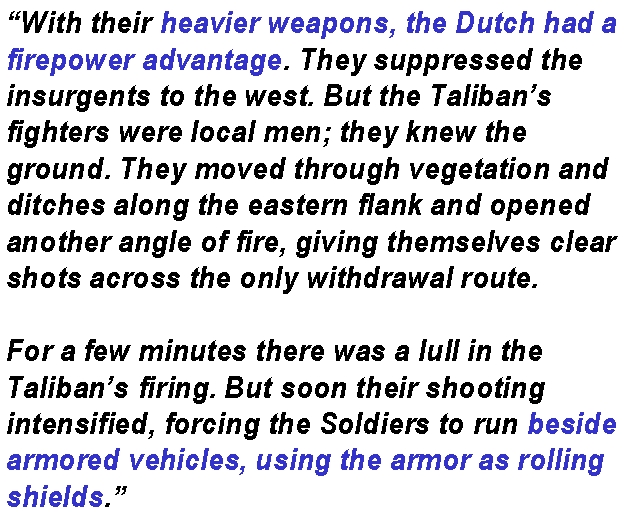
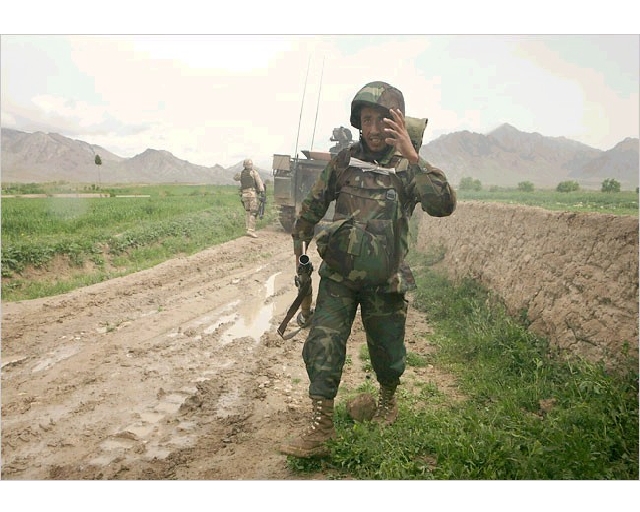
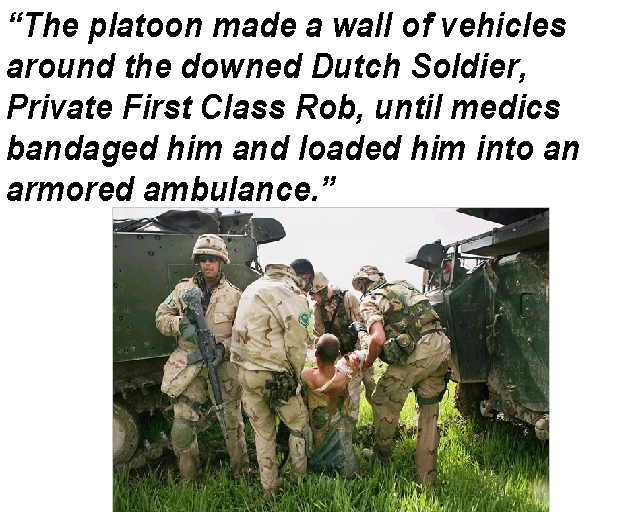
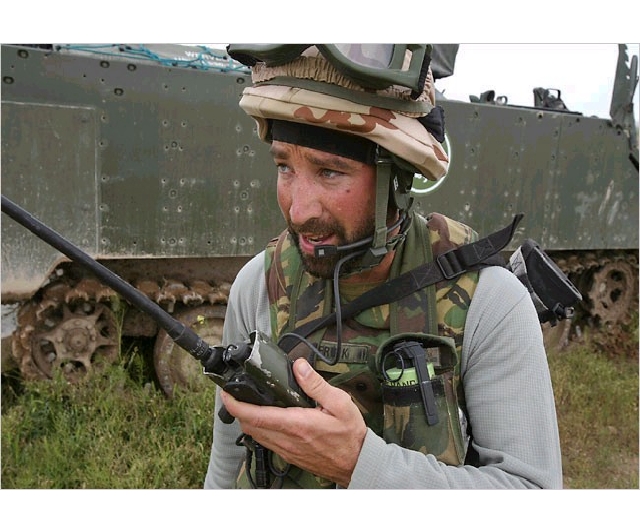
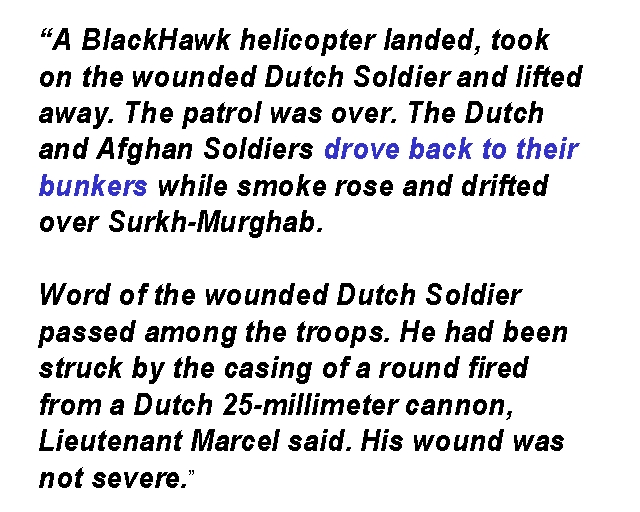
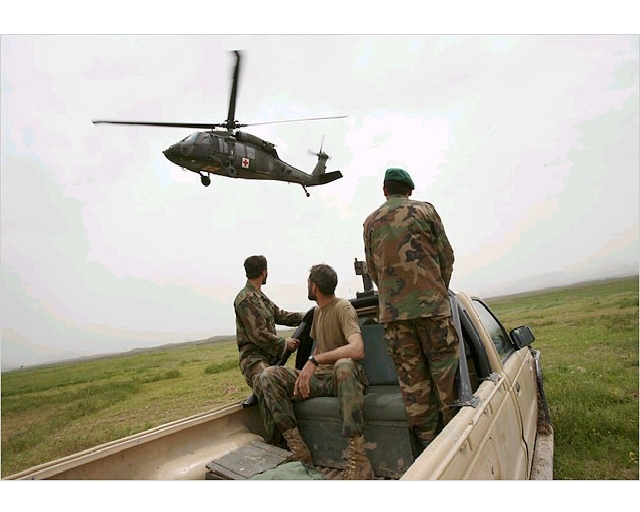
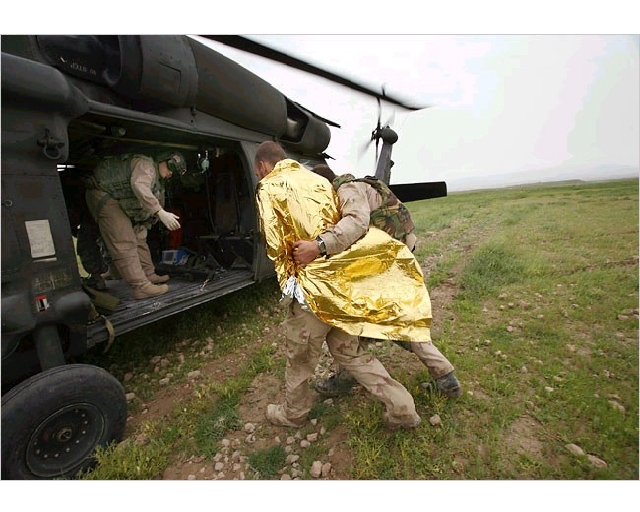
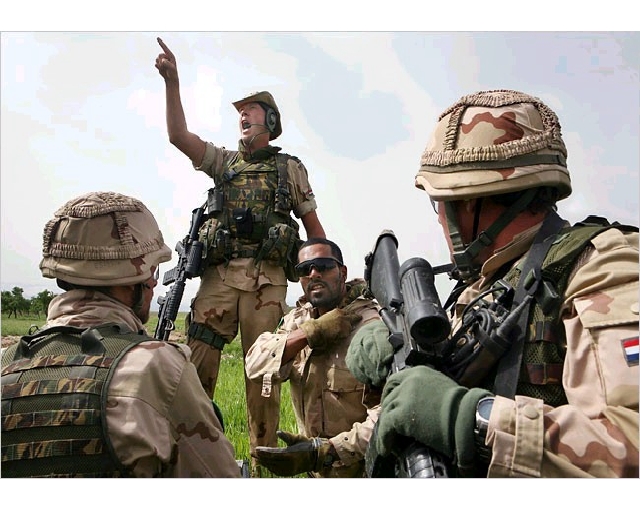
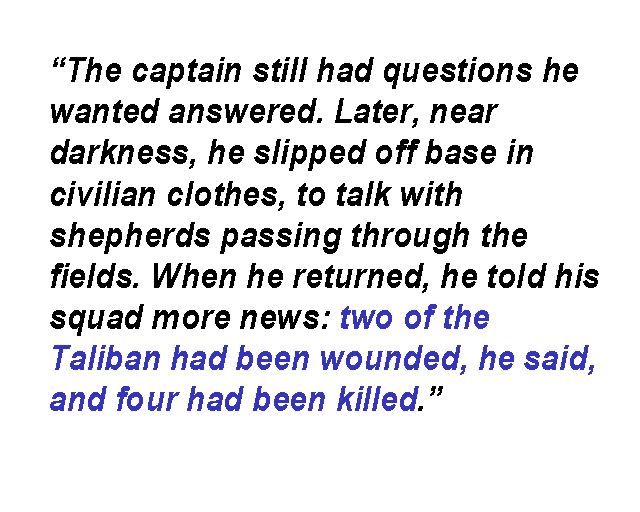
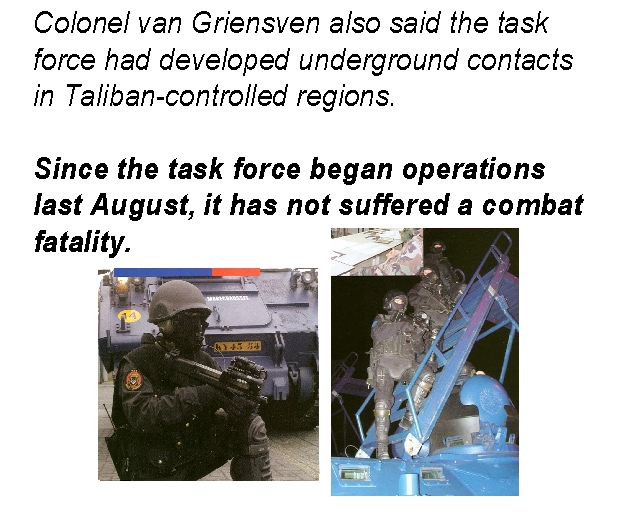
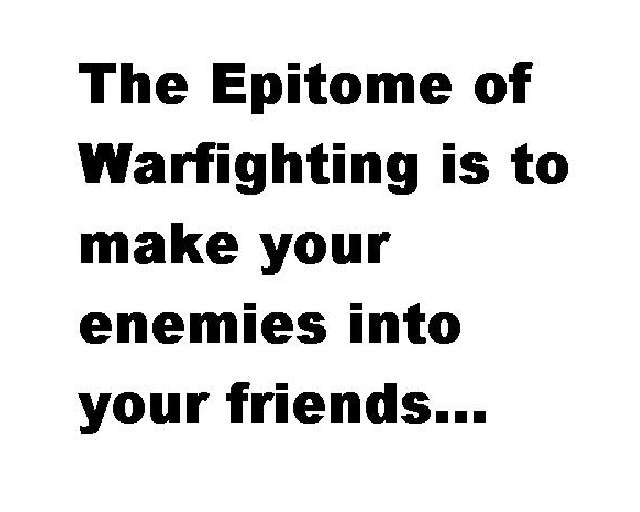

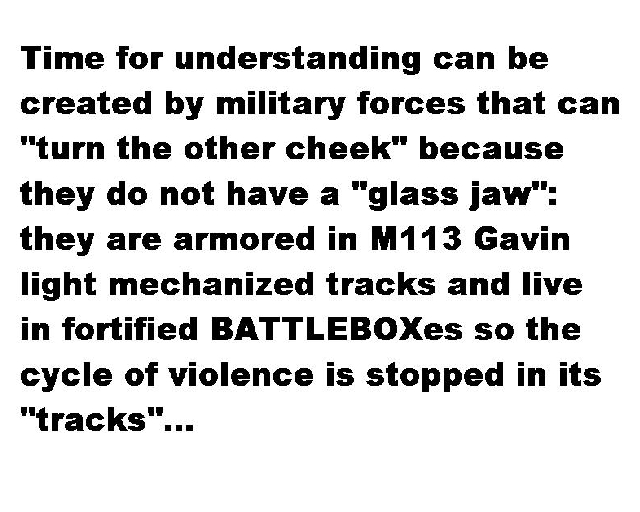
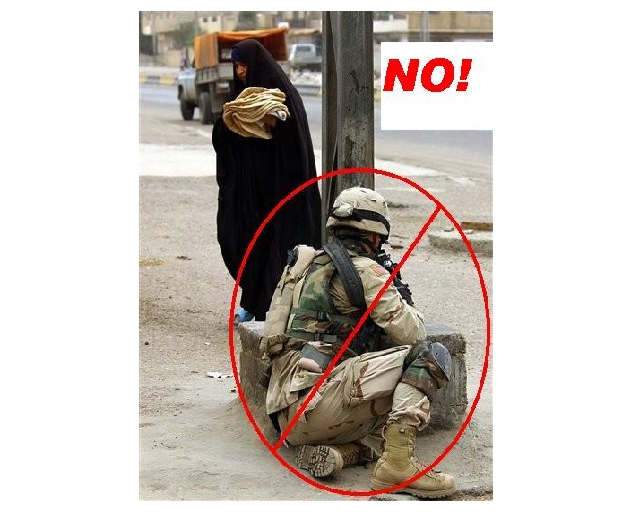
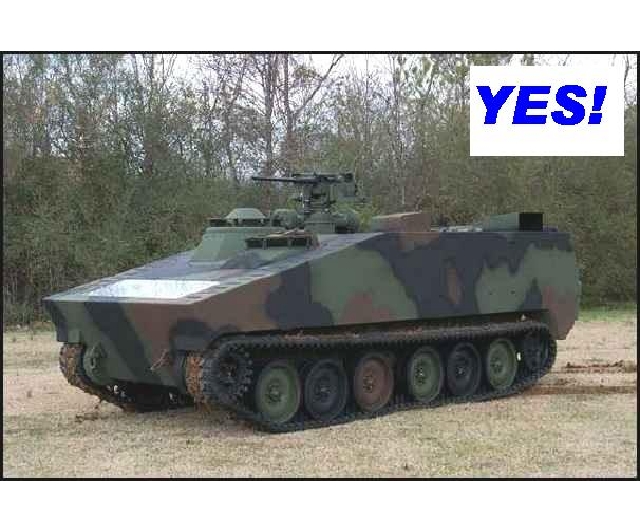
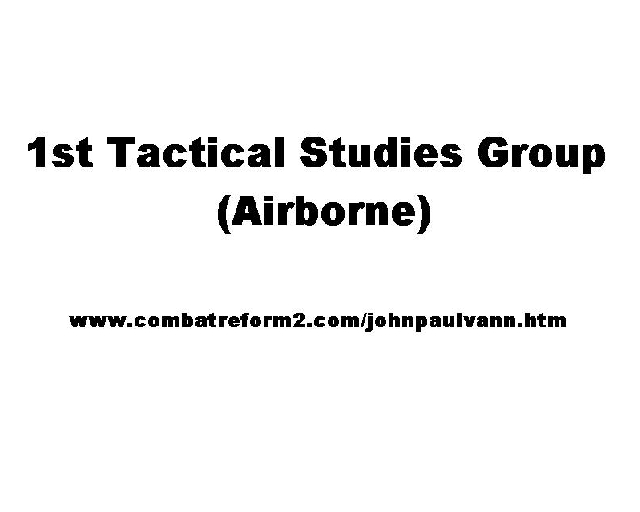
SO WHY ARE WE TRAVELING IN VULNERABLE TRUCKS DOWN ROADS INTO PREDICTABLE AMBUSHES?
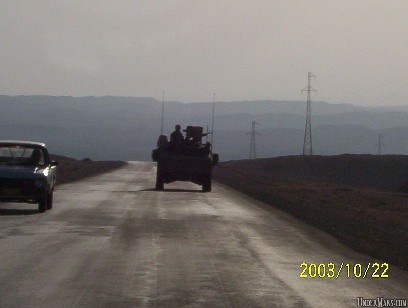
www.youtube.com/watch?v=KGCTSg0bqBg
Paul Hornback's Wheels vs. Tracks Article in the March-April 1998 issue of U.S. Army Armor magazine (before it became politicized) Warned Us Against the Wheeled SASO "Nation-Building" Racket EuroFad
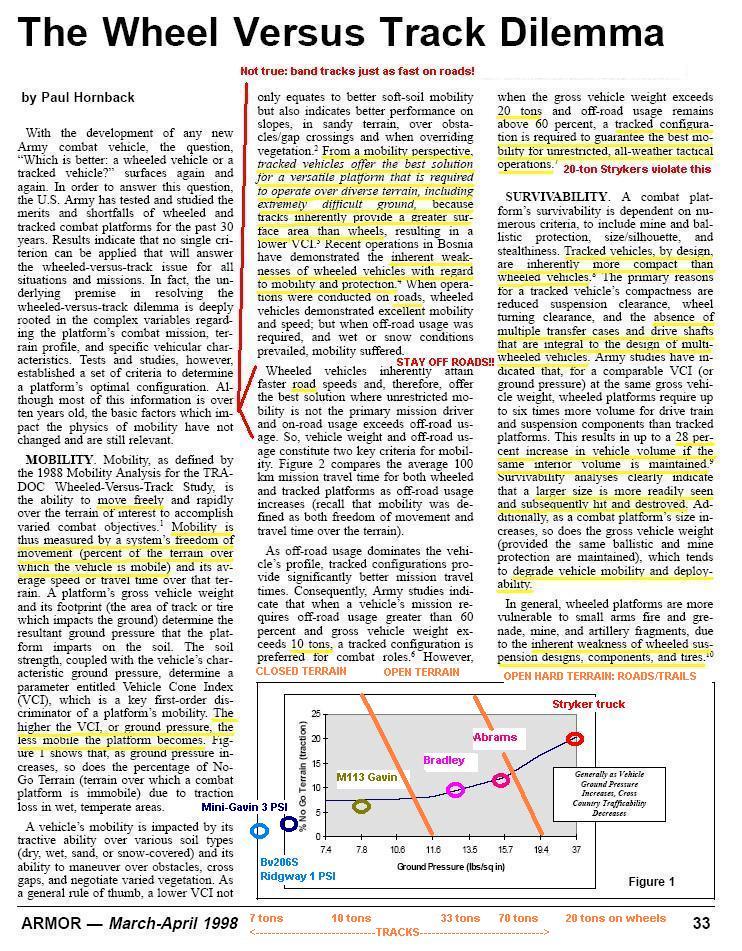
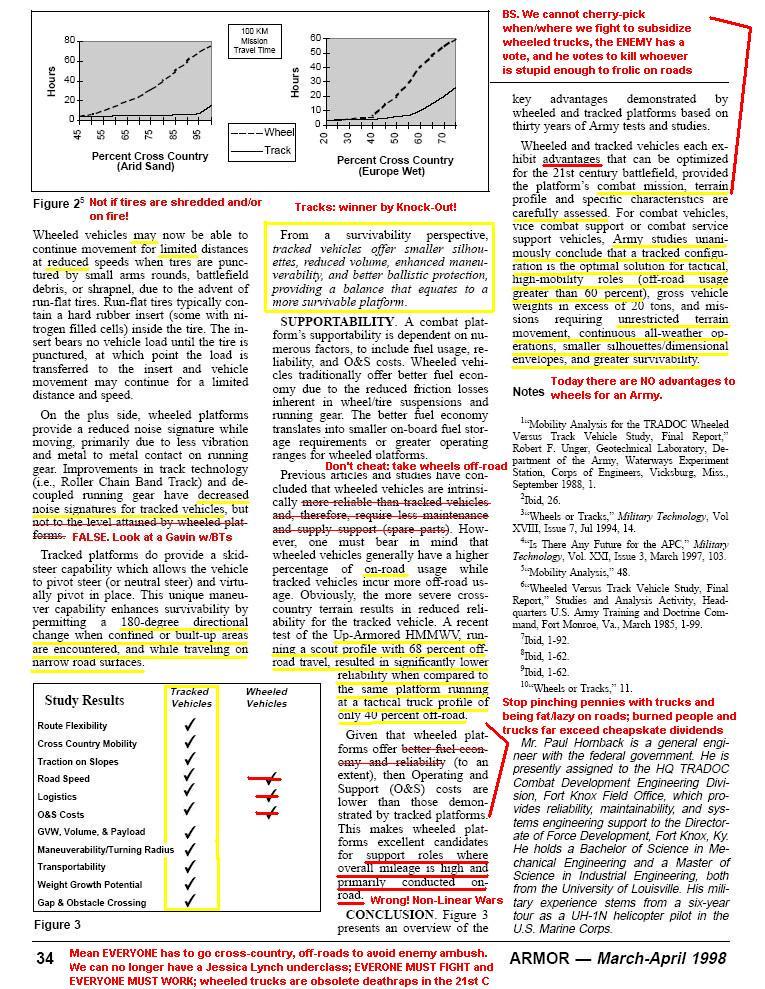
1st TSG (A) EXCLUSIVE: U.S. Army Corps of Engineers Wheels/Tracks NRMM Study
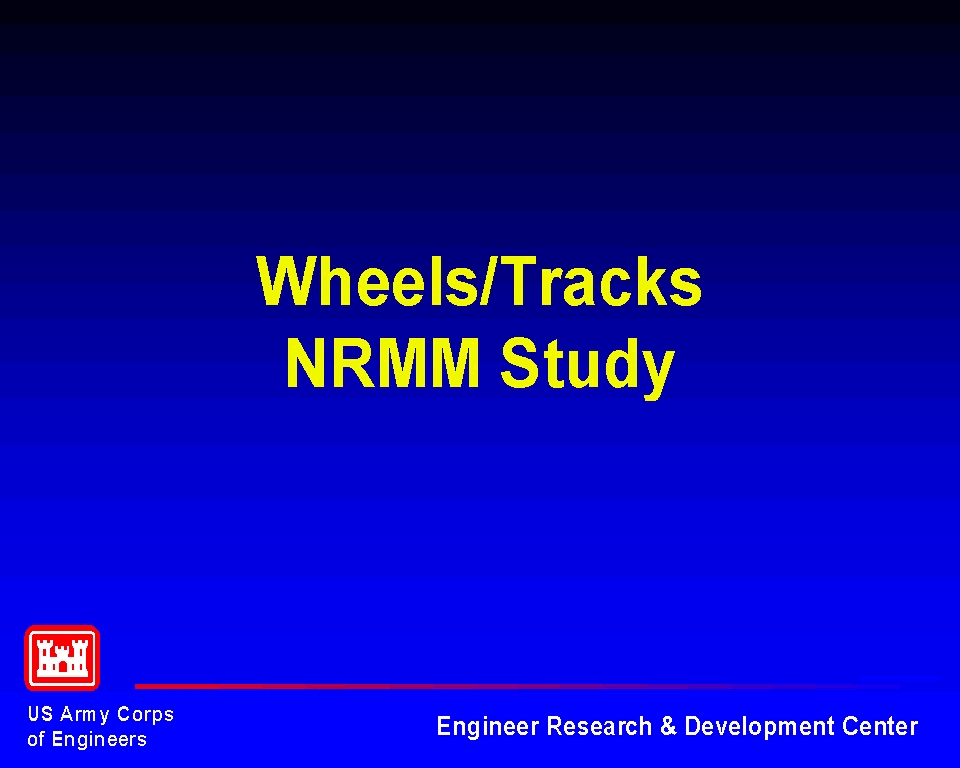
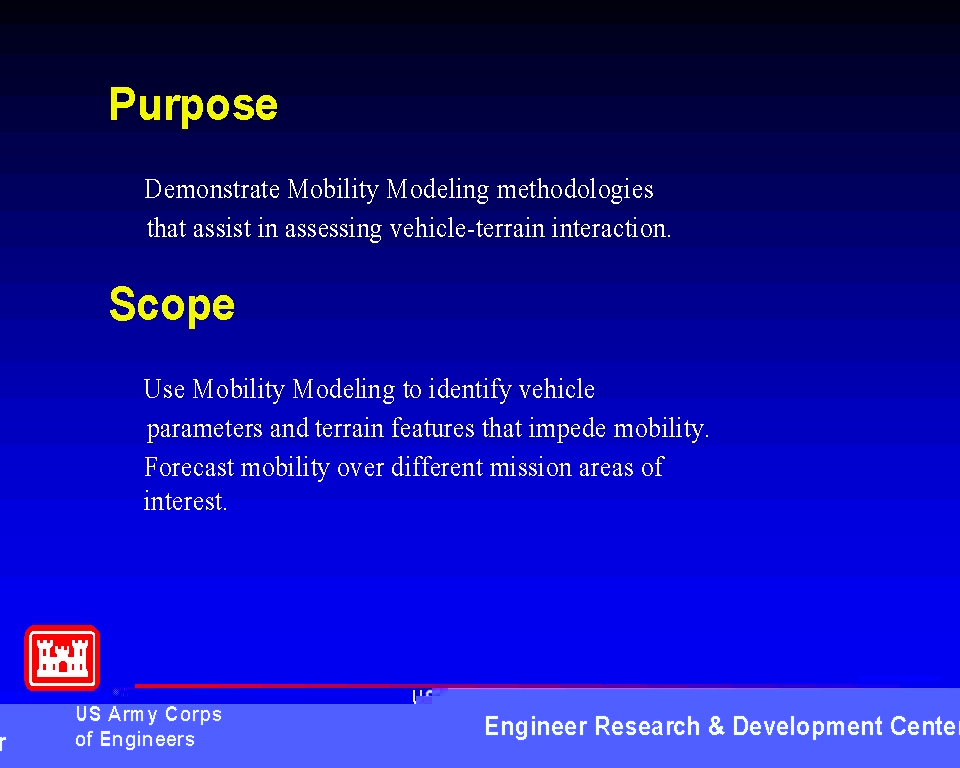
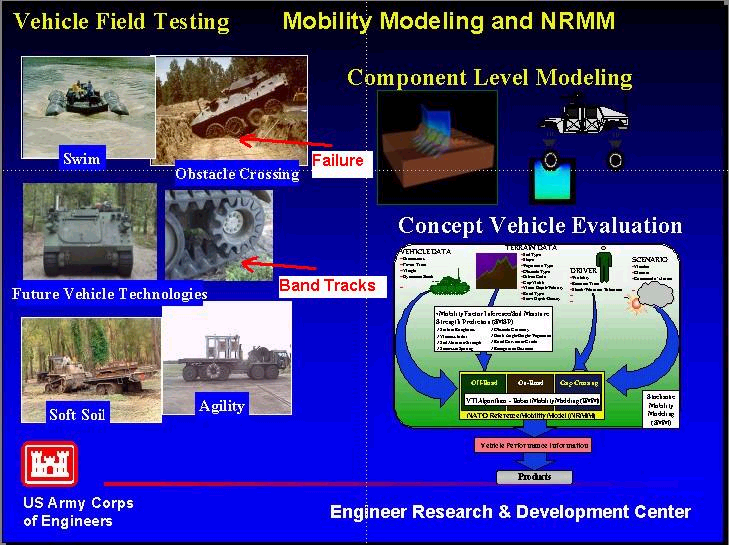
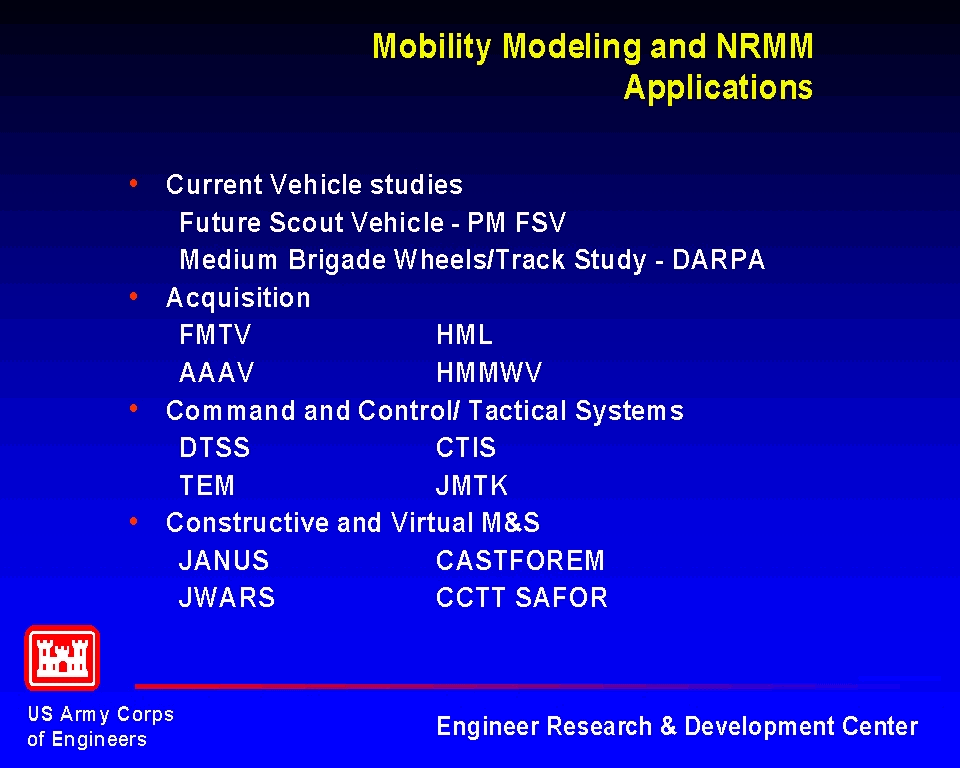
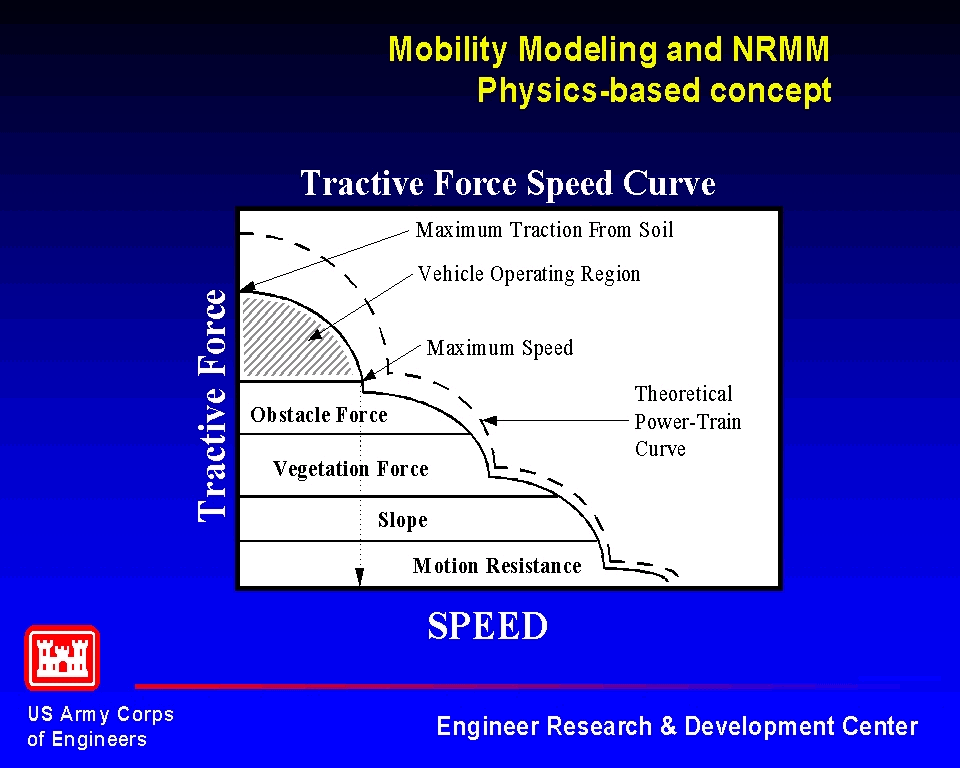
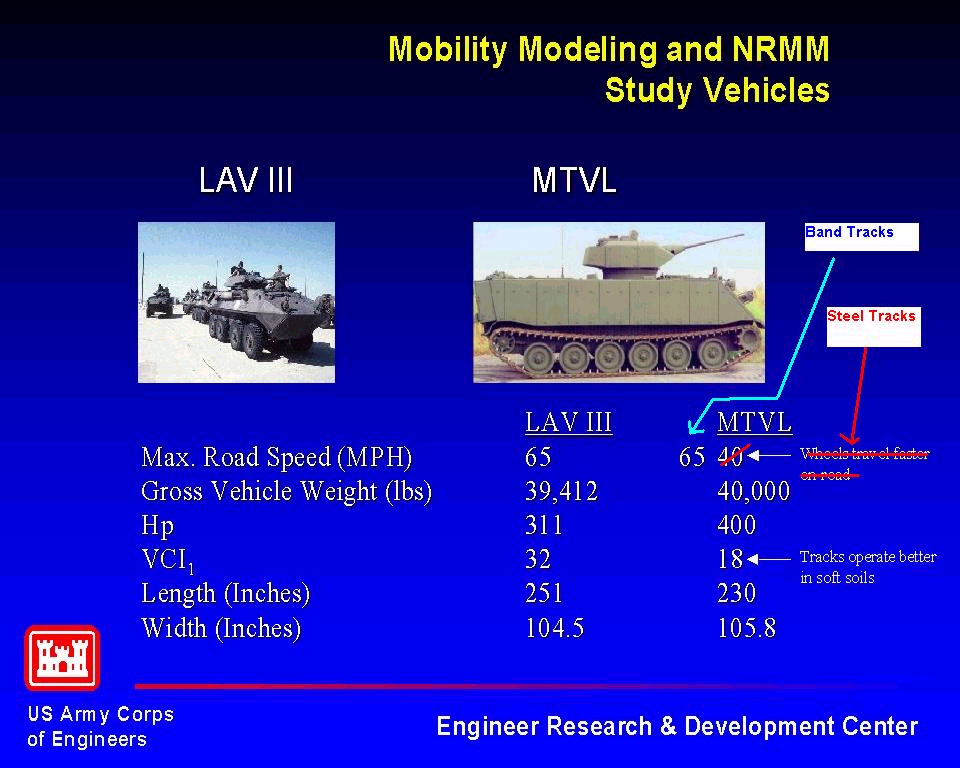

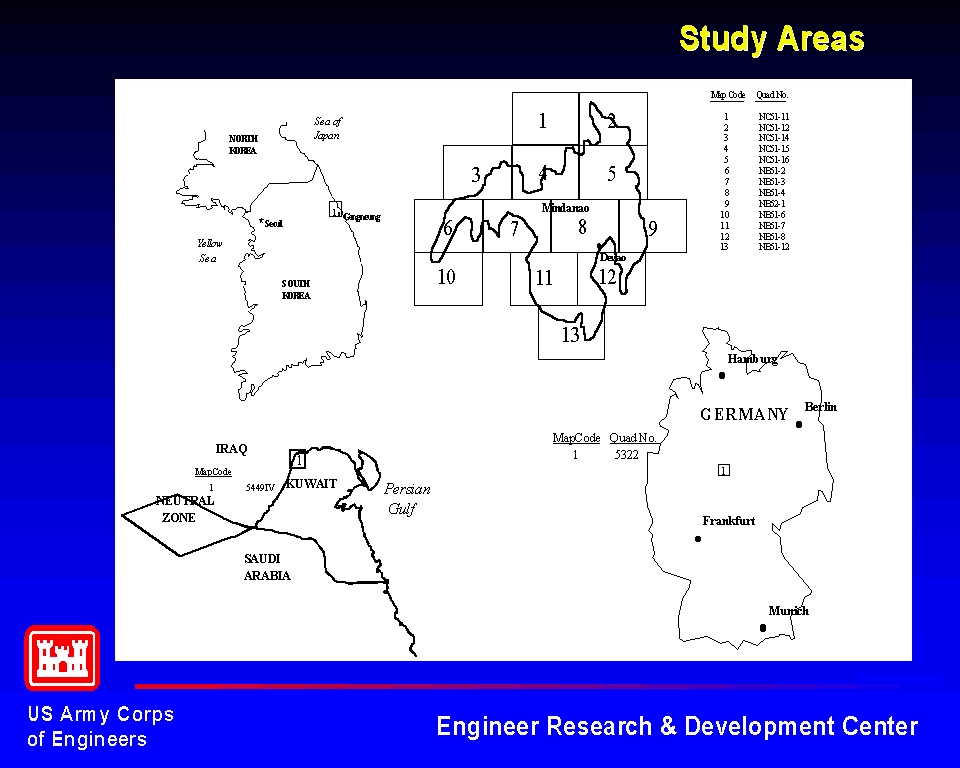
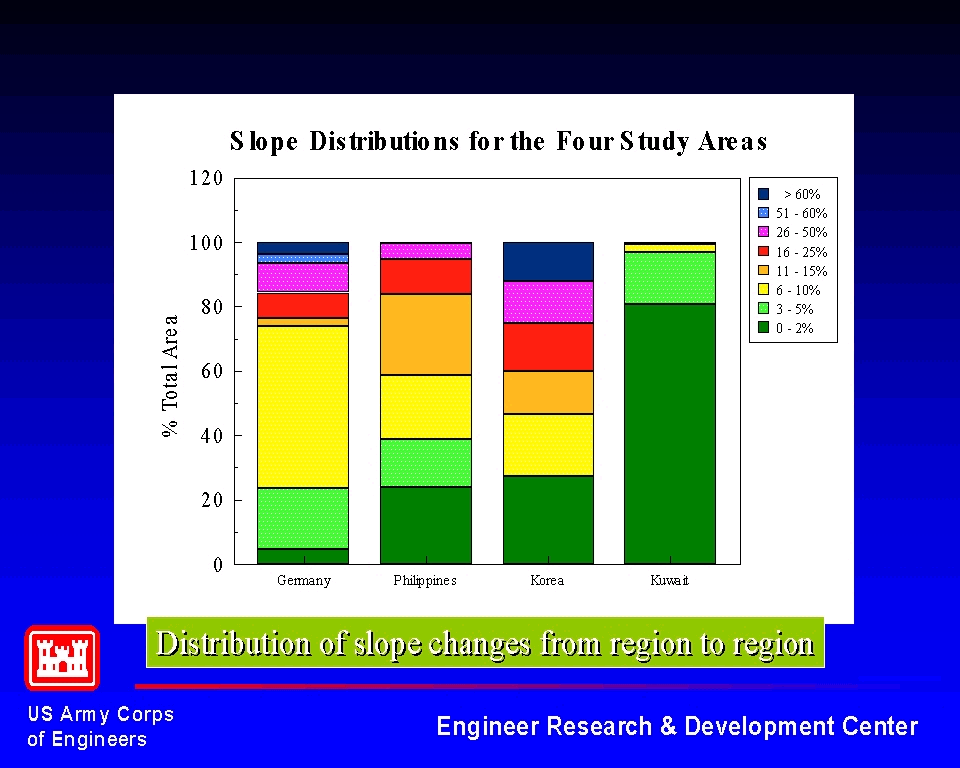
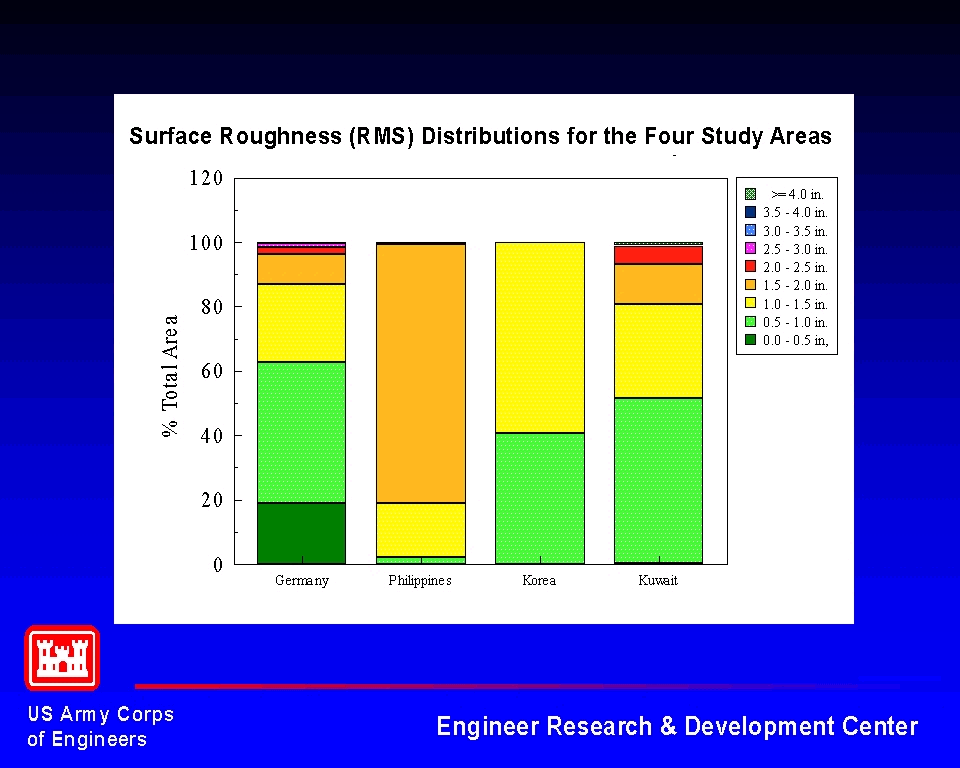
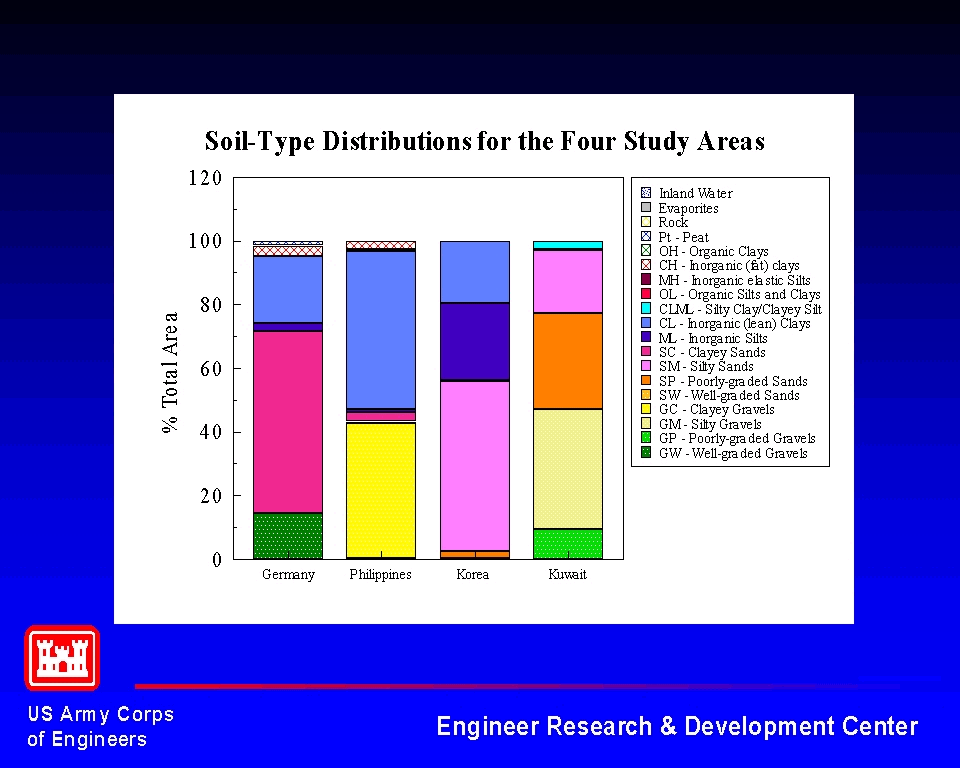
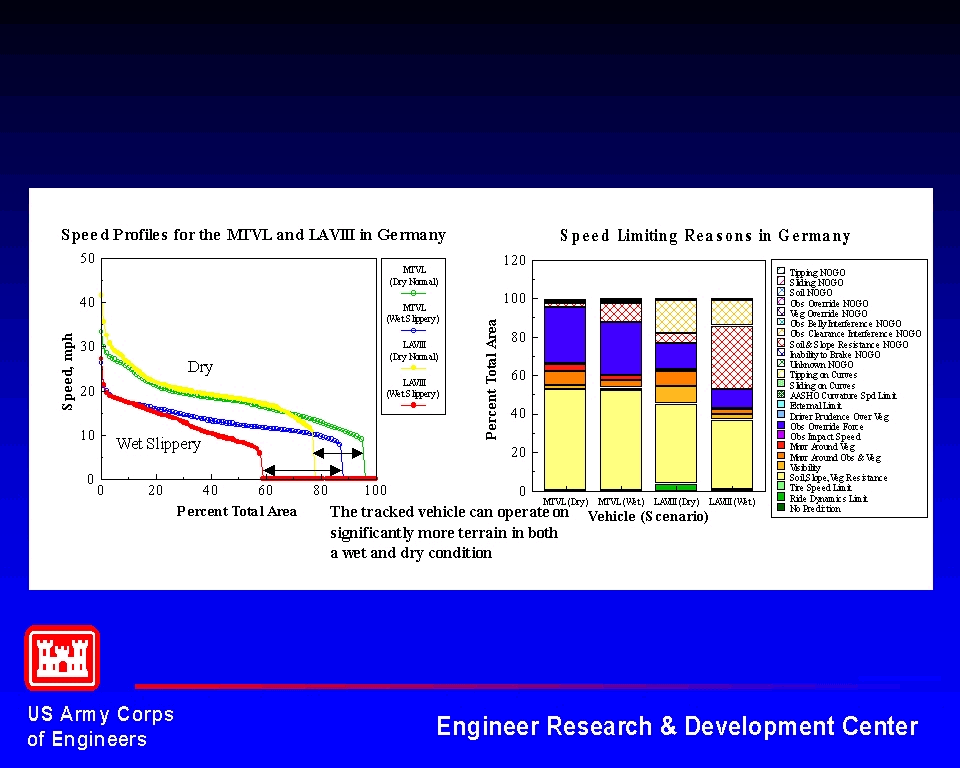
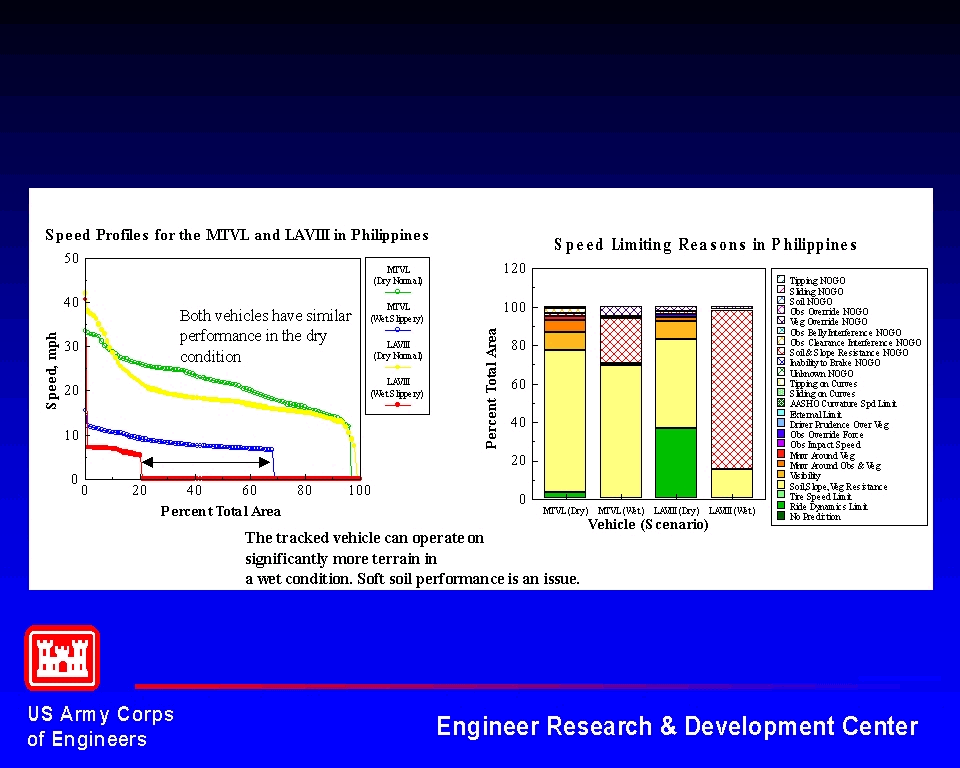
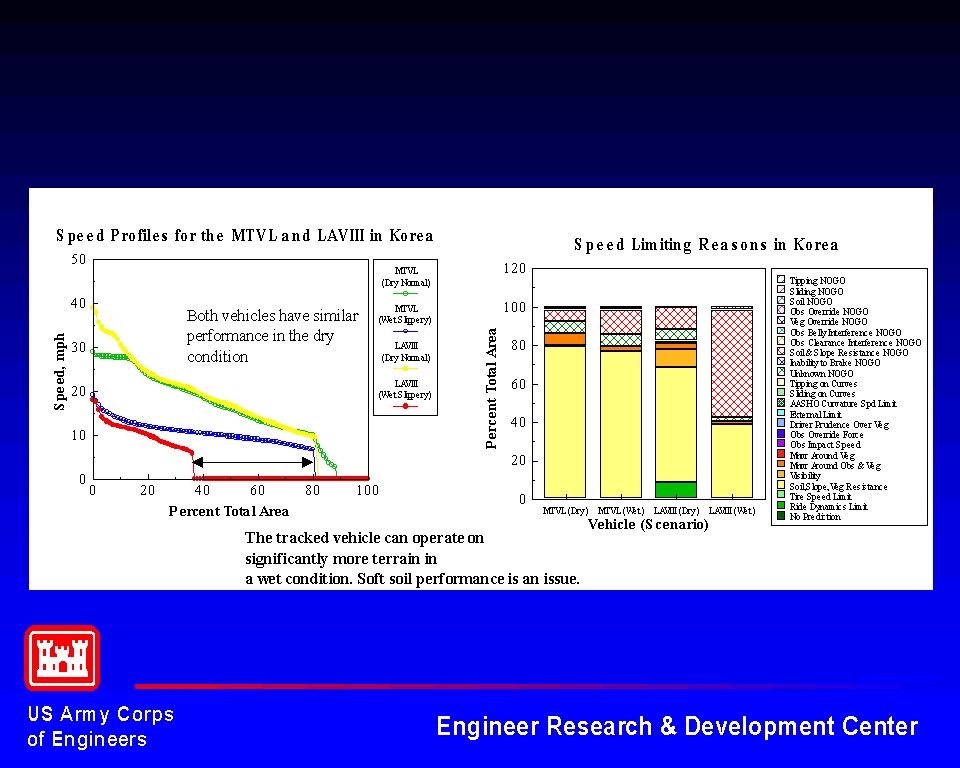
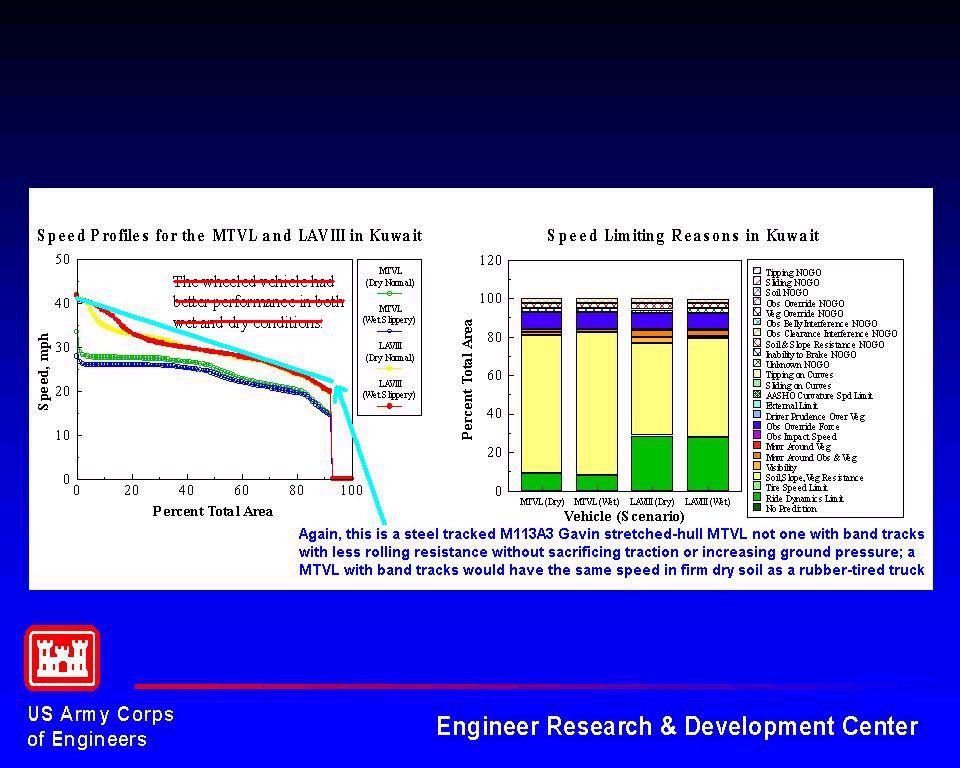
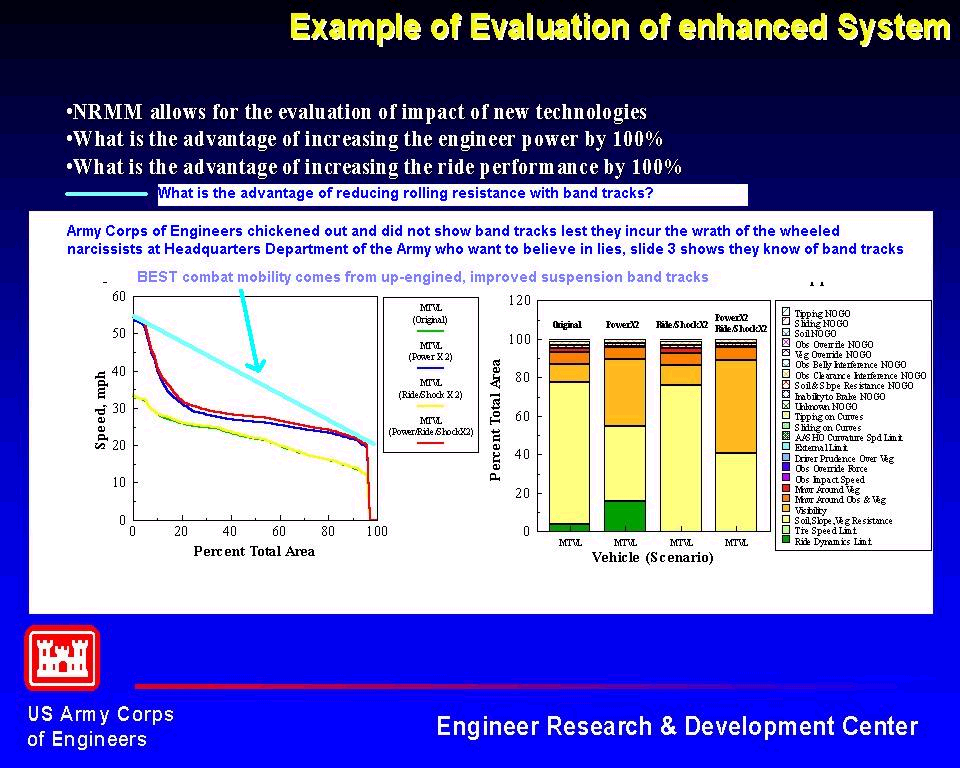
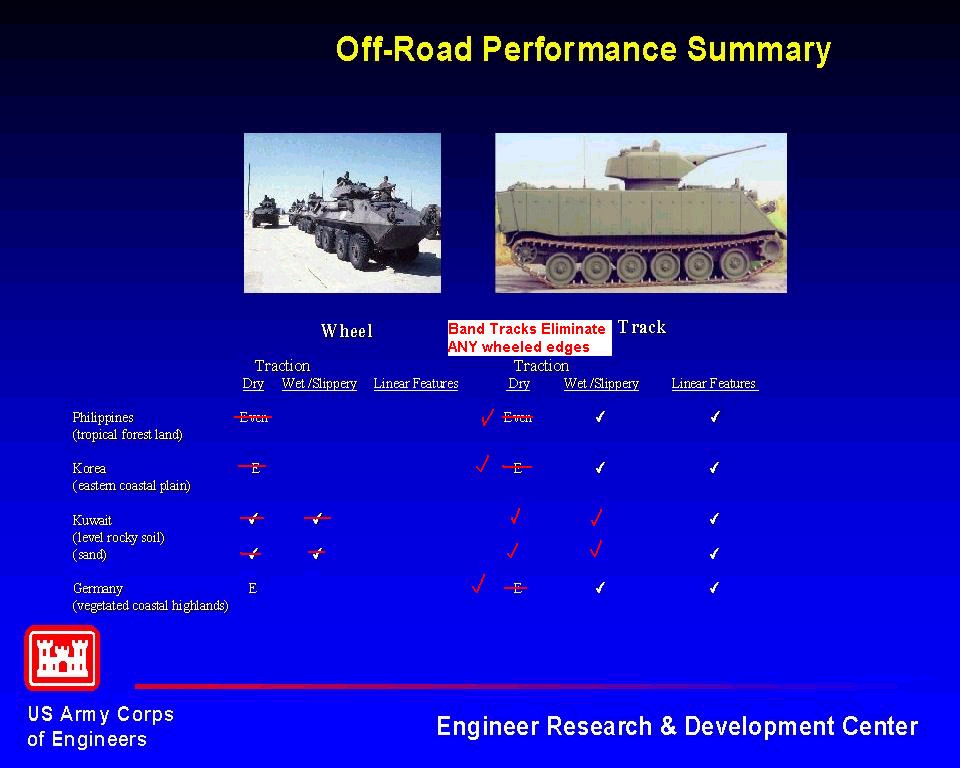
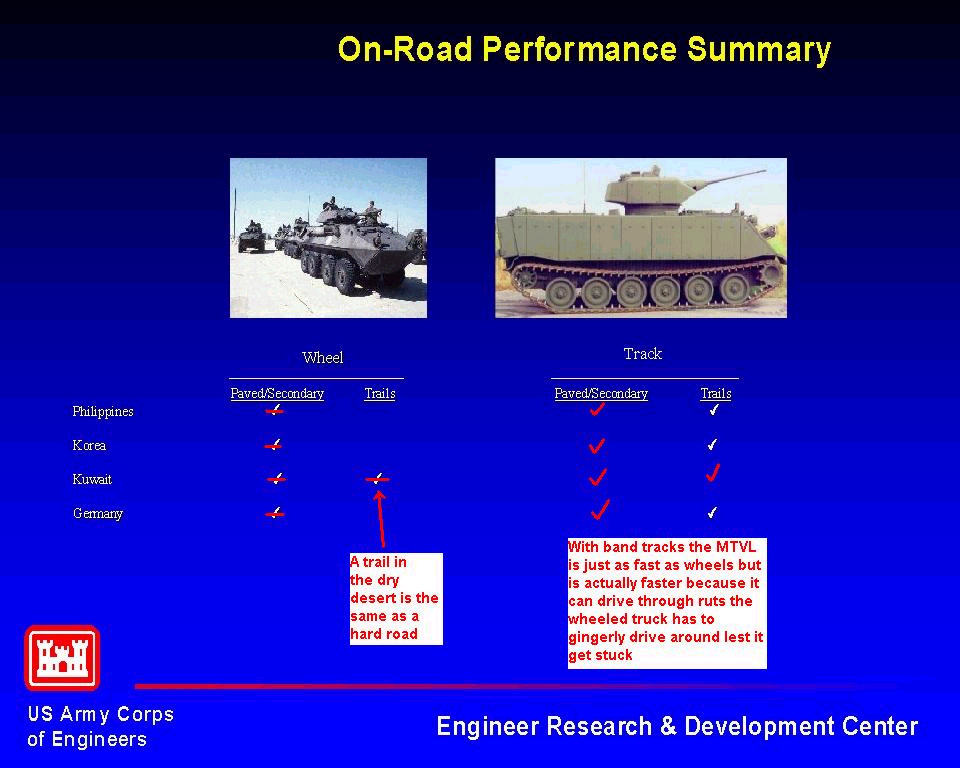
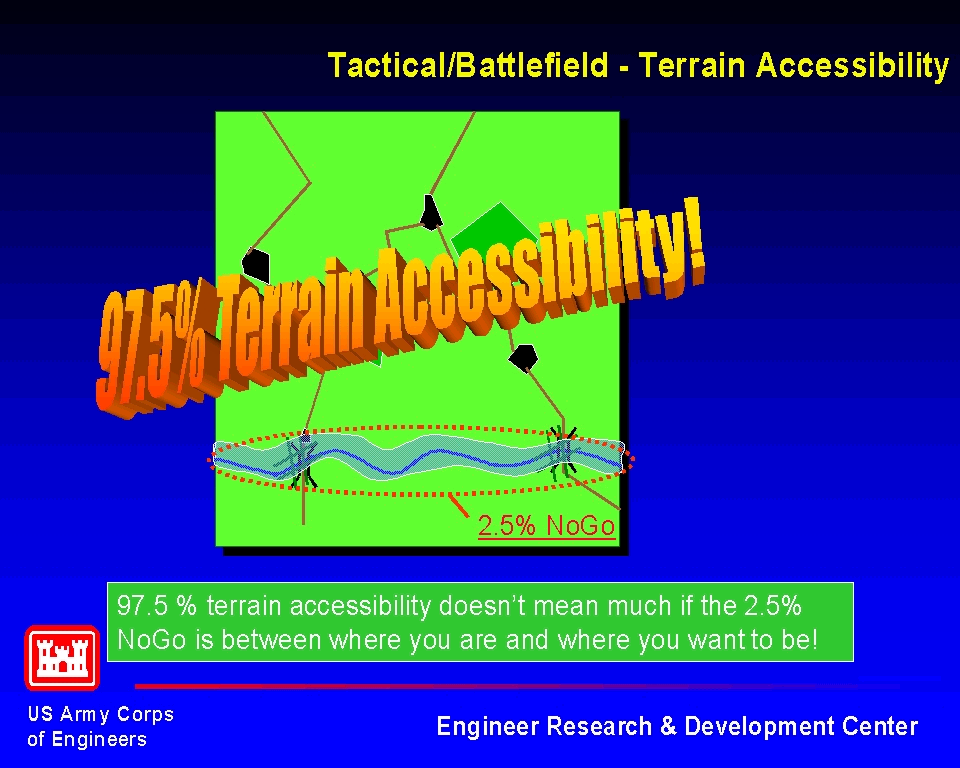
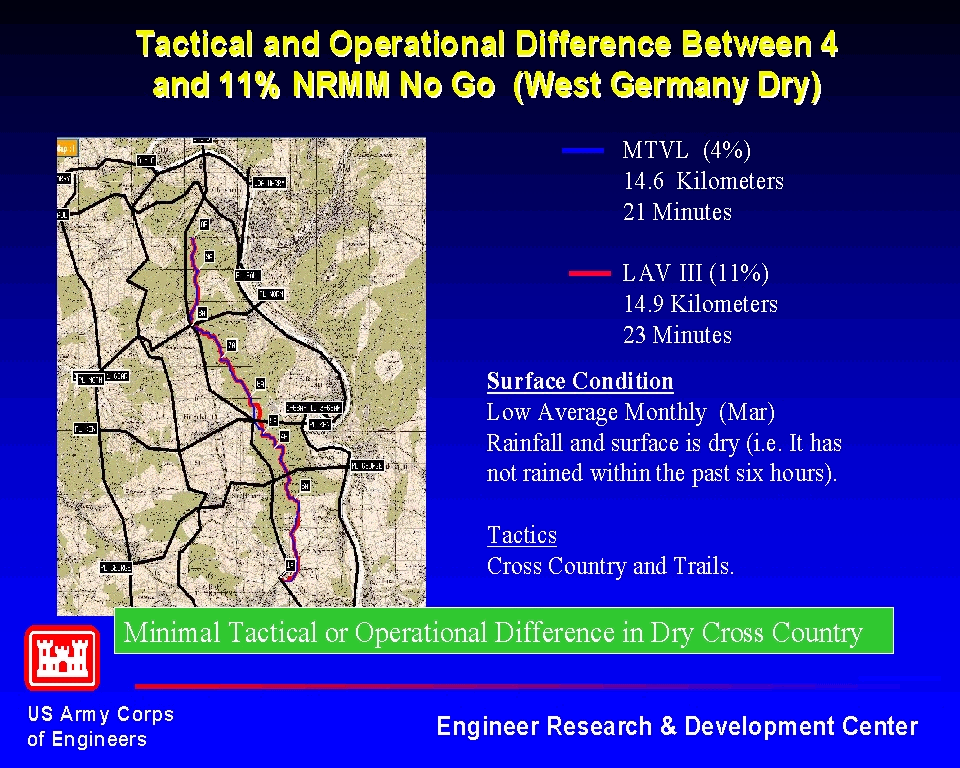
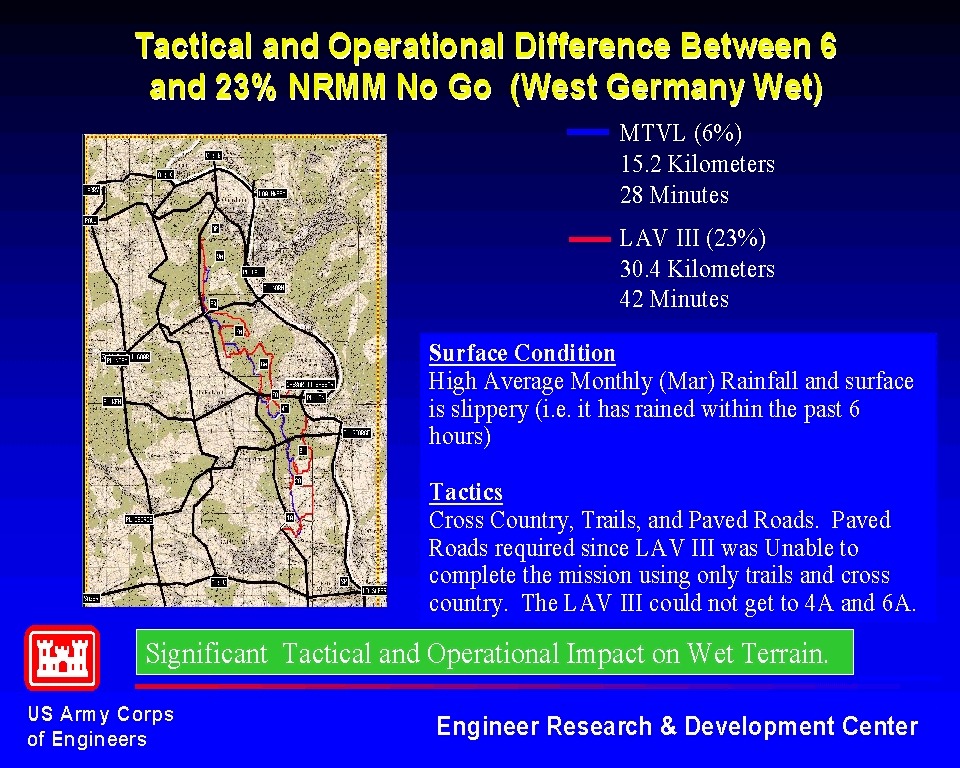
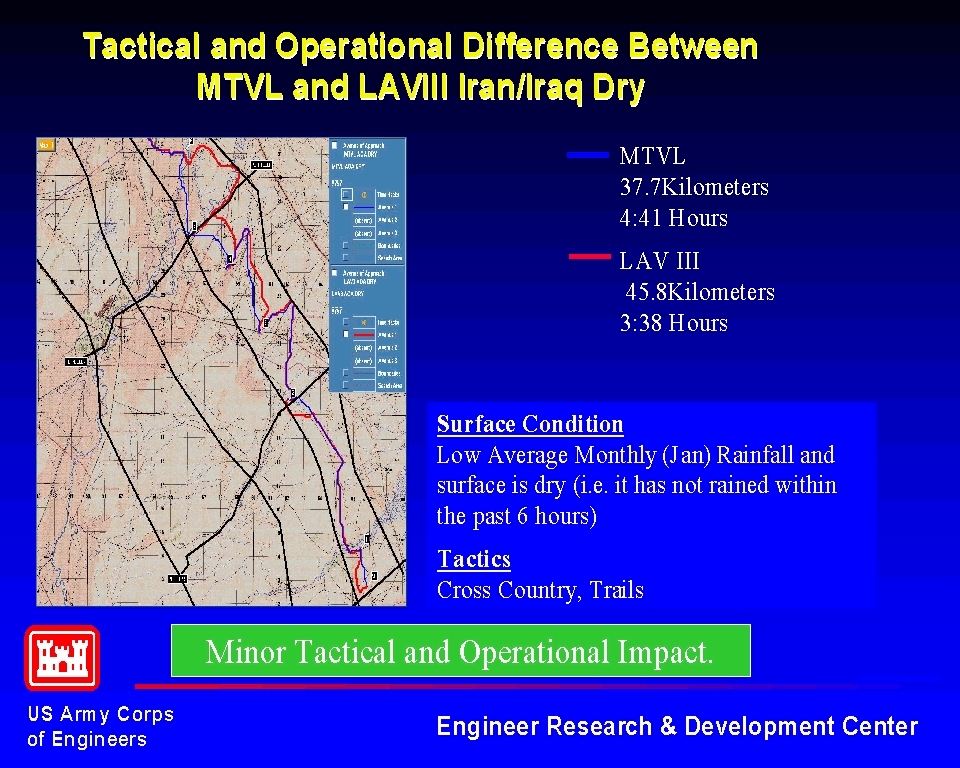
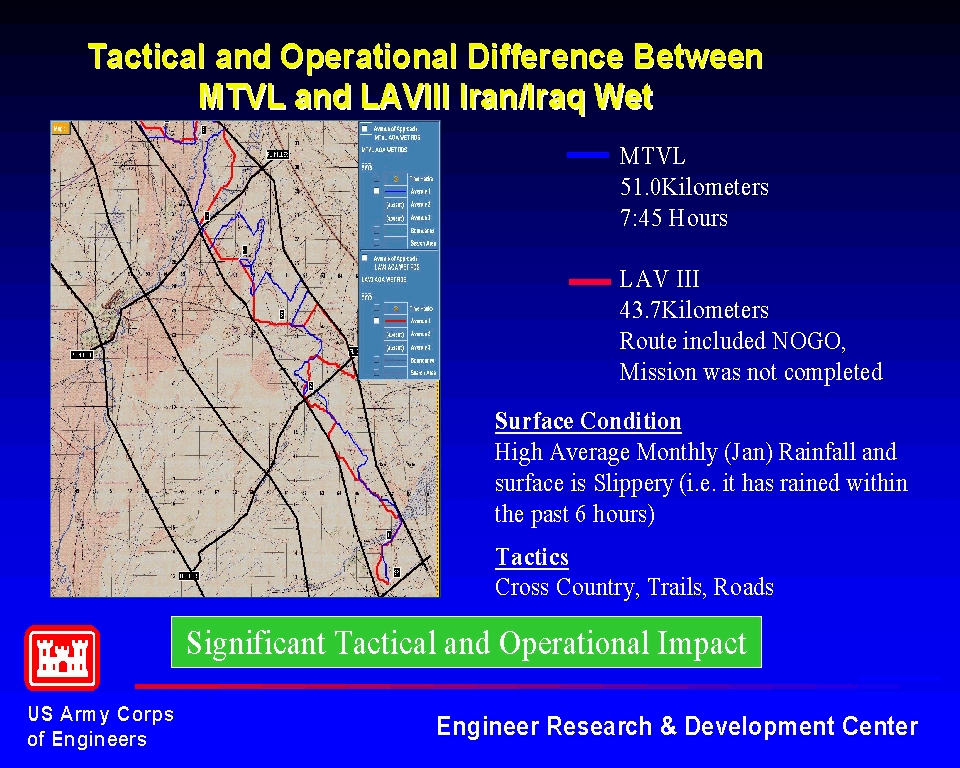
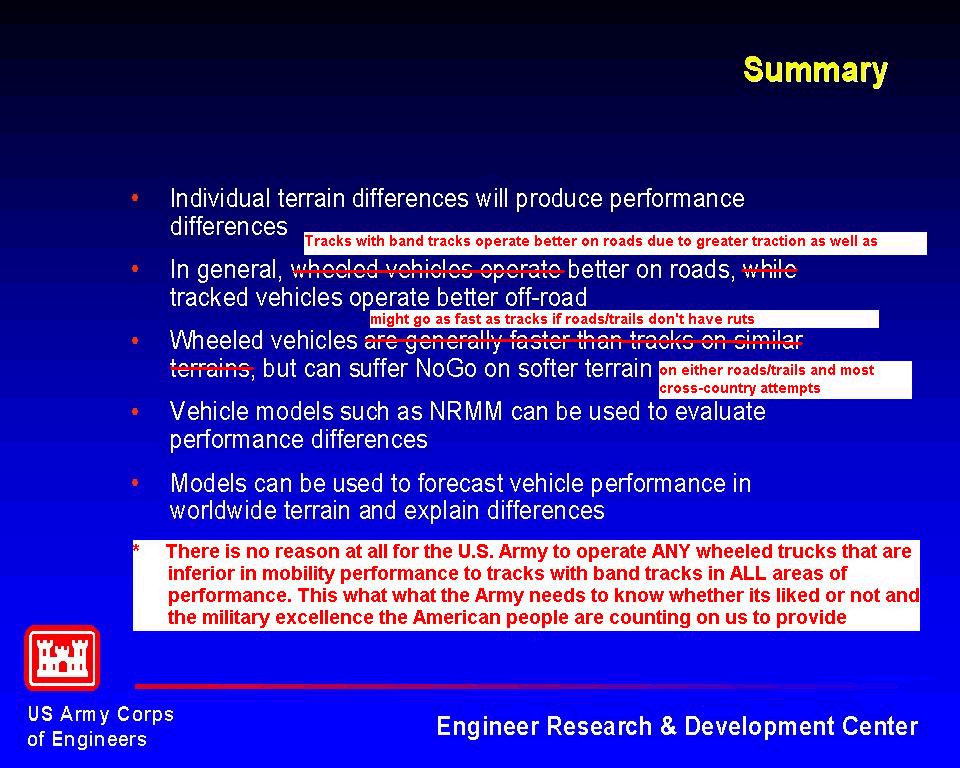
Steel Tracked M113 Gavin went 75+ mph in 1979! There's NO justification for wheeled trucks on the non-linear battlefield!
According to Hunnicutt Bradley: A History of American Fighting and Support Vehicles on page 109, the "Hot Rod" averaged 75.76 mph over a 500 foot gravel test track at Fort Knox in 1979. Power was 2 x 440 cubic inch Chrysler gas engines driving two modified 727 transmissions.
Imagine what M113 Gavins would do today on band tracks with hybrid-electric drive!
www.combatreform.org/bandtracks.htm
www.combatreform.org/hybridelectricdrive.htm
...thanks be to retired LTC Dave Tooker for finding these pictures!!
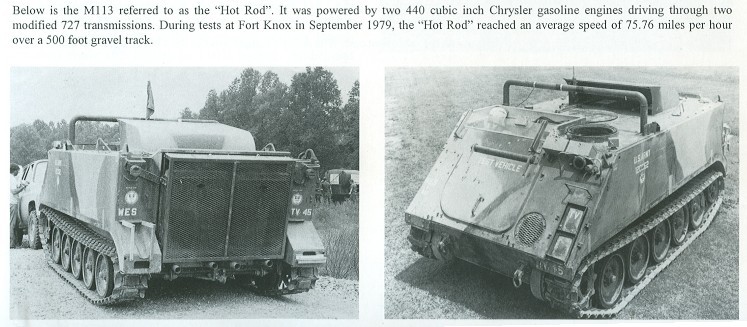
Tracks can easily traverse the vast terrain off to the left and right of paved roads like these...if we were not lazy, impatient Americans who want to ride around in comfy wheeled trucks instead of tactically-sound tracked tanks...and live in tents, former dictator palaces and eventually Forward Operating Bases (FOBs) with all the comforts and absurd parade-ground garrison home life using flimsy wooden buildings.
The Army wheeled narcissist lie exposed: Video Proof that steel tracks can go 60+ mph on paved roads
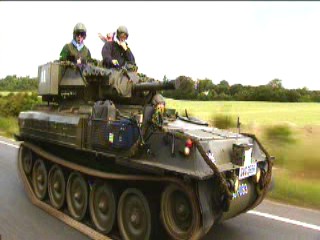
www.youtube.com/watch?v=we9wRITQwwA
This should end the "Stryker and Humvee 60 mph on roads" non-sense forever. Take the governors off our tracks and they can go as fast as you want them. There is NO reason to have or use rubber-tired trucks on the non-linear battlefields of today...they need to go the way of the horse cavalry.
Edited Clip
www.combatreform.org/steeltrackscango60mphonpavedroads.wmv
Full Clip with an excellent short History of Tanks
www.pioneertv.com/video/tanks900.wmv
Recent Productions
http://72.14.207.104/search?q=cache:FFlc_wMMrHAJ:www.pioneertv.com/recent.asp+tycoon+toys+national+geographic&hl=en&ie=UTF-8
Tycoon Toys
(2 x 60' for National Geographic Channel/Freemantle International Distribution) are what the super-rich choose to spend their hard-won zillions on. We meet the few individuals who have a particular penchant for owning, driving and firing huge pieces of ex-military hardware, from field guns to tanks to fighter jets. Tycoon Toys goes on a journey to watch them at play. 2004 - Distributed by: Freemantle International Distribution
3D maneuver requires light tracked AFVs
By the time 1st Infantry Division "Big Red One" Soldiers in M1 Abrams heavy, M2 Bradley and M113 Gavin light tanks slowly airlanded by C-17 into Northern Iraq, Saddam and cohorts were already in hiding in Tikrit. USMC foot-infantry egomaniacs doing feel-good methodical battle but clobbered by mere rear guards while dismounting from vulnerable trucks were 6 days late reaching Baghdad and also contributed to the mission failure. While pompously boasting they believe in "Maneuver Warfare" the USMC shows no understanding of the operational art to rapidly seize nation-state centers of gravity (grab the capital city) to collapse an opponent (3rd Generation Warfare) which would require them to fix their force structure and stop packing our amphibious ships with hundreds of wheeled trucks when they can and should be filled with light tracked tanks. Had the U.S. Army 173rd Airborne Brigade been properly equipped with their own M113 Gavin and M8 Buford/Thunderbolt light tanks they could have parachute dropped their entire force and within hours fanned out into blocking positions to deny Saddam's Ba'athist Regime cohorts to escape to start a rebellion later. Instead the egomaniac Army Airborne did the "seize & hold" BS WW2 re-enactment it likes to do and "held the airfield" so "follow-on forces" could airland. Airborne WARFARE is not airfield (logistics base) seizure and sitting on your ass and digging in WW2-style. Even in WW2, the Airborne was made to MANEUVER after parachute insertion. To do this well, they need their own light tanks and not sit and wait for someone else to do their job for them as the enemy escapes. After the war, General James M. Gavin as Army R & D Chief realized this and created the Airborne Armored Multi-Purpose Vehicle Family which became the M113, named years later in his honor. Light tanks can do things that medium and heavy tanks cannot do over and above the obvious air-insertion capability: they have the absolute best cross-country mobility we have to go through closed terrains to include swimming across shores, lakes and rivers. A professional LIGHT infantry should want the LIGHT tracked tanks it needs to do its job well and stay off the roads/trails as it preaches but does not practice when it rides around in wheeled trucks so they can say they do not look like the "death-before-dismount, mech pussies" in tracks. Because the light infantry rightfully detest the heavy Soldier's laziness and reluctance to dismount when necessary, they wrongly dismiss in their minds the desirability of using LIGHT tracks to do their missions dramatically better just because they might LOOK LIKE the Soldiers they look down on.
500 deaths and 10,000 wounded men later we finally got Saddam--not the way you want to wage 4th Generation War (4GW) on today's non-linear battlefield (NLB). If we want to get fleeing bad guys we need effective 3D maneuver that gets there quick by parachute and helicopters. M8 Buford AGS light tanks should have dropped in with infantry in M113A3 Gavins and fanned out within minutes to block Saddam's escape routes instead of the slow airland build-up that took place. Why didn't the 173rd Airborne Brigade have its own M113 Gavin light tanks to airdrop instead of the slow airlanding operation?
EXCLUSIVE! RARE PHOTOS FROM VIDEO OF M8 Buford AGS Light Tank C-130 LVAD
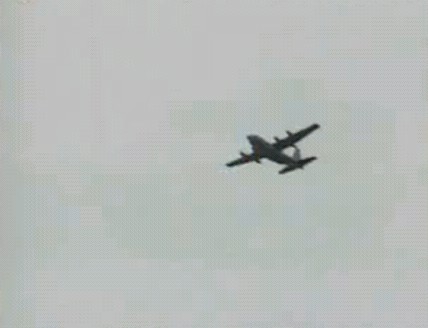
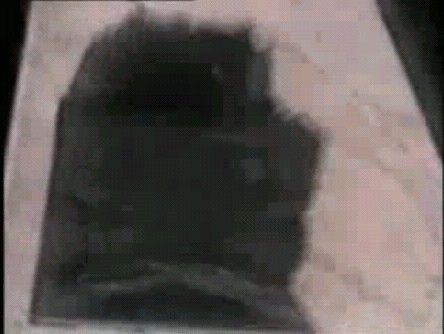
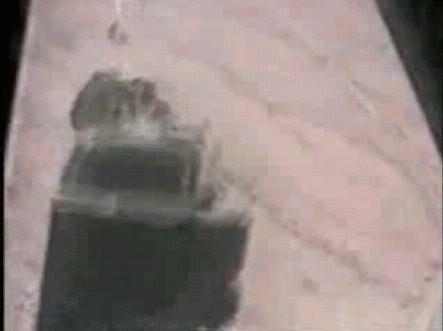
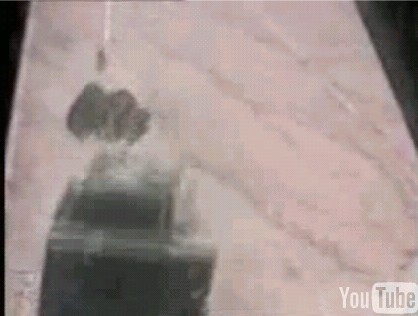
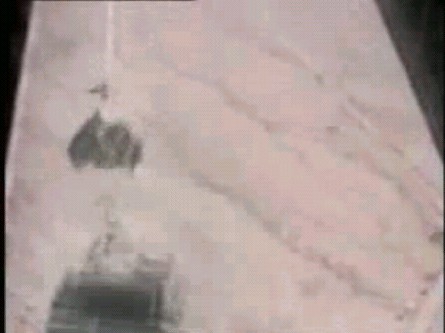
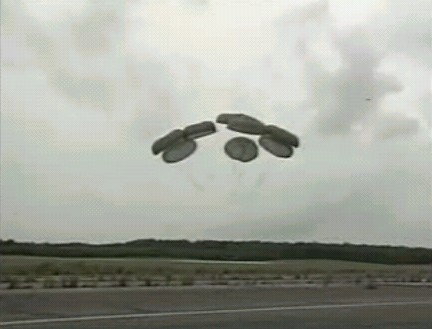
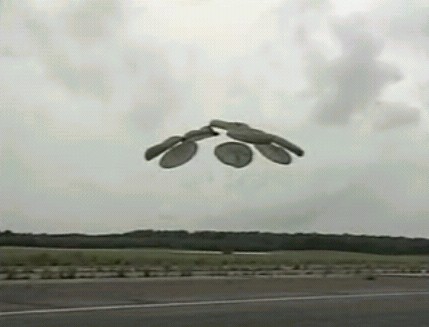
To see the video go to 1:30 on the YOUTUBE video below:
www.youtube.com/watch?v=oqhG0NhKv3U
To its everlasting credit, the U.S. Army XVIII Airborne Corps is beginning to realize this and take action to regain what was lost when their M551 Sheridan light tanks were wrongly taken away when the "Heavy Mafia" was running the Army.
Inside The Army
March 15, 2004
Pg. 1
Army To Transfer Four Armored Gun Systems To 82nd Airborne DivisionWar is not an either/or situation, its and/or.The Army last week approved the transfer of four M8 Armored Gun Systems from contractor storage facilities to the 82nd Airborne Division at Ft. Bragg, NC, sources say, marking the first time the vehicles will be used by the service since the program was terminated in 1996.
Proposed in the 1980s as a lightweight combat vehicle that could fit aboard a C-130, the AGS was canceled as the Army struggled to pay for "other priorities". Contractor United Defense LP, which fought the cancellation decision, has five M8 AGS vehicles in stock -- four in York, PA, and one in San Jose, CA.
The 18th Airborne Corps at Ft. Bragg recently passed along an "operational needs statement" to Army Forces Command that spells out the division's need for a rapidly deployable vehicle with firepower that could be dropped from an aircraft (Inside the Army, Feb. 16, p1). The Army's operations and plans office, or "G-3," has been reviewing the requirement with Training and Doctrine Command.
TRADOC completed its analysis on Feb. 19, and the G-3 approved the needs statement on March 8, authorizing transfer of the existing vehicles to the 82nd Airborne Division, sources say. By press time (March 11), the Army had not released a copy of the approval documents.
According to one source, officials made it clear in the documents that the transfer in "no way should be construed as support for an AGS program." Instead, it is an attempt to meet the immediate requirement with an interim solution and allow the division to begin developing and refining tactics, techniques and procedures.
The unit expects to receive the vehicles by the end of March, the source said.
Rep. Robin Hayes (R-NC), a member of the House Armed Services Committee whose district includes Ft. Bragg, said he is pleased with the decision, but does not want the transfer to be misconstrued as a move to revive the terminated program.
"To be clear, I am not endorsing one system over another," Hayes told ITA in a March 12 statement. "I simply believe that, if these existing AGS are combat-worthy, then they should be fully utilized while we await the future technologies that are already in production."
"My priority on this matter is simple -- what can we do to help our Soldiers in the field the fastest?" he added. "If our Soldiers can utilize these existing systems, then I want these systems in Baghdad rather than in a manufacturing facility in Pennsylvania."
Hayes asked the Army last December to provide him information on the matter, including how much the transfer would cost and whether spare parts are available to maintain the gun systems. Last week, a spokesman for Hayes said the congressman was told government and contractor costs are estimated at approximately $1 million for one year of support for AGS.
The funding, however, is not as much of a concern to the Army as the availability of parts for a system that was terminated eight years ago. Sources say UDLP can sustain the systems for a limited amount of time, but many of its components are now obsolete or unavailable. Supporting the system beyond one year poses high risk, sources said.
Herb Muktarian, a spokesman for UDLP's ground systems division in York, said the systems are ready-to-go.
"We have not received any official requests from the Army regarding AGS, but the four AGS vehicles stored in York remain in excellent condition and we're ready to provide support if asked to do so," Muktarian said.
Maj. Rich Patterson, a spokesman for the 18th Airborne Corps, said officials at Ft. Bragg have been notified and are assembling the necessary manning documents, additional equipment and training plans, "with the intent to integrate the AGS into division operations as soon as possible."
The vehicles will go to the 1st Battalion of the division's 17th Cavalry Squadron, Patterson said. AGS will provide its assault teams "mobility, firepower and shock effects" within the "drop zone," he added.
"It gives us a capability we could deploy if we need it," Patterson said.
AGS features a 105mm cannon, an ammunition autoloader and options for armor protection.
The division's requirement for an air-droppable platform has existed at least since the 1990s, when the division disbanded one of its battalions -- the 3rd Battalion of the 73rd Armored Regiment, which was equipped with an aging armored reconnaissance vehicle called the Sheridan. At the time, service officials thought other capabilities would become available to the Paratroopers once the M551 Sheridan was retired.
When the division deactivated the armored battalion in 1997, however, then-Army Chief of Staff Gen. Dennis Reimer [EDITOR: under pressure from the "Heavy Mafia"] had already terminated AGS, which had been regarded as the Sheridan's replacement. Eliminating AGS freed more than $1 billion over the service's outyear funding plan -- money that was badly needed for "other" cash-strapped programs, officials said at the time.
Two years after the program was canceled, service officials said they continued to review options for all light forces that wanted more firepower. Vehicles reviewed included AGS, the marine corps' Light Armored Vehicle, the Pandur lightweight vehicles used by the Kuwait National Guard and a variant of the M113 Gavin armored personnel carrier (ITA, Oct. 4, 1999, p1; Sept. 27, 1999, p1).
That effort, however, went nowhere, and the 82nd Airborne Division resubmitted its request for such a vehicle, eventually attracting Hayes' attention.
"Let's find out as soon as possible if AGS can serve effectively as a short-term solution for an immediate operational need," Hayes told ITA last week.
-- Anne Plummer
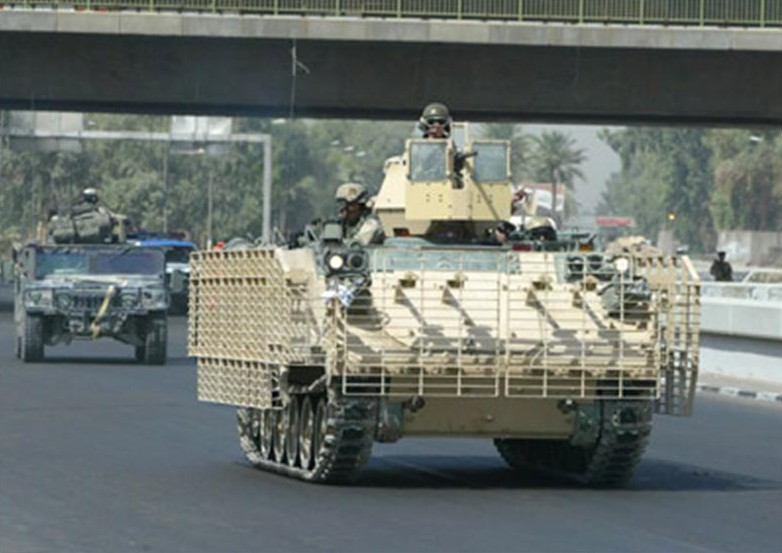
(AP) U.S. Soldiers secure the street following a bombing outside a Baghdad recruitment center on Wednesday. The suicide bomber killed at least 6 and wounded 24 others outside the main gate to the center. The attack came 10 days after another suicide bomber killed at least 21 would-be recruits waiting at the gate.
No one talks about the M8 Buford light tank being a "threat" to the M1 Abrams heavy tank that understands the operational art. Only egomaniacs are threatened by light tanks. Heavier tanks are always needed for 2D maneuver forces in OPEN TERRAIN. Let's not be zero-sum thinkers here.
However, if "threat" means the Soldiers in light tanks might take SOME (not all) of the "glory" from the Soldiers in heavy tanks via 3D maneuver operations, then its too bad--these critics are just being selfish and trying to artificially prop up a "Heavy Mafia" favorite "pet" platform. This is the same narrow-minded, Armor-branch non-sense that lead the M8 Buford to being called the "Armored Gun System" when its really a light tank. The M113 Gavin in operation for over 4 decades is a LIGHT TANK. U.S. Army Armor branch with its WWII Tiger tank duelling phobia/mentality has been guilty of trying to narrowly define "tank" as only what is very heavy (over 50 tons) and with a big gun on a big turret ie; only HEAVY tanks are "tanks", which is pure BS. The truth is there are light, medium and heavy tanks and all have been successful on the battlefield. Some may complain that historically lighter tanks have had higher casualties than heavier ones, but there have been many missions where only light tanks could do the job via air transport, swimming andf closed terrain mobility---and that they suffered losses doing a job heavy tanks couldn't even show up and do---should not be factored against them. We know these same missions had they been attempted without light tracked tanks and just by troops on foot--the casualties would have been even heavier and often we would have LOST the battle. Look at the Rangers at Cisterna in 1943, TF Smith in 1950, the 1st Air Cav at LZ X-Ray in 1965, the marines in Beirut in 1983 and the Rangers again in Somalia in 1993. Do we want to win or not?

We all know the M113 Gavin is actually a light tank since in WWI most tanks didn't even have turrets (you can put a turret on a M113 if you like, regardless); but you also notice we advocate other platforms that are not personal favorites when they are better suited to the job required than M113 Gavins. "Tanks" are really Combat Engineer vehicles to overcome enemy fortifications: Sapper Tanks. This is a fact not understood by the current generation of heavy tankers who want to duel other tanks and not provide fire support for the infantry against bunkers and buildings etc. The M8 with its cut-down hull has a lower center-of-gravity for better firing stability. Could a M113 Gavin be cut down to do this? Yes! Its already been done, its the amazing Rapid Deployment Force (RDF) light tank. Let's see things for what they are.
The truer definition would be anything that is tracked and armored is a "tank". U.S. Army Armor branch by not admitting this (bending) has placed its entire survival in jeopardy (breaking) by not embracing lighter tanks for 3D maneuver and infantry fire support so it can remain more relevant in our globally-connected world where results are needed in a hurry. Is it a surprise that now that the "Light Mafia" is running HQDA, that Armor branch is now moving against its will to Fort Benning, Georgia to be smothered in trees at a walking infantryman's pace? They only have themselves to blame by earlier rejecting the M8 and undermining attempts by the few visionaries in the light infantry community to get M113 Gavins in childish "us" vs. "them" bureaucratic in-fighting. Heavy tanks can't do 3D well right now and probably never move well in closed terrain...the laws of physics on planet Earth remain constant. Tankers can rightly complain about infantry wanting to bog their vehicles down to a foot pace and to use absurdly vulnerable rubber-tired armored cars; the same mistake we made with the failed 9th Infantry Division "motorized" (wheeled) debacle and deja-vuing again with the Stryker truck debacle but they are equally guilty of self-centeredness if all they want to do is duel other tanks in their own "invincible" heavy tanks. When M1 tanks can parachute airdrop alongside Paratroopers doing 3D operational maneuver and render infantry fire support through closed terrain then they will be in a position to hog all the action and glory. Right now they can't. So they need to shut up and stay out of the way of those who do want to do this job in light tanks. If the Airborne doesn't want to operate them, have sub-units of a heavy unit learn to jump and drop light tanks. The 1st Infantry Division Soldiers could have jumped in with the 173rd Brigade into Iraq for example.
We do not have Lighter-Than-Air (LTA) blimps/dirigibles or heavy lift helicopters to fly in M1 heavy tanks more rapidly en masse than C-5s and C-17s fixed-wing turbofan jets, either. Building M8 Buford/Thunderbolt light tanks will not threaten LTA or heavy lift helicopters (HLHs) because LTA and heavy-lift helicopters are needed to replace our current allegedly "heavy" lift helicopters and improve our slow sealift ships, regardless. If M8 Buford/Thunderbolt light tanks undercut or collapse the primary reasonings for LTAs and HLHs (CPT John Wilson and LTC Bill Schneck) than their less protected nature needs to be used as a "we can do 3D maneuver BETTER with LTA/HLH M1 heavy tanks" problem/solution construct not a "if-we-use-light-tanks we-will-get-creamed-by-mythical-T-90-Black Eagle-super-heavy-tanks-with-140mm guns-the-sky-is-falling" hyperbolic argument. You do not have to trash the light tank to make your case for 3D delivery means for heavy tanks. That's classic, narrow-minded, zero-sum either/or thinking. The world we live in is and/or. Smart people chose "and". Its also highly probable that M8 Buford AGS light tanks with 105mm guns will easily destroy enemy T72 medium tanks just as IDF M60s with 105mm guns have destroyed T72s for years; they will just do it with less armor protection but greater mobility while offering a smaller, more fleeting target to hit. The Thunderbolt with 120mm main gun is a certainty to kill a T72. The M8 Buford AGS will also take out enemy buildings, bunkers and hard points for our Airborne infantry quickly and economically because they will be with them instantly from the drop zone. "We-can-do-3D maneuver-better-with-heavy tanks" is perhaps a less compelling argument for LTA/HLH, but at least its a more truthful argument than "do-it-my-way-with-heavy tanks-or-else-we-will-have-disaster-with-light tanks". The M8 Buford AGS is actually the first time in history that a bonafide heavy tank-killing-from-any-direction gun has been on a U.S. Army light tank; the closest we have come before this was the highly successful M18 Hellcat tank destroyer with open top turret which was the fastest WWII armored vehicle and the highly successful M41 General Walker "Bulldog" whose moderately-sized 76mm gun was able to kill North Vietnamese Army T54/55s in combat. The problem with these two vehicles in the post-WWII era is that they are both over 20 tons and too heavy to fly by 17-ton limited C-130 Hercules fixed-wing transports to effect practical 3D air-maneuver. That's why the French created the AMX-13 in the '50s, which we ignored and decided to build our own light tank, the M551 Sheridan 10 years later. Let's give the 17-ton M8 Buford--which is a revolutionary vehicle--a chance to prove itself in combat, since it has far more attributes going for it than the failed Stryker armored car ever had. There is a lot of light tank combat success to point to, and only a lot of disastrous failures for wheeled armored cars. Furthermore, even with the payload limited helicopters we have always had since the advent of turbine engines (1960s) we could have had an "Air Assault" mechanized infantry:
So let's deal with 2007 reality right now.
Right now, we need M8 Buford AGS and M113 Gavin light tanks for 3D maneuver that can parachute airdrop from fixed-wing USAF aircraft. The change has to occur in our Light, Airborne and Air Assault infantry units by them getting their own M113 Gavins to start the process.
First video shows the excellent speedy, cross-country mobility of a M113 Gavin light tracked AFV and how it can plow through water and swim. ASP-30mm autocannon HEI round explosive effects are shown:
www.combatreform.org/asp30mmonM113GAVIN.wmv
One of the benefits of being gas-operated instead of electrically-fired like the M231 version on the AH-64 Apache is ASP-30mm can be removed from the air/sea/ground vehicle and fired from a ground mount:
www.combatreform.org/asp30mmonTRIPOD.wmv
Now compare the mobility, firepower stability of a M113 Gavin track to the following flimsy unarmored wheeled Humvee truck and FAV dune buggy when mounted with a ASP-30. They are not protected, mobile or stable enough but included to show it is possible to mount the ASP-30mm but the shaking and rolling of the entire vehicle when firing indicates the recoil forces involved are not ideal.
www.combatreform.org/asp30mmonBSHUMVEETRUCK.wmv
www.combatreform.org/asp30mmonFAVdunebuggy.wmv
Clearly, we had best get autocannon equipped M113 Gavin light tracks into our light infantry IMMEDIATELY.
EXCLUSIVE M113 NEWS!! SUPER GAVINS TO RESCUE MESS IN IRAQ!
* RPG pre-det bird cage all around but yet not so wide so Super Gavin can still roll-on/off USAF aircraft for 3D maneuver warfare capabilities, you can't do this in a Stryker truck!
* High Hard Steel belts on sides, front, rear to increase roadside bomb and bullet protection to beyond 14.5mm HMG protection
* Underbelly armor to defeat land mines
* Extra spall liner inside
* TAGS see-thru gunshields to protect and see enemy first to shoot & kill him
* Ability to stow troop gear, sandbags on outside beneath hull and bird cage to increase ballistic protection levels
* Rolls on tracks that are cross-country mobile and do not puncture and burn like Stryker truck tires
* T150 double-pin and band tracks are available with NSNs for units to order
Notice that more Soldiers have died in 300 Strykers in only a few months of Iraq duty with all kinds of armor slapped onto them at the cost of millions of dollars than the few who have died in over 1,700 "vanilla" applique' armor-neglected M113 Gavins already in combat in Iraq for over 4 years!. Now with the situation desperate and the Army having wasted $BILLIONS and years of preparation time on inadequate Strykers and Humvees, the American Soldier turns to the greatest armored fighting vehicle of all time, ever--the M113 Gavin to save the day and bring him and his buddies home alive to be living not dead heroes. See the first pictures of the "Super Gavin" above!
The Clever Brits UP-ARMOR their M113 Gavin-clones: the FV432 "Bulldog" in Iraq
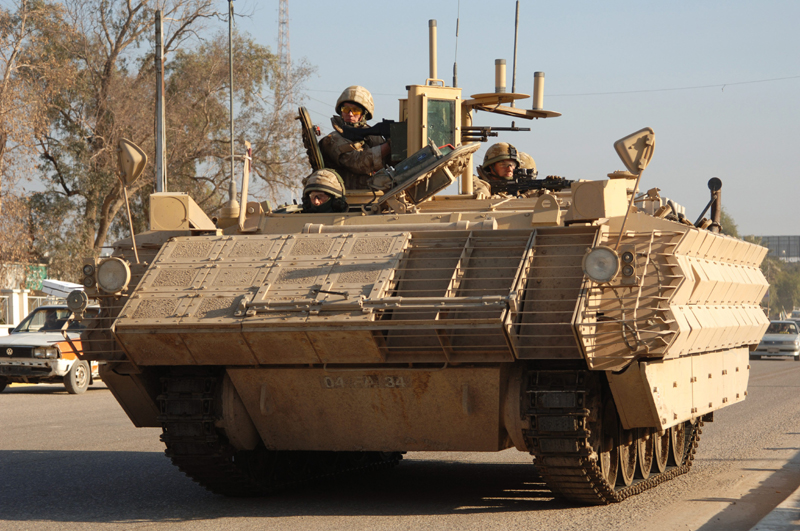
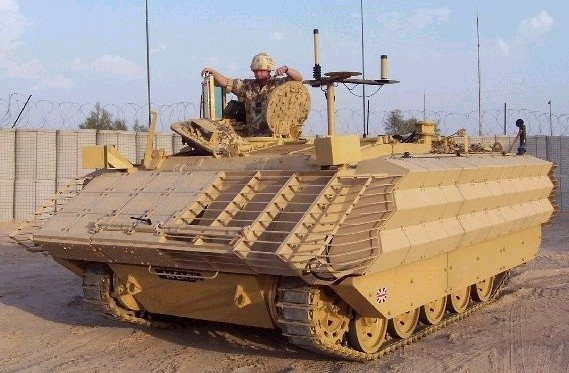
Deja Vu All Over Again, Part 2: American LIGHT Infantry CAN employ LIGHT tracked armor: here's an Air Assault unit in Iraq with M113A3 Super Gavins
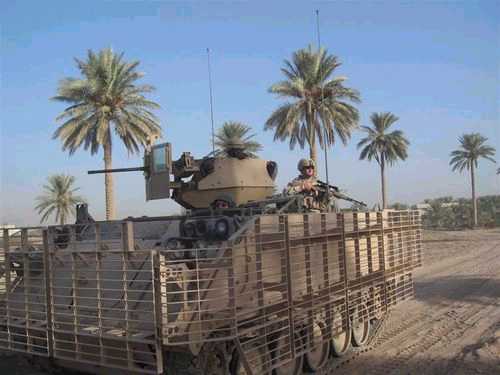
A M113A3 Super Gavin in Iraq with Company "A" 184th Infantry Battalion "Air Assault" light infantrymen in back....wow...how can they do this without months and months of new equipment training (NET)? They are not "mech" Soldiers...
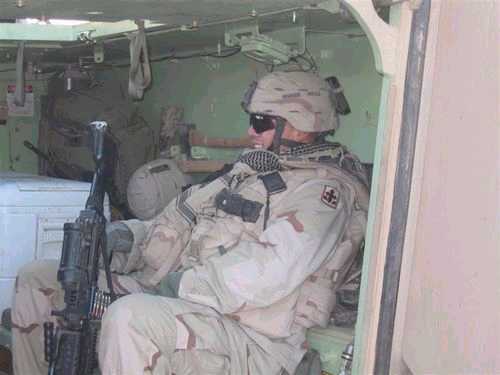
Notice the 29th Light Infantry Brigade patch on his shoulder....
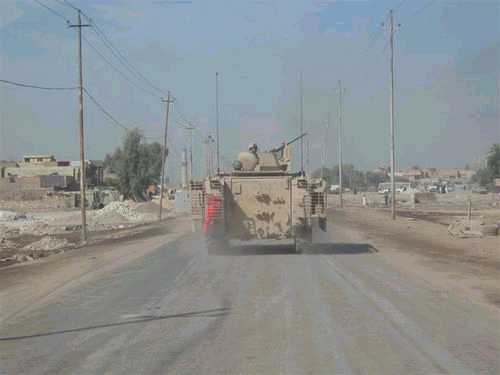
1. Steel tracks have RUBBER PADS so they DO NOT hurt paved surfaces ("I didn't know that, I was spending too much time in the gym calling heavy unit Soldiers 'mech pussies', sorry")
2. The M113 Gavin at 10.5 tons weighs the same as a FMTV 5-ton cargo capacity truck used by "LIGHT" units. What's heavier? 11 tons of tracks or 11 tons of truck? If you are a lightfighter narcissist the answer is easy: the tracks are heavier!
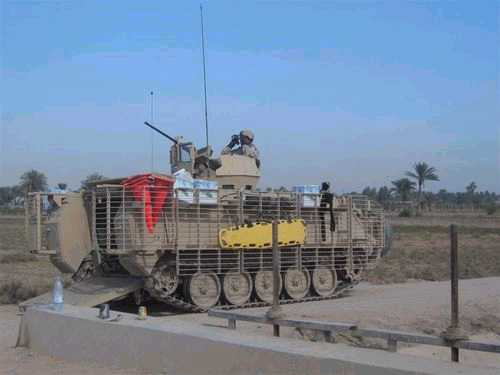
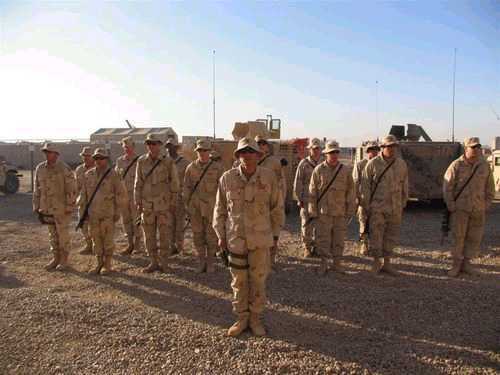
Photos from the Blog web site [http://thunder6.typepad.com] of CPT Danjel Bout, Commander of "A" Co, 1-184 IN (Air Assault), California Army National Guard that was assigned to the 3rd ID (M) in Iraq
So if a National Guard unit of light egomaniacs can operate a M113 Gavin OJT, so can active-duty light units...just like the 25th "Tropic Lightnings" did in Vietnam...so the question is, WHY WAIT for a war? After Vietnam, the 25th degenerated to its current foot slogging and death-in-a-wheeled-truck-on-a-road-itis....why not make M113 Gavin LIGHT tracks organic and permanently owned by the light infantry battalion's HHC and Delta Weapons companies in place of current vulnerable and road-bound wheeled trucks?
You can say we can just supply M113 Gavins ad hoc as needed to light infantry, but this misses the point the CHICOMs are not overlooking. IF YOU OWN THE LIGHT TANKS YOU CAN GET VERY GOOD AT USING THEM AND YOU CAN IMPROVE THEM WITH THINGS LIKE SHOOT ON-THE-MOVE AUTOCANNON. If we continue to pretend light infantry does not need light tanks we will get outgunned on the next battlefield, probably against the on-the-ball Red Chinese. Sort of like TF Smith in 1950 when American light infantry on foot and in trucks got their asses kicked by some clever orientals who were at least TRYING to be the best military force they could be.
We still have a long, long way to go to fully adapt the U.S. Army to the non-linear battlefield..our light units need M113 Gavins starting with Delta Weapons companies and supply & transportation units with XM1108 cargo carrying variants...we still have thousands of M113 Gavins in storage that need to be put into service....but it was at this moment that the tide finally turned against the wheeled madness threatening to destroy the U.S. Army and our Soldiers...
American Iraq War Casualties
www.geocities.com/militaryincompetence/americaniraqwarcasualties.htm
3D maneuver implies taking risks, but it does not mean driving around in Humvee/Stryker trucks is ok when you can have better protected, more mobile and better armed M113 Gavins and M8 Buford/Thunderbolt AGS light tanks.
Special Forces Need Armored 3D Maneuver: Fortune favors the bold.

www.nationaldefensemagazine.org/issues/2006/June/SpecialOpsGain.htm
Special Operators No Longer Travel LightBy Sandra I. Erwin and Stew Magnuson
Special operations forces are not what they used to be. Case in point is the growing use of heavy armored vehicles by SOF units, relates John G. Grimes, the Defense Department's chief information officer. The rapid spread of concealed roadside bombs and remotely detonated explosives as weapons of choice against U.S. forces means SOF troops can no longer deploy with just their suitcases, Grimes says. Now, they want Bradley and Stryker armored personnel carriers. "We are shocked at how the SOF community is looking for these hardened vehicles. Before they just would go out there and integrate with society. The whole structure is changing."
Neither the bloated Stryker or Bradley can fly by C-130 aircraft to achieve any kind of surprise or deep penetration missions required by SOF units, the M113 Gavin can. In fact, the M113 can be reduced to fit inside a CH-47 Chinook helicopter to do Air Assaults and SOF direct action/special reconaissance missions. The thing that makes us sick is that after its all over there will BE NO PERMANENT ORGANIZATIONAL CHANGES TO PERMANENTLY OWN AND OPERATE LIGHT TRACKS TO DO SOF MISSIONS. They are like their light infantry narcissists only "borrowing" armored vehicles to "get by" Iraq and as soon as Iraq is over will revert back to their stupid egomaniacs on foot and in trucks bullshit...even though many owe their LIVES to the M113 Gavin.
"Medium" also does not necessarily mean better than Light....if the design is poor
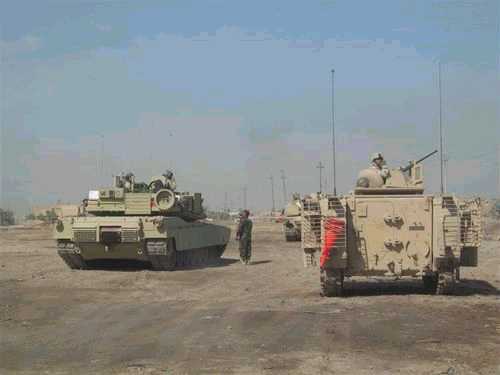
The 20+ ton LAV-III/Stryker is a medium-weight with lightweight armor, road-bound deathtrap on air-filled rubber tires that only a light and special narcissist egomaniac would somehow unprofessionally prefer because it doesn't have tracks so he won't like like a "mech pussy" that he's been bad mouthing in garrison for years.
The 33-ton Bradley needs its fuel tank removed from its center which fatally compromises its protection level. Its 1 inch thick base hull is thinner than the 10.5 ton M113 Gavin's 1.5 inch thick hull. The spaced laminate belts on the thin Bradley hull don't amount to much if all it takes is a small roadside bomb penetration into its fuel tank and the resultant fire and explosion finishes the job for the enemy. Rather than making excuses for the Bradley or praising its "icing" 25mm autocannon we should be demanding that the "cake" be fixed by removing its fuel tanks from inside the vehicle and placing them on the left and right rear like on the M113A3 Gavin.
Pics of "Pentagon Wars" USAF LTC Burton's improved Bradley with external fuel tanks:
www.geocities.com/armorhistory/infantrytanks.htm
Until this takes place, a smart, professional Soldier would rather fight from a M113A3 Super Gavin with high hardness steel all around, spall liners and anti-RPG bird cage WITH EXTERNAL FUEL TANKS than inside a curent Bradley. Above is a pic from Iraq of a light infantry unit in M113A3 Super Gavins working with M1 Abrams heavy tanks.
Another problem even with the Bradley's good shoot-on-the-move 25mm autocannon firepower, is that it does this while smothering the infantry in back who cannot fight with their heads out the top rear cargo hatch without the Bradley Master Gunner "Nazis" going beserk. Other armies can do it in their turreted infantry carriers, but not the U.S. Army! Its too hard for us to depress a turret over-ride button which has a reason for being there. Visibility and awareness of the enemy in the Bradley is limited to wherever the BC and Gunner are facing in the turret, instead of this tunnel-vision, I'd rather be in a M113A3 Super Gavin with several Soldiers looking out behind TAGS gunshields (IDF-like side shields need to be bought) to see potential enemy ambushers and shoot back first. Again, the fix on the Bradley is easy and available; replace the 2-man turret with a 1-man stabilized turret aimed by a helmet-mounted sight and tell the Bradley Master Gunner bureaucracy to go get a real military specialty instead of trying to play wannabe tank. Micro-TV cameras like the IDF uses on the Merkava III/IV and French Leopard 2 heavy tanks can also help the infantry in back contribute to the fight even if they have to be buttoned up do to explosions going off overhead.
The same 1-man stabilized autocannon turret that should fix the Bradley fleet should also go on selected M113 Gavins in the light infantry.
If we want to get the Saddams and Bin Ladens of this world we need to take risks and do 3D maneuver well--which means tracked tanks that can overcome both earthly and human opposition and keep moving. If they brush up against heavy tanks they can kill them and accomplish their mission. If you cannot fathom this, remember that light infantry without ANY main guns have killed more tanks in history than other tanks. The M8 Buford/Thunderbolt AGS light tank can either fire full-power 105mm or 120mm guns that easily kill all known heavy tanks. We do not accept the mental block that wants to deny this. Its time to wake up. If you sacrifice armor protection you can put a heavy tank main gun on a light tracked vehicle if it is large and arranged so it offers a stable firing position. What is the big deal? This is a fact. If you cannot accept this because you have made up your mind that heavy guns can only be used on heavy vehicles than the problem is in your mind not physical reality. You have put the heavy-gun-on-a-heavy tank-on-a-pedestal as the ONLY sound way of doing business, when its clearly not. There is no law that says we can only shoot heavy guns on heavy vehicles that have armor proof against other heavy guns. This is just one vehicle design philosophy that comes at heavy logistical costs and impaired mobility in soft soils ie; as an example the M1s that got stuck at JRTC during my rotation there 6 years ago, and a lack of strategic 3D air mobility: TF Hawk in Albania's slow build up of combat power. Choosing lighter tanks to execute 3D maneuver is a trade-off made to get unique results as Wilson would cite as the Sun Tzu "extraordinary" 3D force compliment needed for 2D forces. Yes, 3D has a lot of sex appeal over 2D forces. But you pay for it as many a sore back from parachute jumps on hard plastic canteens onto hard runways testifies. Maybe its just the way we do 2D maneuver that lacks style; maybe if all our 2D vehicles had ACAV gunshields and were populated by folks willing to take risks by unorthodox maneuvers (not be "death-before-dismount cowards") instead of waltzing in the open smugly acting like they are invincible, we would have more balanced distribution of "ego biscuits" for everyone involved?
Having light tanks/APCs is doing 3D well and reducing risks by greater combat power compared to troops on foot and in trucks. Its progress and for that we should be greatfull not looking for "clouds" in the "silver lining". We have plenty of wrongs in our Army to fix to have to start creating wrongs that are not there. The USMC is hopeless and should be disbanded and America should create a non-egotistical naval infantry similar to what the Russians have in BMD-3 light tanks.
Comprehensive Mechanization for Combat Forces Optimized for 2 Different Terrain Types
Retired Colonel Douglas Macgregor has often said that if combat tours were under 6 months Soldiers could live completely from inside their tanks and not need any forward operating base (FOBs), which is indeed what visionaries like Hobart and Simpkin have always advocated. We just are not there yet. Right now our armored vehicle designs are warmed-over WW2 configurations and cramped such that NBC reporter David Blum got a blood clot and died as an embed reporter during the invasion of Iraq in 2003. One has to get out and stretch one's legs and this means currently pitching a flimsy tent which neither protects nor does much to preserve Soldier fighting powers. FOBs composed of BATTLEBOXes will be needed to picket main supply routes of a force maneuvering from an allied nation operating base or a seaborne or airborne lodgement and for inland bases over time. However, maneuver forces should be able to operate indefinitely from their tanks if we would take the time and effort to make them capable of this self-sufficiency.
Protection
First you need enough space to lay down and sleep--space lacking now in the WW2 Tiger tank clone M1 Abrams tank which should be seen as the "FCS-2D" male tank for open terrain maneuver. We should get rid of its 30 ton weight turret and use an automatic loading external gun for STUG-style hull mounting which will bring the entire vehicle's weight down to under 50 tons making it a MEDIUM tank while still having heavy tank protection. All 4 crewmen live inside the hull. To make space, the 500 gallons of fuel are pushed to the outside rear in left/right external tanks like on the M113A3 Gavin. No fuel in the hull! A bunk or maybe two bunks are provided so Black crew can rest while Gold crew sleeps. A shower/toilet roomette is inside. Turbine engine is replaced by a diesel compression piston engine to improve fuel economy to 1 mpg for 500 mile range. If hybrid electric drive is used, range should increase to 1, 000 miles. Flex-Cells and 55 gallon drum "drop tank" capability organic.
The M2/M3 Bradley as the female tank for open terrain maneuver with the Abrams and the M113 Gavin which is the baseline "FCS-3D" light tank for 3D, closed terrain and air-mech maneuver already have troop space in the hull, albeit the inefficient 2-man turret on the Bradley needs to be replaced with a 1-man turret with the TC/G using helmet-mounted sighting means. An off-duty driver's sleep bunk and shower/toilet roomette are inside. Bradleys and Gavins should be hybrid-electric drive to double range to 600 miles. Flex-Cells and 55 gallon drum "drop tank" capability organic.
In all 3 vehicles, the men inside need not have to leave to do bodily functions yet can stretch out and not suffer from cramps or worse to effect 24/7/365 operations.
Energy
All Army tanks should have an ability to siphon hose suck fuel from enemy civilian and military vehicles when encountered whenever the opportunity arises. The ability to mix motor oil to gasoline to use it in diesel compression engines must be practiced. HED tanks should be able to recharge their batteries even if their diesel engines cannot work due to being broken or no fuel by plugging in to a wall socket.
Water
All Army tanks should have a ROWPU to get drinking water from any raw source as well as from the ambient air. Water storage tanks should be positioned to act as extra land mine blast protection.
Ammunition
All Army tanks should have "VULTURE" gun racks to fire co-axial to the hull captured enemy weapons as they are accumulated to exploit them and their captured ammo outside the hull where even if the ammo was booby-trapped it'd have no effect on our personnel. As we wade into the enemy, we gain strength from his own logistics.
Food
The last obstacle to complete mechanized self-sufficiency for 24/7/365 operations is food. While its true captured food could be eaten, its also easy for the enemy to poison it. Solid food is one thing that doesn't just come into existence and takes time and land surface area a military force maneuvering doesn't have the luxury of growing. For this need, we should look into RICE being able to cook it quickly inside our tanks and add protein from edible rations (not MREs) to enable long-term operations for weeks at a time without resupply or returning to the FOB.
Taiwan: M41D Light tanks ready to repel Red Chinese amphibious/airborne landings
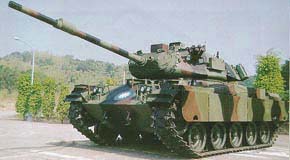
Another benefit of light tanks is their greater mobility in soft soil areas; Taiwan has upgraded 24-ton M41D Walker Bulldog tanks ready to repel possible amphibious/airborne invasions by the nearby Red Chinese communists.
www.fas.org/news/taiwan/1999/e-08-17-99-30.htm
REMODELED TANKS DISPLAY FIREPOWER IN CENTRAL TAIWAN
--------------------------------------------------------------------
Nantou, Central Taiwan, Aug. 17 (CNA) Fifty remodeled M41D tanks displayed their firepower and improved capabilities at a base in Nantou County's Chichi on Monday and Tuesday before an audience of some 1,000 local residents, lawmakers and reporters.
A public anti-tank live-fire exhibition was also held at the base with the purpose of promoting the public's understanding of the strength of the Republic of China Armed Forces.
The ROC Army first introduced the American-made M41 tanks in 1958. They have since become obsolete and have been replaced by the domestically produced M48H tank and used American-made M60A3 tank as the mainstay of the army's tank battalions.
Because Taiwan is unable to procure the most advanced tanks from the United States and other industrialized countries, the army decided in 1996 to improve the capabilities of 50 x M41s with a cost of NT$1.3 billion.
The remodeling project proved successful, and the tanks have now been converted to run on diesel and equipped with night vision battle devices. Their maximum range has also been extended from 160 kilometers to 470 kilometers.
According to army officials, the 50 remodeled tanks will be used on the offshore islands, while the M48H and M60A3 tanks will continue to form the backbone of the army's mechanized units for the foreseeable future. (By Victor Lai)
The Fisher Report: Beware of Red Chinese Airborne & Amphibious Light Tanks

AIRBORNE TANKS
EXCLUSIVE CHICOM BMD-2 LIGHT TANK PICS:
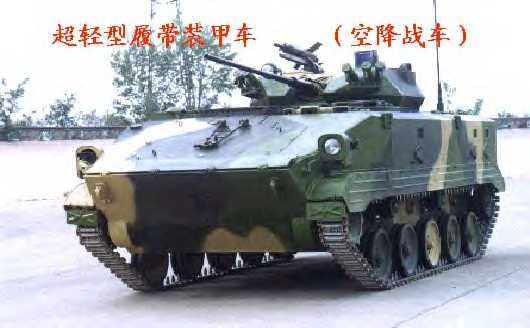
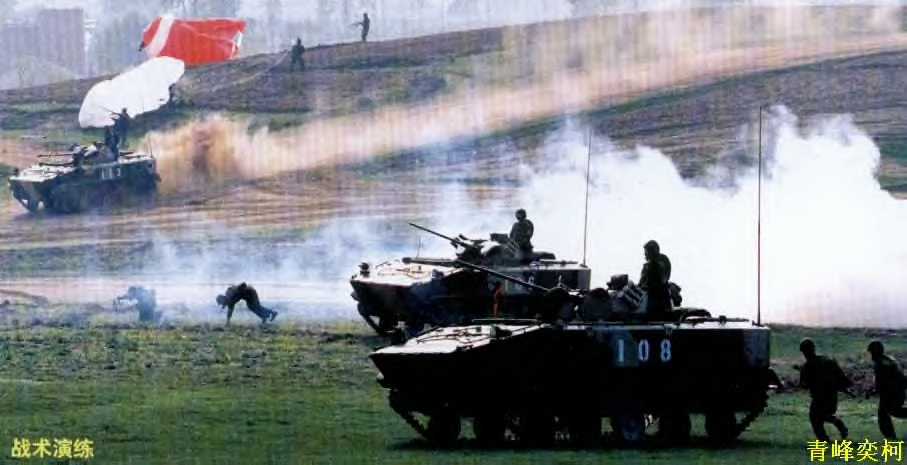
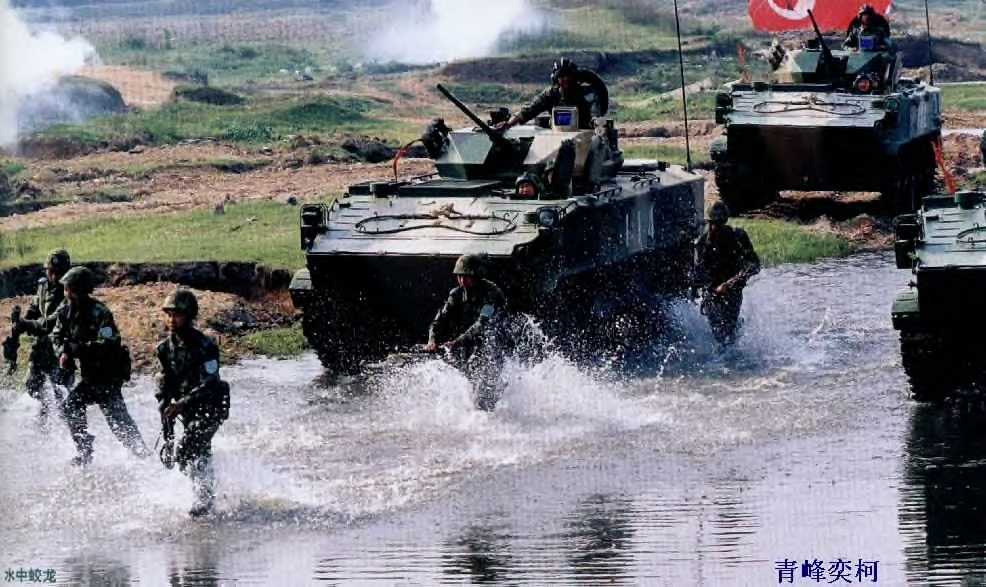
URGENT THREAT DEVELOPMENT! RED CHINA DEVELOPING THEIR OWN AIRBORNE TANK, THE ZLC-2000

CHICOM Air-Mech 3:00, BATTLEBOXes 5:00
www.youtube.com/watch?v=IafBYvu5UBo
Jane's September 2005 Land Forces Reports:
www.janes.com/defence/land_forces/news/jdw/jdw050923_1_n.shtml
"The Chinese People's Liberation Army (PLA) is testing an airborne assault vehicle (AAV) with a chassis similar in some respects to the Russian BMD series of AAV in service with the Russian Army.
The basic component of the new Chinese family of AAVs is an infantry fighting vehicle (IFV), which has the designation ZLC-2000. This is fitted with a one person turret armed with a 30 mm dual-feed cannon, 7.62 mm co-axial machine gun and a roof-mounted Red Arrow 73C anti- tank guided weapon (ATGW) with an enhanced guidance system.
In addition to the IFV, which is also referred to by some sources as an airborne tank, a complete family of support vehicles are also being developed on the same chassis. The first two variants are command and control and a tank destroyer. The former has a higher roofline allowing greater internal volume for its specialist role. The tank destroyer is armed with the more recent Norinco HJ-8 (Red Arrow 8) ATGW, which has been in service with the PLA for some years and has a maximum range of 4,000 m."
www.strategycenter.net/research/pubID.63/pub_detail.asp
Chinese Revelations
New Airborne Tank
In early 2005 there was a brief CCTV glimpse of what appeared to be a new lightweight tank for the PLA Airborne Army. Then in mid-February a Chinese military magazine also revealed a clearer view of a new airborne IFV, reportedly designated the ZLC-2000. At IDEX a Norinco official confirmed for the first time that indeed the PLA does have a new lightweight airborne tank. The official explained that China had first approached Russia to co-produce a version of the BMD airborne tank. China reportedly purchased a small number of BMD airborne tanks in the mid-1990s. However, the Russians charged too much, forcing China to develop its own new airborne tank. This program took at least five years. The Norinco official was vague about the weight of the tank but said it was "around" 10 tons. It is also made in at least three versions: command and control; IFV; and ATGM carrier. The command and control version features a higher rear hull section to house personnel. The IVF version is armed with a turret that combines a 30mm cannon with the Type-73C anti-tank guided missile. The dedicated ATGM carrier is armed with the HJ-8 ATGM. This tank is amphibious. The production of a new airborne tank will serve to strengthen the power-projection capability of the PLA Airborne Army, and may be an indication that as per previous reports, China may also be building a second airborne army.
ZLC-2000 ABN Tank
Weight: @10 tons
IFV version: 30mm gun, up to 350 rounds, AP, HE, plus Type-73C semi-active guided ATGM, 3000m range.
ATGM version: w/ HJ-8 ATGM, 4000m range
Command Version
Photo: Internet source
THE IMPACT OF FOREIGN WEAPONS AND TECHNOLOGY ON THE MODERNIZATION OF CHINA'S PEOPLE'S LIBERATION ARMY
A Report for the U.S.-China Economic and Security Review Commission
January 2004
by Richard D. Fisher, Jr.
Center for Security Policy
While we are fumbling instead of adapting and getting stronger from Iraq, Red China is putting together a dangerous Surveillance Strike Maneuver Capability to do nation-state warfare with a sophistication of fire, maneuver and deception we are not even close to matching.
We better get our heads out of our asses and stop our "RMA Jesus" mental computer crap and start building for decisive 2D/3D air/ground PHYSICAL maneuver using our existing M113 Gavin light tanks.
Details: www.geocities.com/strategicmaneuver
DISTURBING EXCERPTS FROM THE FISHER REPORT
www.uscc.gov/researchreports/2004/04fisher_report/9armysystems.htm
Russian BMD-3 or BMD-1P Airborne Combat Vehicle
Status: reported sale to Chinas Airborne forces around 1995
Weight: BMD-3, 13.2 tons; BMD-1P, 8 tons
Performance: BMD-3, speed, 71 km/h, range, 500 km, can carry up to 5 extra soldiers; BMD-1P, speed, 61 km/h, range 500 km, can carry up to 6 soldiers
Armament: BMD-3: 4x AT-4/AT-5 anti-tank missile, 1x 30 mm gun with up to 500 rounds, 1x 7.62 mm machine gun, 1x 5.45 mm machine gun; BMD-1P, AT-3/ AT-4 anti-tank missile, 1x 73 mm gun with 50 rounds, machine guns; BMD-3M: 1x 100mm gun, w/ 18x unguided and 4x ARKAN missiles w/ 5.5km range; 1x 30mm gun w/ 350 rounds
A 1997 report out of Hong Kong noted that since 1995 the PLA Airborne forces had been equipped with a paratroop combat vehicle...light tank...12 metric tons...uses anti-tank bombs...large-caliber artillery...used to be exclusively owned by Russias paratroops.... [20] While the combat weight mentioned in this article is less than but closer to the BMD-3, the mention of the large-caliber gun also raises the possibility the PLA purchased the older BMD-1P. Both BMD models are amphibious and three can be airdropped from an Il-76 heavy transport. Russians did not like the BMD-1 inasmuch as it tended to break down in rough terrain.[21] The latest version offered by Russia is the BMD-3M, which incorporates a smaller and lighter version of the 100mm gun and missile launcher used on the BMP-3.
While it is not possible from available information to confirm the exact type of BMD employed by the PLA Airborne forces, it logical to speculate that the PLA will be buying more of the most recent BMD-3M version if, as recent reports indicate, the PLA is in the process of forming another Airborne army to build up for possible conflict over Taiwan.[22] In the BMD the PLA Airborne forces received a significant increase in combat capability by providing them with a respectable light-weight infantry fighting vehicle. But even more than that, should the BMD-3M version be acquired then PLA Airborne forces will immediately have a tank gun that can out-range Taiwans tanks and handily penetrate their armor. The ability of the ARKAN missile to shoot down helicopters only further complicates Taiwans defensive response.
VIDEOS:
www.youtube.com/watch?v=XMus7Z6Maes
www.youtube.com/watch?v=0-TECFtCeSo
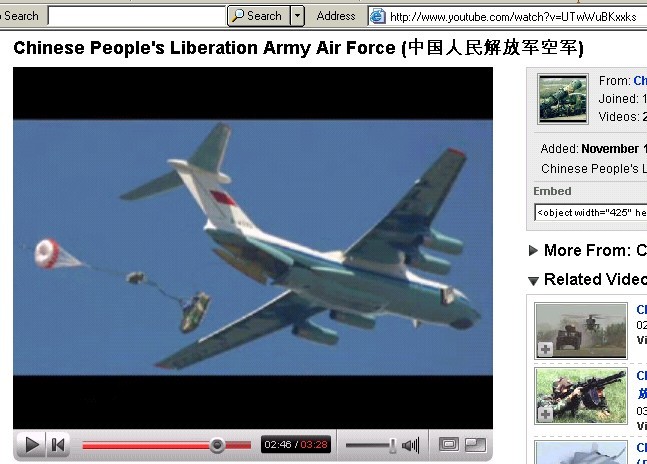
While we are goofing off in occupying Iraq wasting $1B a week and "self-validating" ourselves as fantasy "combat veterans" chasing sub-national conflict rebels when not getting ourselves blown in wheeled trucks by their land mines awaiting us roads we cannot avoid, the CHInese COMmunists (CHICOMs) are IMPROVING THEIR NATION-STATE WAR CAPABILITIES ONTO TRACKED PLATFORMS THAT CAN GO CROSS-COUNTRY AND FIGHT-TO-WIN while we are pissing our money away on combat pay and wheeled trucks and getting weaker.
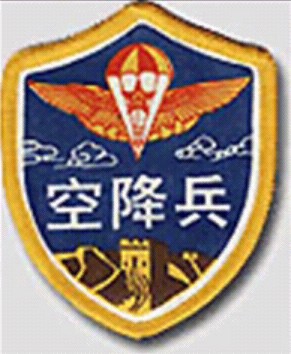
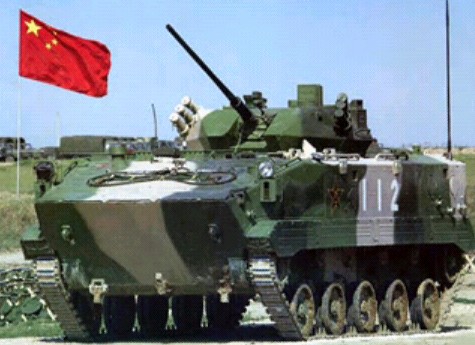
The Chinese 15th Airborne Army is a most alarming force clearly geared to dropping into Taiwan and battling in URBAN terrain possibly to take-out their air force by destroying their air fields; with ZLC-2000 light tanks/APCs with autocannon and armor protection they can maneuver cross-country after parachute airdrop insertion in the face of enemy small-arms fire and would be unstoppable against mere Air Force security police; once on the ground and the damage is done to runways the Taiwanese Air Force is finished even if any of their birds are left intact.
YOUTUBE user cuteftpster writes:
"Unlike U.S. 101st and 82nd airborne divisions, PLA 15th Airborne Army is not under PLA Army but PLA Air Force. The 15th Airborne Army is one of PLA fast responsing troops and can be deployed in any place of China in 48 hours. 15th Airborne Army has owned IL-76 airlift and air-dropped combat vehicles, which were once displayed in Russia-sino 'Peace Mission 2005' joint drill."
Air-Mech
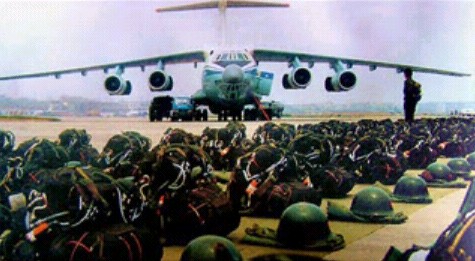
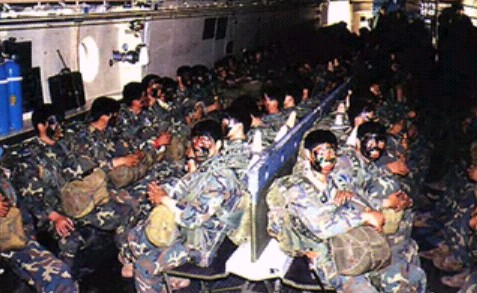
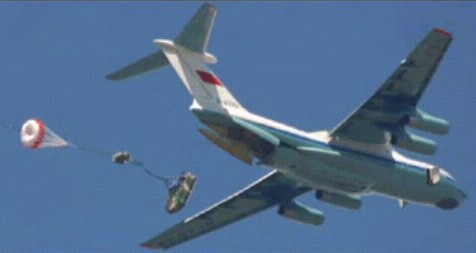
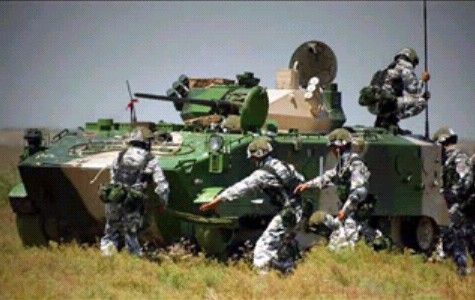
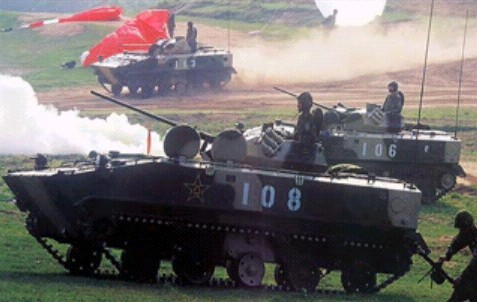
Rural Area Operations
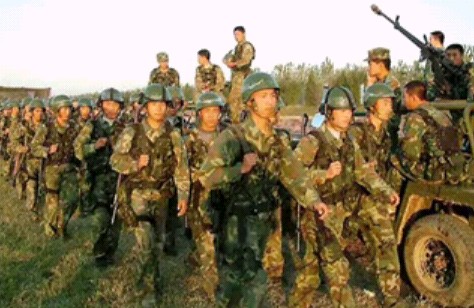
Camouflage is better here but no cloth strips to break up helmet and body outlines.
Urban Combat Emphasis
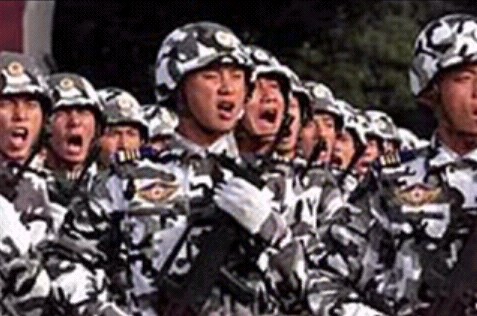
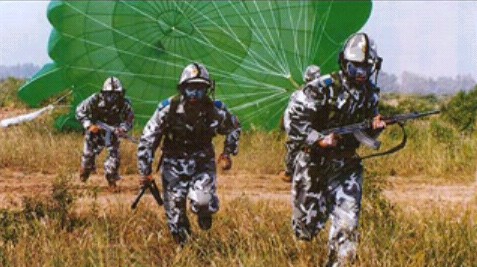
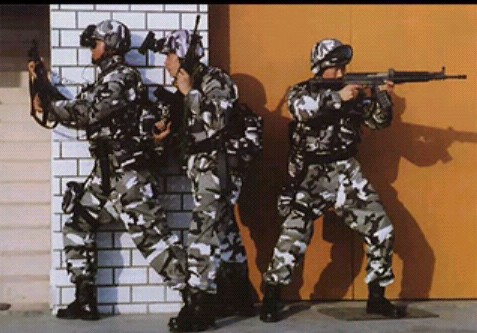
Note the somewhat effective dubious "urban camouflage" they are wearing and the shoot-around-a-corner feature of the automatic rifle the point man is using.
Mysterious CHICOM Paragliders
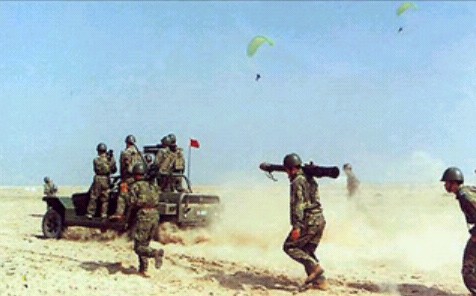
Are these 8-to-1 glide ratio paragliders that have deployed from aircraft to enable men to insert from longer ranges than our 3-to-1 glide ratio square ram-air parachutes?
Or are these POWERED paragliders as recon flying machines whose back-pack power units are just not visible in the distance in the photo?
Smothering Enemy Infantry with Man-Portable Automatic Grenade Launcher Fire
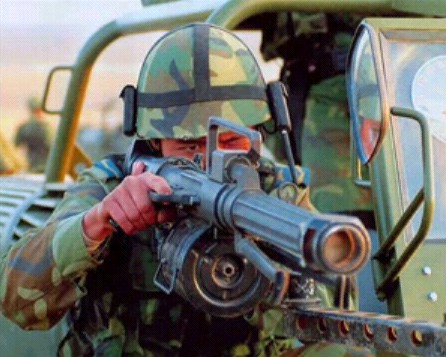
The CHICOMs clearly understand the dynamics of foot infantry being exposed to high explosives bursts and have decentralized man-portable W87 automatic 35mm grenade launchers to smother and pin-down their foes; who could be typical American foot sloggers flown into Taiwan from Hawaii.
American Triumphalism that All is well when its Really Not
This video game simulation above portrays smugly that if we fight Red China say on a Taiwan, that we are going to have the entire arsenal of America's military at our disposal; NOT TRUE.
If Red China strikes Taiwan we will not have the time to fly in one-C-17 at-a-time ANY M1 Abrams 70-ton heavy tanks or 2 Bradley fighting vehicles at-a-time by C-17 especially if THERE ARE NO AIRFIELDS intact; we will have to PARACHUTE DROP men WITHOUT ANY ARMORED VEHICLES; even quasi-armored Humvee and Stryker trucks are not airdroppable (breaks their suspensions). Our men will have to fight on foot at a severe qualitative disadvantage against a numerically superior (quantitative) CHICOM force. THIS IS TOTALLY FUCKED UP AND THE RESULT OF OUR BULLSHIT LIGHT INFANTRY NARCISSISM. If we are going to be narcissists at least do that right; ALL American light infantry should be Airborne school graduates so in a pinch they could be parachuted in because there's no guarantee the Air Force can find a stretch of road to STOL airland their C-130s and C-17s to work around our lack of force deployment martial vigor.
We clearly need to get our heads-out-of-our-wheeled-truck-asses IMMEDIATELY and supply C-130 air-transportable, M113 Gavin light armored fighting vehicles to our LIGHT INFANTRY brigade combat teams outfitted with 30mm stabilized autocannon on remote weapon systems so we can withstand possible CHICOM high explosive shell and grenade fragment fire and not get pinned down unable to move if we are flown in to defend Taiwan. Gavins can also be fitted with back hoes so what we hold we keep holding by rapid entrenching capabilities.
AMPHIBIOUS TANKS
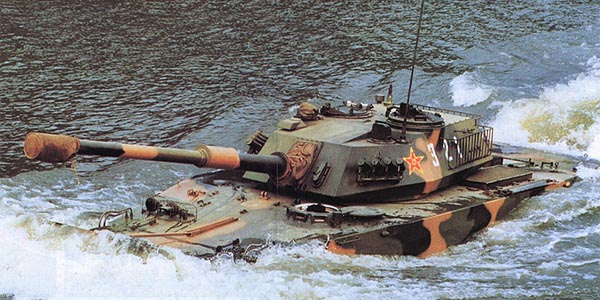




The CHICOM Type 63A amphibious tank (amphitank) is a 105mm gun, shoot-on-the-move light tank that can SWIM ITSELF FROM MAINLAND CHINA TO THE TAIWANESE ISLANDS AND THEN TO TAIWAN ITSELF. Powered by waterjets the CHICOM amphibious divisions could swarm all over Taiwan before her non-swimming tanks could be air or ship delivered to outlying islands. A simultaneous Airborne-Amphibious Light Tank invasion of Taiwan and her islands could overwhelm the tiny country before American forces could react--UNLESS WE STOP PLAYING WITH STRYKER TRUCKS AND IMMEDIATELY BOLSTER THE 25th INFANTRY DIVISION WITH OUR OWN C-130/C-17 AMPHIBIOUS GAVIN LIGHT TRACKED TANKS A-S-A-P.
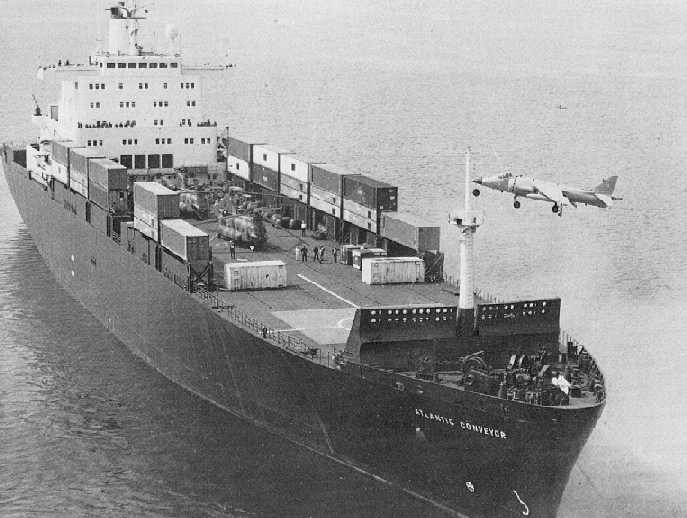
The British have already taken container ships to war in the Falklands in 1982. Snobby navies like the U.S. Navy want handfuls of custom-made "warships" and don't realize in war SIZE counts.
The author below doesn't seem to know that its possible to offload container ships without having to seize container cranes at a port. He doesn't know about FASTship or SCADS, either but he's right on target with how container ships can be made into aircraft, troop and tank carrying ships.
www.americanthinker.com/2005/04/chinas_container_ship_fleet_an.html
April 11, 2005China's container ship fleet and Taiwan's security
By Frederick W. Stakelbeck, Jr.
China is busily building a fleet of the largest container ships the world has ever seen. That is a boon for its export trade and economic efficiency. But like the Trojan Horse of ancient Greek civilization, the fleet could potentially be used by China in a spectacular, lightening invasion of Taiwan. Could the hollow hulls and empty decks of Chinese container ships carry infantry and mechanized divisions for a devastating attack on Taiwan, securing the island before the U.S. could respond?
The thought of mammoth Chinese container ships carrying an amphibious invasion force across the Strait of Taiwan is certainly frightening. But the capability for just such an invasion is slowly being put in place.
The Chinese have plans to build several 90,000 ton-plus container ships capable of carrying 8,530-TEUs [EDITOR: 20 foot long shipping containers] (Twenty Feet Equivalent Units).* In an agreement announced in November 2004, Chinese shipbuilder Hudong-Zhonghua Shipbuilding (Group) Co., Ltd. announced it will deliver 4-5 of the giant container ships to the China Shipping Group by October 2008. When completed, the new ships will surpass the Republic of Korea's 8,000-TEU as the largest container ships in the world.
Supplementing increased construction and advances in the container ship industry have been developments in China's amphibious capabilities. The People's Liberation Army Navy (PLAN) is building amphibious ships at a breakneck pace. The ships include nine large Yuting 072- II class LSTH; the Yunshu class LSM; a new 64 meter LCU; a number of medium landing ships; and the construction of LSDs and LPDs with flight decks for attack helicopters.
Solidifying China's stranglehold on the world's merchant fleet is the country's rapid ascension as a world leader in commercial ship repair and conversion services. These complex projects can now be completed at a number of shipyards throughout China. Its largest ship repair organization, the China Ocean Shipping Company (COSCO) Shipyard, operates the Nantong shipyard near Shanghai, which is increasingly handling tanker, container and bulk carrier repairs and conversions. Separately, the Dailan and Guangzhou shipyards, among the country's largest repair facilities, also expect rapid growth and increased investment in the near future.
The largest producer of ship containers in the world is also a Chinese company. China International Marine Containers (CIMC) ranks as the world leader in container manufacturing, with over 40 percent of the international container market. These containers can be custom built to specifications with louvered vents and electric power added to make a working, livable environment that is virtually sound-proof. Containers can also be armored and include partitions to conceal individuals or large items.
Entranced by economic opportunity, the Taiwanese are inadvertently making a possible Chinese container ship invasion a reality. In May 2004, ground was broken for construction of the first container center at the Port of Taipei. The new center is expected to save several hundred million dollars in transport costs and make the port an attractive location for investment. Located at the mouth of the Danshuei River in northern Taiwan, the Port of Taipei is one-hundred and thirty-four miles from Fuzhou Harbor in mainland China.
Further improvements to the Port of Taipai's transportation infrastructure are scheduled for completion in 2008 - the same year that the last of the great 90,000 ton container ships will be delivered to the China Shipping Group. Included in these improvements will be the completion of the Bali-Wugu section of an east-west expressway. This will allow for the easy transport of containers from the Port of Taipei via the expressway, or a link with Chiang Kai-shek International Airport via the West Coast Highway, which is currently being widened.
A Chinese invasion of Taiwan has been compared by some to the allied invasion of Normandy and McArthur's landing at Inchon during the Korean War. The D-Day Normandy invasion of 1944 transported 176,000 amphibious troops; used three airborne divisions; 10,000 aircraft, 136 warships, 3,000 landing craft and 2,000 support ships. Available intelligence reports suggest that the Chinese can assemble 15,000 amphibious troops, three airborne divisions, 3,300 aircraft, 60 warships and 300 landing craft for an invasion of Taiwan. In addition, a support force of 50,000 ground troops of the Chinese 31st Army Group now deployed at the Nanjing Military Region could be made available for an invasion with another 250,000 troops loaded onto container ships for an assault on Taiwan. According to Wang Jisi, Director of the Chinese Institute of Strategy at the Central Party School, "the danger of war truly exists. We are not a paper tiger. We are a real tiger."
In theory, a covert assault using Chinese container ships is possible. But like the Normandy invasion, most, if not all, of the operational and contingency planning involved in such a large-scale amphibious invasion would have to be precise and error-free. A fleet of container ships would have to unload men and material in an extremely fast, cohesive manner, probably under constant fire from Taiwanese ground, navel and air forces.
Loading docks in the Port of Taipei would need to be cleared for immediate military offloading operations. Major roads leading out of the port would have to be secured by airborne units of the Chinese 43rd, 44th and 45th divisions or advance units of a special operations force (SOF) attached to the invading amphibious force.
Once secured, the port would require continuous patrolling to propel a retaliatory naval or air assault on container ships unloading at the port. Air cover using a combination of attack helicopters and fighters from the decks of ships in port or from airfields secured by Chinese airborne units would be necessary. The imposition of a rigorous naval shield using China's fleet of diesel and nuclear powered submarines would be needed to diminish threats from the United States and its allies.
French Exocet SM-39 anti-ship missiles known as "carrier killers," 3M-80 Moskit Sunburn missiles, developed by the Chinese specifically to defeat the U.S. Aegis air-defense system, or cruise missiles launched from Russian-made Su-30 fighters could also be used to attack U.S. assets in the Pacific. Deployed on submarines, fighters, frigates, or mainland China, cruise missiles could inflict considerable damage and innumerable casualties on U.S. Naval Forces in the early hours of a conflict. This would effectively mitigate an overwhelming response from the U.S. and prompt a tactical regrouping of U.S. forces for a coordinated counteroffensive that could take several weeks or months to organize.
A southern Chinese invasion force made up of container ships and Chinese naval support ships could land near the ancient city of Tainan situated on the southwestern coastal plains of Taiwan. As one of the island's largest cities with a population of approximately 700,000 residents, Tainan's transportation system includes a major airport that, if secured by Chinese airborne units, would allow for accelerated troop movements north. The Tainan Airport, a public facility as well as an air base, is well-known to Chinese military strategists. Railway lines and highways leading north to Taipei already exist and are large enough to handle large supply trucks, tanks and armored vehicles.
Adding credibility to the hypothesis of a possible Chinese container-based invasion of Taiwan, the United States itself is now considering using container ships in support of naval operations, and plans to explore the conversion of container ships for military purposes. Working with Maersk Line Ltd., the U.S. Navy is considering its Maritime Prepositioning Force (MPF) Future Program with a modified S-class commercial container ship. The 1,140 feet long ship is designed to offload cargo for 6,000 troops and maintain a flight deck for the V-22 Osprey tiltrotor aircraft. Working with architectural firm Gibbs & Cox and ship conversion company Norshipco, the proposed ship will be outfitted with ramps, a loading platform and stern and bow thrusters. Construction is scheduled to begin in 2007. Hovercrafts would be used to deliver cargo to shore.
China has embarked on a determined mission to surpass both Japan and South Korea as the world's leading shipbuilder. The Chinese can now offer state-of-the-art shipbuilding, repair and conversion services as a result of increased domestic and foreign investment in maritime modernization projects. With improved shipbuilding production methods, modern capital equipment for its shipyards, and significant progress in the areas of ship design, China's shipbuilding industry deserves the attention of the U.S. and its Pacific allies as a possible national security threat.
Would China undertake a container-based invasion of Taiwan? This is an intriguing question which merits our attention as China approaches superpower status.
_________
*The unit TEU (twenty-foot equivalent unit) is used to express the relative number of containers based on the equivalent length of a 20' container. For example, 100 containers of 20' is 100 TEUs, while 100 containers of 40' is 200 TEUs, Export 911,
www.export911.com/e911/ship/conShip.htm.
Frederick W. Stakelbeck, Jr., is a freelance journalist residing in Philadelphia
It looks like Red China will invade Taiwan when time is right.
The western part of Taiwan is flat and rolling with an eastern mountainous spine. Notice where the have stupidly placed their air bases within easy reach by CHICOM missile/rocket artillery and air strikes.
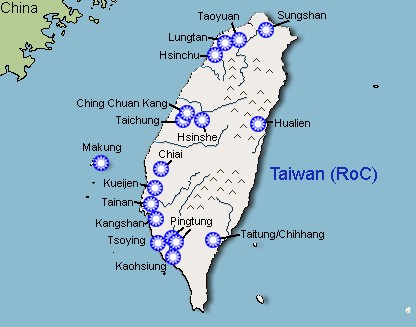
If Red China invades and we fly in light troops on foot with Stryker/other trucks we believe we will not just have a TF Smith type debacle we will relive the Bataan/Corregidor disaster; surrounded and running out of food/water/ammo. Furthermore, without armor protection and with their rubber tires shot out and set alight, light troops will have to hunker down and dig in to survive the merciless artillery, mortar and air strikes the CHICOMs would deliver from their surveillance strike complex. The CHICOMs will pause and say "America get out of Chinese affairs" and let us evacuate; we might be wrong they might annihilate the survivors or take them prisoner for awhile.
So, no we don't buy the light infantry-in-wheeled-trucks "horse cavalry" despite-reality deja vu all over again mentality.
But we do think a light TRACKED armored fighting vehicle equipped light infantry could keep a shell game going of a mobile defense along the mountain-blocked eastern half of Taiwan and maintain at least local air superiority for air resupply to hold off the Reds from taking the eastern half of the island. If we do that, we might be able to convoy sealift ships with food to keep the Taiwanese civilians from starving.
While China gets ready, we play with Stryker trucks in Iraq and waste $1B a week there...the same mistake the British/French did in 20s/30s...deceive selves that all is well with their militaries chasing rebels and when the mortal nation-state German enemy appeared they almost ceased to exist. America was there to save them...
To paraphrase Fred Kagan, who will or can save America this time around?
1. Red China has airdroppable light tanks and amphibious tanks ready to overwhelm Taiwan:
This web site: www.geocities.com/armorhistory
We better get our own air-transportable M113 Gavin and M8 Buford/Thunderbolt AGS tracked light tanks into the 25th ID in Hawaii and stop playing around with Stryker trucks that cannot fight.
2. We are wasting precious time/funds on wheeled FCS and other fantasies
The future of tracked tanks? there is no future if current Army officials have their way---we will be incinerated in wheeled trucks when our situational awareness fails. FCS will be cancelled and the light narcissist Army will want more Strykers as consolation "booby" prize. Even the marines are botching amphibious infantry carrying tanks with the Expeditionary Force Vehicle (EFV) fiasco created by the corrupt, incompetent, greed-o-philes at GDLS---the same corporate cronies who foist Canadian-made Stryker trucks crammed full of "mother may I?" computerized parental gadgets upon our Army. Kiss America goodbye then because we cannot confront nation-state armies like Red China in trucks--we need air deployable tracked TANKS.. It could be TF Smith, Operation Starlite and Blackhawk Down!---all over again! We cannot get Bin Ladens by being taking forever to deploy using trucks that need slow amphibious and sealift ships and once we are there are restricted to roads/trails the enemy terrorists can simply avoid.
3. Emergency Corrective Measures needed to adapt to Non-Linear Warfare NOW
If the Army was serious about transforming quickly and effectively to combat readiness we'd take the over 2,000 made in America M113 Gavin tracks we have in storage and upgrade them:
Convert M113 Gavins from A2 to A3 with bigger 300-400 hp diesel engines $150K
or:
A2 to 500 hp Hybrid Electric Drive/band tracks $200K
Stretch hull to MTVL to carry 15 men instead of 11 $50K
Add ceramic, high hard steel, ceramic, spaced, ERA and TAGS gunshields $200K
1-man 20-40mm autocannon turret $150K
C4ISR computers/screens $1M
_____________________________________________________________
150K to $1.6M per M113 Gavin still 1/3 cost of inferior Stryker truck!
Another $1M option would be to add waterjets and new nose so become "Amphigavins" that can swim from sealift ships to shore. Suggest this for combat engineers.
BAE/UDLP says they can upgrade two vehicles per day = so 730 per year = 1,560 M113A3/4 Gavins in two years = enough to outfit every light infantry battalion Delta Weapons company 35 x Gavins to give A, B and C companies armored mobility! (12 Brigades in need)....this leaves in first year over 300 x Gavins that should be converted to XM1108 Armored Resupply Carriers for the 12 light brigades to have armored, go-anywhere resupply capabilities. In the first 6 months of 3rd year another 500 XM1108 Gavin resupply carriers would be added.
The Army must be forced to adapt using M113 Gavins in the present to buy us time to cancel FCS and start up a future TANK R&D program. We can supplement these Gavins with M8 Buford/Thunderbolt/Tracer AGS light tanks for male/female tank synergism thru a cavalry squadron in every light brigade. We need these capabilities NOW in Iraq, Afghanistan and in case war breaks out with Red China over Taiwan.
www.washingtonpost.com/wp-dyn/articles/A45056-2005Apr11.html
China Builds a Smaller, Stronger Military Modernization Could Alter Regional Balance of Power, Raising Stakes for U.S.By Edward Cody
Washington Post Foreign Service
Tuesday, April 12, 2005; Page A01BEIJING -- A top-to-bottom modernization is transforming the Chinese military, raising the stakes for U.S. forces long dominant in the Pacific.
Several programs to improve China's armed forces could soon produce a stronger nuclear deterrent against the United States, soldiers better trained to use high-technology weapons, and more effective cruise and anti-ship missiles for use in the waters around Taiwan, according to foreign specialists and U.S. officials.
In the past several weeks, President Bush and his senior aides, including Defense Secretary Donald H. Rumsfeld, Secretary of State Condoleezza Rice and Director of Central Intelligence Porter J. Goss, have expressed concern over the recent pace of China's military progress and its effect on the regional balance of power.
Their comments suggested the modernization program might be on the brink of reaching one of its principal goals. For the last decade -- at least since two U.S. aircraft carrier battle groups steamed in to show resolve during a moment of high tension over Taiwan in 1996 -- Chinese leaders have sought to field enough modern weaponry to ensure that any U.S. decision to intervene again would be painful and fraught with risk.
As far as is known, China's military has not come up with a weapon system that suddenly changes the equation in the Taiwan Strait or surrounding waters where Japanese and U.S. forces deploy, the specialists said. China has been trying to update its military for more than two decades, seeking to push the low-tech, manpower-heavy force it calls a people's army into the 21st-century world of computers, satellites and electronic weapons. Although results have been slow in coming, they added, several programs will come to fruition simultaneously in the next few years, promising a new level of firepower in one of the world's most volatile regions.
"This is the harvest time," said Lin Chong-pin, a former Taiwanese deputy defense minister and an expert on the Chinese military at the Foundation on International and Cross-Strait Studies in Taipei.
U.S. and Taiwanese military officials pointed in particular to China's rapid development of cruise and other anti-ship missiles designed to pierce the electronic defenses of U.S. vessels that might be dispatched to the Taiwan Strait in case of conflict.
The Chinese navy has taken delivery of two Russian-built Sovremenny-class guided missile destroyers and has six more on order, equipped with Sunburn missiles able to skim 4 1/2 feet above the water at a speed of Mach 2.5 to evade radar. In addition, it has contracted with Russia to buy eight Kilo-class diesel submarines that carry Club anti-ship missiles with a range of 145 miles.
"These systems will present significant challenges in the event of a U.S. naval force response to a Taiwan crisis," Vice Adm. Lowell E. Jacoby, director of the Defense Intelligence Agency, told the Senate Armed Services Committee in testimony March 17.
The Nuclear Deterrent
Strategically, China's military is also close to achieving an improved nuclear deterrent against the United States, according to foreign officials and specialists.
The Type 094 nuclear missile submarine, launched last July to replace a trouble-prone Xia-class vessel, can carry 16 intercontinental ballistic missiles. Married with the newly developed Julang-2 missile, which has a range of more than 5,000 miles and the ability to carry independently targeted warheads, the 094 will give China a survivable nuclear deterrent against the continental United States, according to "Modernizing China's Military," a study by David Shambaugh of George Washington University.
In addition, the Dongfeng-31 solid-fuel mobile ballistic missile, a three-stage, land-based equivalent of the Julang-2, has been deployed in recent years to augment the approximately 20 Dongfeng-5 liquid-fuel missiles already in service, according to academic specialists citing U.S. intelligence reports.
It will be joined in coming years by an 8,000-mileDongfeng-41, these reports said, putting the entire United States within range of land-based Chinese ICBMs as well. "The main purpose of that is not to attack the United States," Lin said. "The main purpose is to throw a monkey wrench into the decision-making process in Washington, to make the Americans think, and think again, about intervening in Taiwan, and by then the Chinese have moved in."
With a $1.3 trillion economy growing at more than 9 percent a year, China has acquired more than enough wealth to make these investments in a modern military. The announced defense budget has risen by double digits in most recent years. For 2005, it jumped 12.6 percent to hit nearly $30 billion.
The Pentagon estimates that real military expenditures, including weapons acquisitions and research tucked into other budgets, should be calculated at two or three times the announced figure. That would make China's defense expenditures among the world's largest, but still far behind the $400 billion budgeted this year by the United States.
Projecting Force to Taiwan
Taiwan, the self-ruled island that China insists must reunite with the mainland, has long been at the center of this growth in military spending; one of the military's chief missions is to project a threat of force should Taiwan's rulers take steps toward formal independence.
Embodying the threat, the 2nd Artillery Corps has deployed more than 600 short-range ballistic missiles aimed at Taiwan from southeastern China's Fujian and Jiangxi provinces, according to Taiwan's deputy defense minister, Michael M. Tsai. Medium-range missiles have also been developed, he said, and much of China's modernization campaign is directed at acquiring weapons and support systems that would give it air and sea superiority in any conflict over the 100-mile-wide Taiwan Strait.
But the expansion of China's interests abroad, particularly energy needs, has also broadened the military's mission in recent years. Increasingly, according to foreign specialists and Chinese commentators, China's navy and air force have set out to project power in the South China Sea, where several islands are under dispute and vital oil supplies pass through, and in the East China Sea, where China and Japan are at loggerheads over mineral rights and several contested islands.
China has acquired signals-monitoring facilities on Burma's Coco Islands and, according to U.S. reports, at a port it is building in cooperation with Pakistan near the Iranian border at Gwadar, which looks out over tankers exiting the Persian Gulf. According to a report prepared for Rumsfeld's office by Booz Allen Hamilton, the consulting firm, China has developed a "string of pearls" strategy, seeking military-related agreements with Bangladesh, Cambodia and Thailand in addition to those with Burma and Pakistan.
Against this background, unifying Taiwan with the mainland has become more than just a nationalist goal. The 13,500-square-mile territory has also become a platform that China needs to protect southern sea lanes, through which pass 80 percent of its imported oil and tons of other imported raw materials. It could serve as a base for Chinese submarines to have unfettered access to the deep Pacific, according to Tsai, Taiwan's deputy defense minister. "Taiwan for them now is a strategic must and no longer just a sacred mission," Lin said.
Traditionally, China's threat against Taiwan has been envisaged as a Normandy-style assault by troops hitting the beaches. French, German, British and Mexican military attaches were invited to observe such landing exercises by specialized Chinese troops last September.
Also in that vein, specialists noted, the Chinese navy's fast-paced ship construction program includes landing vessels and troop transports. Two giant transports that were seen under construction in Shanghai's shipyards a year ago, for instance, have disappeared, presumably to the next stage of their preparation for deployment.
But U.S. and Taiwanese officials noted that China's amphibious forces had the ability to move across the strait only one armored division -- about 12,000 men with their vehicles. That would be enough to occupy an outlying Taiwanese island as a gesture, they said, but not to seize the main island.
Instead, Taiwanese officials said, if a conflict arose, they would expect a graduated campaign of high-tech pinpoint attacks, including cruise missile strikes on key government offices or computer sabotage, designed to force the leadership in Taipei to negotiate short of all-out war. The 1996 crisis, when China test-fired missiles off the coast, cost the Taiwanese economy $20 billion in lost business and mobilization expenses, a senior security official recalled.
High-Tech Emphasis
A little-discussed but key facet of China's military modernization has been a reduction in personnel and an intensive effort to better train and equip the Soldiers who remain, particularly those who operate high-technology weapons. Dennis J. Blasko, a former U.S. military attache in Beijing who is writing a book on the People's Liberation Army, said that forming a core of skilled commissioned and noncommissioned officers and other specialists who can make the military run in a high-tech environment may be just as important in the long run as buying sophisticated weapons.
Premier Wen Jiabao told the National People's Congress last month that his government would soon complete a 200,000-Soldier reduction that has been underway since 2003. That would leave about 2.3 million troops in the Chinese military, making it still the world's biggest, according to a report issued recently by the Defense Ministry.
Because of pensions and retraining for dismissed Soldiers, the training and personnel reduction program has so far been an expense rather than a cost-cutter, according to foreign specialists. But it has encountered competition for funds from the high-tech and high-expense program to make China's military capable of waging what former president Jiang Zemin called "war under informationalized conditions."
The emphasis on high-tech warfare, as opposed to China's traditional reliance on masses of ground troops, was dramatized by shifts last September in the Communist Party's decision-making Central Military Commission, which had long been dominated by the People's Liberation Army. Air force commander Qiao Qingchen, Navy commander Zhang Dingfa and 2nd Artillery commander Jing Zhiyuan, whose units control China's ballistic missiles, joined the commission for the first time, signaling the importance of their responsibilities under the modernization drive.
Air Superiority
Striving for air superiority over the Taiwan Strait, the air force has acquired from Russia more than 250 Sukhoi Su-27 single-role and Su-30 all-weather, multi-role fighter planes, according to Richard D. Fisher, vice president of the International Assessment and Strategy Center in Washington. The Pentagon has forecast that, as the Sukhoi program continues to add to China's aging inventory, the air force will field about 2,000 warplanes by 2020, of which about 150 will be fourth-generation craft equipped with sophisticated avionics.
But specialists noted that many of China's Su-27s have spent most of the time on the ground for lack of maintenance. In addition, according to U.S. and Taiwanese experts, China has remained at the beginning stages of its effort to acquire the equipment and skills necessary for midair refueling, space-based information systems, and airborne reconnaissance and battle management platforms.
A senior Taiwanese military source said Chinese pilots started training on refueling and airborne battle management several years ago, but so far have neither the equipment nor the technique to integrate such operations into their order of battle. Similarly, he said, China has been testing use of Global Positioning System devices to guide its cruise missiles but remains some time away from deploying such technology.
Buying such electronic equipment would be China's most likely objective if the European Union goes ahead with plans to lift its arms sales embargo despite objections from Washington, a senior European diplomat in Beijing said. A Chinese effort to acquire Israel's Phalcon airborne radar system was stymied in 2000 when the United States prevailed on Israel to back out of the $1 billion deal.
Major Davis is sounding an important warning for us to stop the FCS madness and upgrade our combat-proven M113 Gavin, M2 Bradley and M1 Abrams tracked armored fighting vehicles. However, his politics are wrong, we don't need road-bound Stryker trucks packed with infantry driving to roadside ambushes even if its a token bone thrown the way of current narcissistic foot sloggers, and Colonel Macgregor was Mr. Nice Guy for 28 years of active duty and he was NOT rewarded for his faithful and unselfish service by further empowerment as a general officer. Davis forgets that only in his recent retirement has Macgregor taken the gloves off and blown the whistle on general officer incompetence.
P.S.: Macgregor doesn't endorse 3,000 man "mini-brigades, either!
www.geocities.com/pentomicarmyagain
Perspective
Future or Flawed Combat System?
South Korea Delivers a "FCS", American Racketeers Talk and Soak up Taxpayer's Money
South Korean Semi-Plastic Infantry Tank: Puts our Bradley to shame--if it works
The light South Korean NIFV/XK-21 can:
1. Swim WITHOUT A SWIM SKIRT just like a M113 Gavin can--just using a trim vane and side pontoons
2. Is more mobile over soft and steep terrain than the heavier Bradley but not the lighter M113 Gavin
3. Has 40mm autocannon firepower superior to the Bradley
4. Survivability IS a question mark--its an semi-composite (plastic) tank. Will it burn if hit? Will it survive years of field use without cracking? Half of it is aluminum alloy so perhaps this will not be a problem.
www.asiafinest.com/forum/lofiversion/index.php/t81088-50.html
At 25 ton combat weight, NIFV is on the lighter side of IFV family of vehicles. The developers, however, boast that the NIFV, due to its use of carbon fiber armor material, offers equal protection as the heavier vehicles. The base frame and the lower portions of the hull are constructed of aluminum alloy. The upper portion of the hull is made out of carbon-fiber material reinforced by ceramic plating in key vital areas. The forward section is said to be capable of defending against 30mm armor-piercing rounds, and the side and the rear capable of offering protection against 14.5mm machinegun fire.
5. Turrets smother infantry in the back = "Bradley" Disease
If we were the South Koreans, we'd remove the turret and place the 40mm autocannon in the hull and reduce its silhouette drastically. 15 degrees left or right and 20 degree elevation is enough and use S-tank aiming by turning entire hull towards target. Infantry out of open hatches and remote weapon systems provide 360 degree security from close-in attack with rifles and machine guns.
The NIFV/XK-21 shows the South Koreans value mobility more than we do. It shows they are men of action and we are BS racketeer talkers.
We should put a 25 to 40mm autocannon and larger cannon in the hull or in remote weapons mounts of high technology upgraded M113 Gavins for both "female" infantry-carrying and "male" fire support light tanks
OTHER NIFV videos:
www.youtube.com/watch?v=4se_9WrWyPw
www.youtube.com/watch?v=zVwzJR9z9S8
American 27-ton FCS Network Fantasy: Mental Replaces the Physical?
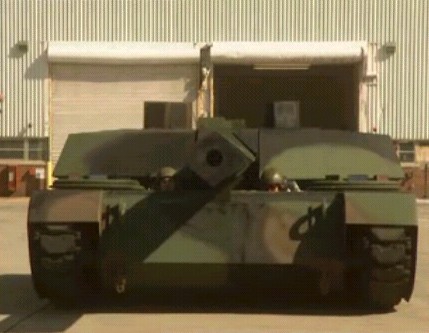
The sensible 40-ton medium FCS tank that was rejected that would work in OPEN terrain as a FCS-2D working in concert with a lighter FCS-3D for CLOSED terrains
"This is a game of wits and will. You've got to be learning and adapting constantly to survive."
---Former U.S. Army Chief of Staff, General Peter Schoomaker, Uber Light Infantry Narcissist and Big Army Racketeer speaking words he failed to live by
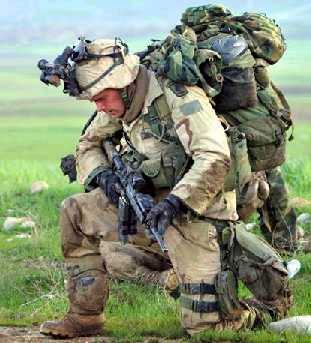
The Army of foot and truck victims Schoomaker wanted
BREAKING NEWS!
OFFICIAL U.S. ARMY DOCUMENT: Army General Officers don't need any stinkin' analysis!
EXCERPT from Chapter 5 "Army Force Development", page 39: this captures how the Army generates "requirements":
"The new joint and Army concept development processes have changed to become top-down driven."

Basically, you will see an opportunity for a general officer to insert his vision (a "good idea") and how the rest of the Army is then obligated to make it happen...reality and facts be damned...
"How the Army Runs" an "untitled paper" from TRADOC circa 2005 (see above) institutionalizes no analysis programs, shows a preference for top-down general officer (GO) wish lists without factual examination; the process should not allow one individual to decide issues based on their prejudices on things like derogatory labeling like "cold war" or the urge to make some radical change to make a name for himself when what we already have might be best ie; M113 Gavin light tracks; Planet Earth and the laws of physics don't care about how many times the earth has revolved around the sun something has existed, this is something stupid avant garde' humans do that has no bearing at all on what a thing is capable of doing.
GOs should focus on the concepts required and let the true facts drive what specific equipment is used (Stryker trucks cause we want to be seen in wheels), otherwise he states his equipment demand sans analysis and those underneath scramble to give him what he wants by dishonestly cherry picking some minor silver lining while ignoring the cloud of failings, distorting data or outright lying.
Who will save the U.S. Army From Itself?
Detailed Examination: www.geocities.com/pentomicarmyagain
GAO/IDA Report on Army Modularity Plan's "mini-brigades"
www.combatreform.org/gao05926modularity.pdf
www.combatreform.org/gao05-926modularitysummary.pdf
Congressional Budget Office Report on better Army Modularity Options
www.combatreform.org/20050510_CBO_OptionsforRestructuringtheArmy.pdf
Congressional Research Service Modular Brigade Report
www.combatreform.org/CRSModularBrigadeReport.pdf
POOR QUANTITY: Winslow Wheeler on Army modularity plan: "force castration" weakens the force QUANTITATIVELY
Advocates in the Army talk at great length about the plan, called "Modularization," to allegedly expand the number of Army and Reserve brigades from 66 to 77 and to make these "brigade combat teams," no longer divisions, the primary level of command to fight twenty-first century warfare.
They talk a little less about how this plan will actually shrink the Army's actual combat forces. This apparent goal is achieved by reducing the number of ground combat maneuver battalions in each brigade, now generally three, to two in most new formations. Thus, while the number of brigade headquarters will increase by 11.5% (from 66 to 77), the number of actual combat units in the form of maneuver battalions will reduce from 201 to 161, or by 20%.
This force castration, under the guise of "reform," is critiqued at some length in a new study from the Institute for Defense Analysis (IDA). The reduction in maneuver battalions is hardly the only problem with this plan the analysts at IDA found. A short commentary on this plan is now posted at the website for the Straus Military Reform Project at www.cdi.org/smrp.
*********************************************
September 29, 2005
U.S. Army Take on Military Reform: More Tail, Less Tooth
Under the guise of modernization, the Army is in the process of shrinking its combat forces and enlarging its headquarters overhead to meet existing manpower ceilings.
At considerable effort and expense, the Army is reorganizing its combat formations. Called "modularization," the plan is to expand the number of combat brigades from 66 to 77 in the active duty and reserve components. These new "brigade combat teams," no longer divisions, will constitute the primary level of command to fight 21st century warfare.
It sounds like a reasonable reform - until you scratch the surface.
The expansion of brigades is accompanied by a reduction in the ground combat battalions (the units that actually do the fighting) each brigade will command. These "maneuver battalions" will be reduced to two, in a few cases three, per brigade. This is down from their normal three, sometimes four, maneuver battalions per brigade. Specifically, while the number of brigade headquarters will increase by 11.5 percent (from 66 to 77), the number of maneuver battalions in them will shrink from 201 to 161, or by 20 percent.
The new castrated brigades also have other potential disadvantages. Some plausibly fear they will be able to sustain only limited combat because there will be only two battalions to rotate into reserve or rest, not three or more. Others point out the "reform" will further stress our already overextended forces in Iraq: the pint-sized brigades will require larger manpower deployments to maintain a constant level of combat power.
All this, and quite a bit more that is highly critical of the Army's "Modularization," is explained in an analysis performed at the Institute for Defense Analyses for the Army. IDA is a highly respected federally funded research organization that performs work for the Defense Department, and in this case the Army. These unclassified documents have not previously been available to the public. Visitors to this website who wish to discuss or review these documents should contact the Director of the Straus Military Reform Project, Winslow Wheeler, at wwheeler@cdi.org.
# # #
Winslow Wheeler
Visiting Senior Fellow
Source:
www.army.mil/fcs/index.html
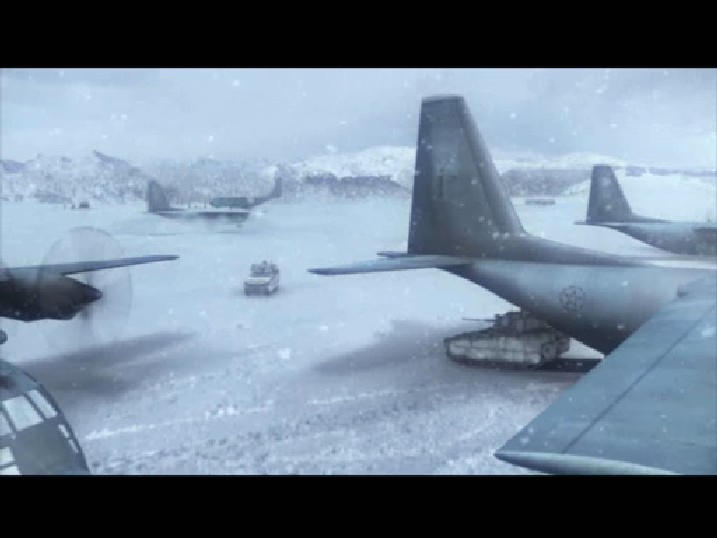
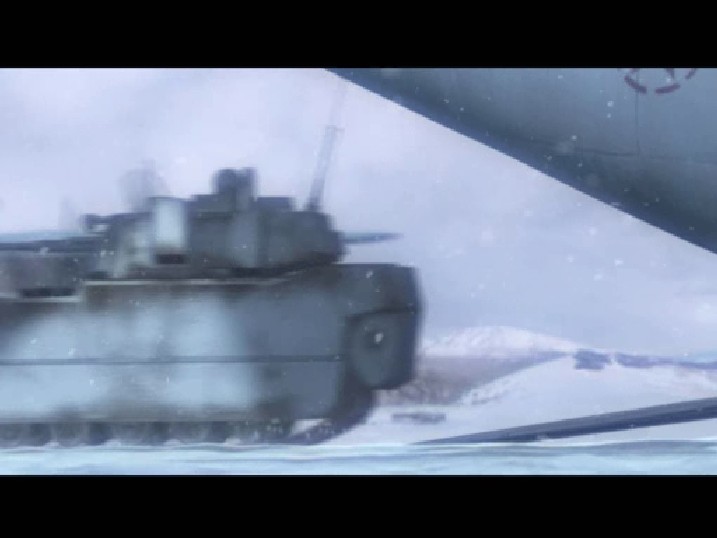
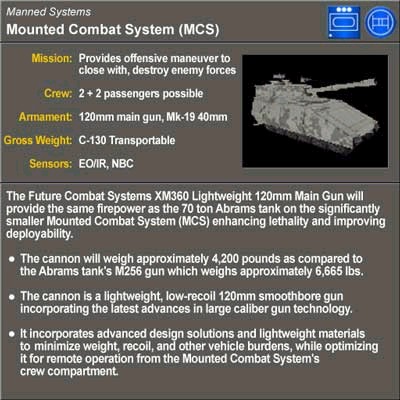
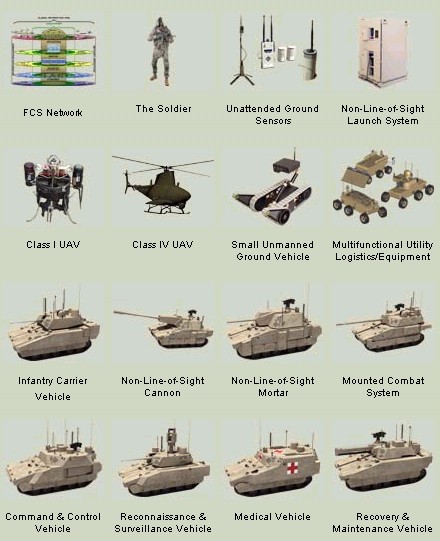
1. 27-ton FCS medium tank too light for open terrain combat, too heavy for closed terrain mobility or air transport, having it shown coming out the back of a C-130 is a lie
2. Its no surprise the one-size-for-all 16.5 ton weight was exceeded because of TURRETS and their inherent inefficiency; however the M8 Buford/Thunderbolt could have a turret and 105mm/120mm guns and still remain C-130 air transportable; something has to give--instead of making the hard choices the FCS racketeers chose to make their tank heavier with gadgets rather than rethink their flawed approach
3. Notice if you try the absurd video game that a FCS can't SWIM and needs a bridge that the enemy conveniently doesn't explode underneath it, FCS developers must have never cracked a book on the battle of Arnhem or ever read anything about Corinth canal in WW2; "swimming is not a FCS requirement" will be the BS excuse
4. Weak physicalism based on computers turning enemy into video game icon to destroy
5. Unmanned robots more weakness taking place of human machine powers
6. Spitting out lots of expensive sensors as bread crumbs to hopefully create video game effect is not likely to work; sensors need to be watched to prevent tampering/spoofing
This is a giant racketeering enterprise by the Army and corrupt corporations to $$ squeeze money from Congress.
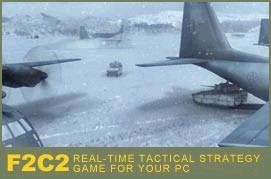
By Major Daniel L. Davis, U.S. Army
The U.S. Army is the most modem, powerful and technically advanced ground combat force on earth. In order to maintain its advantage over potential foes well into the future, the Army created the concept of the Future Combat Systems (FCS) family of vehicles.
******************************
ARMY MODERNIZATION
******************************
But $4.6 billion and two years into the program, the FCS effort is further from its target production date than when it started, and its projected budget has ballooned from $92 billion to $125 billion (plus an additional $35 billion needed to "network" the various systems).
Far more troubling, however, is the growing realization that the "system of systems," as it is called, will not perform some of the most critical functions for which it was created and, if fielded in its present design, might lay the groundwork for defeat of the U.S. Army on a future battlefield.
FCS, as currently designed, is fatally flawed. Before pumping more funds into the program, Army officials should consider an alternate transformation program with principal components already validated by combat experience.
CORE OF FUTURE FORCE
FCS, as described on the Army's Web site, is "a joint networked system of systems. Future Combat Systems are connected via an advanced network architecture that will enable levels of joint connectivity, situational awareness and understanding, and synchronized operations heretofore unachievable. ... FCS is the core building block of the Army's Future Force. FCS will improve the strategic deployability and operational maneuver capability of ground combat formations without sacrificing lethality or survivability."
The system of systems involved in the FCS program is described as 18+ 1 + 1, which refers to 18 mechanical systems, plus the network, plus the Soldier.
In theory, the concept that gave rise to FCS is impressive. If its designers' goals could be achieved, FCS would combine eight manned systems (a "light tank" variant, troop carrier, command vehicle, four unmanned systems(armed robotic vehicle, ground sensors, etc.), four classes of unmanned air vehicles (UAVs) and two classes of smart munitions. These elements would be linked through a central communications network providing broadband-caliber connectivity to enable maps, photographs, graphics, enemy information and other data to be sent and received in real time by every node in the network. Ostensibly, this unparalleled degree of connectivity would allow American forces to attack and destroy enemy positions from safe havens far beyond the ability of the enemy to pinpoint or strike, reducing the need for robust armor protection.
That's the theory. But it doesn't square with a recent, independent analysis of the system and ongoing combat experience.
CRITICAL FINDINGS
At a hearing before the Senate Armed Services Committee in March, Paul Francis, the Government Accountability Office's director for acquisition and sourcing management, delivered a report on the state of FCS that contained a number of findings highly critical of the program. Here are five of them:
* FCS' advanced network architecture faces significant technical challenges that threaten the schedule for fielding some future force capabilities and makes their ultimate ability to perform uncertain.
* An estimated 34 million lines of software code need to be generated for FCS (about double that for the Joint Strike Fighter).
* Only one of more than 50 advanced technologies needed for FCS to function is mature.
* C-130 transport aircraft can carry FCS vehicles' original projected weight of 19 tons only 5 percent of the time. (The Army recently agreed to a weight of 24 tons for the vehicles, acknowledging that the 19-ton goal is not technologically feasible.)
* We don't know enough about the program's variables to conclude that the FCS program, as laid out, can be achieved, let alone completed within a predictable time frame and budget constraints.
In light of these shortcomings, it seems prudent that Army officials should search for alternatives to their FCS acquisition strategy. That so many critical, high-tech components of the system remain unproven throws open to question whether this system is the right one - at least right now - for the future Army.
FUTURE FIGHTS
Even if the system functioned perfectly, the network was flawless and the vehicles light enough for air transport, FCS is being de-signed specifically so it does not have to engage in close combat. With their lighter armor, none of the manned systems will be capable of engaging in direct-fire engagements with enemy tanks or withstanding coordinated assaults by ground forces armed with anti-tank weapons.
Virtually all military analysts agree that future wars are likely to be fought in urban terrain - in cities. Even if we have perfect knowledge of where enemy forces are and which buildings they are holding, there will still be a requirement to send in ground troops to engage them.
What would happen if an FCS-equipped force were directed to fight in a large, Baghdad-like city in a future war? This hypothetical question can be answered quite authoritatively.
In 1995, Russian forces moved on the Chechen capital city of Grozny. The Russians were equipped with T80 and T72 tanks and BMP armored troop carriers. The defenders of Grozny were equipped with a handful of tanks and anti-aircraft weapons, but primarily with hand grenades, AK47 assault weapons and variants of rocket-propelled grenade anti-tank weapons
**********************
PIC of FCS
"Future Combat Systems vehicles will be lightly armored because they are not designed for close combat - a notion that may be unrealistic."
***********************
An article in the Summer 1999 issue of Parameters, by Timothy L. Thomas, described what happened when lightly armored tanks and personnel carriers engaged in urban combat against an enemy equipped with even "basic" RPG-7s:
"The first unit to penetrate to the city center was the 1st battalion of the 131st "Maikop" Brigade, composed of some 1,000 Soldiers. By January 3, 1995, the brigade had I lost nearly 800 men, 20 of 26 tanks, and 102 of 120 armored vehicles."
Compare that with the U.S. 3rd Infantry Division report of its 2003 combat operations in Iraq: "The M1 Abrams tank led the attacking columns of U.S. forces through urban areas and was successful in producing a strong shock effect against defending forces. M1s and M2s were attacked with small arms, BMP 30mm and 73mm cannons, T72 125mm rounds, numerous ADA [air-defense artillery] systems and rocket-propelled grenades (RPGs) without suffering the catastrophic loss of a single crew member." .
The Russian brigade lost 800 men in three days of urban combat; in contrast, according to the 3rd Infantry Division's after-action report
***********************************************
PIC of Chinese Type 96 Heavy tanks
Nearly all Chinese tanks are equipped with a cannon systems that can penetrate the hull of the vehicles planned for the Army's Future Combat Systems.
*****************************************
in almost a year the U.S. unit lost none as a result of penetration of a tank because of the level of armor protection on the fighting platforms.
POTENTIAL ENEMIES
Four countries - China, North Korea, Iran and Syria - present the most likely potential threats to the United States. Of these, China is the most dangerous and capable.
Any combat system we develop must be able to withstand the risk posed by the greatest potential threat we face. Therefore, let's consider how FCS would measure up against threats posed by China.
If U.S. Soldiers in an FCS-equipped force were directed to intervene in a war between China and Taiwan, they would likely be defeated by Chinese ground forces. This conclusion takes into consideration the impressive benefits the U.S. force would gain from air and naval support Although this assertion is certain to raise some eyebrows, a recent analysis of the capabilities of an FCS-equipped force and the force China will likely have in the near future reaches this disturbing conclusion.
According to Richard Fisher, vice president of the International Assessment and Strategy Center, China continues to make improvements in its conventional forces that are specifically designed to counter the advantages that would otherwise accrue to an FCS-equipped force.
"While we are building lighter and more mobile armored vehicles, China is building heavier and stronger armor", Fisher points out "According to government study, the Chinese should have over 1,200 T96 tanks operational by the end of this year. The T96 is a vast improvement to the T72 in terms of both armor protection and firepower."
Virtually every tank in the Chinese inventory packs a cannon system that can penetrate the hull of every vehicle contemplated under FCS. If we had to engage China, we would need to load the front end of the ground force with the Abrams tanks and Bradley fighting vehicles; it would be suicidal to attack with an FCS-style force.
But what about the stated advantage of FCS using standoff, extended-range engagements made possible by the new information-sharing network?
"What the Chinese are most interested in is defeating the 7th Fleet," according to Fisher. "To win, they don't have to destroy the fleet, but to blind it. To do that, they currently have operational SRBMs [short-range ballistic missiles] with non-nuclear, electro-magnetic pulse [EMP] warheads. If they blanket an area over the fleet, it could devastate their electronics and communications. If they've got 'weaponized' SRBMs, then they've likely also got EMP mortars and grenades."
The significance of this observation for an FCS equipped force is that if an EMP device was fired near the central node, the entire network could be wiped out.
This is not an insignificant consideration. As Brig. Gen. Charles A Cartwright, deputy director for the Army Research, Development and Engineering Command, pointed out in a New York Times article in March, "If [the FCS network] does not work, the Future Combat System will fail." If FCS fails in combat, men will die.
"BREAKING THE PHALANX"
Fortunately, there is an alternative to FCS - one that is far less expensive, more capable and directly engineered to meet evolving threats from potential adversaries. It's not some new armored vehicle, though; rather, it's a call to embrace warfighting concept that closely parallels some of the organizational developments we see in Iraq.
First publicly advanced in retired Col. Douglas A. Macgregor's 1997 book "Breaking the Phalanx" (published years before the FCS concept was developed), an alternative "system of systems" solution exists in the equipment troops use today.
Virtually all of the Army's major fighting platforms either already incorporate or can be upgraded with the latest technological developments. More significantly, they would derive most of their new utility and effectiveness primarily from being cast in new organizations designed to maximize their combat effectiveness.
Under Macgregor's plan, the Army would immediately transform its fighting formations from the brigades, divisions and corps we have used since World Wars I and II to "battlegroups" of 3,000 to 5,000 Soldiers and standing joint task force organizations. Not totally unlike the Unit of Action and Unit of Engagement concept being pursued by the Army today. Macgregor's plan would initially incorporate weapons systems that are proving their worth on battlefields today: M1 tanks, M2/3 Bradley fighting vehicles, unmanned aerial vehicles, space-based platforms, attack helicopters, indirect-fire systems, etc. And, yes, there would even be room for Strykers. [EDITOR: BS. We have no room or need for road bound trucks moving infantry into roadside bomb ambushes]
40-ton Sensible FCS No Longer Pursued by the U.S. Army
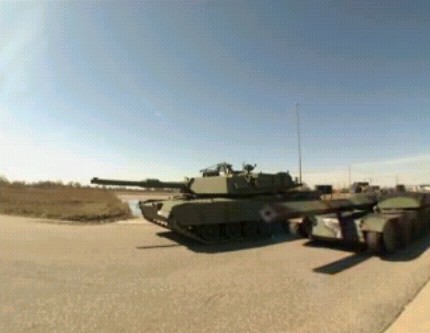
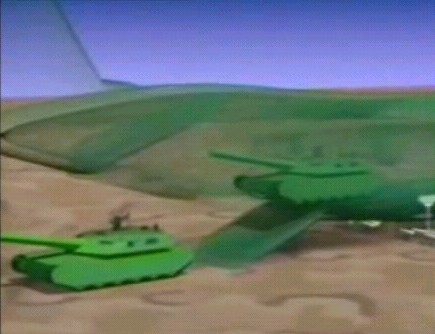
www.youtube.com/watch?v=oxba0ynu_yk
There just wouldn't be any expectation that, at least for a few decades, these tried-and-true fighting systems might be replaced by a "do-all" FCS family. Funds that are being pumped into the FCS program would be used, instead, to develop the revolutionary fighting systems that will, one day, replace those being used in Iraq.
A year ago, during testimony before the House Armed Services Committee, Macgregor explained how his original plan could be adapted to meet the Army's current needs: "In a period when rapid obsolescence is a high risk, 'wildcatting' with new [weapon system] designs, even aggressively courting failure with limited numbers of prototypes is absolutely necessary. The Army transformational methodology should be: Look forward to the next technology we can exploit that will help. Field it incorporate weapon systems that in limited quantities to the force. Play with it. Test it. Develop new operational, organizational and doctrinal modes for it. Feed that back into building the next based platforms, capability [again and again]. This means going through a rigorous process of experimentation in order to reach the goal of sustained military superiority."
At this point you're probably wondering, if this plan is so good, why wasn't it implemented instead of FCS years ago? There isn't a simple answer, but its rejection was probably due, at least partly, to a clash of personalities.
Macgregor can be quite pointed in his criticisms of those who disagree with his positions and of those who he felt lacked the knowledge needed to carry out the duties of their positions, particularly general officers. That isn't the way to advance in the officer ranks, as Macgregor ultimately found.
But recall that, in early 1991 when so many others were warning of large numbers of American casualties in the pending war to expel Iraq from Kuwait, Macgregor correctly predicted that American armor would quickly cut through the Iraqis and crush them. Also, according to Rowan Scarborough's book "Rumsfeld's War," well before the start of Operation Iraqi Freedom, Macgregor correctly predicted that fewer combat troops would be needed than in earlier operations. Further, and more critically, Macgregor asserted that the answers to stability in post-Saddam Iraq were to avoid disbanding the Iraqi army, and to immediately appoint Iraqis to the interim government. In short, Macgregor has been right before.
So we should pay particular attention to his testimony before Congress in July 2004, in which he outlined the shortcomings of FCS - observations that were echoed the following March by the GAO's Francis.
Perhaps the best response to transforming the force that will fight our nation's future wars involves adopting ideas raised in the past. We should acknowledge inherent weaknesses of the current FCS development program and set it aside as a system. In its place, we should explore the best ways of integrating the viable tenets of Macgregor's ideas with several of the promising, truly revolutionary developments in the FCS program, such as the unmanned air and ground sensors and the advanced defensive suites being designed for some vehicles. To get the ball rolling, Congress should commission a study on Macgregor's ideas to accurately and impartially evaluate their potential worth in light of contemporary challenges.
It wouldn't be surprising to find that Macgregor's ideas, perhaps like the man, were just a bit ahead of their time.
************************************
Maj. Daniel L. Davis is an Army armor officer who fought in the Battle of 73 Easting, the largest tank battle of Operation Desert Storm
EPILOGUE
P.S. if your last complaint against the M8 Buford/Thunderbolt AGS light tank is that it has an autoloader, how hard would it be to NOT install it in the turret and just weld storage racks for more rounds and a seat for a 18-21 year old young buck Soldier to "autoload" with biomechanical means? Let's get our foot-in-the-door here amidst the absurd wheeled armored car, thinks-its-penny-pinching Army, and if we need to we can easily undo the autoloader if it will make things better.
If we want to defend places like Taiwan, the U.S. Army had better break out its M113 Gavin light tanks and supply them immediately to its light infantry Delta Weapons companies and get our own Air-Mech-Strike capabilities ASAP.
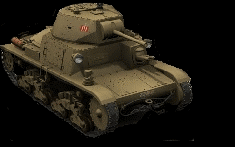
So why doesn't the U.S. Army and marines do these things to be high quality "Light" infantry? The Curse of (Garrison) Line Infantry: where does it come from?
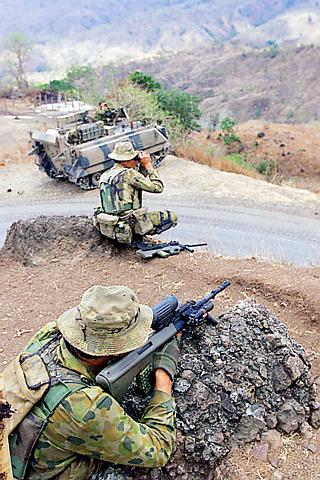
Other countries like Australia have M113 Gavins + light infantry without feeling their penises have fallen off, why not the U.S.?
www.vision.net.au/~apaterson/social/truth.htm
THE THREE STAGES OF TRUTH
"All truth passes through three stages. First, it is ridiculed, second it is violently opposed, and third, it is accepted as self-evident."
--German philosopher, Arthur Schopenhauer (1788-1860)
It would appear to be an indelible human trait that the "truth" about all issues goes through three distinct phases known colloquially as "the three stages of truth". During the first stage, the issue goes unnoticed and is ignored. The second stage is characterised by a period of vehement denial. The third stage witnesses the the truth about the issue being recognised as self evident.
Examples of this sort of thing a legion. Thus for example, five hundred years ago contemporary Western (meaning European) society believed that the Earth was flat and at the centre of the Universe and anyone who had the temerity to suggest otherwise was invariably burnt at the stake. It wasn't until the Magellan expedition's circumnavigation of the globe in 1522 that the reality of a round Earth was finally acknowledged as being "self evident".
The reason why "truth" goes through these three stages is that humans in general are very reluctant to give up their beliefs as to the nature of reality because they have invested a lifetime of expense and effort in arriving at those beliefs. Acknowledging that their perception of reality may no longer be applicable in the light of new evidence usually presents humans with the uncomfortable choice of dispensing with a paradigm that they are used to - and which has probably worked quite satisfactorily to date - in favour of a something new and yet to be properly defined. Few humans have the courage or strength of character to pursue such a course of action, as it usually results in considerable personal discomfit associated with a lack of supporting structures around new ideas and a fear of the unknown, not to mention the vociferous ridicule by their contemporaries towards anything new. This situation is exacerbated by the fact that those who question society's prevailing orthodoxy are by definition dissenters who, by "rocking the boat", tend to threaten the very lifestyle and comfort of all around them who hold to the prevailing orthodox position. It is for this reason why dissenters have been relentlessly pursued and persecuted throughout history by their contemporaries.
We began this web page with the premise that the U.S. Army and marines WANT TO BE GOOD LIGHT INFANTRY. The sad fact is they do not want to be light infantry they want to be LINE INFANTRY. Using pack mules, bikes, carts, light M113 Gavin tracks etc. would cut into their garrison BS narcisso-ego time. In other words, it would take EFFORT on their part and they would have to CHANGE THEMSELVES and apply some humility which as we alluded earlier, they generally have none of.
Recently, we were asked where does the U.S. Army's Light infantry divisions come from with their absurd hard-headed refusal to even light mechanize in light to medium tracked tanks? If you don't want to read through the power point slides below, we offer you a down & dirty history of the U.S. Line Infantry mentality.
Rather than give the questioner the trite "official" answer that Light Infantry Divisions (LIDs) were created in the early 1980s to fit on x amount of C-141A/B Starlifter jet transport sorties to reinforce Europe by fighting in closed terrain "not passable to tanks" after the Societ tank armies invaded so they had to forgo organic ground vehicles yadda yadda yadda, we have thought long and hard because the question also applies to all of the USMC infantry units, too.
Here is what we think the actual truth is:
1. Infantry that moves slowly on foot comes from the CIVIL WAR (19th century) to create linear formations to fight set-piece battles in the Napoleonic nation-state vs. nation-state mode.
2. We have LINE infantry because we WANT TO HAVE line infantry.
3. We want line infantry because it is simple and allows us to have GARRISON activities (BS = bull shit).
If we created a MOBILE infantry, the time needed to play GARRISON spit 'n polish, "From Here to Eternity", lawn and building care, parade ground ceremonies would have to be devoted instead to our MOBILITY MOUNTS and not self-worship. We want line infantry so we can have GARRISON BS.
We are in the 21st Century with a 19th Century military organization, culture and weak narcissistic egomaniac population. As you will see, the U.S. military has NEVER properly adapted and exploited the tank (mech) and the airplane. We are two centuries behind already.
Here is how its progressed over time:
1860 Civil War--------------------->WW1-------------------->WW2 1940
Despite creating a MOBILE infantry (Cavalry on horses) to defeat the Indians after the Civil War, we kept the LINE infantry that could advance in lines or entrench into lines, hitting its zenith in WW1's carnage. "Soldiering" was not that technologically complex and we could stab each other in the back all day long with GARRISON "From Here to Eternity" crap. Everything was shiny to be visible from a distance and polishing kept the troops busy. The mobile warfare folks in love with the HORSE forgot that it was MOBILITY that counted and refused to mechanize with machines to get it.
The failure to understand the battle against the earth (TBATE) loses wars; in 1940 the Allies ASS U MEd the Ardennes forest was not passable by German light tanks and had no Maginot line forts there. The Germans poured through and France fell within weeks and the British were forced from the continent.
Germany panzers primarily in excellent Czech-built T35/T38 Light Tanks Swarm through Ardennes Forests Allies Thought were "No-GO" terrain


www.youtube.com/watch?v=g4MD3-fzglM
PART 2: light tanks gobble up Poland, Stukas help with CAS, France, Germans concentrate all their light tanks in 200 mile frontage to bust through Ardennes forests, main battle tank BS, still LIGHT tanks, Panzer IV are infantry fire support role, leadership on the scene to exploit fast-moving situations, attack a village: commanders able to decide how/when to do it, GFAC liaison officer radios to Stuka pilots where to attack,
Yet a year later, the Germans not yet fully tracked mechanized and with many wheeled trucks and no Airborne 3D to act as cavalry ahead of the main body falls short of Moscow due to severe winter mud and snow---and Russian bypassed troops and inserted paratrooper and light tank resistance.
Partially-Mechanized German Army on wheels and horses defeated by TBATE
The irony is that today, TBATE is ignored by the techno-narcissist U.S. military with increasing regularity as it emasculates itself into wheeled trucks under the delusion that help by mouse-click will solve physical problems in the mud.
WW2 1941------------------------->Korea-------------------->1960
In the closed terrain of the Pacific, WW1 generals could refight linear WW1 using air and sea craft to deliver the infantry to the battlefield (parachute and airland airborne and amphibious operations), where they could then engage in linear Civil War re-enactments. Garrison was safe for post-war games/lifestyle. However, in the exposed, open terrain of Europe, ground forces needed to move much faster, and WW1 generals used wheeled trucks to "motorize" infantry to try to keep up with tracked tanks and dismount to fight linear Civil War-WW1 style at every opportunity, in addition to using air and sea craft. When no tanks were taken even to WW1 foot-slog better with armored fire support---like during the invasion of Holland, defeats were suffered.
Arnhem: Bridge Too Far or We Didn't Bring Enough?
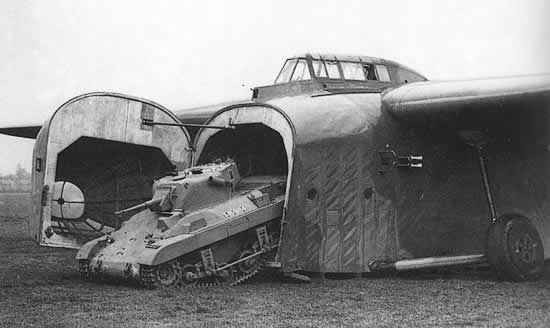
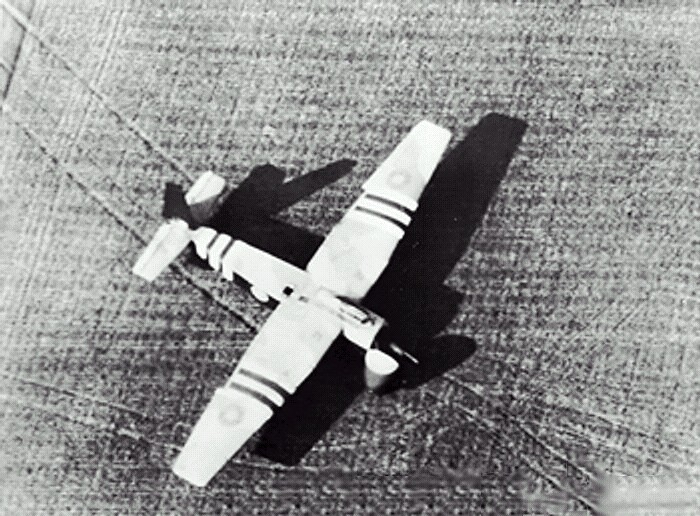
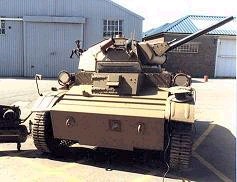
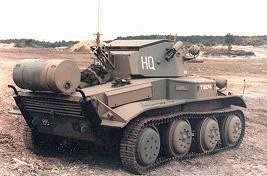
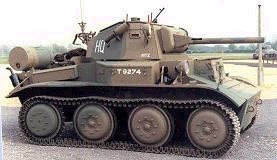
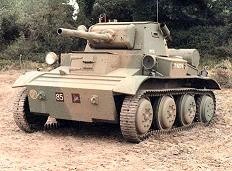
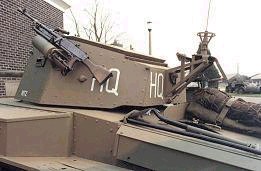
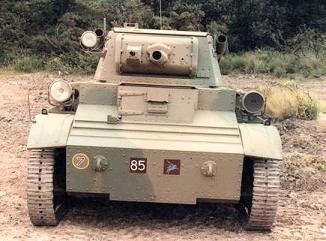
MYSTERY: the British tank museum's Tetrarch light tank has a 3-pounder gun for fire support as shown above. So don't even try to whine about these light tanks being inadequate to kill heavier German tanks, they were needed primarily to BLAST GERMAN INFANTRY OUT OF BUILDINGS, BUNKERS AND DUG-IN POSITIONS. This was known AT THE TIME as proven by the Tetrarch with the 3-pounder gun. Yet we only know the 6th Airborne Division having an Armored Reconnaissance unit with light tanks, not the 1st Brititsh Airborne which landed near Arnhem. The photo above of a Hamilcar at a landing zone west of Arnhem adds to the mystery as SOMETHING has rolled off its front nose ramp. We also know 412 Hamilcar heavy gliders were built so the question arises WHY DIDN'T THE BRITISH GLIDER-LAND A FORCE OF 100-400 LIGHT TANKS AND BREN GUN CARRIERS WEST OR ARNHEM AND PUNCH THEIR WAY THROUGH TO REINFORCE LTC FROST'S MEN?
The troubling question remains: where were the light tanks?
www.combatreform.org/airbornetanksnoexcuse.htm
Heavy Lift Gliders + Bren Gun Carriers = Airlanding Troops with Armored Mobility
Heavy Lift Gliders + Bren Gun Carriers + 75mm Pack Howitzers = Airlanding Troops with Armored Mobility + Firepower
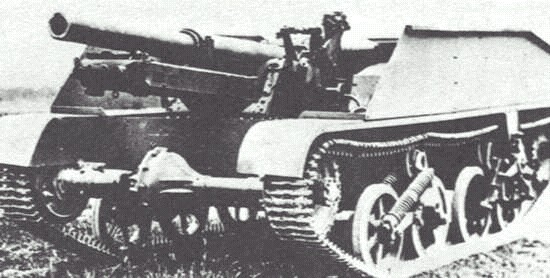
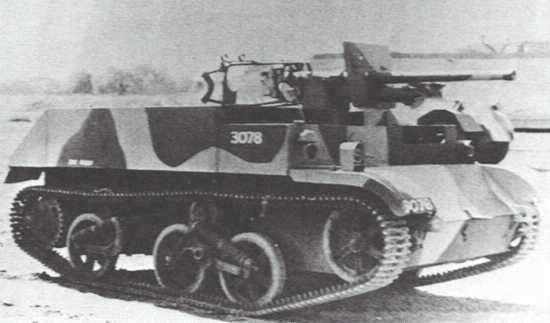
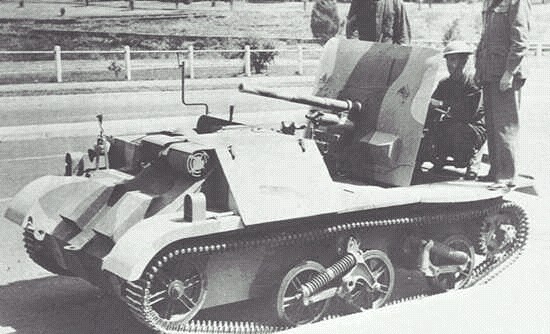
Above are Bren tankettes with a 25-pounder and 2 pounder guns...what was their excuse for the 1st British Airborne Division not employing these by glider at Arnhem when their peers, the 6th Airborne had the foresight to deploy turreted light tanks on D-Day? Was it ego?
The British 6th Airborne Hamilcar glider airlanded Tetrarch light tanks on D-Day....was the 1st Airborne Division ignorant of this practice? What about Bren gun carrier tankettes? In the PBS "Battle" series documentary they sing the praises of the 75mm pack howitzer...why didn't anyone mount a 75mm pack howitzer on a Bren gun carrier making it a "Pack Howitzer Carrier"? With such mobile firepower, the British Airborne could have punched through to reinforce LTC Frost at the road bridge and hold it long enough for even the slow mechanized XXX Corps to arrive.
Was Airborne Ego rivalry cause of Arnhem Debacle?
1. Its undeniable that the British 6th Airborne glider-landed both Bren gun carriers and Locust light tanks with 37mm guns on D-Day and they were SUCCESSFUL. You can read a veteran's account of glider-landing a Bren tankette on D-Day on the web page below:
www.geocities.com/air_mech_strike/groundvehiclephotos.htm
Here's as picture:
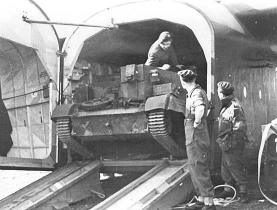
2. Its undeniable that Brens could have been and were fitted with both 37mm and 25 pounder anti-tank guns in turretless hull mountings to get more firepower even if turreted light tanks with suitable firepower were not available
3. The British 6th Airborne and Hobart's 79th Division "funnies"
www.geocities.com/armysappersforward/sappertanks.htm
were NOT there for either the Market or Garden part of the operation, the British 1st Airborne Division had the job and they DID NOT EMPLOY ANY GLIDER-LANDED TRACKED ARMOR AND THEY FAILED TO HOLD ARNHEM BRIDGE. Fact.
4. The British 6th Airborne later on did the Rhine crossing and glider-landed Tetrarch gliders and were SUCCESSFUL.
Therefore;
could it be that the British 6th Airborne had its act together with air-mech and the egomaniac 1st Airborne under vain "Boy" Browning refused to employ their glider-landed tracked armor tactics bringing about their ruin?
5. We know for a fact that Browning et al dismissed the threat of German panzer tracked armor at Arnhem showing an anti-mech pussy, "we-are-supermen" attitude.
The 6th Airborne BEFORE Arnhem glider landed Tetrarch and Brens on D-Day. The 6th Airborne AFTER Arnhem glider-landed Tetrarch light tanks for the Rhine river crossing.
WHY WASN'T THE 1st BRITISH AIRBORNE EQUIPPED LIKE THE 6th AIRBORNE WITH BRENS AND TETRARCHes?
I have not a shred of evidance of any Tetrarches being glider landed by the 1st British Airborne.
We were hoping a British Soldier/Historian might know...too bad the legendary Ian Hogg isn't still around...he'd have known...
If the light tanks had they been glider landed by 1st Airborne forces could have:
a. given infantry a ride to cross the 6-8 miles from their DZs to Arnhem bridge in under an hour
b. given high explosive firepower to blast through German forces blocking them from reaching Arnhem bridge
c. Result would have been 1st Airborne consolidating strongly around Arnhem making it a strongpoint not unlike the 101st at Bastogne where small caliber guns that were not supposed to be able to stop German light, medium and heavy tanks did just that.
No XXX Corps allied tanks arrived at Arnhem or crossed the Rhine to help LTC Frost and his men.
Maybe some enterprising war gamer/grognards out there might run a simulation on our hypothesis?
Arnhem According to Gavin
1. According to General Gavin in Airborne Warfare (1947) two measley German wheeled armored cars stopped the 3rd and 1st battalions of the 1st British Airborne following a railroad track from getting to the Arnhem bridge held by LTC Frost's 2nd Battalion. When a 57mm anti-tank gun being towed by an unarmored wheeled Willys jeep tried to get into firing order, it was blasted by the armored cars.
Canadian, Tim Brown's war game professionalism [http://saskminigamer.blogspot.com/2007/06/tiger-route.html] puts 99.9% of the Army and marine corps types on active duty to shame.
The FACTS are that NO TANKS opposed the 3rd Battalion of the the 1st British Airborne Division they were simply fucked up lacking the minimum of self-propelled, ready-to-fire weaponry on a tracked armored vehicle to overcome just a little German resistance by men with hand weapons. Tim says:
"This was the path to be taken by L.Col Fitch's 3rd Parachute Battalion along the Utrecht-Arnhem highway. The battalion was to sweep into Arnhem from the north and link up with Frost's 2nd Battalion at the bridge. In his way, however was the 16th SS Grenadier Training and Reinforcement Battalion commanded by Major Sepp Krafft (and later elements of the 9th SS Panzer Division!)."
In airborne operations, you must SEIZE THE DAY! the day you arrive is your opportunity to strike the enemy when he's not ready and take things like Arnhem bridges. If you let yourself get stopped by reaction forces THEN you open yourself to his "panzers" opposing you.
2. The failure of the British Airborne to move the 6-8 miles from their drop zones west of Arnhem to reinforce Frost at the Bridge ruined the entire operation which was to be a bridgehead across the Rhine river.
LESSON #1: Quantity (mass)
Its clear the British fucked up Operation Market-Garden by war weariness and a lack of willingness to suffer casualties in the face of a mere pair of armored cars. The truth is that the Airborne forces did their job to include holding Arnhem bridge for several days and XXX Corps in mechanized armored Bren gun carriers, half-tracks led by Sherman medium tanks took too long to link-up stymied up a narrow single-lane highway. Where was Percy Hobart's 79th Armored Division with the "funnies" tanks to include amphibious LVT-4 Buffalos that could swim across rivers? The relative of an 82nd Airborne Arnhem veteran writes:
"Uncle XXXX said that when they took the northern end of the Nijmegen Bridge, the Brits said something to the effect of, 'Thanks chaps. We'll be across in the morning.' He said that Gavin had to have his MPs hold Julian Cook's regiment at gunpoint to prevent them from comandeering the British tanks and taking them up the road themselves. They were furious. Had they known the Brits would hold in place until morning, they could have paddled across the river at night and taken far fewer casualties. They took 50% casualties taking the bridge. Uncle XXXX died over 40 years ago from wounds suffered in the Battle of the Bulge - quadrapalegic and had kidney failure - but he was adamant that they could have made it up the road to the Brits. He was a very direct guy and not prone to BS'ing."
While the Allied Airborne in general did not fail the mission, it did fail themselves when it could have held on long enough even for XXX Corps to arrive had the 1st British Airborne had its act together better. If you are not willing to lose men and lack the mobility to move several miles quickly because you are foot-slogging, you damn well better jump DIRECTLY onto the bridge and have someone willing to fight hard to do it, namely General Gavin's 82nd Airborne do the job. Gavin would have likely jumped in at NIGHT directly onto the north and south of Arnhem bridge to evade anti-aircraft fires and used aircraft bombing to precede the effort to suppress what couldn't be avoided. Another possibility would have been using gliders at higher altitudes and sneaking in to the bridges Eban Emael and Orne River Bridge-style to get by the AAA guns.
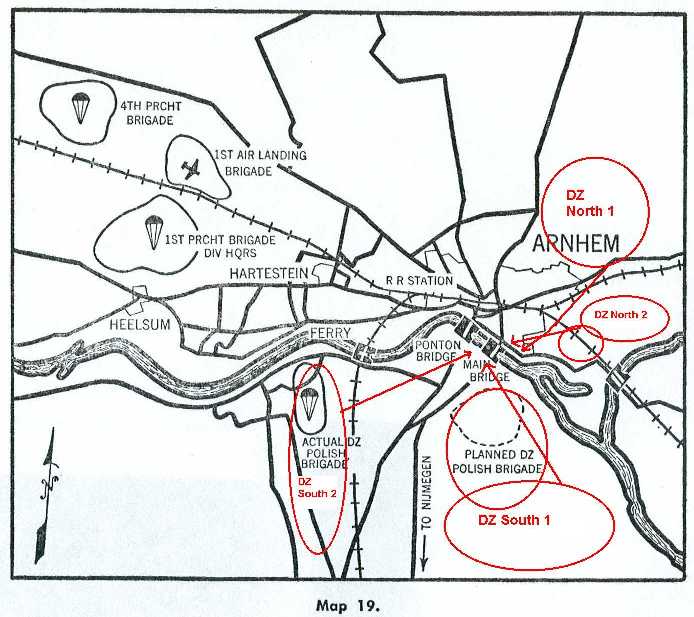
The majority of the 82nd would have then arrived in concentrated form and held the bridge and a nearby resupply drop zone insuring a successful mission. The 101st should have then taken Nijmegan bridge and Groesbeek heights with the 1st British Airborne taking the lower bridges and being relieved first by XXX Corps in motor vehicles. Gavin cites a lack of airlift during Market-Garden to drop all paratroopers and launch all gliders at the same time, therefore having the Arnhem assault echelon jump in at night and a few hours later the other elements during the day would have enabled the planes to return to base and be loaded up for the day time assaults. The 1st Allied Airborne Army being led by the British General Browning who were the weakest practitioners of airborne warfare and not someone from the British 6th Airborne Division who aggressively used gliders to deliver light tanks and stand-off glider surprise attacks or having General Ridgway in command was a fatal mistake.
LESSON #2: Quality (aircraft precision firepower)
Where was the excellent IX Air Force P-47 fighter-bomber close air support (CAS) when the British ran into the German armored cars and panzer tracked tanks leading to Arnhem? It seems that they didn't have the CAS air and ground forward air controllers (AFACs and GFACs) that the American forces had and thus should not have been given the toughest assignment of taking Arnhem bridge if they were the weakest force.
One of the whines of the Arnhem post-mortem excuse-mongers is that the 1st British Airborne Division had a break-down in radio communication and couldn't coordinate their actions. This again shows inexcusable INCOMPETENCE on the part of General Browning/Urquart.
The British Army had Lysander liaison planes that could STOL land to relay messages or if they couldn't land they could drop and pick-up messages. Lysanders could have easily landed and took-off from any of the British drop or glider landing zones. Browning/Urquart should have had Lysanders ready to resume communications if radios failed and then they could have shifted their 1st and 3rd battalions to take the water's edge route to reach Arnhem bridge to reinforce Frost, and flown all the way back to England to shift where the resupply drops were taking place to land where their new defensive perimeter was at Osterbeek. The Lysanders could have acted as radio relay aircraft and even dropped ammunition to Frost's men directly.
Again this is all yet another example of the lack of flexibility on the part of Britain's WW1 mentality linear war Generals who persecuted the non-linear mechanized war Generals from the ranks; General Percy Hobart etc. so by the time WW2 began even Churchill couldn't fire enough of them to find someone competent. Hobart had constantly used liaison aircraft during WW1 to achieve battlefield C2 and was a huge proponent of actions on the ground backed by close air support (CAS) attack aircraft. Had Hobart been running the Arnhem battle, he would have insured Typhoon fighter-bombers were on-call to the 1st and 3rd battalions who were stopped on the way to the bridge by using Lysanders as radio relay planes probably with himself inside ascertaining that his men were being blocked from the bridge--just like LTC John Paul Vann did overhead in an O-1 Bird Dog at the battle of Ap Bac in 1963, and Rommel (Storch)/Patton (L-4 Piper Cub) did during WW2.
Lysander STOL observation/attack/liaison aircraft
Museum Examples
LESSON #3: Quality (self-propelled anti-tank vehicles)
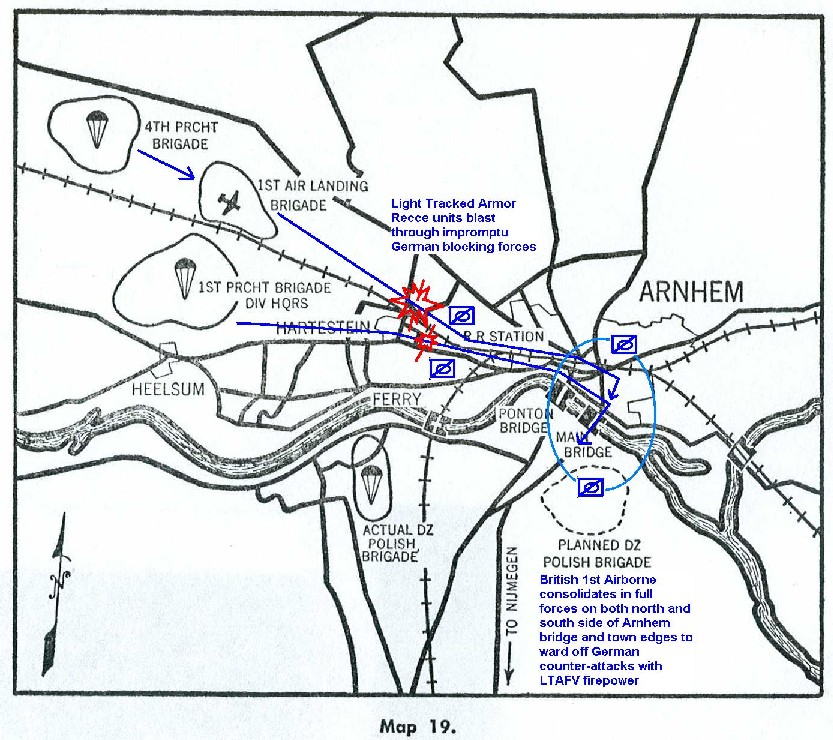
Moreover, the 1st British Airborne division had at least 13 x Hamilar gliders capable of delivering 13 light tanks or 26 Bren gun tankettes. We know for a fact that the 2d Battalion of the Paras had at least one Bren gun carrier, tracked AFV.
This was the D-Day allocation so more Hamilcars may have been available since 412 total were built during WW2. Proof that the Bitish Airborne had glider-landed 17-pounder, jeep-towed, anti-tank guns and Bren gun carriers:
www.pegasusarchive.org/arnhem/frames.htm
"The men of the Reconnaissance Squadron, together with one of the 2nd Battalion's Bren carriers, were to carry out this task, and Frost told Gough that it would be his chance to win his family's fifth Victoria Cross."
www.pegasusarchive.org/arnhem/war_1stBatt.htm
1400 - New positions consolidated in area X rds 726778. By now we were joined by 60 men of the 3 Para Bn under Capt Dorrien Smith, and 1 17 lb gun and 4 6 lb guns of 1 A.L. A/Tk Bty. We also had one carrier. This position was held against increasing opposition from the east and north.
1930 - Withdrawal to area railway bridge 712774. The night was spent in preparing posns with 1st Bn on the right, 11 Bn on left and 3 Bn in centre. During the night there was some enemy shelling and mortaring. Casualties during the day were about 6 killed and 20 wounded. The carrier and the 17 lb A/T gun were knocked out.
Unlike their brother 6th Airborne that landed at Normandy with Tetrarch light tanks, the 1st doesn't seem to have even had a reconnaissance element with light tanks. Jeeps with machine guns don't cut it against armored vehicles. First off, what the hell was the 6th Recce Squadron of the 6th Airborne Division doing in September 1944? Did they have something more pressing than say little ole' WW2? Why wasn't the 6th Recce Squadron which HAD LIGHT TANKS cross-attached to the British 1st Airborne seeing they would need their mobility and firepower to bust through the 6-8 miles to Arnhem if the Germans reacted with impromptu blocking forces? Why weren't Bren gun carriers modified to have 75mm pack howitzers in a ready-to-fire condition and supplied to Freddy Gough's Recce squadron in the 1st British Airborne since they only had vulnerable jeeps? Just a few Brens with 75mm guns could have taken out the two German armored cars and enabled the 3rd and 1st battalions to link up with Frost at Arnhem bridge on the first day, securing the victory and providing enough combat power to stay certainly until the 23rd when XXX Corps finally arrives at Driel, south of the bridge. According to the details below, the 1st Recce had 20mm cannon towed by their jeeps, why couldn't they have been employed against the German armored cars? The excerpt below from their Arnhem war diary indicates the Polsten 20mm guns were used in combat. Its clear that the inability of towed guns to fire instantly when threats are encounted DAMNED THE ENTIRE OPERATION.









www.pegasusarchive.org/arnhem/war_recce.htm
1645 - Polsten sections leave to support A and D Troops who are under strong pressure from the enemy. Section fire on their objective. Lieut Christie killed whilst attempting to save Jeep and Polsten.
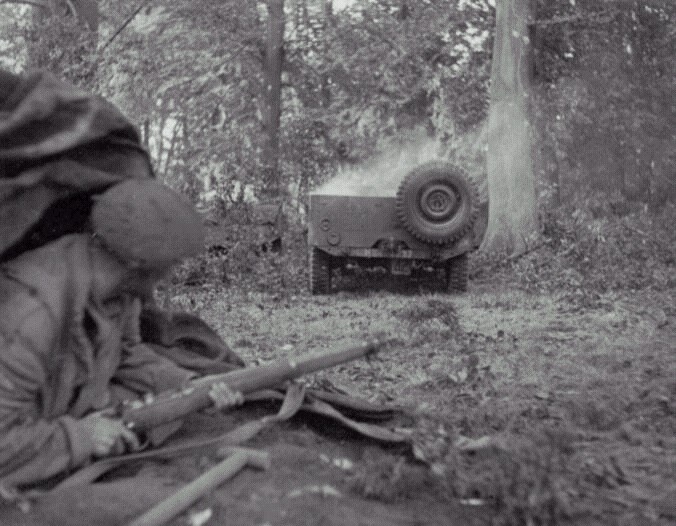
Vulnerable, unarmored jeeps are easy to knock out
www.airbornerecce.com/oca/1stars.htm
1st Airborne Reconnaissance SquadronA BRIEF HISTORY
"Leading the way (into Arnhem) would be a motorised reconnaissance squadron of jeeps and motorcycles. General Urquhart was counting on Major 'Freddie' Gough's highly specialised force of some 275 men in four troops - the only unit of its kind in the British Army - to reach the highway bridge and hold it until the main body of the brigade arrived "
Extract from A Bridge Too Far by Cornelius Ryan
The Squadrons' History
By April 1943 the Sqdn had been made up to strength of about 250 men and was stationed at Bulford near Andover when it left for North Africa via Liverpool on the troopship Staffordshire with the rest of the 1st Airborne Division. After a few days acclimatisation inland from Oran in Algeria the unit picked up its vehicles, jeeps and motorcycles. After a few more days the Jeeps and their drivers with Motorcycles and other unit gear in the trailers left on a 1000 mile trip to Msaken near Sousse in Tunisia. The rest of the unit went by train.
Training continued but was switched to loading gliders and towing them about the airfields to place them at the rear of the tug planes ready for the invasion of Sicily in July.
After returning to normal training, in September the Sqdn loaded its jeeps and m/cycles onto the famous light Cruiser USS BOISE because there were no gliders left after the Sicily drop. Also on board were 5 under-strength Sqdns of the SAS and 25 men of Popski's Private Army. With the British cruisers Penelope and Abdiel carrying the rest of the Division they entered Taranto Harbour to offload. Unfortunately, the Abdiel hit a mined barge and sank in the harbour losing much of the division's artillery and the Sqdn's 6 pounders. The Sqdn left straight away for its task of exploring the route to the Bari on the East Coast via Massafra and Motola to Gioia del Colle, running into some German opposition and suffering some casualties. After a brief stop the Sqdn moved on towards Bari where it was the first British Unit to enter the town and again after a brief stay moved on where it took the Airfield at Foggia. From then the Sqdn was especially active, being always in the front of the advance.
Amongst the losses were some men from B troop which was never reformed.
In November, the Sqdn moved back to North Africa and left Philippeville in Algeria, some on the (sick) Duchess of Bedfordshire (so called as she had no stabilisers and rolled alarmingly) and others on the Monarch of Bermuda getting back to the UK in time for Christmas. (Actually, the Duchess hit the Monarch in the Med - a Zig Zag went wrong - and the Monarch had to dock in Gibraltar for temporary repairs but still got back to the UK for Christmas)
After a very brief stay at Spalding the Sqdn moved to Ruskington just north of Sleaford in Lincolnshire and stayed there for the next 9 months until the battle of Arnhem in September.
In February 1944 Major Gough told the Sqdn that it had been decided that while its vehicles and drivers would go into their next operation in gliders the bulk of the Sqdn would have to jump and they would have to volunteer to be paratroops. (Most had been posted to the Sqdn as it was a glider unit, one had to volunteer to become a paratrooper). He told the parade that any man who did not wish to volunteer should take a step forward - and no one moved. Training took place at Ringway with jumps into Tatton Park and intensive training continued. The unit was retitled 'Airborne' - not 'Airlanding'.
In accordance with Recce policy the firepower of the jeeps was substantially upgraded. Every jeep had a Vickers "K" .303 caliber machine gun mounted with a round magazine holding 96 rounds. In addition they had 2 x 20mm Polsten cannons carried behind the jeep. The Polsten cannons were an Anti-Aircraft gun but due to its high firing rate was a very effective ground weapon. They also carried standard infantry weapons including two 3" mortars and 2" mortars, a Bren Light machine gun, standard rifles but with sniper sights, a PIAT (ant tank) gun and many and various hand grenades. Most men had a Sten submachine gun and the Radio Operators, a revolver.
There were several false alarms but at the end of August a seaborne party of some 40 men with the Sqdn transport vehicles left for France designed to collect and re-equip the Sqdn during its next battle.

Then on 17th September 1944, 45 men who had previously driven the Sqdns jeeps and motorcycles and heavy weapons and ammunition to Tarrant Rushton in Dorset flew in Gliders to the Dutch Town of Arnhem, where they were joined 30 minutes later by their 160 comrades who had flown from Barkston Heath Airfild, Lincolnshire and landed by parachute. Two of the 22 gliders (out of a total of 358) allocated to the Sqdn did not arrive so they only had 28 instead of 31 jeeps they should have had. Furthermore several of the Gliders on Landing crashed on the soft soil and it proved very difficult to get the vehicles and equipment out which meant that the Sqdn was quite a bit under strength 'HQ, D & C' Troops headed for the Bridge as a coup de main but were held up by "strong" German opposition and suffered several casualties. 'A' Troop had stayed behind as a reserve as planned. Unfortunately radio communications had broken down and when Freddie Gough got a message to say the General wanted to see him he left for Div HQ taking some of H Q Troop and a few from 'D' Troop with him, By the time he found the General the party he had left behind had returned to the D.Z. and when he left Div HQ, after several skirmishes, got to the bridge where the Sqdn was supposed to be and where there were remnants of several units. Our D.R. Chalky White was sent back to Div HQ and was probably the last man to leave the Bridge.
Those at the Bridge held out until Thursday morning 21st September when they had to surrender because they had no ammunition left. The remainder of the Sqdn under Captain Alsop fought on as part of the force at Oosterbeck from which a few of them (perhaps 2,000 of the original 10,000) escaped including about 30 of the Sqdn on Monday 25th September. That night the survivors met up with the Seaborne party and got new clothing and other gear and the next morning were flown back to the UK arriving back in Ruskington on Friday 29th September at about 9pm.
The full story of the battle of Arnhem is well known and the part the Sqdn played is well documented in the book Remember Arnhem: The Story of the 1st Airborne Reconnaissance Squadron at Arnhem by John Fairley. The seaborne party came back a few days later. The villagers were as devastated as the men by the terrible loses sustained. In fact the loses although high were not as bad as at first suspected and many had been wounded and they and the others who did not return, totalling some 140, were taken prisoners of war.
Shortly after their return of the 30 and the seaborne party, following a period of debriefing and two weeks disembarkation leave, the unit was allocated to barracks at Newark, Nottinghamshire, and reluctantly left Ruskington for ever.
During the winter reinforcements made up the strength to 160 and retraining began. On the 10th May 1945, two days after V E day the Squadron flew with its vehicles to Stavanger, Norway, and quickly moved to Oslo to help organise the withdrawal of German troops. Their mobility was needed to escort German units from some of the more rural areas and they also aided the new Norwegian authorities round up some of the Norwegians who had co operated with the Germans. Whilst they were there they took part in a parade with other Airborne Troops and Russians to welcome Crown Prince Olaf back to Norway after his exile. No medal was issued for this operation as the war in Europe had officially ended but Prince Olaf gave the Squadron a Signed Certificate of Thanks for their part in the difficult task they had successfully completed and members of the squadron who were there were issued with a copy.
In September, the Sqdn returned to the United Kingdom to Broham in Wiltshire from where it was disbanded about 4 years after its formation. The men were dispersed to various other units. The men who were wounded and who had been taken prisoner of war in Italy and at Arnhem returned to this country but not to the Sqdn.
www.airbornerecce.com/oca/6thaars.htm
The 6th Airborne Armoured Reconnaissance RGT. R.A.C.A brief history
"The role of the Light Tank Squadron will normally be the capture of an objective, in anticipation of a quick follow up by part of the Airborne Division, followed by patrolling infront of the main position.
It was agreed that the likelihood of heavy opposition would entail the withdrawal of the Squadron"
That was the role laid down in the unit manual but in fact the Unit used its tanks to defend troops against heavy enemy opposition and led the way of all British troops into Germany against the best enemy units.
In 1941 3 Special Service Squadrons of Tanks were formed from various cavalry and tank units but 2 were disbanded in 1942, the third becoming the Airborne Light Tank Sqdn RAC which moved to the 1st Airborne Division on the Salisbury Plain. When the 1st Airborne Div. With the 1st Airborne Recce Sqdn, went to Africa the Airborne Light Tank Sqdn which had used tetrarch tanks was transferred to the newly formed 6th Airborne Division. The Hamilcar Glider was designed to carry the Tetrarch Tank. Command of the squadron passed to Major (later Lt.Col.) Godfrey Stewart in April 1943, and he commanded the Squadron, and later the Regiment, for the remainder of the war.
Initialy the unit appears to have 3 Squadrons: A (light tank Sqdn) with 5 troops each with 4 Tetrarch tanks, B (Recce) with 4 troops with scout cars and carriers, a blitz (infantry support) troop on motorcycles and 2 troops of 3" mortars. HQ Squadron had 4 more Tetrarchs, REME, MEDICS, Signals, a resupply unit and 2 troops each with 4 Vickers MMGs. Regimental HQ also had 2 Tetrarchs.
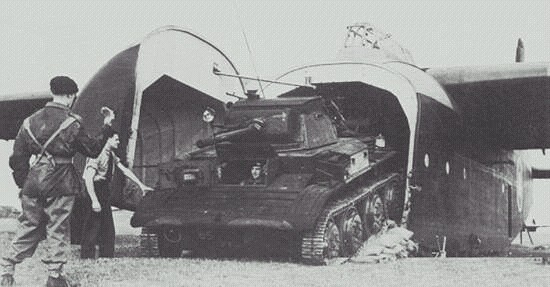
Tetrarch Light Tank being loaded into a Hamilcar Glider
On D Day a small "Harbour Party" of 1 Officer and 15 men flew in with the advance Pathfinder Para Unit to secure the Regimental landing ground. Unfortunately this unit lost its Officer and one stick of men on landing. 20 light tanks and other carriers and vehicles flew in with the second main lift from Tarant Rushton in 30 Hamilcars while others flew in from Brize Norton in Horsas. Some Tanks were lost due to a crash on landing and for a while some tanks were disabled as parachute canopies and rigging getting wrapped round the tracks which had to be burnt off. After 10 days the Unit was withdrawn but the tank units went straight back in their Tetrarchs to support the remaining hard-pressed ground troops. Once again the tank crews were withdrawn but after 10 days retraining went back in with Cromwell tanks and continued supporting the breakout. The Unit was taken out of the line at the end of August and by 6 Sept had regrouped at Larkhil.
There the Unit was enlarged to a Regiment of 4 Sqdns with a compliment of 32 officers and 326 other ranks. The 2 Recce Sqdns each had 4 [M22] Locust tanks when airborne or Cromwells otherwise, and 3 Recce Troops each with 2 carriers and 2 Dingo scout cars. The support Sqdn had 2 MMG troops with 4 Vickers on carriers, a troop with four 4.2" mortars, and a blitz troop on motorcycles.
In December 1944, the Division was sent to France to help with the Battle of the Bulge in the Ardennes and on Monday the 30th December the AARR was involved on the Meuse with the 6th A/B Div with their Cromwells. By 16th Feb the Rgt left for the UK but left a tail, including the Cromwells in Holland. The tail soon found out they were part of the ground force support of the next operation.
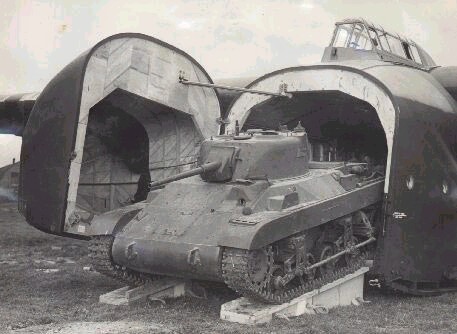
M22 Locust Light Tank
On 24th March, as part of Operation Varsity, 8 x Locust tanks were flown in in Hamilcars along with the troop of 4.2" mortars in Horsas. In fact less flew in "Varsity" than in the D-Day drop. Although the operation was a great success and the battle having been won by nightfall, casualties were very high and of the 8 tanks, only 2 survived fully serviceable. Several tanks and vehicles had been destroyed on landing and casualties were high. The rest of the Regiment had left on 17th March and joined up with the airborne sections on the 26th. The Division continued the advance with the Airborne Armoured Reconnaissance Regiment well to the fore and on several occasions suffered severe casualties, especially at a battle at Minden. On 30th April the Division reached the Elbe and on 3rd May elements of B Squadron met elements of the Russian Stalingrad Armoured Division. 2 days later the war was over and on 16th May the Division was ordered to return home, the Recce Rgt leaving all its Tanks and Carriers in Germany.
Training began for war in South East Asia but as the Japanese surrendered they were reallocated to security duties in Palestine. The Rgt landed in Haifa on 22 Oct 1945 and worked as part of the division facing civil disobedience by both Arabs and Jews and terrorism by Jews.
On 1st Feb the 6th AARR was disbanded and most of the personnel were transferred to the 3rd King's Own Hussars which became a Recce Rgt.
Hi there, Alecto!
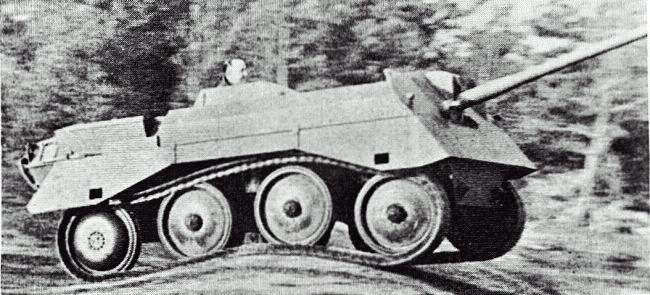

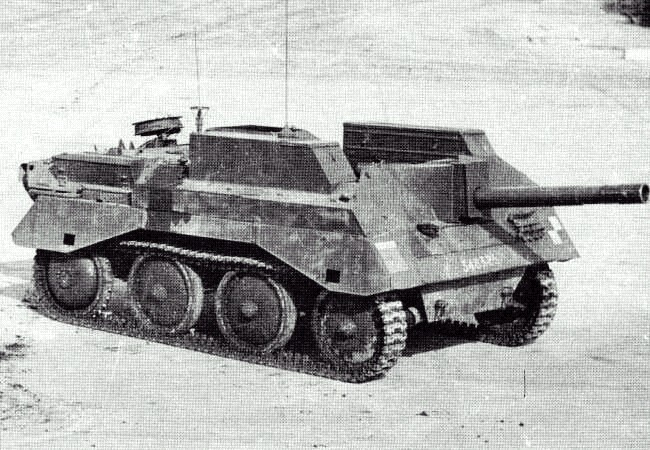
While steel is too heavy to enclose an infantry squad and have it light enough to be flown by WW2 piston-engined aircraft and gliders, what we could have done was build an open-topped, mini-STUG copy of the German Sturmgeshutz concept with a semi-fixed gun in the hull without a turret to save weight to be air-transportable--exactly---what the American and British Airborne should have done in WW2 by mounting at least a 6-pounder (57mm) anti-tank gun on a Bren gun or Tetrarch or Harry Hopkins light tank chassis (Alecto) and Hamilcar glider-landed them into Arnhem to punch through to reinforce LTC Frost's battalion at the bridge and kill even German Tiger heavy tanks when they appeared. Even heavy tank duelist, Keith Flint agrees in his classic and revelational book, Airborne Armour, pages 20-23:
To complete the story of the Harry Hopkins, it only remains to tell the story of the Alecto light self-propelled gun. This vehicle is of interest in what it showed that a self-propelled gun on a light tank chassis, carrying a worthwhile support weapon, was a practical idea that could have been adopted if thought necessary. Such sources as there are on this vehicle are reticent about when it was developed, and the best that can be said is that this took place around the last half of 1942 and the first half of 1943. The chassis of the Harry Hopkins was used as the basis for mounting a 95mm howitzer, with the project numbered A25 E2, and originally known as the Harry Hopkins 1 CS (i.e. close support). [28] The turret was removed and the gun mounted low in the hull, producing a very low overall profile whilst providing accommodation for a crew of four in an open-topped fighting compartment. The crew consisted of a commander, gunner, loader and driver. Although based on the Harry Hopkins chassis, the armour was completely rethought and reduced to minimum thickness (varying between 4mm and 10mm) presumably to keep weight within limits. [29] The weight of the vehicle was only 8 tons, but with a width identical to the Harry Hopkins there was no hope of carrying the Alecto in a Hamilcar. A traverse of 15 degrees either side of straight ahead was possible for the main armament. The vehicle apparently turned out to be highly mobile (road speed was quoted as 31 mph), and the gun packed a very worthwhile punch. The potential roles for the Alecto included replacing the half-track mounted 75mm guns which were used as support weapons in British reconnaissance regiments, and as an air portable weapon. Once again, it is surprising to read in surviving documents that grandiose plans to produce large numbers of Alectos were formulated. In August 1943, the War Office stated a requirement for 1100 "Harry Hopkins 95mm". By November of that year, the requirement for 1944-45 had risen to the extraordinary total of 2,900, with a note added to the effect that "effort should be taken to produce as nearly this quantity as possible". [30] This was a much larger number than could possibly have been justified by the roles already mentioned, but what use all these Alectos were to be put to is not stated.
A pilot model of an Alecto II with a 6pdr anti-tank gun was produced, and an Alecto III with a 25pdr gun and an Alecto IV with a massive 32pdr ant-tank weapon were proposed but never proceeded with. Small numbers of an Alecto Dozer were produced with the gun removed and a dozer blade added. All work on the Alecto ended in 1945 as the war came to an end. After the war a few Alectos were issued to replace the half-track mounted 75mm guns in the 'heavy troops' of recce units, but service was brief. [31] A modest diversion is called for here to describe two ideas that were put forward to try to squeeze a vehicle with worthwhile hitting power and/or armour into the Hamilcar. They are described by Michael Bowyer in articles which appeared in Airfix Magazine, and as I have been unable to find the original source documents describing these ideas, it will be as well to simply quote in full Bowyer's description:
What was in mind was a two seater amphibious vehicle carrying a 25pdr gun with recoilless ammunition and a .30 calibre Browning gun with 5000 rounds. There was also the Duplex tank consisting of two separate units connected by a cable. The forward vehicle would be heavily armoured and carry an anti-tank gun and crew, whilst the rear unit provided power from 300 yards aft. It was lightly armoured and provided motive power for both vehicles, the forward one being electrically driven via a cable.
The second proposal is ingenious, effectively dividing a tank into two and putting it into two separate Hamilcars. However, once the detail of how such an unlikely combination might actually be handled in action is considered, the idea loses most of its attraction. On the other hand, the self-propelled 25pdr seems a sensible enough idea, and raises the question of why a Tetrarch chassis was never used as the basis for an air-portable SP gun.
Although the Alecto chassis was a little wider and longer than the Tetrarch's, it would seem that a similar develpment of the latter tank into an SP gun was entirely possible, but never attempted. This would surely have offered a way to provide airborne troops with the mobile and (lightly) armoured support that the airborne tank project was originally supposed to provide.
With a bridgehead across the Rhine in September 1944, WW2 ends 6 months sooner without Russians getting to Berlin at all--no Battle of the Bulge casualties, no Iron Curtain Soviet domination for 45 years. Big strategic consequences for not having a few little light tanks, huh?
www.combatreform.org/airbornetanksnoexcuse.htm
But a 57mm gun on an open-topped tracked chassis would be a Russian ASU-57, wouldn't it?
Some criticize the British type of tank dedicated to infantry fire support. The Germans under the inspiration of Manstein had the same type of tank--but turretless, the STUG. We don't hear anyone criticizing them. The difference was that many pre-war and WW2 British officers thought that infantry fire support tanks to punch through lines for infantry and hold lines were the ONLY tanks we needed. Since that time, we have the heavy-tank-for-everything mentality that has to be a tank destroyer, breakthough tank, exploitation tank and when the "mech pussies" really feel vulnerable somehow act as cavalry/recon tanks. Is it a wonder that after all of these tasks are being considered that infantry fire support is neglected? The British and the Germans knew that they needed tanks DEDICATED for infantry direct-fire support and they were right then and they are correct today. Tank/Infantry co-operation today is pathetic with the heavy-tank-for-everything mentality. Reading the German STUG doctrine they realized that before an attack its not possible to target all the enemy threats and that commanders need a dedicated infantry heavy high explosive fire support tank force ready for unexpected threats to appear.
Allied Ground Combat Weaponry Available
WW2 Today
_____________________________________________________________________
Small arms .30 caliber (fire & maneuver) .223 caliber
Suppressive .30 and .50 caliber MMG/HMGs same
Everyone with Rifle grenades Select few with grenade launcher
Light/Medium/Heavy Mortars same ($ guided rounds maybe)
SP/Towed artillery (indirect fire saturation) same ($ guided rounds maybe)
Towed Anti-Tank Guns/Field Guns (AT defense/HE blasting) ATGMs ($)
Re-usable Bazooka rocket launchers (HE blasting) --
Disposable rocket launchers (stolen from Germans) AT4s
Medium breakthrough Sherman tanks (USA) --
Medium Churchill infantry support tanks (UK) --
Light STUG turretless tanks (Germany) --
Heavy breakthrough/defensive tank destroyers (Pershing) Abrams/Challenger
Observation/attack/liaison planes (L4s, P-47s, Typhoons) --
Naval gunfire support (cruisers, battleships) --
Light Units = No Bang for a Lot of Bucks
If you compare WW2 with today, we have far less "BANG" for a hell of a lot more $$$ (bucks). In an Army LBCT or a marine infantry battalion there are ZERO TANKS, none, nadda. Rephrase, there are NO metal boxes with tracks with metal tubes shooting shells with high explosives in them to blast things when in WW2 these things were plentiful. Before whining about attaching this or that and other ad hocery, if you attach an AAV or a Bradley or a Gavin to the LBCT/marine unit, they at best only shoot a tiny shell with HE fill, no building/bunker blasting. After WW2, we replaced the 1, 000 pound AT/field gun/howitzer with first recoilless rifles then ATGMs man-packed or mounted on flimsy, unarmored wheeled trucks in light units. In EVERY Army and marine unit I was a part of TOW ATGMs were so expensive we only shot live missiles once-a-year. Unless we went to a large training center like NTC/JRTC with MILES laser simulation, TOWs were not war practiced with realistic simulation at unit-level. Ditto this for disposable rockets and the select few that have a 40mm grenade launcher under their M16/M4 .223 caliber assault rifle/carbine. Walking infantry trucked to the "front" (line) or delivered by fixed-wing or helicopter aircraft to a non-linear battle area WITHOUT TANKS is PRE-WW1 force structure. If you had a time machine and sent an Army LBCT or marine infantry battalion to WW1 trenches to fight, THEY'D BE SLAUGHTERED. The 1918 WW1 "Tommy" or "Doughboy" with early tanks is better off than today's sunglasses-clad foot slogger with only what is in his hands to face enemy fire. You may say, "we don't fight in WW1 trenches anymore", are you sure? What is a city? What is urban combat? Is not fighting in a built-up area the equivalent or worse than WW1 trenches?
You can say, we'd attach some Abrams heavy tanks for fire support of the walking infantry. This is ad hocery. The crews have not worked with the infantry before, they only have 44 x 120mm shells and there is no HE plastic round, getting the HE fill round that blows up obstacles is not a certainty. The heavy tank dueler egomaniac doesn't give a crap about infantry fire support, he wants to kill other tanks (tank destroyer) and his heavy tank is designed to do this; 1000 degree heat from rear turbine engine means infantry cannot follow behind for close-in escort if doing FIBUA...no tank-infantry phone....too heavy and too wide to go many places without getting stuck.....
Heavy Units = Little Bang for a Lot of Bucks
In an Army HBCT we have our best force structure but its only good for open, firm terrain if we limit ourselves to the medium-to-heavy Bradleys and Abrams and not exploit the superior cross-country mobility of their M113 Gavins. The infantry that ride in back of Bradleys are awful due to the turret blocking them into a second-class security guards-for-tanks role. So if the HBCT does FIBUA if it needs to clear buildings it has "mech pussies" with little vigor to fight on their feet, so commanders "thunder run" keep everyone mounted and slice off sections of a city at a time fighting mounted "death before dismount" stereotype fulfilled. If we fight a smart enemy he could bait and draw in our cavalry-less HBCTs as their main bodies THINK they are thunder running into specially-prepared kill zones where close-range HE weapons like gunmen with RPGs will swarm them from all sides, forcing the weak mech, actually armored infantry to dismount where they will fight at a severe disadvantage. With tracked vehicles, the HBCT could rumble through barricaded cars and drive out of the kill zones if not blocked by land mines but they have failed if their mission was to seize the urban area. You could say we will truck up the LBCT/marine infantry to the FIBUA city and they will do a slightly better job fighting on foot and being turned into bleeding casualties. If that's what the enemy wants to do, which is delay us reaching his capital city to topple his government and/or bleed us, we've just played right into his hands.
Solutions Now
We can fix the lack of infantry direct fire support in Army LBCTs and the marines immediately today by supplying them M113 Gavins with TOW launchers and create an affordable "dumb" HE missile that is point/shoot without expensive guidance electronics in the nose to be the "male tank". Other Gavins can have 30mm autocannon on a remote 360 degree swiveling mount for suppressive HE fires as a "female tank". This is a 2-for-1 deal because not only do Gavins act as STUGs, they have space in the back to transport infantry under armor cross-country to include swimming across lakes/rivers, and with waterjets--in the ocean, ship-to-shore. C-27Js, C-130s, C-17s, C-5s and CH-47/CH-53E helicopters can transport Gavins. LBCTs with Gavins should have combat engineers permanently assigned to strengthen the defacto cavalry force that has been created. Army HBCTs can get a cavalry by replacing Humvees with Gavins and fully optimizing their engineers with specialized M113 variants with Hobart's Funny-type devices.
Landing Craft + Trailers + Trucks + Bren Gun Carriers = River Crossings
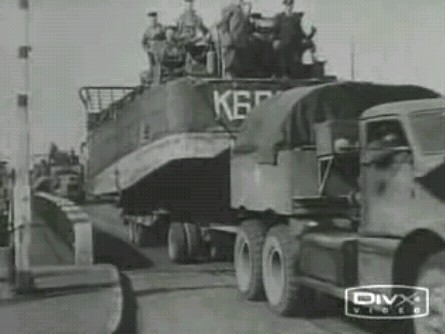
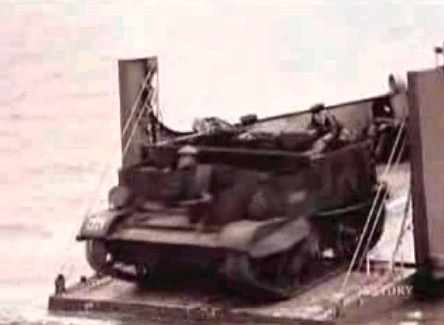
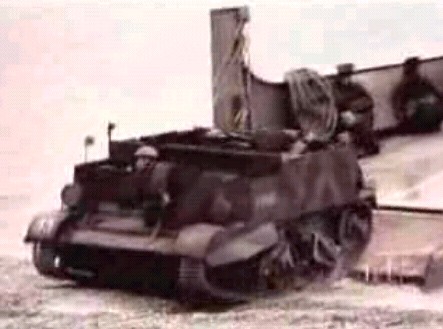
Another weird video fact is you can see Higgins boats---LCVPs on trailers towed by TRUCKS being driven around to cross rivers. Bren gun carriers could be carried and off-loaded by Higgins boats to cross rivers. Why didn't anyone think of this to cross the Rhine and push the Germans off the Arnhem bridge?
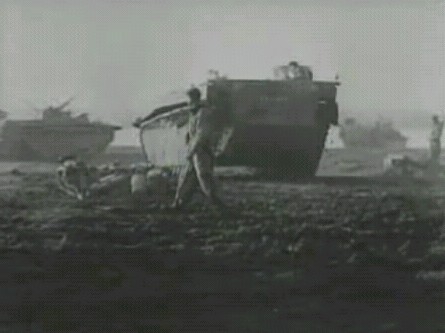
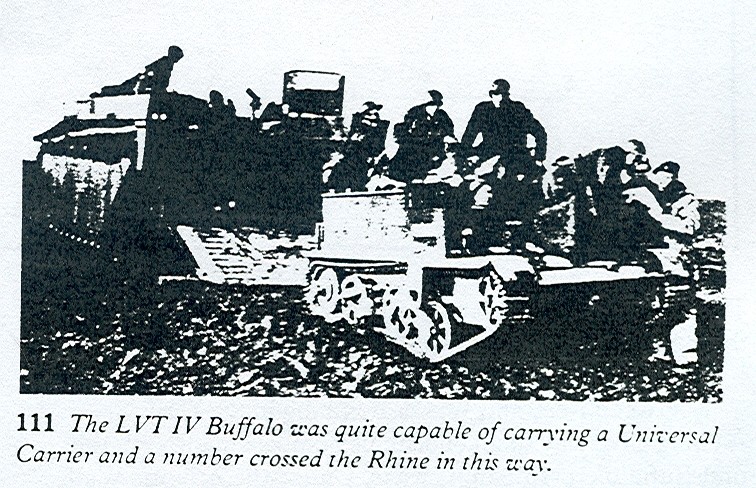
You'll also see LVTs and DUKWs in the video footage...WHERE were Percy Hobart's 79th Division "funnies" which had LVTs when Arnhem was underway to supply amphibious vehicles? LVTs could transport infantry, AT guns and even Bren gun APCs!
It could also then deliver a LIGHT TANK if it couldn't swim like the M3 Stuart Light tank attached and below on the www:
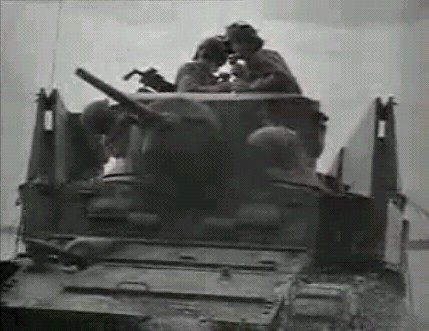
TRACKED AMPHIBIOUS SALVAGE OF OPERATION MARKET-GARDEN, 1944
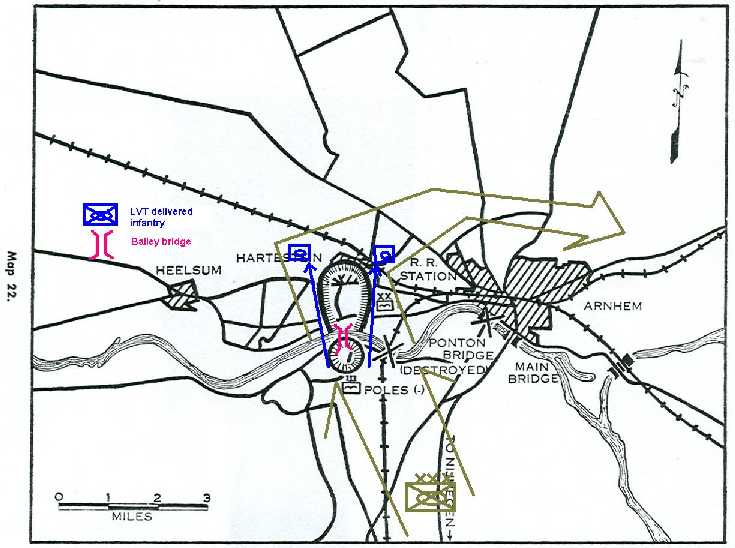
WW2 Mystery: A Bridge Too Far or We Didn't Go Far Enough? Part 4
Therefore, had XXX Corps been equipped with enough LVT amphibious tracks organically or by at least some sub-units of Hobart's 79th Armored Division being attached, when it finally did arrive at Driel on September 23, 1944 instead of withdrawing the 1st British Airborne, it could have pushed across and REINFORCED it. Once the toe-hold was strengthened, a Bailey bridge could have been erected for Sherman medium tanks with 17-pounder guns to cross and ward off the German heavy Tiger tanks and the offensive could have swung around the city of Arnhem and encircled the Germans like the paras were a few days before. Good land armies are able to cross rivers and keep maneuvering.
Of course, its better if your light tanks SWAM themselves across lakes/rivers like the M113 Gavin and PT76s can...the point here is that if your light tanks don't swim like the M8 Buford/Thunderbolt AGS you are not necessarily "sunk" if you are willing to pay for trucks or better yet XM1108 Gavin tracks towing a flat-bottom Higgins boat on a trailer to wherever the river or lake crossing is required so you can have FAR SHORE COMBAT POWER to hold against enemies with much heavier tanks if your light tank has the firepower to kill them. The combat engineer force reinforced by a CAVALRY in light tanks can seize a bridge from both sides 82nd Airborne @ Nijmegan-style or proceed to build their own bridges for the medium-to-heavy vehicles of a 2D maneuver force to cross.
Garrison was safe for post-war games/lifestyle! Contrary to popular mythology, the motorized infantry did not work that well and it was a dismal failure in Korea against a genuine MOBILE infantry that could go up/down mountains/hills. Task Force Smith had M24 light tanks that could have been flown in with them by USAF C-124s to ward off the North Korean T34/85s but they didn't even THINK OF IT. Infantry narcissism strikes again.
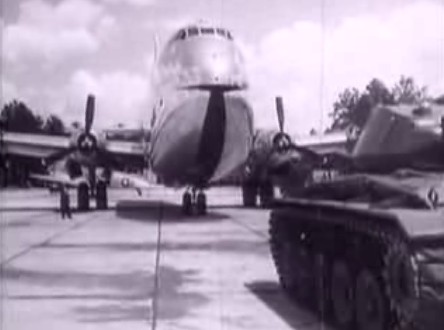
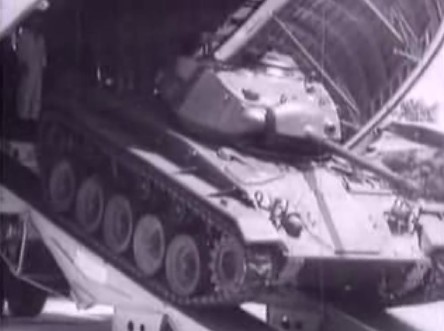
AUSA ILW THE, LAND WARFARE PAPERS No. 42 MAY 2003, "How We Got There: Air Assault and the Emergence of the 1st Cavalry Division (Airmobile), 1950-1965 by John M. Carland writes:
In the Korean conflict, American combat units lacked cavalry. Armor units, no matter what their unit designation, were too heavy and road-bound to be considered cavalry. Therefore, American forces were more likely to arrive on the battlefield "lastest with the leastest" than the more desirable "fustest with the mostest." Major General James M. Gavin, a senior officer with extensive airborne experience in World War II, vigorously made this point in his seminal piece of writing, "Cavalry-and I Don't Mean Horses," in 1954. He argued that America's lack of true cavalry in its military provided the common thread in explaining the nation's military defeats in the Korean War's early months.When North Korean forces invaded South Korea on 25 June 1950 and achieved almost complete surprise, what South Korean and American forces needed most was time to regroup and properly assess their predicament. How to do this? "The tactical situation called for a cavalry force," Gavin believed, "to be committed at once, to screen and delay, while the heavier infantry and armored forces built up a more substantial defense."
However, the United States/Republic of Korea force possessed no cavalry worth its name and therefore nothing to commit. [EDITOR: INCORRECT the 24th ID had M24 light tanks but chose not to use them] Then, on 15 September 1950, America turned the tables with the Inchon landings. At first, the American ploy succeeded brilliantly and North Korean forces disintegrated. "The situation screamed," wrote Gavin, "for highly mobile cavalry forces to exploit this unprecedented opening." Such forces could have moved quickly south to the Naktong River line to trap the North Koreans between the American units breaking out of the Pusan Perimeter and the cavalry moving toward them. Instead [he concluded], we took almost two weeks. . . . When the first breakout of our forces from the southern perimeter moved northward, it was a combined tank-truck column, essentially an infantry column limited in its performance by its road-bound equipment.
A cavalry arm-"airlifted in light planes, helicopters and assault-type aircraft"-to pursue the enemy and exploit the situation did not exist. A "debacle . . . a tragic chapter in our history" was the sad consequence. Next, on 26 November 1950 thirty Chinese divisions achieved "complete and overwhelming surprise" against the United Nations force that, as a result, suffered a terrible defeat. Again, that there was no cavalry to reconnoiter and gather intelligence explained precisely why the Chinese could surprise the Americans. [8]
Gavin attributed these failures to the "deification of heavy equipment" in World War II. American military leadership had deluded itself into believing that "heavy armor is cavalry." Consequently, noted Gavin, "we lost the cavalry when we mounted it in weighty tanks and trucks, all of which move (if the terrain will allow them to move at all) at exactly the same speed as motorized infantry, if not slower." He proposed that it might be possible to regain battlefield mobility and mobility differential through the use of assault transports such as light utility planes, helicopters, or convertiplanes.
General Gavin creates the M113, the "American STUG", greatest light tank of all time, ever
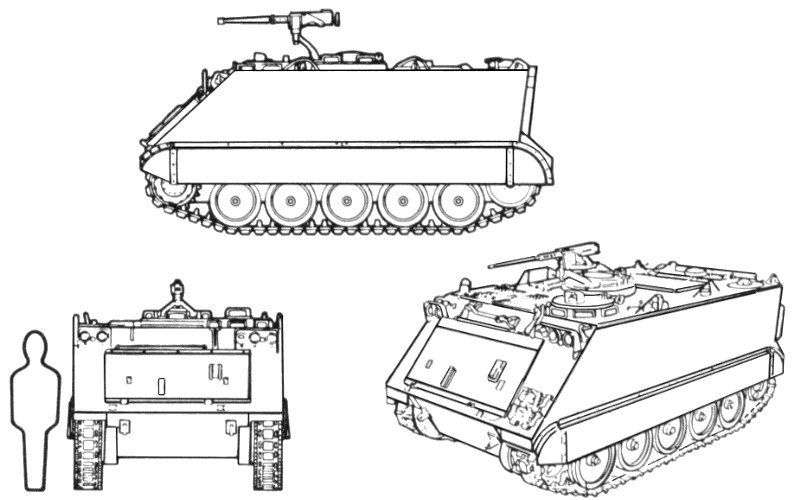
General Gavin and others began to for the first time really try to make a mobile infantry that FIGHTS MOBILE not just uses mobility means to get there and then fight without much mobility. He wrote:
"Where was the cavalry? ...and I don't mean horses. I mean helicopters and light aircraft, to lift Soldiers armed with automatic weapons and hand-carried light anti-tank weapons, and also lightweight reconnaissance vehicles, mounting anti-tank weapons the equal or better than the Russian T-34s...If ever in the history of our armed forces there was a need for the cavalry arm--airlifted in light planes, helicopters and assault-type aircraft--this was it... Only by exploiting to the utmost the great potential of flight can we combine complete dispersion in the defense with the facility of rapidly massing for the counter-attack which today's and tomorrow's Army must possess"
However, in the critical year of 1960, with General Gavin retired, the GARRISON Army generals refused to create a mobile infantry; they did not give M113s to the light units, they instead gave them to the units assigned to follow TANKS, creating a perceived inferior social underclass bogged down in VEHICLE CARE lumped in with the heavier M48/M60 medium tanks. The Garrison Army was safe to play garrison Army games, and so was the USMC. During WW2, the USMC had used open-topped "amtracks" to hit the beaches, with the advent of aluminum alloy armor, they could fully enclose the vehicle and use it for MOBILE warfare inland. No-can-do. "The USMC is walking line infantry, we are not going to give up two riflemen; a driver and a track commander---to move every rifle squad, we're gonna get at least 2 squads in every amtrack to cut down on costs and who's 'goldbricking' and not marching into battle." Enter the post-WW2 enclosed and bloated family of USMC amtracks that continues to the present day---they will only take marines ashore and then they'll walk, even though in every damn war necessity finds the bloated amtracks being used as defacto inland war APCs with disastrous results.
1961---------------------->Vietnam 1975---------------------------------1980
The helicopter turned out later in Vietnam to be nothing more than a conveyor of troops like the earlier transport plane, sea landing craft and wheeled truck. However, the urgencies of Vietnam resulted in units that should have had M113s all along, getting them and we created a kick-ass MOBILE infantry that routinely beat the VC and the NVA; the world's best light infantry---by superior all-terrain mobility over soft, muddy terrain and woods and in the face of enemy fire. Operating M113s did NOT make the troops become motor pool "pussies".
The Smoking Gun: Light Tanks/APCs More Mobile than Medium-Weight Ones, and M113 Gavins were the MOST effective weapon in soft open and vegetated closed terrain terrain Vietnam--NOT the helicopter
Noted armor historian and WW2 Hobart's "Funnies" (combat engineer tanks) combat veteran Major Kenneth Macksey wrote in his 1991 book, Tank versus Tank, page 167:
"The Vietnam War was a war dominated by infantry and firepower, in which AFVs, initially, were relegated to a limited part because the Vietnamese possessed virtually no tanks of their own and their enemies persisted in thinking of the struggle as a guerrilla war in country unsuitable to tanks. Not until 1967, when the United States carried out a feasibility study, was it discovered that tanks could move in 61 per cent of the country during the dry season and in 46 per cent in the wet; and that APCs could move in 65 per cent of Vietnam all year round. Thereafter the forces of South Vietnam rapidly raised their armor content to be matched only meagerly, however, by their opponents. As a result, AFVs were almost entirely employed in support of infantry; the principal threat to them was posed by mines and infantry anti-tank weapons, including ATGW. Yet AFVs were rated the most cost-effective weapon system for a country where the helicopter was enjoying a great vogue on the battlefield."
What this means is as follows:
M113 Gavins (light tank/APCs) 8 PSI ground pressure = 65% of Vietnam dry/wet 24/7/365
M48 Pattons (medium tanks) 11.2-12.2 PSI * ground pressure = 46% of Vietnam wet season
.............................................................................................................61% of Vietnam dry season
A light mechanized infantry with M113 Gavin light tank/APCs would fight mounted and/or with these vehicles nearby rendering fire support and ammunition, water, food transport 65% of everywhere to include swimming across lakes/rivers; only 35% of the terrain was dismounted foot-travel only--we fight the enemy from positions of overmatching SUPERIORITY with more firepower and units of fire, as well protection from his fires.
If we medium-mechanize or motorize with high ground pressure FCS 30-ton tanks (12 PSI) or 20-ton Stryker truck (30 PSI) wheels 54% of a soft, wet terrain like Vietnam will be NO-GO to them and be enclaves for the ENEMY to reside in safety lest we fight them M16 vs. AK47 & RPG even or at a disadvantage. The enemy could attack us during the wet winters and withdraw without fear of us pursuing them lest we get stuck or stick to roads where they ambush us with land mines. The FCS will only be mobile in firm, open terrain types, and the Stryker, road-bound unless very firm, dry, open terrain is available. Neither FCS or Strykers can swim.
Sub-Notes
* http://afvdb.50megs.com/usa/m48patton.html
The M113 Gavins were so simple to operate folks wrongly assumed that if they were needed they'd be assigned ad hoc and THE PERMANENT ORGANIZATIONAL CHANGES NEEDED TO CREATE A MOBILE INFANTRY WERE NOT DONE. If you wanted to play garrison "From Here to Eternity" games and own/operate M113s you could. The only excuse left was the ego card, and both the "heavy" tankers and the "light" infantry weighed in.
The WW2 tankers led by Starry with Soviet tank terror on their minds got an American Tiger heavy, defensive, big gun "male" tank to stop them on the Fulda gap. However, they still had swarms of Soviet infantry to kill in BMPs, and a M113 even with a BMP-killing autocannon would not do (AIFV) for their schemes. They didn't want infantry all over the place doing its own thing, they wanted just enough infantry to protect THEM and their tanks, so they created a "female" tank with space for a few security guards, the Bradley.
The lightfighters decided they needed a "pure" foot line infantry force using the limited USAF C-141 airlift excuse to create a whole culture of folks doing the garrison BS they wanted to do, yearning for easy war opportunities which came later in Grenada (1983) and Panama (1989). There were some smart lightfighters who remembered how well light tanks worked in Vietnam and kept it going with the 3/73rd Armor BN's M551 Sheridans, using borrowed M113s at places like NTC and JRTC but the MTOEs were never changed to make infantry mobile and have the long-term use to see new possibilities like "Air-Meching" them by USAF fixed-wing and army rotary-wing aircraft.
1981------------------------>1993-----------------------------------2000
Bradley disease kicks in; a 25-33 ton tank that can't fly by C-130 much less helicopters, can't swim, can't go cross-country at will without getting stuck. During Operation Desert Storm in Iraq, M113 Gavins had to lead the way because Humvee trucks are too vulnerable and Bradleys not mobile enough--the U.S. Army already has its "Future Scout Vehicle" (FSV)--upgrading its M113s with high technology will make them even better! Everything Captain Tien wants for the FSV (shoot-on-move, stabilized weapons, thermal vision etc.) can be applied TODAY to existing M113 Gavins!
www.youtube.com/view_play_list?p=0E16A4FB15A2B484
www.youtube.com/v/RbWbkOkTydk&hl
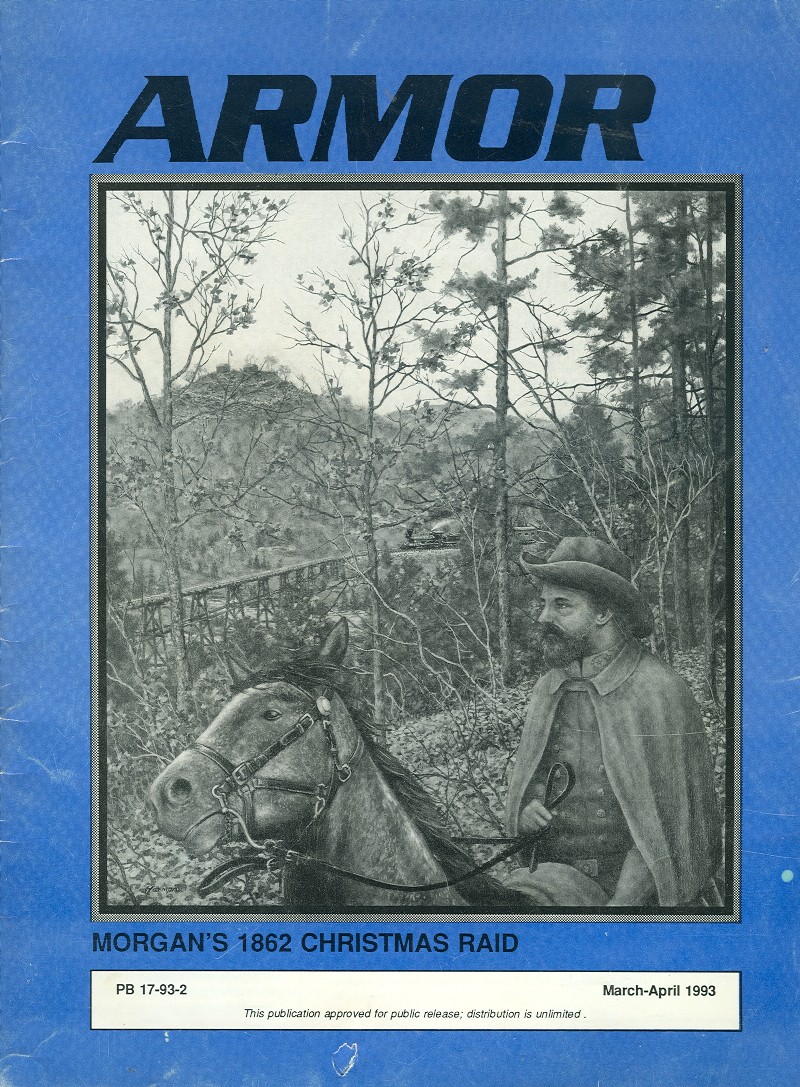
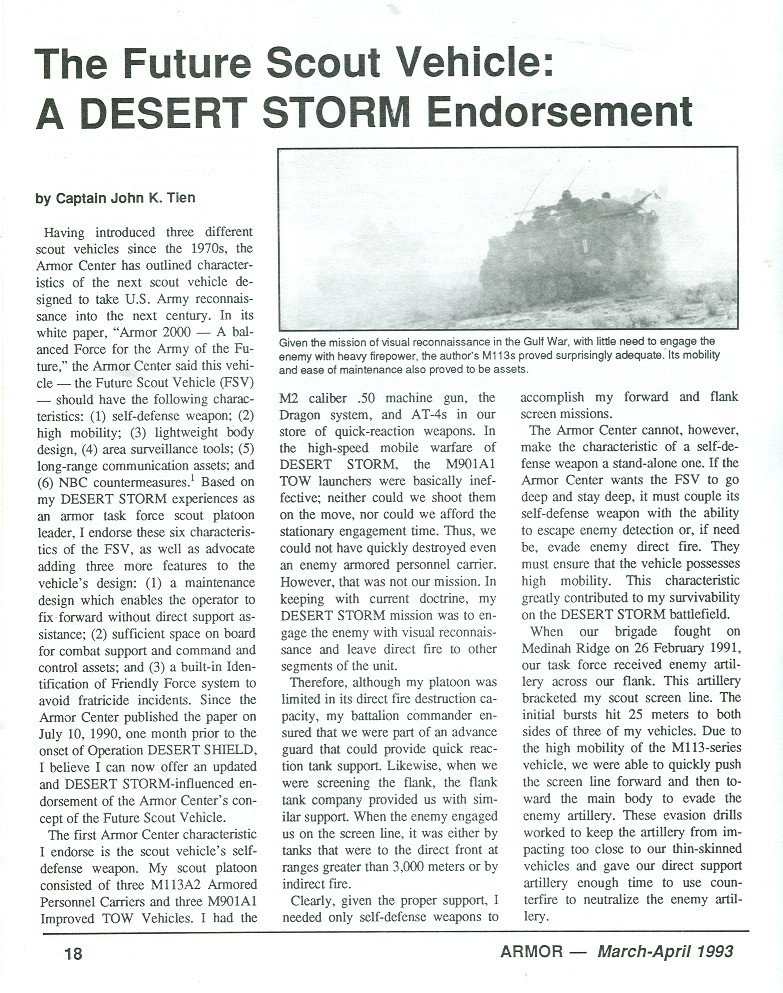
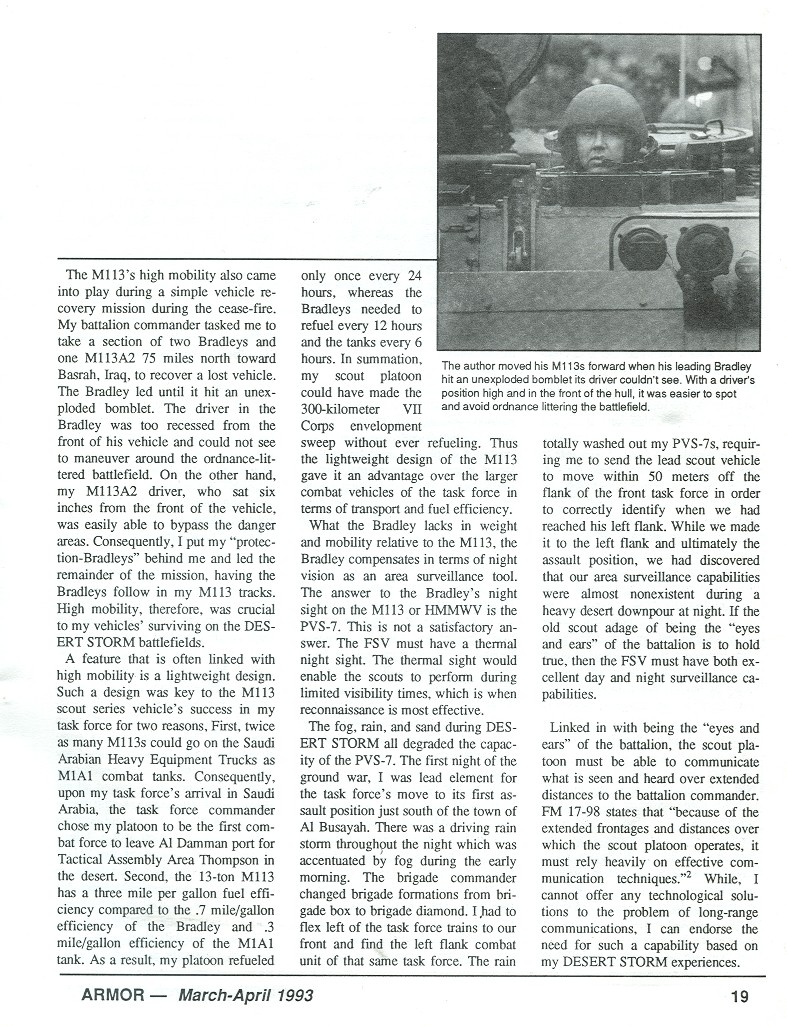
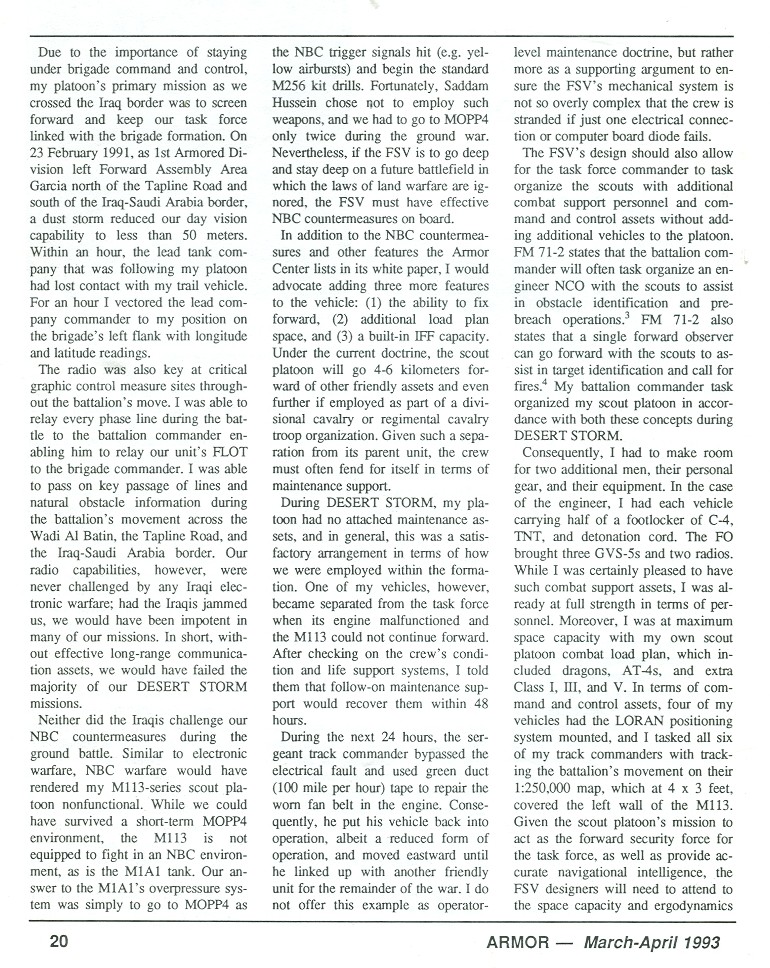
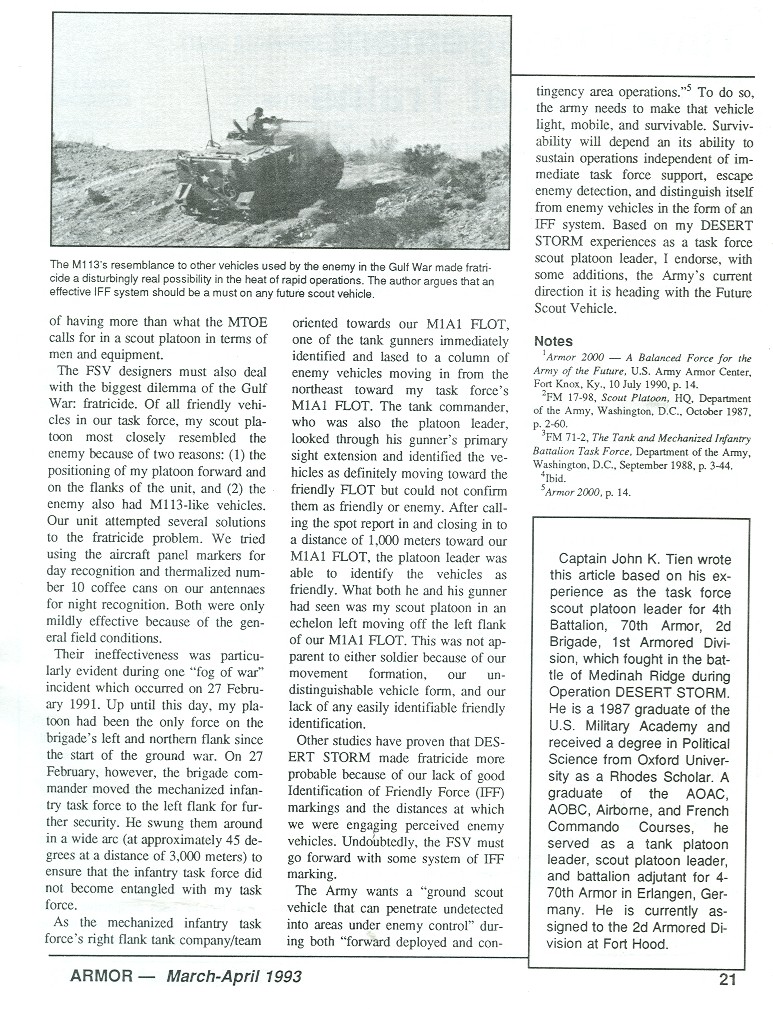
U.S. Army ARMOR Magazine - March-April 1993The Future Scout Vehicle: A DESERT STORM Endorsement
by Captain John K. Tien
Having introduced three different scout vehicles since the 1970s, the Armor Center has outlined characteristics of the next scout vehicle designed to take U.S. Army reconnaissance into the next century. In its white paper, "Armor 2000 - A balanced Force for the Army of the Future," the Armor Center said this vehicle - the Future Scout Vehicle (FSV) - should have the following characteristics: (1) self-defense weapon; (2) high mobility; (3) lightweight body design, (4) area surveillance tools; (5) long-range communication assets; and (6) NBC countermeasures.[1] Based on my DESERT STORM experiences as an armor task force scout platoon leader, I endorse these six characteristics of the FSV, as well as advocate adding three more features to the vehicle's design: (1) a maintenance design which enables the operator to fix. forward without direct support assistance; (2) sufficient space on board for combat support and command and control assets; and (3) a built-in Identification of Friendly Force system to avoid fratricide incidents. Since the Armor Center published the paper on July 10, 1990, one month prior to the onset of Operation DESERT SHIELD, I believe I can now offer an updated and DESERT STORM-influenced endorsement of the Armor Center's concept of the Future Scout Vehicle.
The first Armor Center characteristic I endorse is the scout vehicle's self defense weapon. My scout platoon consisted of three M113A2 Armored Personnel Carriers and three M901Al Improved TOW Vehicles. I had the
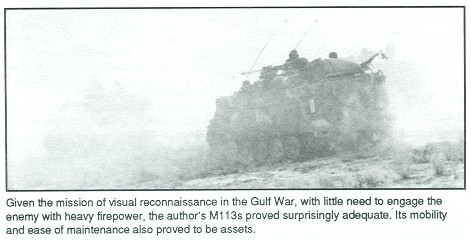
Given the mission of visual reconnaissance in the Gulf War, with little need to engage the enemy with heavy firepower, the author's M113s proved surprisingly adequate: Its mobility and ease of maintenance also proved to be assets.
M2 caliber .50 [heavy] machine gun, the Dragon [anti-tank guided missile] system, and AT-4s in our store of quick-reaction weapons. In the high-speed mobile warfare of DESERT STORM, the M901A1 TOW launchers were basically ineffective; neither could we shoot them on the move, nor could we afford the stationary engagement time. Thus, we could not have quickly destroyed even an enemy armored personnel carrier.
However, that was not our mission. In keeping with current doctrine, my DESERT STORM mission was to engage the enemy with visual reconnaissance and leave direct fire to other segments of the unit.
Therefore, although my platoon was limited in its direct-fire destruction capacity, my battalion commander ensured that we were part of an advance guard that could provide quick reaction tank support. Likewise, when we were screening the flank, the flank tank company provided us with similar support. When the enemy engaged us on the screen line, it was either by tanks that were to the direct front at ranges greater than 3,000 meters or by indirect fire. Clearly, given the proper support, I needed only self-defense weapons to accomplish my forward and flank screen missions.
The Armor Center cannot, however, make the characteristic of a self-defense weapon a stand-alone one. If the Armor Center wants the FSV to go deep and stay deep, it must couple its self-defense weapon with the ability to escape enemy detection or, if need be, evade enemy direct fire. They must ensure that the vehicle possesses high mobility. This [M113 Gavin] characteristic greatly contributed to my survivability on the DESERT STORM battlefield.
When our brigade fought on Medinah Ridge on 26 February 1991, our task force received enemy artillery across our flank. This artillery bracketed my scout screen line. The initial bursts hit 25 meters to both sides of three of my vehicles. Due to the high mobility of the M113-series vehicle, we were able to quickly push the screen line forward and then toward the main body to evade the enemy artillery. These evasion drills worked to keep the artillery from impacting too close to our thin-skinned vehicles and gave our direct support artillery enough time to use counterfire to neutralize the enemy artillery.
Page 18
The M113's high mobility also came into play during a simple vehicle recovery mission during the cease-fire.
My battalion commander tasked me to take a section of two Bradleys and one M113A2, 75 miles north toward Basrah, Iraq, to recover a lost vehicle.
The Bradley led until it hit an unexploded bomblet. The driver in the Bradley was too recessed from the front of his vehicle and could not see to maneuver around the ordnance-littered battlefield. On the other hand, my M113A2 driver, who sat six inches from the front of the vehicle, was easily able to bypass the danger areas. Consequently, I put my "protection-Bradleys" behind me and led the remainder of the mission, having the Bradleys follow in my M113 tracks. High mobility, therefore, was crucial to my vehicles' surviving on the DESERT STORM battlefields.
A feature that is often linked with high mobility is a lightweight design. Such a design was key to the M113 scout series vehicle's success in my task force for two reasons, First, twice as many M113s could go on the Saudi Arabian Heavy Equipment Trucks as M1A1 combat tanks. Consequently, upon my task force's arrival in Saudi Arabia, the task force commander chose my platoon to be the first combat force to leave Al Damman port for Tactical Assembly Area Thompson in the desert. Second, the 13-ton M113 has a three mile per gallon fuel efficiency compared to the 0.7 mile/gallon efficiency of the Bradley and 0.3 mile/gallon efficiency of the M1A1 tank. As a result, my platoon refueled only once every 24 hours, whereas the Bradleys needed to refuel every 12 hours and the tanks every 6 hours. In summation, my scout platoon could have made the 300-kilometer VII Corps envelopment sweep without ever refueling. Thus, the lightweight design of the M113 gave it an advantage over the larger combat vehicles of the task force in terms of transport and fuel efficiency.
What the Bradley lacks in weight and mobility relative to the M113, the Bradley compensates in terms of night vision as an area surveillance tool. The answer to the Bradley's night sight on the M113 or HMMWV is the PVS-7. This is not a satisfactory answer. The FSV must have a thermal night sight. The thermal sight would enable the scouts to perform during limited visibility times, which is when reconnaissance is most effective.
The fog, rain, and sand during DESERT STORM all degraded the capacity of the PVS-7. The first night of the ground war, I was lead element for the task force's move to its first assault position just south of the town of Al Busayah. There was a driving rain storm throughout the night which was accentuated by fog during the early morning. The brigade commander changed brigade formations from brigade box to brigade diamond. I had to flex left of the task force trains to our front and find the left flank combat unit of that same task force. The rain
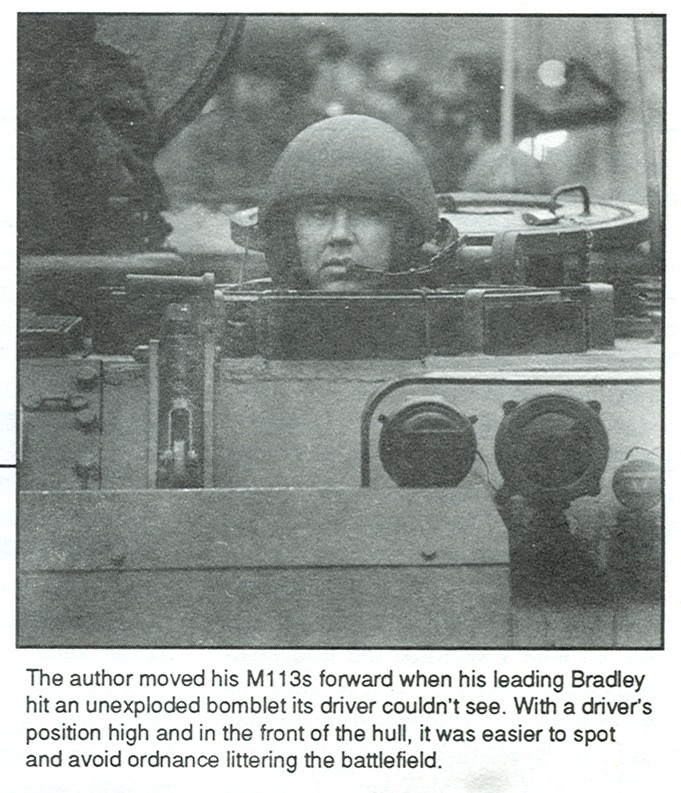
The author moved his M113s forward when his leading Bradley hit an unexploded bomblet its driver couldn't see. With a driver's position high and in the front of the hull, it was easier to spot and avoid ordnance littering the battlefield.
totally washed out my PVS-7s, requiring me to send the lead scout vehicle to move within 50 meters off the flank of the front task force in order to correctly identify when we had reached his left flank. While we made it to the left flank and ultimately the assault position, we had discovered that our area surveillance capabilities were almost nonexistent during a heavy desert downpour at night. If the old scout adage of being the "eyes and ears" of the battalion is to hold true, then the FSV must have both excellent day and night surveillance capabilities.
Linked in with being the "eyes and ears" of the battalion, the scout platoon must be able to communicate what is seen and heard over extended distances to the battalion commander. FM 17-98 states that "because of the extended frontages and distances over which the scout platoon operates, it must rely heavily on effective communication techniques." [2] While, I cannot offer any technological solutions to the problem of long-range communications, I can endorse the need for such a capability based on my DESERT STORM experiences.
Page 19
Due to the importance of staying under brigade command and control, my platoon's primary mission as we crossed the Iraq border was to screen forward and keep our task force linked with the brigade formation. On 23 February 1991, as 1st Armored Division left Forward Assembly Area Garcia north of the Tapline Road and south of the Iraq-Saudi Arabia border, a dust storm reduced our day vision capability to less than 50 meters. Within an hour, the lead tank company that was following my platoon had lost contact with my trail vehicle. For an hour I vectored the lead company commander to my position on the brigade's left flank with longitude and latitude readings.
The radio was also key at critical graphic control measure sites throughout the battalion's move. I was able to relay every phase line during the battle to the battalion commander enabling him to relay our unit's FLOT to the brigade commander. I was able to pass on key passage of lines and natural obstacle information during the battalion's movement across the Wadi Al Batin, the Tapline Road, and the Iraq-Saudi Arabia border. Our radio capabilities, however, were never challenged by any Iraqi electronic warfare; had the Iraqis jammed us, we would have been impotent in many of our missions. In short, without effective long-range communication assets, we would have failed the majority of our DESERT STORM missions.
Neither did the Iraqis challenge our NBC countermeasures during the ground battle. Similar to electronic warfare, NBC warfare would have rendered my M113-series scout platoon nonfunctional. While we could have survived a short-term MOPP4 environment, the M113 is not equipped to fight in an NBC environment, as is the M1A1 tank. Our answer to the M1A1's overpressure system was simply to go to MOPP4 as
Page 20
the NBC trigger signals hit (e.g. yellow airbursts) and begin the standard M256 kit drills. Fortunately, Saddam Hussein chose note to employ such weapons, and we had to go to MOPP4 only twice during the ground war.
Nevertheless, if the FSV is to go deep and stay deep on a future battlefield in which the laws of land warfare are ignored, the FSV must have effective NBC countermeasures on board.
In addition to the NBC countermeasures and other features the Armor Center lists in its white paper, I would advocate adding three more features to the vehicle: (1) the ability to fix forward, (2) additional load plan space, and (3) a built-in IFF capacity.
Under the current doctrine, the scout platoon will go 4-6 kilometers forward of other friendly assets and even further if employed as part of a divisional cavalry or regimental cavalry troop organization. Given such a separation from its parent unit, the crew must often fend for itself in terms of maintenance support.
During DESERT STORM, my platoon had no attached maintenance assets, and in general, this was a satisfactory arrangement in terms of how we were employed within the formation. One of my vehicles, however, became separated from the task force when its engine malfunctioned and the M113 could not continue forward.
After checking on the crew's condition and life support systems, I told them that follow-on maintenance support would recover them within 48 hours. During the next 24 hours, the sergeant track commander bypassed the electrical fault and used green duct (100 mile per hour) tape to repair the worn, fan belt in the engine. Consequently, he put his vehicle back into operation, albeit a -reduced form of operation, and moved eastward until he linked up with another friendly unit for the remainder of the war. I do not offer this example as operator-level maintenance doctrine, but rather more as a supporting argument to ensure the FSV's mechanical system is not so overly complex that the crew is stranded if just one electrical connection or computer board diode fails. The FSV's design should also allow for the task force commander to task organize the scouts with additional combat support personnel and command and control assets without adding additional vehicles to the platoon.
FM 71-2 states that the battalion commander will often task organize an engineer NCO with the scouts to assist in obstacle identification and pre-breach operations. [3] PM 71-2 also states that a single forward observer can go forward with the scouts to assist in target identification and call-for-fires. [4] My battalion commander task organized my scout platoon in accordance with both these concepts during DESERT STORM.
Consequently, I had to make room for two additional men, their personal gear, and their equipment. In the case of the engineer, I had each vehicle carrying half of a footlocker of C-4, TNT, and detonation cord. The FO brought three GVS-5s [laser target designators] and two radios.
While I was certainly pleased to have such combat support assets, I was already at full strength in terms of personnel. Moreover, I was at maximum space capacity with my own scout platoon combat load plan, which included Dragons, AT-4s, and extra Class I, III, and V. In terms of command and control assets, four of my vehicles had the LORAN positioning system mounted, and I tasked all six of my track commanders with tracking the battalion's movement on their 1:250,000 map, which at 4 x 3 feet, covered the left wall of the M113.
Given the scout platoon's mission to act as the forward security force for the task force, as well as provide accurate navigational intelligence, the FSV designers will need to attend to the space capacity and ergodynamics
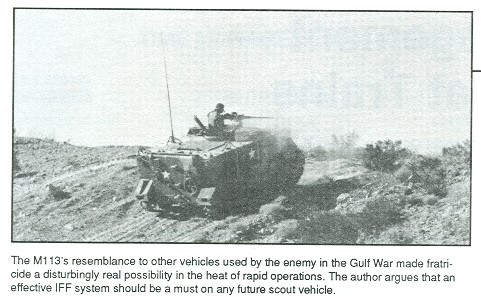
The M113's resemblance to other vehicles used by the enemy in the Gulf War made fratricide a disturbingly real possibility in the heat of rapid operations. The author argues that an effective IFF system should be a must on any future scout vehicle.
of having more than what the MTOE calls for in a scout platoon in terms of men and equipment.
The FSV designers must also deal with the biggest dilemma of the Gulf War: fratricide. Of all friendly vehicles in our task force, my scout platoon most closely resembled the enemy because of two reasons: (1) the positioning of my platoon forward and on the flanks of the unit, and (2) the enemy also had M113-like vehicles. Our unit attempted several solutions to the fratricide problem. We tried using the aircraft panel markers for day recognition and thermalized number 10 coffee cans on our antennas for night recognition. Both were only mildly effective because of the general field conditions.
Their ineffectiveness was particularly evident during one "fog of war" incident which occurred on 27 February 1991. Up until this day, my platoon had been the only force on the brigade's left and northern flank since the start of the ground war. On 27 February, however, the brigade commander moved the mechanized infantry task force to the left flank for further security. He swung them around in a wide arc (at approximately 45 degrees at a distance of 3,000 meters) to ensure that the infantry task force did not become entangled with my task force.
As the mechanized infantry task force's right flank tank company/team oriented towards our M1A1 FLOT, one of the tank gunners immediately identified and lased to a column of enemy vehicles moving in from the northeast toward my task force's M1A1 FLOT. The tank commander, who was also the platoon leader, looked through his gunner's primary sight extension and identified the vehicles as definitely moving toward the friendly FLOT but could not confirm them as friendly or enemy. After calling the spot report in and closing in to a distance of 1,000 meters toward our M1A1 FLOT, the platoon leader was able to identify the vehicles as friendly. What both he and his gunner had seen was my scout platoon in an echelon left moving off the left flank of our M1A1 FLOT. This was not apparent to either Soldier because of our movement formation, our undistinguishable vehicle form, and our lack of any easily identifiable friendly identification.
Other studies have proven that DESERT STORM made fratricide more probable because of our lack of good Identification of Friendly Force (IFF) markings and the distances at which we were engaging perceived enemy vehicles. Undoubtedly, the FSV must go forward with some system of IFF marking.
The Army wants a "ground scout vehicle that can penetrate undetected into areas under enemy control" during both "forward deployed and contingency area operations." To do so, the army needs to make that vehicle light, mobile, and survivable. Survivability will depend an its ability to sustain operations independent of immediate task force support, escape enemy detection, and distinguish itself from enemy vehicles in the form of an IFF system. Based on my DESERT STORM experiences as a task force scout platoon leader, I endorse, with some additions, the Army's current direction it is heading with the Future Scout Vehicle.
Notes
1. Armor 2000 - A Balanced Force for the Army of the Future. U.S. Army Annor Center, Fort Knox. Ky., 10 July 1990, p. 14.
2. FM 17-98, Scout Platoon. HQ, Department of the Army, Washington, D.C., October 1987, p. 2-60.
3. FM 71-2, The Tank and Mechanized Infantry Battalion Task Force. Department of the Army, Washington, D.C., September 1988, p. 3-44.
4. Ibid.
5. Armor 2000. p. 14.
-------------------
Captain John K. Tien wrote this article based on his experience as the task force scout platoon leader for 4th Battalion, 70th Armor, 2nd Brigade, 1st Armored Division, which fought in the battle of Medinah Ridge during Operation DESERT STORM.
He is a 1987 graduate of the U.S. Military Academy and received a degree in Political Science from Oxford University as a Rhodes Scholar. A graduate of the AOAC, AOBC, Airborne, and French Commando Courses, he served as a tank platoon leader, scout platoon leader, and battalion adjutant for 470th Armor in Erlangen, Germany. He is currently assigned to the 2nd Armored Division at Fort Hood.
Why would we want to be in a thinly or non-armored, wheeled truck that is permanently wed to roads/trails offering not even armor or firepower advantages?
The wise military commander does not want wheeled trucks even on roads because without any cover from enemy fires you need every ounce of protection you can get. NOT ROAD SPEED which has been proven not nearly fast enough to evade a roadside bomb explosion with fragments flying at 30,000 feet per second. In open terrain you cannot afford to squander 28% of your armor potential by using rubber tire wheels. So for roads which are actually OPEN TERRAIN you need the heaviest tracked tanks with the heaviest/best armor protection possible that with steel tracks with rubber pads or rubber band tracks can travel up/down without tearing the pavement up. As said before, a light tracked cavalry should proceed this main body to make first contact with the enemy and to hold them by the nose or at the least report back and find a cross-country route via trial/error the heavier main body vehicles can take to hit the enemy in the flanks. Up-engined M113A3 Gavins are far more mobile than 33-ton Bradleys and even under-powered A2 Gavins are more mobile in closed terrains than Bradleys to be light mechanized cavalry.
This is what the M113 Gavin-based 197th Infantry Brigade did for the 24th ID in Desert Storm so well. If this is not possible, the medium to heavy tracked tanks can go up the middle and hit the enemy frontally with the best armor and firepower possible to hopefully breakthrough.
Light Tanks Lead the Way in Desert Storm: M113 Gavin 197th Light Mechanized Infantry Brigade
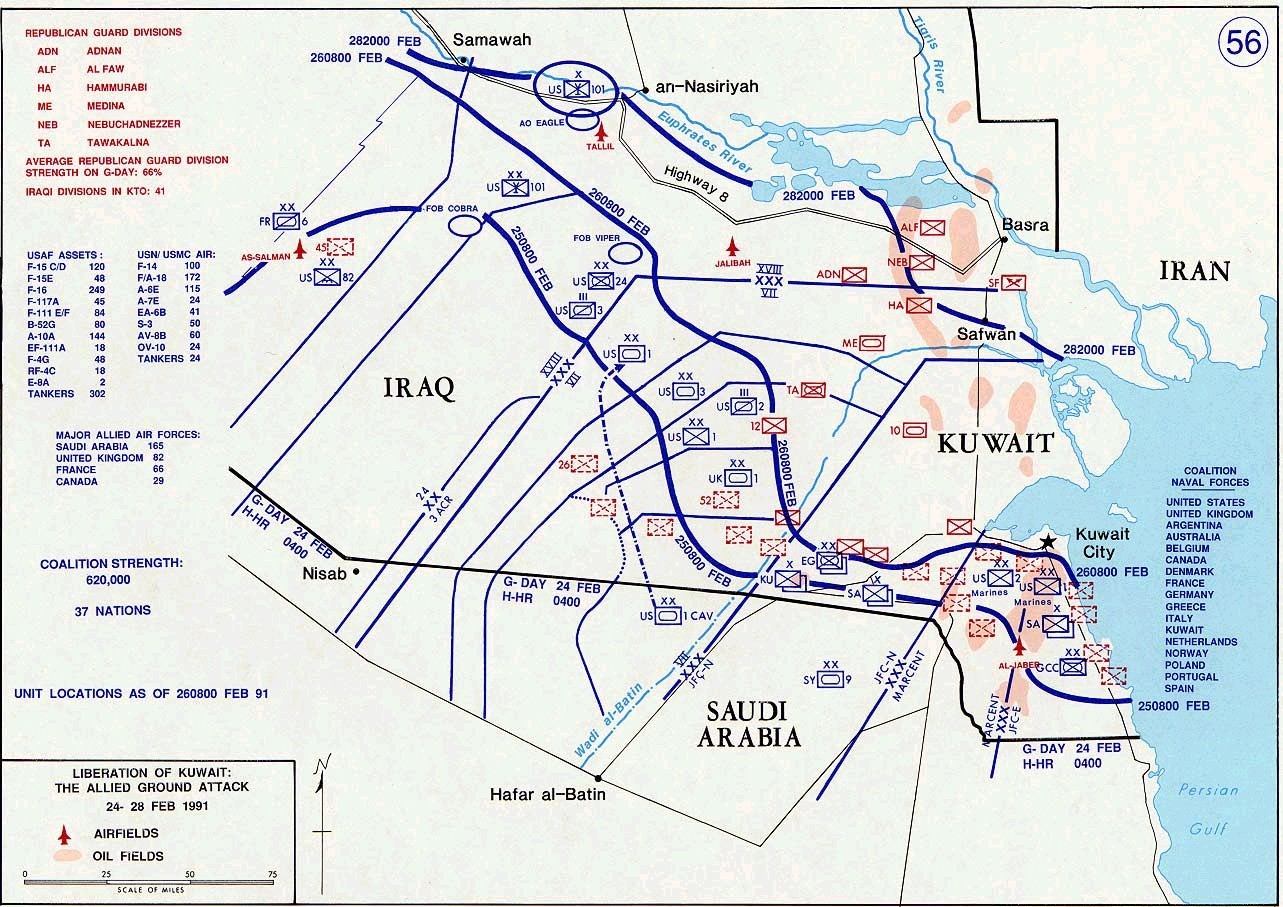
www.tim-thompson.com/desert-storm.jpg
The 197th Brigade in M113 Gavins because of their lower ground pressure LEAD the entire force through the marshy areas that BRADLEYS COULDN'T TRAVERSE as indicated in the history narratives below which 197th IN BDE veteran NCOs told us.
Lucky War: Third Army in Desert Storm
By Richard M. Swain, 1999
http://books.google.com/books?id=mZty9wdfHRkC&pg=RA1-PA243&lpg=RA1-PA243&dq=197th+infantry+brigade+desert+storm&source=web&ots=EhTuMUNRDz&sig=FvanJMXSm7oMD3LS48gLkCR7S6E&hl=en
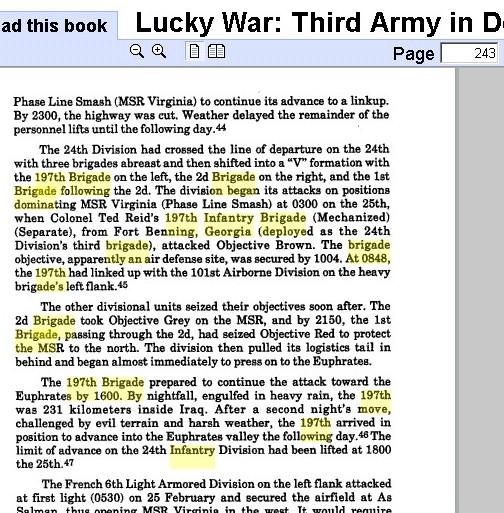
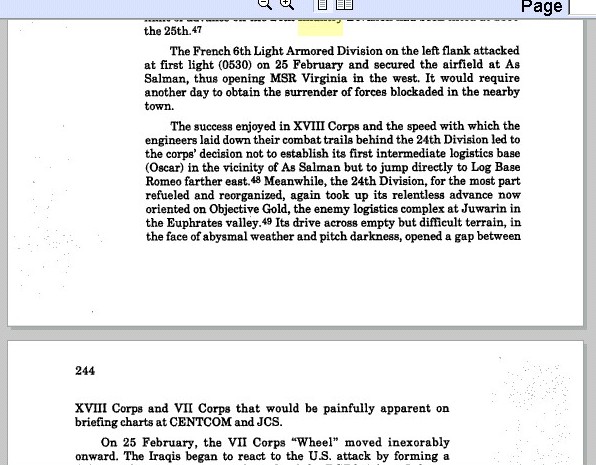
The Complete Idiot's Guide to the Gulf War
By Charles Jaco, 2002
http://books.google.com/books?id=EcCv1wwcdjAC&pg=PA241&lpg=PA241&dq=infantry+brigade+m113+197th&source=web&ots=nkGjCktn_9&sig=qecyCsUGmQHgb2rA_9xxlRJ28EQ&hl=en
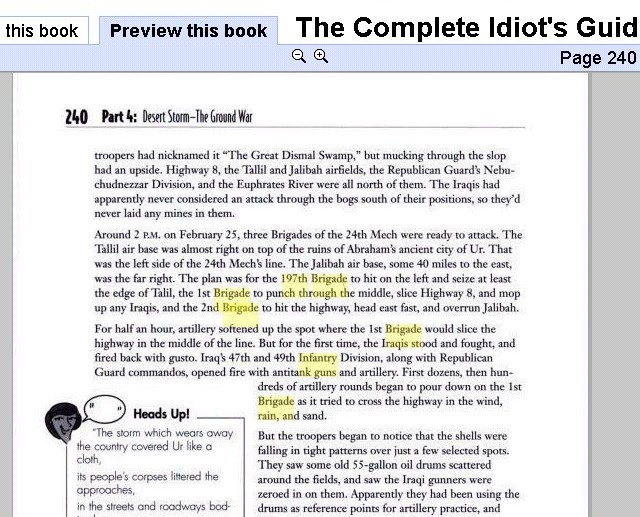
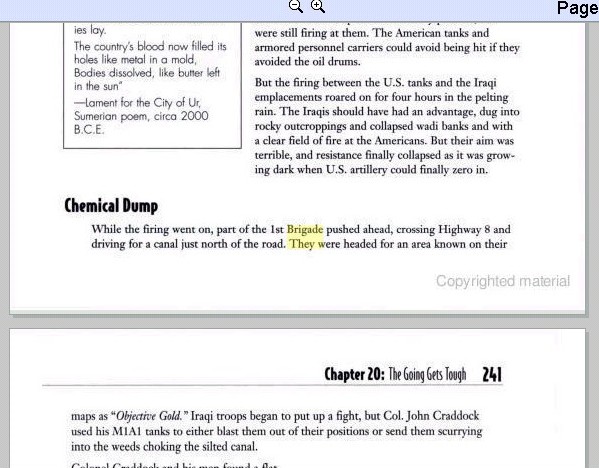
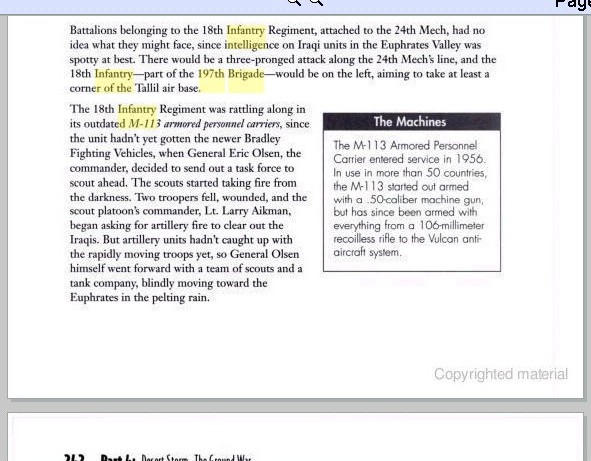
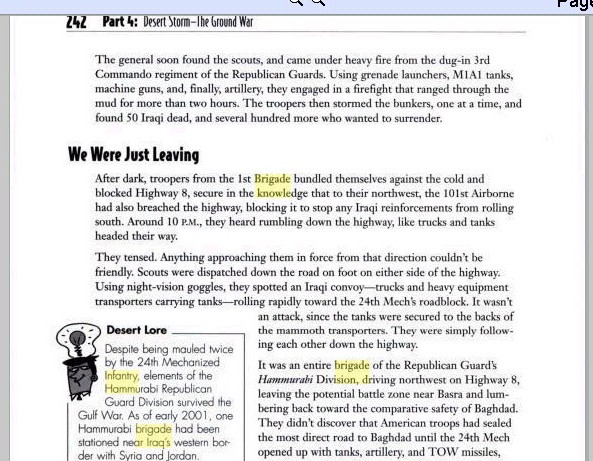
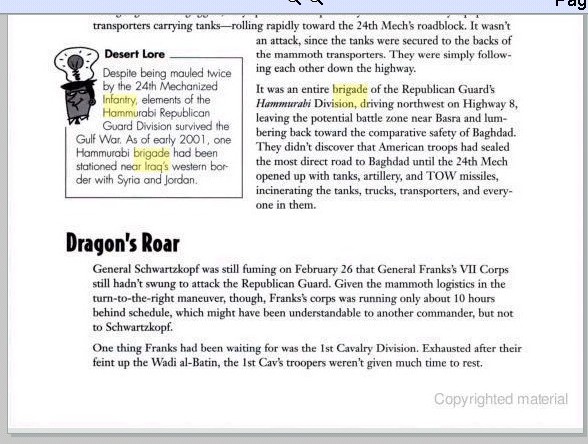
Despite the clear lessons of DESERT SHIELD/STORM, we persisted with the Humvee truck scout non-sense that clearly doesn't work even though M113 Gavins that are great cavalry scout vehicles were and ARE available! The only conclusion possible is the heavy whoppertankytards are threatened by a real light mechanized cavalry so they keep 19D scouts in a crippled, wheeled truck state. Eco-nazis on garrison post don't want any trees and woodpeckers knocked over. Troops in back can't see shit or fight mounted. Infantry flees from Bradley units into the "lightfighter" narcissist orbit. Look at their 11B and 11M career paths:
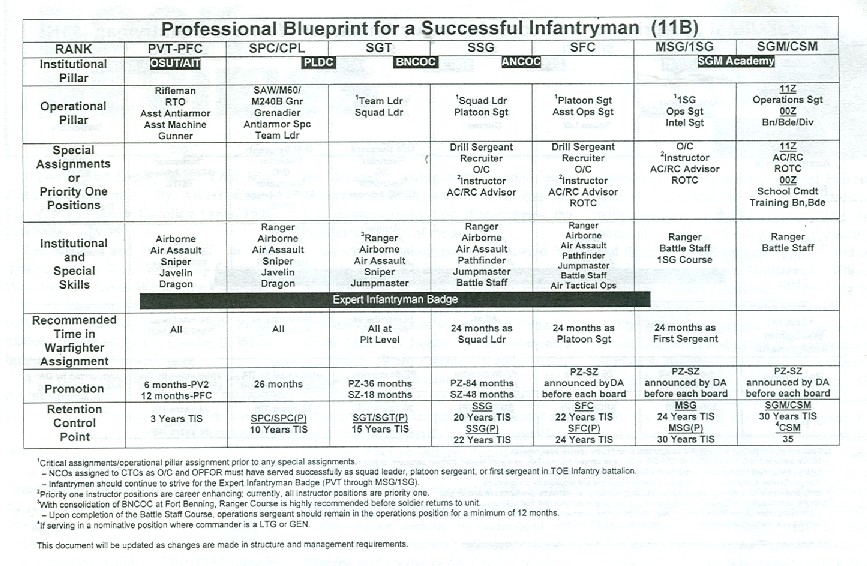
Mech Pussy Career Path
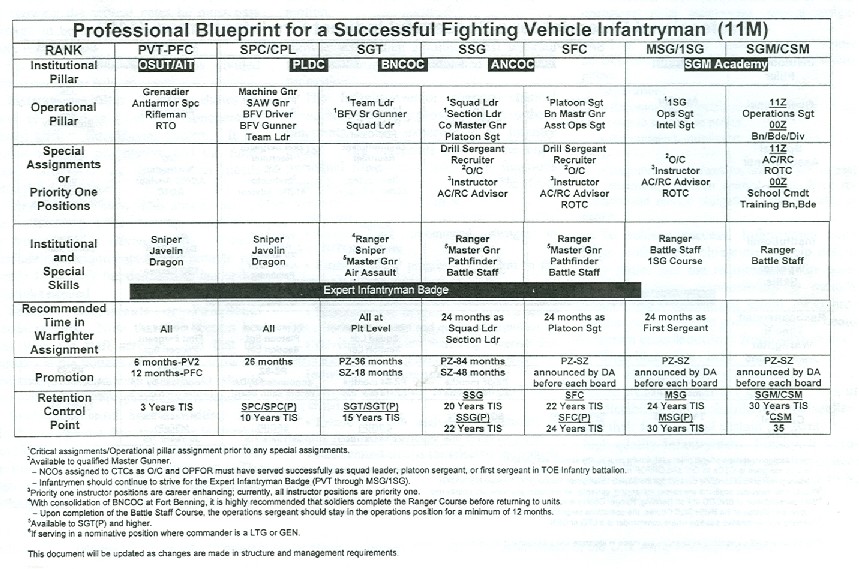
Don't let this "everyone a 11B" change fool you; if you are a mech pussy, you ain't gonna go to jump school etc. you will be stuck in death-before-dismount 2nd class citizen Bradley and Stryker mech-land and motor-land.
USMC likes the Bradley so much their new AAAV/EFV amtrack will be arranged just like it. The Lightfighters without mobility gets their asses kicked in Somalia in 1993, but nothing changes. TF Hawk airlanding of heavy M1s and medium M2s is a clusterfuck and embarrrassment, so Shinseki rather than do the right and best thing, which would be supply the infantry M113 Gavin tracks, saves institutional face by pitching thinly armored trucks (LAV-III/"Strykers") aka motorized infantry as the Army's salvation for sub-national conflicts. Garrison line Infantry loves the high road speed, comfortable ride wheeled trucks because they think they will not have to spend much time on them and are then free to play their garrison BS games with gusto. No more Bradley second-class citizenship in back. Problem is that its no better than road-bound motorized TF Smith in Korea in 1950 asking to happen all over again. A future daily road ambush disaster awaits in Iraq, it happens and nothing changes.
The root cause of all of this is GARRISON.
The desire to have 19th century trappings of rank, privilege, barracks, lawns, parades, saluting, look-at-me-shoot, look-at-me-slowly-march, me-me-me narcissism; all of this chokes out ANY technotactical excellence.
If we do not fix this, and get rid of the 19th century military, America will not make it into the 22nd century. Maybe you are fat and happy with the way things are and the garrison BS. You think its AOK every time we go to war its always a "gee-this-is-a-new-thing-to-me" and the learning curve is measured in dead Americans in flag-draped coffins. You want to ride to the battle, have this event completely erased since its not important and focus ALL THE ATTENTION ON YOU, THE INFANTRYMAN. You have "arrived" and will now do your Civil War/WW2 re-enactment. But the one thing you better not try to do is foist yourself as a "hero" and a "patriot" or a military "professional", since you are neither. Garrison piece-of-shit is what you are and chose to be, Mr. Line Infantry.
M113A3 Super Gavins in Iraq combat by 1st Cavalry
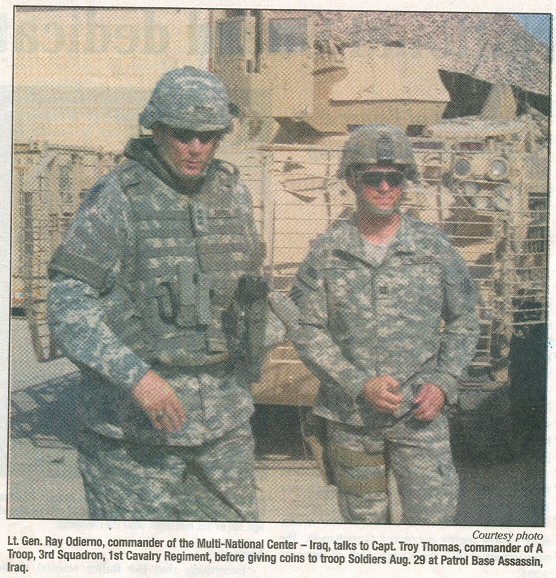
This is a pic from a recent Fort Benning BAYONET newspaper showing a heavily up-armored M113A3 Super Gavin in Iraq being used as a HOOAH! backdrop showing its still a vehicle beloved by Soldiers in the Army; in this case, the Cavalry---who should have had these light tracks all along!
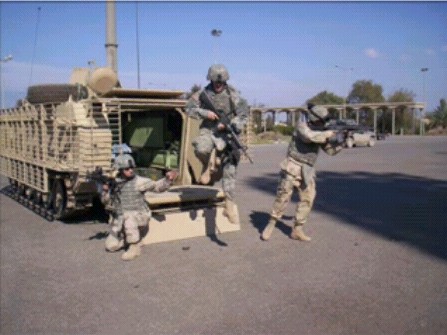
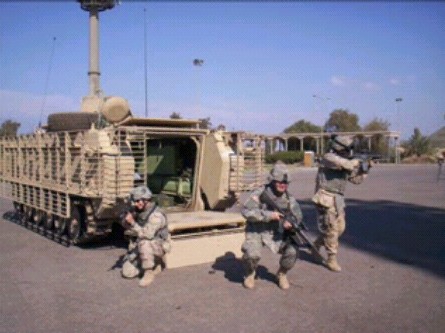
Humvee madness: All Clinton's Fault???
Notice the BS Humvees when superior M113 Gavins were available to field an effective cavalry!
Again, brass within the Army FEAR an effective cavalry, especially a light one that could hog up "all the action" by being air-transportable.
A great find by Mark Ash!
From the 1992 DoA Historic Summary...
www.army. mil/CMH/books/ DAHSUM/1992/ ch02.htm
Force cuts, from 18 to 14 division PRIOR TO BILL CLINTON EVEN BEING NOMINATED FOR PREZ!!!!!
Under the Base Force concept, the Army inactivated four divisions and one corps, reducing its strength to pre-Korean War levels. During fiscal years 1990 and 1991 the Army had inactivated the 9th Motorized Division and the 2nd Armored Division. After its return from Southwest Asia in 1991, the VII Corps was officially inactivated on 15 April 1992. The 8th Infantry Division had already disappeared from the rolls on 17 January 1992, and the 3rd Armored Division followed on 15 August 1992. During FY 1992, U.S. Army, Europe (USAREUR), also lost the 2nd Armored Cavalry Regiment, which the Army planned to reorganize as a light armored cavalry regiment. During the fourteen months prior to May 1992, the V Corps, USAREUR's major combat corps, lost fifty-six battalions and thirty-seven company-size units. The Army thus reduced its end strength in Europe by 72,500 men, close to 200 Soldiers per day, during FY 1992.
About the 2nd ACR going "light"...
Light Cavalry RegimentIn response to the lessons of DESERT STORM, the Department of the Army in September 1991 directed TRADOC to design a light cavalry regiment. The Chief of Staff had approved the concept and the reorganization of the 2nd Armored Cavalry Regiment (Light) using the assets of the 199th Separate Infantry Brigade (Motorized). The 2nd would serve as the light cavalry regiment for the XVIII Airborne Corps and also as the Joint Readiness Training Center's operational force. In April 1992, TRADOC prepared two designs for a light cavalry regiment. An interim design envisioned 4,354 troopers in three ground squadrons, one equipped with M1 tanks, one with M113A3 armored personnel carriers, and one with M113 armored personnel carriers with Tube-launched, Optically tracked, Wire command link-guided (TOW) antitank missile systems. It also called for a regimental aviation squadron containing forty-eight multiple-purpose light helicopters (MPLH).
The Army Staff and FORSCOM expressed concern about the interim design. Headquarters, Department of the Army (HQDA), told TRADOC to reduce the light cavalry regiment to less than 4,100 officers and men, to drop the number of helicopters from forty-eight to thirty-six, and to include only one type of gun in the organization for field artillery. The regiment would use High Mobility Multipurpose Wheeled Vehicles (HMMWV) with TOW until the Army fielded the armored gun system. The revised design contained 3,922 spaces in two ground squadrons, a reconnaissance squadron, and a regimental aviation squadron. During the summer the design underwent further alterations. On 7 August 1992, the Chief of Staff approved a transitional design of 4,017 spaces in three ground squadrons with HMMWV TOW and a regimental aviation squadron with thirty-three MPLHs and ten UH-60 helicopters. He also accepted the FY 1995 conversion.
Certainly Clinton didn't help the military that much, but most of the stupidity that was seen on his watch was inititiated on "What a Dick" Cheney and Dumsfeld's watch.
We need a MOBILE INFANTRY (defacto cavalry) if we want to defeat enemies today that are more mobile than us; its long overdue. The plains Indians could do it with 19th century technology. See excerpt Dave Reeder found below. Its high time that our light infantry get the M113 Gavin light tanks needed to do 3D maneuver warfare over and through closed terrain to help our heavy forces in heavier tanks doing 2D maneuver warfare over open terrain. If we don't fix this and soon, forces like Hezbollah will not be just a nuisance to the Israelis in rocky southern Lebanon.
From The Prairie Traveler, Capt. Randolph B. Marcy, 5th Infantry, Chapter 6, 1859INDIAN FIGHTING.
The military system, as taught and practiced in our army up to the time of the Mexican war, was, without doubt, efficient and well adapted to the art of war among civilized nations. This system was designed for the operations of armies acting in populated districts, furnishing ample resources, and against an enemy who was tangible, and made use of a similar system. [EDITOR: nation-state war]
The vast expanse of desert territory that has been annexed to our domain within the last few years is peopled by numerous tribes of marauding and erratic savages, who are mounted upon fleet and hardy horses, making war the business and pastime of their lives, and acknowledging none of the ameliorating conventionalities of civilized warfare. Their tactics are such as to render the old system almost wholly impotent. [EDITOR: sub-national conflict by people who have no civilian "life", they live for violence; sounds like Hezbollah today]
To act against an enemy who is here to-day and there to-morrow; who at one time stampedes a herd of mules upon the head waters of the Arkansas, and when next heard from is in the very heart of the populated districts of Mexico, laying waste haciendas, and carrying devastation, rapine, and murder in his steps; who is every where without being any where; who assembles at the moment of combat, and vanishes whenever fortune turns against him; who leaves his women and children far distant from the theater of hostilities, and has neither towns or magazines to defend, nor lines of retreat to cover; who derives his commissariat from the country he operates in, and is not encumbered with baggage wagons or pack-trains; who comes into action only when it suits his purposes, and never without the advantage of numbers or position-with such an enemy the strategic science of civilized nations loses much of its importance, and finds but rarely, and only in peculiar localities, an opportunity to be put in practice.
Our little army, scattered as it has been over the vast area of our possessions, in small garrisons [FOBs] of one or two companies each, has seldom been in a situation to act successfully on the offensive against large numbers of these marauders, and has often been condemned to hold itself almost exclusively upon the defensive. The morale of the troops must thereby necessarily be seriously impaired, and the confidence of the savages correspondingly augmented. The system of small garrisons has a tendency to disorganize the troops in proportion as they are scattered, and renders them correspondingly inefficient. The same results have been observed by the French army in Algeria, where, in 1845, their troops were, like ours, disseminated over a vast space, and broken up into small detachments stationed in numerous intrenched posts. Upon the sudden appearance of Abd el Kader in the plain of Mitidja, they were defeated with serious losses, and were from day-to-day obliged to abandon these useless stations, with all the supplies they contained. A French writer, in discussing this subject, says:
"We have now abandoned the fatal idea of defending Algeria by small intrenched posts. In studying the character of the war, the nature of the men who are to oppose us, and of the country in which we are to operate, we must be convinced of the danger of admitting any other system of fortification than that which is to receive our grand depots, our magazines, and to serve as places to recruit and rest our troops when exhausted by long, expeditionary movements.
"These fortifications should be established in the midst of the centers of action, so as to command the principal routes, and serve as pivots to expeditionary columns. [EDITOR: only have the minimum necessary FOBs that are operationally located to have maximum effect]
"We owe our success to a system of war which has its proofs in twice changing our relations with the Arabs. This system consists altogether in the great mobility we have given to our troops. Instead of disseminating our Soldiers with the vain hope of protecting our frontiers with a line of small posts, we have concentrated them, to have them at all times ready for emergencies, and since then the fortune of the Arabs has waned, and we have marched from victory-to-victory. [EDITOR: Quick Reaction Forces]
"This system, which has thus far succeeded, ought to succeed always, and to conduct us, God willing, to the peaceful possession of the country."
In reading a treatise upon war as it is practiced by the French in Algeria, by Colonel A. Laure, of the 2nd Algerian Tirailleurs, published in Paris in 1858, I was struck with the remarkable similarity between the habits of the Arabs and those of the wandering tribes that inhabit our Western prairies. Their manner of making war is almost precisely the same, and a successful system of strategic operations for one will, in my opinion, apply to the other.
As the Turks have been more successful than the French in their military operations against the Arab tribes, it may not be altogether uninteresting to inquire by what means these inferior Soldiers have accomplished the best results. [EDITOR: just like ARVN were able to get good results in M113 Gavins]
The author above mentioned, in speaking upon this subject, says:
"In these latter days the world is occupied with the organization of mounted infantry, according to the example of the Turks, where, in the most successful experiments that have been made, the mule carries the foot-Soldier.
"The Turkish Soldier mounts his mule, puts his provisions upon one side and his accoutrements upon the other, and, thus equipped, sets out upon long marches, traveling day and night, and only reposing occasionally in bivouac. Arrived near the place of operations (as near the break of day as possible), the Turks dismount in the most profound silence, and pass in succession the bridle of one mule through that of another in such a manner that a single man is sufficient to hold forty or fifty of them by retaining the last bridle, which secures all the others; they then examine their arms, and are ready to commence their work. The chief gives his last orders, posts his guides, and they make the attack, surprise the enemy, generally asleep, and carry the position without resistance. The operation terminated, they hasten to beat a retreat, to prevent the neighboring tribes from assembling, and thus avoid a [decisive] combat. [EDITOR: fight way out with mobility before enemies can converge like they did to Delta/Rangers on October 3, 1993 in Mogadishu]
"The Turks had only three thousand mounted men and ten thousand infantry in Algeria, yet these thirteen thousand men sufficed to conquer the same obstacles which have arrested us for twenty-six years, notwithstanding the advantage we had of an army which was successively re-enforced until it amounted to a hundred thousand.
"Why not imitate the Turks, then, mount our infantry upon mules, and reduce the strength of our army?
"The response is very simple:
"The Turks are Turks-that is to say, Mussulmans-and indigenous to the country; the Turks speak the Arabic language; the Days of Algiers had less country to guard than we, and they care very little about retaining possession of it. They are satisfied to receive a part of its revenues. They were not permanent; their dominion was held by a thread. The Arab dwells in tents; his magazines are in caves. When he starts upon a war expedition, he folds his tent, drives far away his beasts of burden, which transport his effects, and only carries with him his horse and arms. Thus equipped, he goes every where; nothing arrests him; and often, when we believe him twenty leagues distant, he is in ambush at precisely rifle range from the flanks of his enemy.
"It may be thought the union of contingents might retard their movements, but this is not so. The Arabs, whether they number ten or a hundred thousand, move with equal facility. They go where they wish and as they wish upon a campaign; the place of rendezvous merely is indicated, and they arrive there.
"What calculations can be made against such an organization as this?
"Strategy evidently loses its advantages against such enemies; a general can only make conjectures; he marches to find the Arabs, and finds them not; then, again, when he least expects it, he suddenly encounters them.
"When the Arab despairs of success in battle, he places his sole reliance upon the speed of his horse to escape destruction; and as he is always in a country where he can make his camp beside a little water, he travels until he has placed a safe distance between himself and his enemy."
No people probably on the face of the earth are more ambitious of martial fame, or entertain a higher appreciation for the deeds of a daring and successful warrior, than the North American savages. The attainment of such reputation is the paramount and absorbing object of their lives; all their aspirations for distinction invariably take this channel of expression. A young man is never considered worthy to occupy a seat in council until he has encountered an enemy in battle; and he who can count the greatest number of scalps is the most highly honored by his tribe. This idea is inculcated from their earliest infancy. It is not surprising, therefore, that, with such weighty inducements before him, the young man who, as yet, has gained no renown as a brave or warrior, should be less discriminate in his attacks than older men who have already acquired a name. The young braves should, therefore, be closely watched when encountered on the Plains. [EDITOR; career-ism and Achilles-style narcissistic existentialism, Indian-style]
From The Prairie Traveler, Capt. Randolph B. Marcy, 5th Infantry, Chapter 7, 1859 offers suggestions to improve U.S. tactics:
By making short excursions about the country they acquire a knowledge of it, become inured to fatigue, learn the art of bivouacking, trailing, etc., etc., all of which will be found serviceable in border warfare; and, even if they should perchance now and then miss some of the minor routine duties of the garrison, the benefits they would derive from hunting would, in my opinion, more than counterbalance its effects. Under the old regime it was thought that drills, dress-parades, and guard-mountings comprehended the sum total of the Soldier's education, but the experience of the last ten years has taught us that these are only the rudiments, and that to combat successfully with Indians we must receive instruction from them, study their tactics, and, where they suit our purposes, copy from them. [EDITOR: obvious condemnation of garrison mentality in favor of head-on adaptation to defeat the enemy; like many similar calls, it may be heeded but only with expectation that when Indian problem is over, return to garrison will ensue]The union of discipline with the individuality, self-reliance and rapidity of locomotion of the savage is what we should aim at. This will be the tendency of the course indicated, and it is conceived by the writer that an army composed of well-disciplined hunters will be the most efficient of all others against the only enemy we have to encounter within the limits of our vast possessions. [EDITOR: you crazy? The narcissistic garrison egomaniacs will have none of this "self-reliance"!!! STAY-IN-YOUR-LANE!!!]
I find some pertinent remarks upon this subject in a very sensible essay by "a late captain of infantry" (U. S.). He says:
"It is conceived that scattered bands of mounted hunters, with the speed of a horse and the watchfulness of a wolf or antelope, whose faculties are sharpened by their necessities; who, when they get short of provisions, separate and look for something to eat, and find it in the water, in the ground, or on the surface; whose bill of fare ranges from grass-seed, nuts, roots, grasshoppers, lizards, and rattlesnakes up to the antelope, deer, elk, bear, and buffalo, and who have a continent to roam over, will be neither surprised, caught, conquered, overawed, or reduced to famine by a rumbling, bugle blowing, drum-beating town passing through their country on wheels at the speed of a loaded wagon. [EDITOR: sounds like a Stryker "wagon"]
"If the Indians are in the path and do not wish to be seen, they cross a ridge, and the town moves on, ignorant whether there are fifty Indians within a mile or no Indian within fifty miles. If the Indians wish to see, they return to the crest of the ridge, crawl up to the edge, pull up a bunch of grass by the roots, and look through or under it at the procession."
Infantry, Don't Forget to Heavy Weaponize your Tracked Armored Personnel Carriers
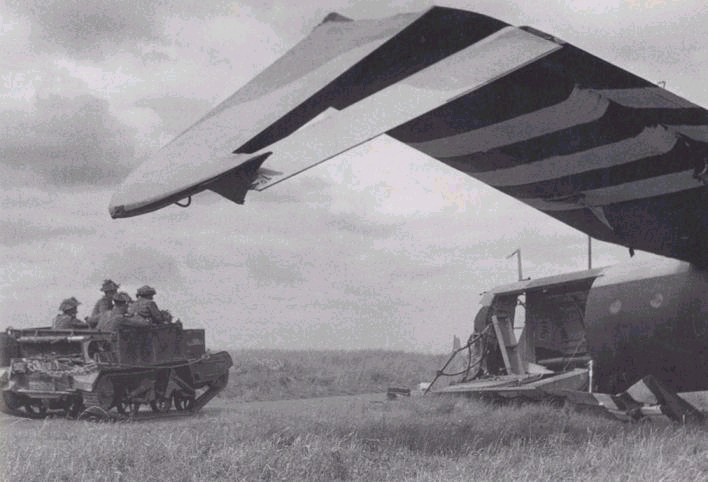
Not having a heavy-caliber, high explosive delivering weapon but having the tracked armored fighting vehicles to mobilize such weapons is the tragic mistake of the "A Bridge Too Far" fight for Arnhem bridge over the Rhine river in 1944.
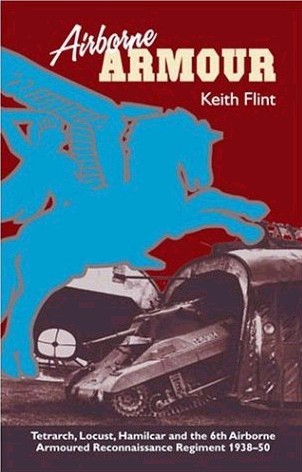
Thanks to Keith Flint's book, Airborne Armour we now know what went wrong on the way to Arnhem bridge: unlike the British 6th Airborne Division that took both Tetrarch/Locust light tanks with turreted 37mm-40mm-3 inch guns and Bren gun armored personnel carriers into D-Day and the later Operation Varsity---the 1st Airborne Division only glider-landed 18 x Bren gun carriers to move SUPPLIES for the infantry---but without the light tanks did not even have a single "Universal Carrier" outfitted with a large caliber gun in a ready-to-fire mode when they bumped into a mere pair of German armored cars. While the walking infantry fanned out and hit-the-dirt, the Germans blasted their 1st Reconnaissance Squadron's unarmored jeeps towing 20mm Polsten anti-aircraft cannon before they could unlimber and fire.

Had just a few of these Bren gun carriers been carrying a fixed mount 20mm, 37mm, 40mm, 57mm, 76mm antitank or 75mm pack howitzer gun as the photos below show were actually tested and proved functional---they would have enabled the men inside to save the day on "Tiger Route" to Arnhem, reinforcing LTC Frost's men there so they could have held on a few more days until XXX Corps link-up. The pay-off?
WW2 would have ended 1 year sooner, Berlin would have been entirely in Allied instead of half communist hands. Untold deaths, sufferings and atrocities would have been prevented...no Battle of the Bulge debacle....you get the point. A technotactical failure had STRATEGIC consequences for the entire world resulting in millions of people suffering. It wasn't one bridge "too far", it was a case of NOT BRINGING ENOUGH.
So why didn't Brens have big guns?
Because the egotistical infantry has and continues to refuse to admit it needs high explosive (HE) building/bunker/dug-in enemy blasting firepower help from a VEHICLE because it smacks of a "tank". Well, they are correct. Anything that is tracked and armored is indeed, a TANK, and a Bren gun carrier with a BIG gun would be a tank---which is too fucking bad. That's what they needed on the dusty road to Arnhem when they chose to glider-land 6-8 miles to avoid anti-aircraft fire that would decimate a daylight drop of airborne or glider infantry directly on to the bridge. Paradoxically, infantry will tolerate HE firepower if its coming from a fellow narcissist on foot--but just barely. They don't like it and don't embrace HE firepower with lots of RPG gunners and yearn for kinetic energy bullet gun-slinging to carry the day. Any HE weapons carried by infantry have to be low-key and not grab the limelight from the rifleman. When the 82nd Airborne kicks German ass in WW2 they don't let us know it was greatly assisted by captured German panzerfaust disposable rocket launchers because its bad for their Superman image. You have to read carefully into LTG James Gavin's writings to learn this secret. So if Western infantry in love with bullet garden hosing the enemy is reluctant to employ HE rocket launchers from their own shoulders, how do you think they'll look upon HE from one of their tracked infantry carriers making it into a defacto tank obvious for everyone to see?
They will not like it nor want it.
This is why you can see APC/AFVs all over the world armed with only machine guns and weak cannons when they can clearly have a large HE weapon fitted--because infantrymen are little penis egomaniacs who want all the glory to themselves via dismounted foot action--blasting an enemy position is "un-heroic". This is indeed true as an ignorant, corrupt and incompetent practice but its moreover tragic and battle-losing. History is filled with accounts where hand-carried firepower was not enough since the earth can easily absorb it if the enemy skillfully employs fortifications and denies the KE bullet shooter access to a line-of-sight (LOS) on him. The disastrous amphibious raid on Dieppe in 1942 was Eban Emael--but without the gliders 3D maneuvering infantry into LOS access---and the medium-heavy Churchill tanks stuck on the beach were unable to render vehicular fire support. Arnhem was APCs/AFVs being there with the infantry by virtue of their tracked, armored mobility but not having the meeting engagement and dug-in enemy defeating firepower to carry the day. The infantry rice bowl protector reader will remark, "but that's the job of the tankers to provide us shock action". Well, did Armor branch get this memo? They appear to be only interested in dueling other tanks in the heaviest tanks possible not risking themselves by being in a lighter tank to be there where infantry can walk to give YOU FIRE SUPPORT. Like the USAF, tankers want to win wars all by themselves by first "shooting down" the enemy's mirror image of themselves, and then when that's done, win wars ONLY by their mounted maneuver without ever dismounting anybody. They have the same technohubris as the fly boys---just bound to the earth. Both false narrow mentalities were born when we failed to fully understand and employ both the tank and the airplane at the dawn of the 20th Century. We still don't have it figured out going on now into the 21st Century! The facts are we need both mounted (remember the U.S. Army's 3rd Infantry Division "Thunder Run" that took Baghad when the truck-centric USMC got pinned down?) and dismounted action, how can we get both without creating factions who only want to do one or the other?--is the dilemma. We have not even broached the subject of parachuting or airlanding in light tanks or to be a forward Cavalry for the open terrain, 2D maneuver force's medium-to-heavy tanks, THEY DON'T WANT TO DO IT! Today's tankers have lost sight of what Cavalry is and in the process have by refusing to field light tanks like the M113 Gavin into Cav units in 1970/80s, the Rapid Deployment Force Light tank in the 1980s and the M8 Buford AGS in the 1990s, forfeited the torch of mobile warfare, air-delivered Cavalry to the infantry to their present day shame and branch digestion into the Army borg.
So its now up to infantry to save itself with their own tank fire support, but first infantry has to save itself from its own wheeled stupidity. Motorized infantry is dead infantry or soon-to-be-dead infantry along roads/trails/streets where land mines and increasingly sophisticated ambushes await. In infantry's vanity to not appear like the cursed tankers, they have chosen non-functional rubber tire trucks and damned themselves to reliving the Korean war debacle again and again in Iraq/Afghanistan. Infantry needs to practice what it preaches--"the easy way is mined" and employ M113 Gavin light tracked APCs/AFVs to go cross-country through and over by available C-130/CH-47 aircraft closed terrains where heavier 2D maneuver forces cannot traverse or fly in a timely manner. Next, infantry needs to get over who is going to get the glory and wake up that they will be damn well lucky just to WIN using everything they have got and can get to help them. This means some of their APCs/AFVs will need powerful HE weaponry to be there in an instant to render fire support in a meeting engagement and to bust through enemy strong points in the face of their fire so as to not get pinned down re: Arnhem. In the final analysis, infantry needs to learn to save itself with its own light tanks derived from their own infantry-carrying light tanks AKA APCs/AFVs. The only vehicular fire support the infantry can count on is the vehicles it takes with them that can go wherever they can walk, and this means light, low-ground pressure tracks not bloated, high ground pressure Humvee/Stryker/MRAP/JTVL wheels.
The good news is all of this is that infantry's M113 Gavins can easily take a drop-in turret for firepower up to 105mm. Its not as efficient weight-wise as a fixed-gun STUG nor as survivable and hard to hit but its easy to do as the South Korean AIFV with 90mm turret below shows.
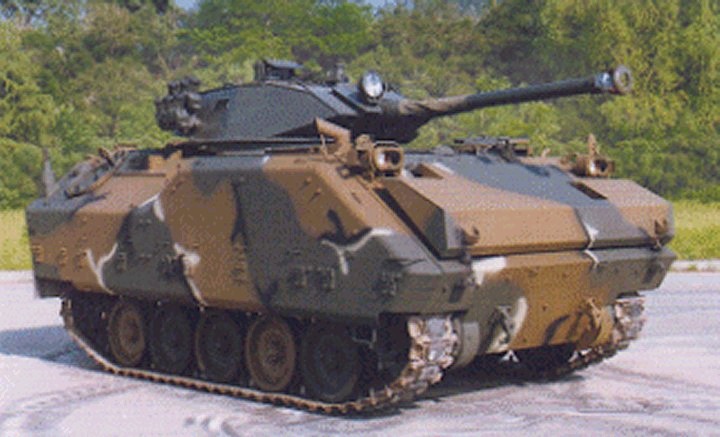
However, a turret means a manual as thick as a telephone book to master and someone becoming a "pussy" (Gunner) perhaps even two (Commander/Gunner) "cowards" being created who are "getting over" compared to the dead men walking. It also means 360 degree traverse/firing in seconds and armor protection so the weapon isn't easily knocked out....
If this is too rich for infantry blood/ego since it would be...gulp...a TANK to even the morons who think such things only have turrets (look at WW1 "tanks", how many of them had turrets? I guess they were not tanks, huh?).
OK, fine, no turret, no STUG gun in the hull.
Then a simple exposed pedestal or ring mount of a recoilless rifle or a TOW ATGM launcher on the M113 Gavin gets the necessary HE blasting effect at $500 a round or $5, 000 a missile. Some gunners will die firing from exposed positions and shields should be fitted to help. There should be no qualms about this since light infantry already has Humvee trucks with TOW ATGMs on top for tank effects (remember how Saddam's sons died?) as long as the truck its mounted under doesn't get you incinerated first. Switching out the dead horse of the wheeled truck for a light armored track solves not only light infantry's lack of Armor branch showing up to the fight after parachute and airland insertion, but there's space in back for infantry to get mobility to perhaps get into position after crossing enemy fire to do an Eban Emael and M16 versus AK47 defeat the enemy that needs rooting out.
Its almost as if....the M113....was designed by infantryman General Gavin to do this all along....that its program name of Airborne Armored Multi-Purpose Vehicle Family implies it was supposed to be used as an air-transported armored mobility mount for multiple tasks such as....INFANTRY FIRE SUPPORT. That would mean our forebears actually knew what they were doing at times, and we could learn from them by studying military history for practical applications for today and the future, right?
The time is long overdue for infantry to start mounting heavy weaponry on its light tracked platforms and stop expecting someone else to save them.
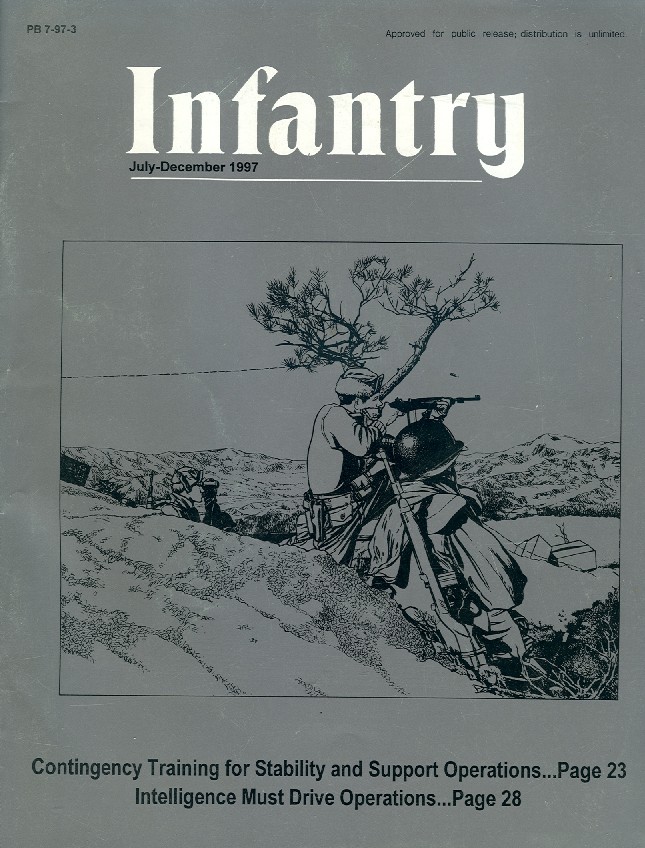
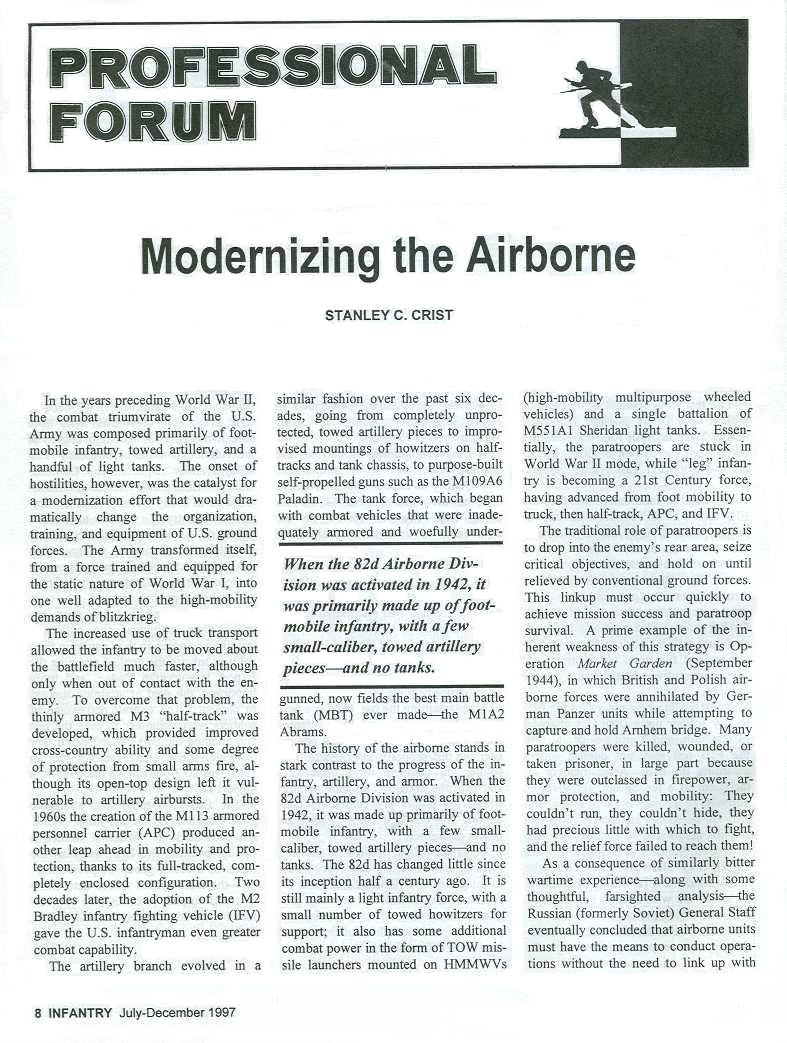
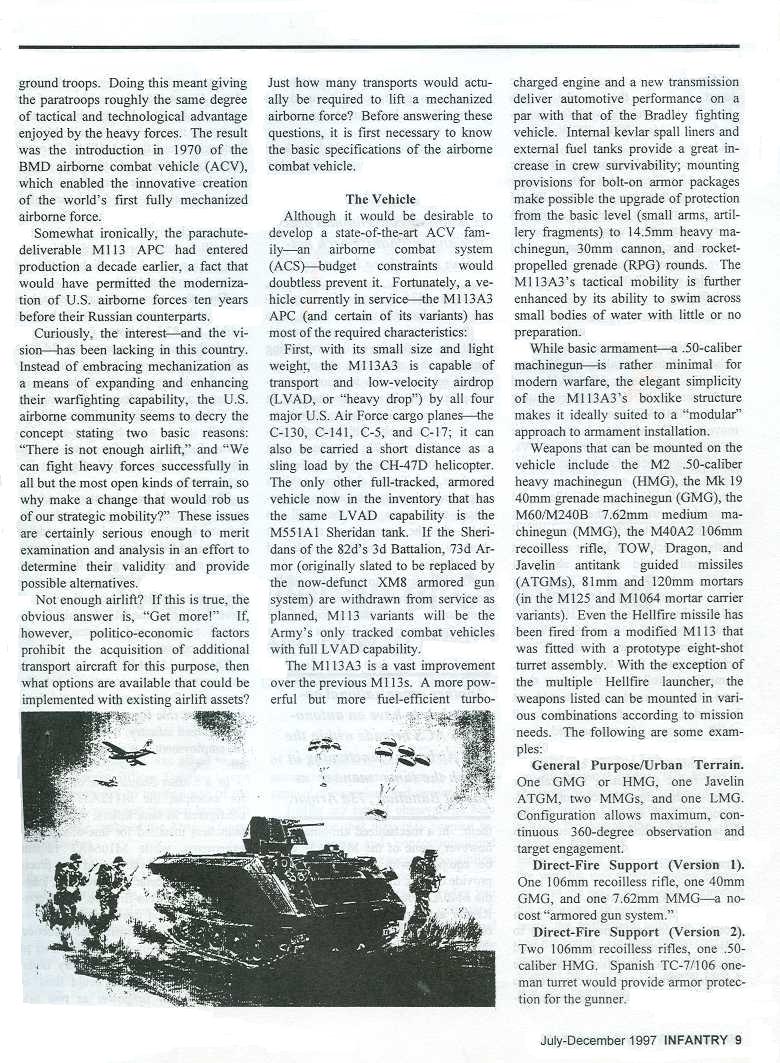
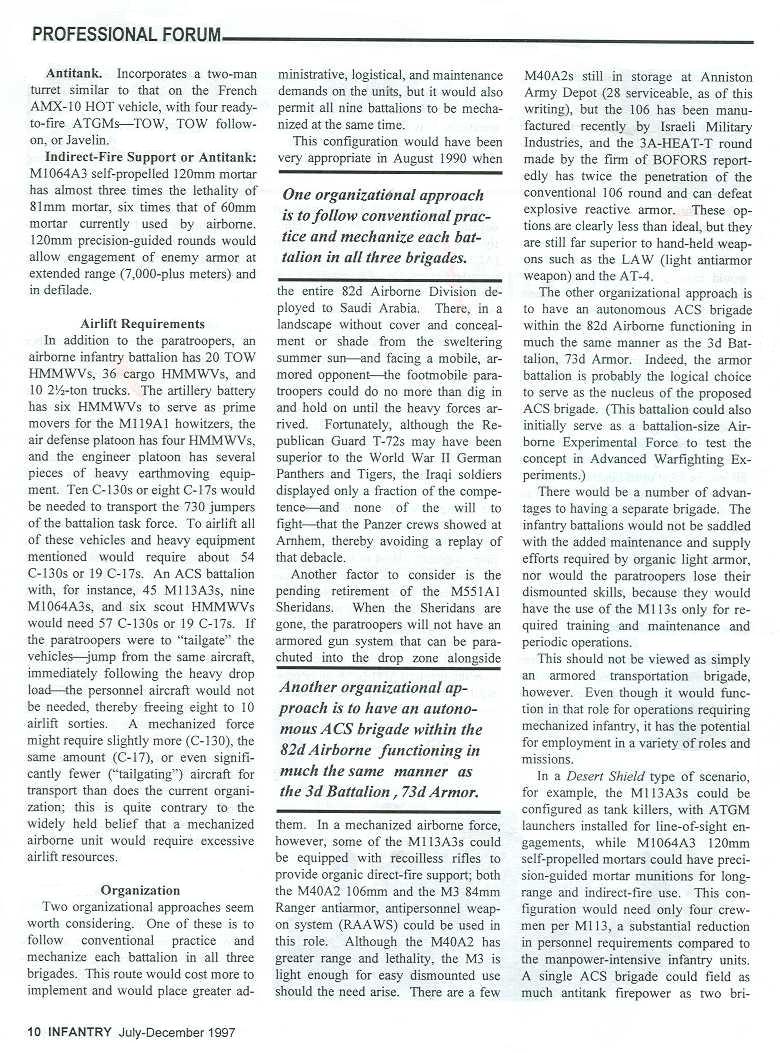
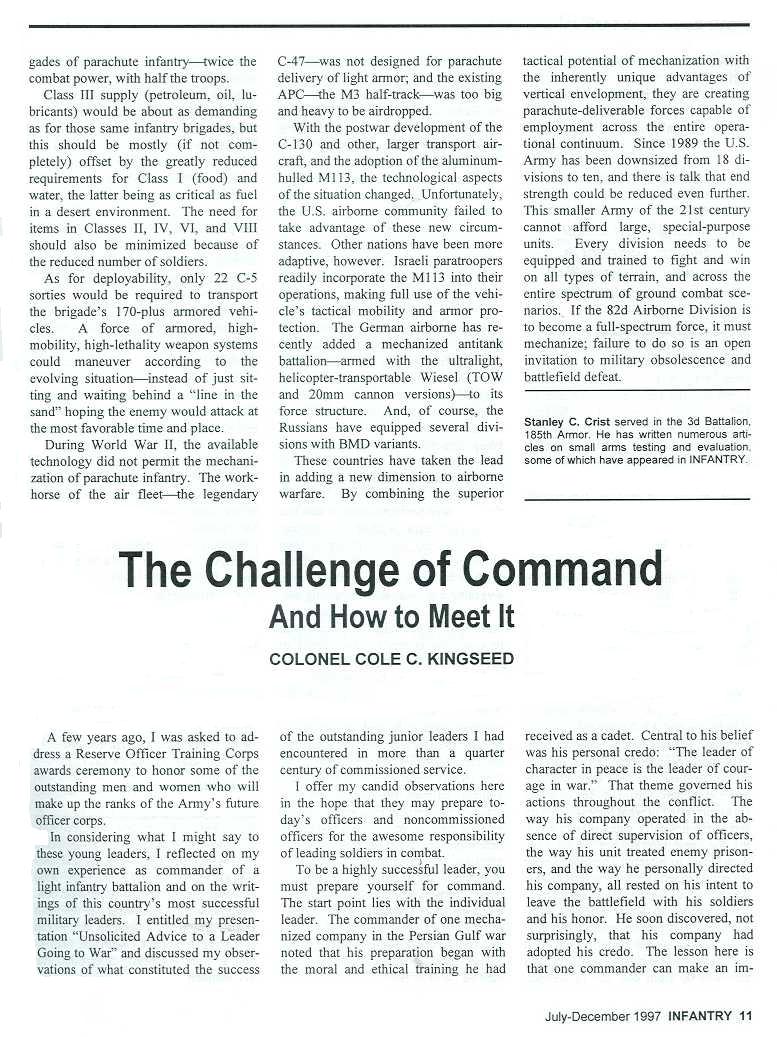
Modernizing the Airborne
PROFESSIONAL NOTES
By Stan Crist
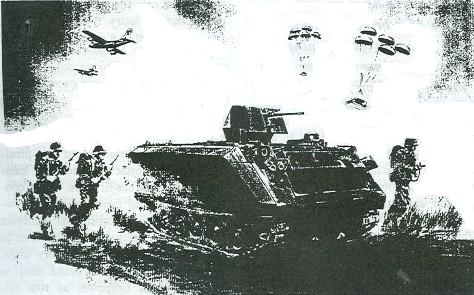
In the years preceding, World War II, the combat triumvirate of the U.S. Army was composed primarily of foot-mobile infantry, towed artillery, and a handful of light tanks. The onset of hostilities, however, was the catalyst for a modernization effort that would dramatically change the organization, training, and equipment of U.S. ground forces. The Army transformed itself, from a force trained and equipped for the static nature of World War I, into one well adapted to the high-mobility demands of blitzkrieg.
The increased use of truck transport allowed the infantry to be moved about the battlefield much faster, although only when out of contact with the enemy. To overcome that problem, the thinly armored M3 "half-track" was developed, which provided improved cross-country ability and some degree of protection from small arms fire, although its open-top design left it vulnerable to artillery airbursts. In the 1960s the creation of the M113 [Gavin] armored personnel carrier (APC) produced another leap ahead in mobility and protection, thanks to its full-tracked, completely enclosed configuration. Two decades later, the adoption of the M2 Bradley infantry fighting vehicle (IFV) gave the U.S. infantryman even greater combat capability.
The artillery branch evolved in a
Page 8 INFANTRY July-December 1997
STANLEY C. CRIST
similar fashion over the past six decades, going from completely unprotected, towed artillery pieces to improvised mountings of howitzers on half-tracks and tank chassis, to purpose-built self-propelled guns such as the MI09A6 Paladin. The tank force, which began with combat vehicles that were inadequately armored and woefully under-
When the 82nd Airborne Division was activated in 1942, it was primarily made up of foot-mobile infantry, with a few small-caliber, towed artillery pieces--and no tanks.
gunned, now fields the best main battle [heavy] tank (MBT) ever made-the M1A2 Abrams. The history of the airborne stands in stark contrast to the progress of the infantry, artillery, and armor. When the 82nd Airborne Division was activated in 1942, it was made up primarily of foot-mobile infantry, with a few small caliber, towed artillery pieces-and no tanks. The 82nd has changed little since its inception half a century ago. It is still mainly a light infantry force, with a small number of towed howitzers for support; it also has some additional combat power in the form of TOW missile launchers mounted on HMMWVs (high-mobility multipurpose wheeled vehicles) and a single battalion of M551A1 Sheridan light tanks. Essentially, the paratroopers are stuck in World War II mode, while "leg" infantry is becoming a 21st Century force, having advanced from foot mobility to truck, then half-track, APC, and IFV. The traditional role of paratroopers is to drop into the enemy's rear area, seize critical objectives, and hold on until relieved by conventional ground forces.
This linkup must occur quickly to achieve mission success and paratroop survival. A prime example of the inherent weakness of this strategy is Operation Market Garden (September 1944), in which British and Polish airborne forces were annihilated by German Panzer units while attempting to capture and hold Arnhem bridge. Many paratroopers were killed, wounded, or taken prisoner, in large part because they were outclassed in firepower, armor protection, and mobility: They couldn't run, they couldn't hide, they had precious little with which to fight, and the relief force failed to reach them!
As a consequence of similarly bitter wartime experience---along with some thoughtful, farsighted analysis-the Russian (formerly Soviet) General Staff eventually concluded that airborne units must have the means to conduct operations without the need to link up with ground troops. Doing this meant giving the paratroops roughly the same degree of tactical and technological advantage enjoyed by the heavy forces. The result was the introduction in 1970 of the BMD airborne combat vehicle (ACV), which enabled the innovative creation of the world's first fully mechanized airborne force.
Somewhat ironically, the parachute deliverable M113 APC had entered production a decade earlier, a fact that would have permitted the modernization of U.S. airborne forces ten years before their Russian counterparts.
Curiously, the interest--and the vision-has been lacking in this country. Instead of embracing mechanization as a means of expanding and enhancing their warfighting capability, the U.S. airborne community seems to decry the concept stating two basic reasons: "There is not enough airlift," and "We can fight heavy forces, successfully in all but the most open kinds of terrain, so why make a change that would rob us of our strategic mobility?" These issues are certainly serious enough to merit examination and analysis in an effort to determine their validity and provide possible alternatives.
Not enough airlift? If this is true, the obvious answer is, "Get more!" If, however, politico-economic factors prohibit the acquisition of additional transport aircraft for this purpose, then what options are available that could be implemented with existing airlift assets?
Just how many transports would actually be required to lift a mechanized airborne force? Before answering these questions, it is first necessary to know the basic specifications of the airborne combat vehicle.
The Vehicle
Although it would be desirable to develop a state-of-the-art ACV family-an airborne combat system (ACS}---budget constraints would doubtless prevent it. Fortunately, a vehicle currently in service--the M113A3 APC (and certain of its variants) has most of the required characteristics: First, with its small size and light weight, the M113A3 is capable of transport and low-velocity airdrop (LVAD, or "heavy drop") by all four major U.S. Air Force cargo planes-the C-130, C-141, C-5, and C-17; it can also be carried a short distance as a sling load by the CH-47D helicopter. The only other full-tracked, armored vehicle now in the inventory that has the same LVAD capability is the M551A1 Sheridan tank. If the Sheridans of the 82nd's 3rd Battalion, 73rd Armor (originally slated to be replaced by the now-defunct XM8 [Buford] armored gun system) are withdrawn from service as planned, M113 variants will be the Army's only tracked combat vehicles with full LVAD capability.
The M113A3 is a vast improvement over the previous M113s. A more powerful but more fuel-efficient turbocharged engine and a new transmission deliver automotive performance on a par with that of the Bradley fighting vehicle. Internal kevlar spall liners and external fuel tanks provide a great increase in crew survivability; mounting provisions for bolt-on armor packages make possible the upgrade of protection trom the basic level (small arms, artillery fragments) to 14.5mm heavy machinegun, 30mm cannon, and rocket-propelled grenade (RPG) rounds. The MI13A3's tactical mobility is further enhanced by its ability to swim across small bodies of water with little or no preparation.
While basic armament-a .50-caliber [heavy] machinegun-is rather minimal for modem warfare, the elegant simplicity of the M113A3's box-like structure makes it ideally suited to a "modular" approach to armament installation.
Weapons that can be mounted on the vehicle include the M2 .50-caliber heavy machinegun (HMG), the Mk 19 40mm grenade machinegun (GMG), the M60/M240B 7.62mm medium machinegun (MMG), the M40A2 106mm recoilless rifle, TOW, Dragon, and Javelin antitank guided missiles (ATGMs), 81mm and 120mm mortars (in the M125 and M1064 mortar carrier variants). Even the Hellfire missile has been fired from a modified M113 that was fitted with a prototype eight-shot turret assembly. With the exception of the multiple Hellfire launcher, the weapons listed can be mounted in various combinations according to mission needs. The following are some examples:
General Purpose, Urban Terrain.
One GMG or HMG, one Javelin ATGM, two MMGs, and one LMG.
Configuration allows maximum, continuous 360-degree observation and target engagement.
Direct-Fire Support (Version 1).
One 106mm recoilless rifle, one 40mm GMG, and one 7.62mm MMG-a no cost "armored gun system." Direct-Fire Support (Version 2).
Two 106mm recoilless rifles, one .50 caliber HMG. Spanish TC-7/l06 one-man turret would provide armor protection for the gunner.
Page 9 July-December 1997 INFANTRY
Antitank.
Incorporates a two-man turret similar to that on the French AMX-1O HOT vehicle, with four ready-to-fire ATGMs-TOW, TOW follow-on, or Javelin.
Indirect-Fire Support or Antitank.
M1064A3 self-propelled 120mm mortar has almost three times the lethality of 81mm mortar, six times that of 60mm mortar currently used by airborne. 120mm precision-guided rounds would allow engagement of enemy armor at extended range (7,000-plus meters) and in defilade.
Airlift Requirements
In addition to the paratroopers, an airborne infantry battalion has 20 x TOW HMMWVs, 36 x cargo HMMWVs, and 10 x 2.5-ton trucks [ED: these weigh 10.5 tons--exactly the same as M113s]. The artillery battery has six HMMWVs to serve as prime movers for the M1l9A1 [105mm] howitzers, the air defense platoon has four HMMWVs, and the engineer platoon has several pieces of heavy earthmoving equipment. Ten C-130s or eight C-17s would be needed to transport the 730 jumpers of the battalion task force. To airlift all of these vehicles and heavy equipment mentioned would require about 54 x C-130s or 19 x C-17s. An ACS battalion with, for instance, 45 x M1l3A3s, nine x M1064A3s, and six scout HMMWVs would need 57 x C-130s or 19 x C-17s. If the paratroopers were to "tailgate" the vehicles-jump from the same aircraft, immediately following the heavy drop load--the personnel aircraft would not be needed, thereby freeing eight to 10 airlift sorties. A mechanized force might require slightly more (C-130), the same amount (C-17), or even significantly fewer ("tailgating") aircraft for transport than does the current organization; this is quite contrary to the widely held belief that a mechanized airborne unit would require excessive airlift resources.
Organization
Two organizational approaches seem worth considering. One of these is to follow conventional practice and mechanize each battalion in all three brigades. This route would cost more to implement and would place greater administrative, logistical, and maintenance demands on the units, but it would also permit all nine battalions to be mechanized at the same time.
This configuration would have been very appropriate in August 1990 when
One organizational approach is to follow conventional practice and mechanize each battalion in all three brigades.
the entire 82nd Airborne Division deployed to Saudi Arabia. There in a landscape without cover and concealment or shade from the sweltering summer sun-and facing a mobile, armored opponent-the foot-mobile paratroopers could do no more than dig in and hold on until the heavy forces arrived. Fortunately, although the Republican Guard T-72s may have been superior to the World War II German Panthers and Tigers, the Iraqi soldiers displayed only a fraction of the competence--and none of the will to fight-that the Panzer crews showed at Arnhem, thereby avoiding a replay of that debacle.
Another factor to consider is the pending retirement of the M551A1 Sheridans. When the Sheridans are gone, the paratroopers will not have an armored gun system that can be parachuted into the drop zone alongside them. In a mechanized airborne force, however, some of the M113A3s could be equipped with recoilless rifles to provide organic direct-fire support; both the M40A2 106mm and the M3 84mm Ranger antiarmor, antipersonnel weapon system (RAAWS) could be used in this role. Although the M40A2 has greater range and lethality, the M3 is light enough for easy dismounted use should the need arise. There are a few M40A2s still in storage at Anniston Army Depot (28 serviceable, as of this writing), but the 106 has been manufactured recently by Israeli Military Industries, and the 3A-HEAT-T round made by the firm of BOFORS reportedly has twice the penetration of the conventional 106 round and can defeat explosive reactive armor. These options are clearly less than ideal, but they are still far superior to hand-held weapons such as the LAW (light anti-armor weapon) and the AT-4.
The other organizational approach is to have an autonomous ACS brigade within the 82nd Airborne functioning in much the same manner as the 3rd Battalion, 73rd Armor. Indeed, the armor battalion is probably the logical choice to serve as the nucleus of the proposed ACS brigade. (This battalion could also initially serve as a battalion-size Airborne Experimental Force to test the concept in Advanced Warfighting Experiments.)
There would be a number of advantages to having a separate brigade. The infantry battalions would not be saddled with the added maintenance and supply efforts required by organic light armor, nor would the paratroopers lose their dismounted skills, because they would have the use of the M113s only for required training and maintenance and periodic operations.
This should not be viewed as simply an armored transportation brigade, however. Even though it would function in that role for operations requiring mechanized infantry, it has the potential for employment in a variety of roles and missions.
In a Desert Shield type of scenario, for example, the M113A3s could be configured as tank killers, with ATGM launchers installed for line-of-sight engagements, while M1064A3 120mm self-propelled mortars could have precision-guided mortar munitions for long-range and indirect-fire use. This configuration would need only four crewmen per M113; a substantial reduction in personnel requirements compared to the manpower-intensive infantry units.
A single ACS brigade could field as much antitank firepower as two bri-
Page 10 INFANTRY July-December 1997
gades of parachute infantry--twice the combat power, with half the troops. Class III supply (petroleum, oil, lubricants) would be about as demanding as for those same infantry brigades, but this should be mostly (if not completely) offset by the greatly reduced requirements for Class I (food) and water, the latter being as critical as fuel in a desert environment. The need for items in Classes II, IV, VI, and VIII should also be minimized because of the reduced number of Soldiers.
As for deployability, only 22 C-5 sorties would be required to transport the brigade's 170-plus armored vehicles. A force of armored, high mobility, high-lethality weapon systems could maneuver according to the evolving situation-instead of just sitting and waiting behind a "line in the sand" hoping the enemy would attack at the most favorable time and place.
During World War II, the available technology did not permit the mechanization of parachute infantry. The workhorse of the air fleet--the legendary C-47-was not designed for parachute delivery of light armor; and the existing APC-the M3 half-track-was too big and heavy to be airdropped.
With the post-war development of the C-130 and other, larger transport aircraft, and the adoption of the aluminum-hulled M113, the technological aspects of the situation changed. Unfortunately, the U.S. airborne community failed to take advantage of these new circumstances. Other nations have been more adaptive, however. Israeli paratroopers readily incorporate the M113 into their operations, making full use of the vehicle's tactical mobility and armor protection. The German airborne has recently added a mechanized antitank battalion-armed with the ultralight, helicopter-transportable Wiesel (TOW and 20mm cannon versions}-to its force structure. And, of course, the Russians have equipped several divisions with BMD variants.
These countries have taken the lead in adding a new dimension to airborne warfare. By combining the superior tactical potential of mechanization with the inherently unique advantages of vertical envelopment, they are creating parachute-deliverable forces capable of employment across the entire operational continuum. Since 1989 the U.S. Army has been downsized from 18 divisions to ten, and there is talk that end strength could be reduced even further. This smaller Army of the 21st century cannot afford large, special-purpose units. Every division needs to be equipped and trained to fight and win on all types of terrain, and across the entire spectrum of ground combat scenarios. If the 82nd Airborne Division is to become a full-spectrum force, it must mechanize; failure to do so is an open invitation to military obsolescence and battlefield defeat.
Stanley C. Crist served in the 3rd Battalion, 185th Armor. He has written numerous articles on small arms testing and evaluation, some of which have appeared in INFANTRY.
Let's be brutally honest, shall we?
Where is the constructive effort to be good at warfighting in the garrison Army and marines?
U.S. military is not even "AMATEUR hour"; amateur implies at least we are TRYING; we are not trying; U.S. military is PHONY.
Air Force & Navy when they fly aircraft and sail ships are kept somewhat honest and combat capable because if they at any second fail they can be dead falling from the sky or in the water where man really doesn't live. To warfight they need to actively operate air/sea platforms.
In contrast in land combat, man lives on land; he does not need a platform to exist on land that automatically has a war function. He is under no compulsion to be combat ready even by platform default. Man can die on land from EXPOSURE however, and since he lives on land all the time for a peaceful, civilian life his answer to this is FIXED BUILDING SHELTER. Since man has a civilian existence means that has no military platform utility, both the Army and marines have been corrupted by building and lawn care as convenient excuses/time wasters by people who are phonies who do not want to be combat ready, they want to be phony narcissist snobs and extended adolescents paid middle-class wages.
Actives: wake up each morning sleep-deprived, roll call troop formation, do non-sense sports PT, then breakfast, some more troop formations, "leaders" meetings, document-everything-with-perfect-paperwork via desktop computers, Mondays wasted in motor pool doing PMCS on tactically unsound Humvee SUV trucks, Tuesday/Wednesdays building and lawn care, Thursday meetings, Friday paperwork. WHERE IS THE TIME TO DO ACTIVE WARFIGHTING EXCELLENCE? The entire daily and weekly routine established by the narcissist egomaniacs to baby sit the economic weak co-dependants is geared around BULLSHIT (lawn and building care) not active thinking cat vs. mouse warfighting.
www.combatreform.org/sleeplessarmy.htm
Reserves: one weekend a month they arrive and waste Saturday and Sunday with roll call formation, sports PT then lunch, then yadda yadda meetings, then time to go home for the day. Two weeks in summer is fun time away from wife and kids.
Solutions
1. Get rid of static buildings: force ground troops to every day do combat things by making them live every day in tactically-sound, portable, fortifiable "Battle Boxes" THERE IS NO GARRISON. There is only the FIELD.
www.geocities.com/strategicmaneuver/battleboxconcept.htm
www.geocities.com/strategicmaneuver/battleboxes.htm
2. Make Reserves go to war for 24 hours each month
www.geocities.com/paratroop2000/realreadyreserve.htm
3. Get rid of phony narcissists and economic bennie boomers and replace with warfighter enthusiasts
www.geocities.com/paratroop2000/weakcodependantarmy.htm
4. Cat & Mouse Warfighting Experimentation Needed
www.combatreform.org/cluelessarmy.htm
Once we cut out all the BULLSHIT we will face the tools we have in front of us and start grappling with how we will use them in war and how to better use them by ACTIVE THOUGHT. Force everyone to FACE THE TOOLS THEY HAVE IN FRONT OF THEM their minds will be forced to THINK about what it is they have. FORCE THEM TO BE IN A WAR SETTING AND THEIR MINDS WILL PONDER hey, what if I left on foot over there to patrol and an enemy sapper team is already there?
The same intellectual development and innovation that I undertake will happen with the troops, what we call FIELD CRAFT. How can you have FIELDcraft when you are NOT IN THE FIELD but in garrison doing LAWN CARE?
A few examples:
Drive vehicles and lay smoke screens with OPFOR to perfect what it takes to evade optical weapons engagement
Off-road, x-country driving of TRACKED armored fighting vehicles to avoid roadside bombs/RPG ambushes
Finding out how to hide vehicles from thermal imagery
Shoot actual soft nose RPGs at vehicles and practice evading them
Actual hardening of combat vehicles and loading arragements perfected not static BS "this is the SOP we've always used so go back to sleep"
5. Create Mobile units able to prevail on the Non-Linear Battlefield
www.combatreform.org/combatlight.htm
www.combatreform.org/m113combat.htm
www.geocities.com/armorhistory
FEEDBACK!
Army Requirements Should be Driven by Capabilities DEmonstrated not General Officer's Demands
Chuck Myers, Former DoD Director of Air Warfare writes:
"Just to remind: I have always believed we should erase the word 'requirements' from the force development/acquisition vocabulary, however, since we are still stuck with it, consider:
From your previous attached Army Document [EDITOR: "How the Army Runs"]:
Phase I-Develop capability requirements5-3. Capabilities integration and development
a. The Joint Staff has adopted a functional approach to developing and integrating capabilities within the Joint force.The reader should consult CJCSI 3170.01d, dtd 12 March 2004 (latest is 3170.01F 1 May 2007) for the most recent Joint terms and process instructions.
The Army has adopted a similar functional capabilities approach and the following paragraphs attempt to capture the emerging terminology and process changes. Capabilities-based requirements generation begins the Army force development process.
_________________________________________
Re your discussions of ground combat vehicles: there should never be an 'up-front' suggestion of the character of the vehicle insofar as wheels vs tracks vs air cushion, etc. The Army users should articulate the spectrum of perceived operational employments, battle environment, desired performance, forward support possibilities, threat specifices, etc. etc. and some indication as to how many of these vehicles they might hope to own/support.
Then they should examine possible use of upgraded versions of stuff that is available within their existing inventory or that of other armies. After exhausting existing possibilites, they might embark upon design exercises to discover the character of the options, cost, timeframe, etc.
I can agree that their should be no edict from the "top" re the specific details of the system (weapon, powerplant, wheels, tracks, etc.). What I can tolerate and may encourage is an edict that says something like: CS says I want the Army to develop a new ground combat vehicle that will get the "job" done (capabilites) and be avilable in say 2015 for 1/4 the life cycle cost of an M-1 tank and permit us to afford expanding our forces structure.
Chuck
Tanks that can swim have important tactical Mobility
Legendary combat tanker, Ralph Zumbro writes:
"Mike;
In early 1968, shortly after TET, the SF camp at Plei Mi, was besieged by NVA with a few PT-76s...We were called and sent a platoon of M-48s and broke the siege. The fleeing PT-76 were amphibs and crossed a river. We had to find a ford and lost them. And suddenly found ourselves in Cambodia. That platoon which I'd better not ID, spent a week wreaking havoc on the Trail. Another platoon of ours, commanded by an officer who recently retired as a brigadier, acted as our artillery support, using the 90s for indirect fire.
You want ground search capability, send out armored cav. A screen of 113s with sensors and dismounts, backed up by enough DIESEL tanks to bail them out. The drill is to sweep, emplace magnetic, thermal and siesmic sensors, and move on. When the sensors report activity, THEN you send in a stealth patrol. The ground units can be supplied by air, with offset airdrops or helidrops, IE the air comes in to a point and the ground goes to that point, rather than the ground forces setting up a laager in injun country under hostile observation.
The trick is that you have to have some manner of controlling the politicians and pentagon brass who would instantly try to block operations like this.
Ralph
OTHER COUNTRIES ARE USING FULL POTENTIAL OF LIGHT TANKS
"Excellent website I just want to say that. I enjoy your work on airborne warfare. I have studied airborne warfare since I was 14 and am now 21 and I do so like your site.
I research militaries in SE Asia and a good deal of airborne operations have happened there. Indonesia leads the pack and I am surprised you do not mention them as more then a footnote in East Timor in relation to the LAV and M-113. Indonesia took East Timor with a large airborne assault (for the region) during Operation Seroja in 1975. KOSTRAD (Indonesian Strategic Reserve which has 2 Infantry Divisions and 2 Airborne regiments along with armored cavalry units) and KOPASSANDHA (now called KOPASSUS) dropped in waves from AURI (Air Force) C-130s over the capital city of East Timor (Dili) and took on the left wing fighters of the Fretilin in close combat at night. The Fretilin had expected a round offensive to go through the rough territory of East Timor and hope to bog them down but the Indonesians out maneuvered them through a large airborne drop. The mission was a massive risk as the Indonesians only had 2 AC-47s (with 3 M-2HBs) to support the assault and had enough C-130s (9) to move about 2 battalions at once but little support weapons. 4 C-130s carried the KOPASSANDHA commands and 5 carried the KOSTRAD paratroopers of the 501st battalion. One C-130 was damaged from ground fire during the drop and had to return to base with 72 commandos on board. The second and third waves brought in the KOSTRAD 502nd battalion and the Brigade staff of the 18th Airborne Brigade. The fighting was up close and savage and worse at night. The commander of the 501st got lost and the battalion was unable to close to the lines of retreat for the Fretilin.
At the same time marines landed in BTR-50s and backed by PT-76s drove for the capital. They were landed a distance away to keep their ships safe and used their armor to move fast while Special Forces and local allies lead the way. There were problems as the second wave of the 502nd upon hearing the heavy fighting the first wave of KOPASSANDHA commandos had suffered during the drop began firing at the ground with their AK-47s and throwing grenades. At the same time the marines had arrived on the drop zone and had to duck for cover and worse some marines fired into the air knowing the KOSTRAD's 502nd battalion were in the air. None was hurt but many were shaken up. Hell KOPASSANDA forces actually used "captured" horses to provide mobility for a unit which backed by local forces move on the capital.
Air Force commandos of the PASKHAS were used to bring the nation's airfield to service to airland in more troops A platoon leader of the 328th KOSTRAD airborne battalion (of the 17th Airborne Brigade) had been dropped in the water as well. The 328th arrived in from the air to reinforce the units on the ground. The 401st KOSTRAD airborne battalion was airlanded to move on the town of Baucua. Seroja was the bloodiest day since independence for the Indonesian armed forces but allowed a quick take over of the capital. Around 50 airborne troops had died with more wounded but they had quickly taken the capital.
After the operation the 328th battalion had 2 PT-76s and 2 BTR-50s attached to them and seized Baucua. After the capture of Dili they had to go around the nation and defeat Fretilin strongholds. More airborne operations were done during this fighting. What followed by 24 years of war which lead to thousands dying and a vote on independence. Indonesia did not lose in Timor they were forced to leave which led to scars in their military. By the time they left in 1999 10,000 of their troops had died and an estimated 200,000 Timorese were killed.
Even as late as 2003 Indonesia dropped paratroopers on Aceh to fight the GAM guerillas. This operation was done by about 600 paratroopers dropped by C-130s backed with Hawk-209s and OV-10Fs. The ground element of Army troops backed with Scorpion-90 light tanks and marines backed by PT-90s (upgraded PT-76s with a 90mm gun) mopped up afterwards.
They also used paratroopers during the fighting in 1961 with the Dutch in Irain Jaya. They dropped in para-commandos from C-130s, An-12s and C-47s to raid Dutch targets. Many of these raids failed but in the end America and Russia forced the Dutch to turn over the Island. They used the RPKAD (now called KOPASSUS) and the Air Force commandos the PGT (now called PASKHAS). Also in the late 1950s the RPKAD was used to take rebel airfields held by an American backed movement the PERMESTA. The RPKAD did several combat jumps from C-47s to take airfields and block the retreat. This was the operation which eventually lead to the shoot down of Alan Pope, a CIA B-26 pilot by an AURI (air force) F-51D and his capture. The American government more or less paid a ransom for his release. Airborne forces have been used also in Irian Jaya to fight the OPM.
It is hard to find a nation crazier about airborne operations then Indonesia. Unlike many other poor nations their paratroopers actually train for airborne operations and jump from planes in combat. Their Special Forces (KOPASSUS) wear a red beret as they used to be "just" Paratroopers and the KOSTRAD units were green berets. Still these are light units with rifles, machine guns and light mortars but are able to hit quick and hard. You should get the book "Kopassus: Inside Indonesian Special Forces" for more reading. The book goes into detail about different parachutes and different planes they used to jump from such as the C-47, An-12 and C-130 and how the different chutes 'acted. It's an excellent read for anyone. It also goes in depth about airborne operations across the nation.
About mortars for combat;
I agree the 81mm has a much bigger punch then the 60mm but the 60mm more then has a role. During the fight for Balibo in 1975 which was a small town in East Timor with a stone fort the KOPASSANDA was ordered to take the fort and were backed by local guerillas. The commandos had AK-47s, 90mm rocket launchers and 60mm mortars. The fort had about 20-35 fighters backed with machine guns, G-3 rifles and an 81mm mortar. The 90mm rockets went fired within 200 meters were unable to punch a whole in the stone walls so the commandos brought up the 60mms, which took out the fort and the 81mm mortar. Of course Fretilin 81mm's did cause losses during the border fight which came before the massive invasion. Fretilin even put some on barrages and tried to attack the coast of Indonesian held West Timor before being stopped by marine PT-76s.
Also the NVA/VS used the Type-63 (M-2 60mm) very well as it was light and they could bring it into service fast and move out before the enemy could fire back. The ARVN also found the M-2 great at the company level during the later phases of the war. From what I have read the Afghans also found it good as one guy could hold the mortar and move it around quicker then heavier systems.
Yes I am familiar with the fact the marine Raiders who used M-2s in WW-2 had massive problems in large set piece battles because it lacked the power of the 81mm though far more mobile by guys on foot.
I more then respect what you do on this site and keep up the good work."
XXXXXX
WHEELED 9th DIVISION HTTB WAS A JOKE, FSCS LIGHT TANKS ARE WHAT WE NEED TODAY
"Pretty good article at www.geocities.com/fscswheelsvstracks
Your article covers most of my military career. As an enlisted Soldier with 3rd ACR in the mid-80's, I 'fought' those guys in 9th ID in their dune buggys. What a joke. Seemed they were always running around on three flat tires. I spent eight years on M113's as a scout. Good vehicle, but loud.
A good hybrid electric drive and band track would take care of that. I drove one with band track while stationed at WES, 1999-2000. It felt really good. We were doing some band track testing for TACOM and I helped with that wheels vs. tracks mobility study done for LTC Reif.
This may sound ironic, but I was also on the Subject Matter Expert Team that supported the LANCER consortia during the FSCS ATD while stationed at Fort Knox. UDLP built the H-E drive chassis with band track, Alvis the turret, Raytheon the sensor suite, and BAE integrated it all. The first picture in your article is of the chassis at UDLP in San Jose, CA, with a mock up turret and gun. Slide 20 shows the fully integrated demonstrator with the real turret and gun. Unfortunately, that is the only picture. The rest are just the chassis with the mock up turret. The picture with the plane is showing the chassis only. The turret wasn't integrated until later in the UK. I was also part of the user trials in the UK. That demonstrator was the only armored vehicle I have ever driven that drove like a go-cart; agile, fast, and had great acceleration. On batteries only, it was silent as a mouse without the scream of an engine or squeak of a steel track. Like I said, great article though I have a couple of corrections.
"First, the courageous British have persevered and went it alone and created a FSCS Tracer prototype revealed here for the first time to the world---see slides from #20 onward! See photo above."
The Brits didn't go it alone.
The Integrated Demonstrator or ID (we didn't call it a prototype, there is a difference) was the effort of the LANCER consortia. The SIKA consortia had their own ID. (In my opinion LANCER's ID was much better.) Once the U.S. pulled the plug on the funding, the Brits had to fold too. They couldn't afford it on their own. The Lancer ID got ripped apart after the trials and the parts got sent back to the builders. No more LANCER ID, very unfortunate.
Neither of the ID's (both LANCER and SIKA) had a 40mm Bofors cannon.
It was decided to go with a 40mm gun firing Cased Telescopic Ammunition (CTA) manufactured by CTA International a French/Brit subsidary of Giat. It is an awesome gun, packing a 40mm punch in a 25mm envelope. Here are a couple of links.
www.dtic.mil/ndia/2003gun/cta.pdf
www.giat-industries.fr/DossierPresse/VA_mediumcalib.pdf
Just so you wouldn't think I am some jerk blowing smoke, I have attached a picture of the LANCER ID and myself taken during the user trials in the UK, April-July 2002.
Fell free to contact me, if you have any questions.
v/r MAJ XXXXXXXX
"Yes, but eventually the Soldier will have to close with the enemy in an environment where 'stand-off' capability is made moot; an environment where training, firepower, protection, and guts are the keys to victory." -
Mark Ash writes:
"The XM312 shows that the U.S. military is still fixated on fighting on wars only against those who lack the capacity to produce armored vehicles. Sure, 12.7mm ammo has reach, but it is ineffective against all but the lightest protected vehicles at range. No matter how well you arm your light infantry you still will not be able to employ them offensively against a mobile enemy in anything but the most enclosed terrain. Plus, the heavier you arm them the slower they move and shorter is the time they can stay in combat without being resupplied.
No weapon can an infantryman carry that can match the range and firepower an autocannon can deliver over and extended amount of time. That, coupled with a mobile platform and optics not infantryman can match either. While a vehicle like the LAV-25 can't assault and destroy an enemies position, it can prevent light infantry from making any movement, holding them in place. On a vehicle like a Bradley the autocannon can be used to devastating effect supporting an infantry assault. Not only can a mobile platform with an autocannon render light infantry immobile, it can be used to interdict attempts to resupply them.
A friend of mine told me a story once on how his LAR battalion in Camp Lejiene did a 4 day long force-on-force exercise against a whole infantry regiment, supported by AAVs. First night, infantry tried to move to assault the LAR battalion. The MILES gear equipped autocannons soon decimated the slow moving infantry. Second night they tried a mechanized assault using the AAVs.
Again, the autocannons were more then enough to prevent all the AAVs from getting close enough to deploy the infantry. Third night "heavy" artillery and Air attacks were simulated, causing "casualties" to the LAR Bn, however when the infantry assaulted, the same notional massacre happened again to the infantry. Finally on the forth day M1s were called in, the mechanize assault began, then the LAR Bn fell back to terrain more suited to wheeled mobility, caught the mechanize force in the flank and the day was called a draw with heavy notional casualties declared on both sides. How does me friend, who was only a LCpl at the time know what happened and how it happened? He was riding with the Bn CO in the LAV-C2 as the Comm Tech.
Now look at it from the prospective of a Stryker brigade, that doesn't have a heavy gun that can fire on the move, nor does it possess anything that can engage mobile targets, in a mobile battle with a chance of defeating them in numbers. A Stryker Brigade can't fight an enemy that has anything more then foot-mobile infantry and Toyota Truck mounted Heavy Weapons (anything that is too heavy for a grunt to carry)."
An Army officer writes about how a band-tracked M113 Mini-Gavin with autocannon would do organic to light infantry units...it'd be an American version of the German Wiesel...
"At the JRTC, I distinctly remember the Wiesels killing everything in their path. It went nearly everywhere the dismounts did. They were shuttled all around the battlefield in CH-47s. When one broke down, it was hauled off in a HEMTT wrecker. Easy to transport, easy to maintain, killed everything with its 20mm cannon.
Interesting though, the Bundeswehr special operations forces uses the Wiesel 2 as a networked, decentralized, command and control platform. It is even equipped with a hybrid-electric drive. Looks like they already have proven technologies that Stryker is still trying to prove."
www.trackpads.com/forum/general-military-discussions/878149-collapse-armor-branch-infantry-save-thyself.html#post3341030
Very Interesting article. This was a lesson learned by the old SADF very early on in Angola its APC the Ratel packed quite a punch
Quote from Wikipedia which is reasonably accurate
"The basic Ratel's (designated Ratel-20) primary armament consists of a 20 mm automatic cannon mounted in a powered turret at the front of the vehicle, supplemented by a coaxial 7.62 × 51 mm NATO machine gun and a 7.62 × 51 mm calibre pintle-mounted machine gun mounted by the commander's roof hatch. The Ratel also has four rifle ports on each side of the vehicle, allowing the infantrymen to fire from within the vehicle. An additional pintle-mounted machine gun, accessed from a roof hatch, is located at the rear of the Ratel's upper deck and provides cover for the Ratel's rear quarter. The crew consists of commander, driver, gunner, and radio operator, as well as seven infantrymen.
The Ratel-60 and Ratel-90 variants are otherwise identical, save that the former mounts a 60 mm breech-loading mortar in turrets taken from the Eland 60 armoured cars, and the Ratel-90 mounts a 90 mm low-velocity gun and also has a three-man crew. The 60 mm mortar is most effectively used in firing smoke shells, and is generally useless against armoured vehicles or dug-in troops.
The Ratel-90 fire-support variant is an unusual vehicle in that it can carry an infantry squad while retaining a 90 mm turret gun. The Ratel-90 does not normally carry a full squad, but it at least such a squad has fire support from the 90 mm gun. It is not a tank destroyer, but has occasionally been used as one, albeit with some difficulty."
The SADF Mechanised Infantry deployments generally all had all four Ratel Variants with them on deployment and thereby always had albeit rather unconventional tank killing capacity as the Cubans found to their cost!
Steve
